|
Monthly Special Sales!
10%
- 50%
off on select items or pages.

Select
Subject Pages Below:

This
Month's Catalogue
Page.
Items
Just Received








Books
by Tom Tag












SS
Portland
Portland
Gale
Pendleton
Fort Mercer 1952 Chatham





























































Lighthouse
Blog
Climate
Change

| |
Books - Recent
Releases
(Page 1 of 2)
Many at Reduced
Prices
Also
see our Closeouts Page.
Fall
Sale Hundreds of Arcadia Publishing Titles! 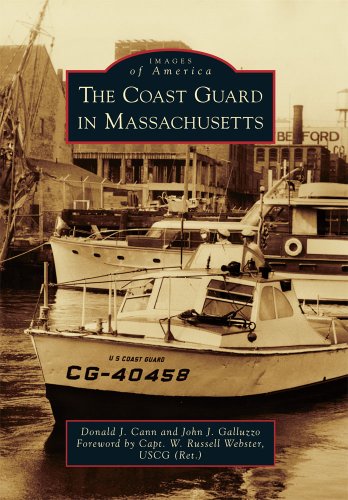

Sale!
All of our Arcadia
Publishing Company Lighthouse, Life-Saving Service and Coast Guard titles in
stock, dated
2015 or earlier are 50% off suggested retail price. No
other discounts may apply.
All
pre-2016 Arcadia titles in the listings below and on Page 2 are included in the
above sale. Or you may email for a list.
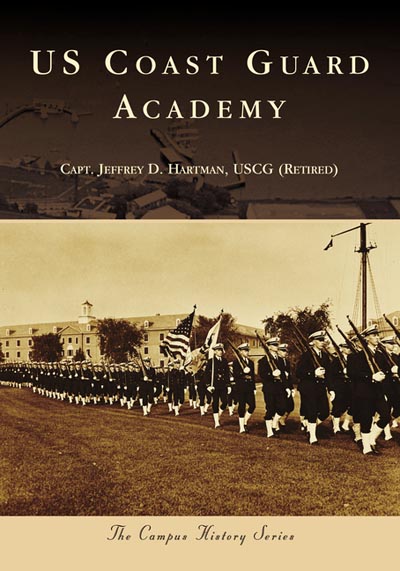
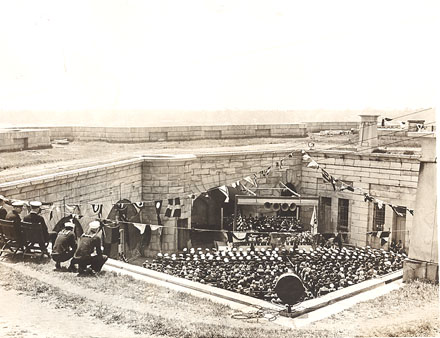
3101.
Hartman, Capt Jeffrey D. USCG (Retired). U.S. Coast
Guard Academy. Arcadia. 2020. 128p. Soft wraps. With over 200 vintage
photographs. The predecessor of the U.S. Coast Guard, the Revenue Marine (later
Revenue Cutter Service) was formed to enforce the U.S. customs laws. The
officers for the service were drawn from the merchant marine, and occasionally
the U.S. Navy. To ensure consistent training as the services evolved, the
original Revenue Cutter School Of Instruction became the U.S. Coast Guard
Academy, moving to its present location in New London, Connecticut, in 1932.
Prior to that, instruction had been afloat on four different vessels, known as
cutters, and ashore in New Bedford, Massachusetts; Curtis Bay, Maryland; and
Fort Trumbull in New London. The training has grown from a two-year program,
providing primarily practical seamanship, to one of the highest ranked small
engineering undergraduate schools in the nation, offering nine majors and
graduating male and female officers with a liking for the sea and its lore. The
author Capt. Jeffrey D. Hartman, USCG (retired) is a helicopter pilot with 30
years of service. He graduated from the academy in 1963. He twice served on the
US Coast Guard Academy Alumni Board of Directors, commanded an air station in
Puerto Rico and had four tours in Alaska, including management of the emergency
response program for the state waters. This compact volume features numerous
early photographs, drawn from the author’s and other private collections, most
never before published. Filled with rare and early views. (M). $21.99.

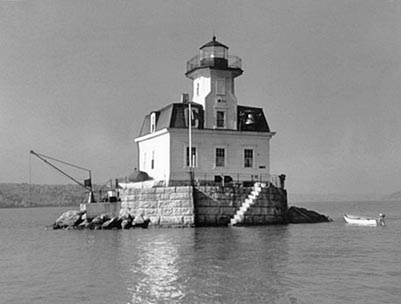
3103.
Hudson River Maritime Museum. Hudson River Lighthouses.
Arcadia. 2019. 128p. Soft wraps. With over 200 vintage photographs. The Hudson
River, as beautiful as it is, has its dangers. To help river traffic navigate
safely, there were once dozens of lighthouses up and down the length of the
river. Set against the backdrop of purple mountains, lush hillsides, and tidal
wetlands, the lighthouses of the Hudson River were built between 1826 and 1921
to improve navigational safety on a river teeming with freight and passenger
traffic. But unlike the towering beacons of the seacoasts, these river
lighthouses were architecturally diverse, ranging from short conical towers to
elaborate Victorian houses. Operated by men and women who at times risked and
lost their lives in service of safe navigation, these beacons have overseen more
than a century of extraordinary technological and social change. Of the dozens
of historic lighthouses and beacons that once dotted the Hudson River, just
eight remain, including the iconic Statue of Liberty, New York Harbor's great
monument to freedom and immigration, which served as an official lighthouse
between 1886 and 1902. These facts and more fill Images of America: Hudson
River Lighthouses, one of the latest in the beautiful series of local lore. This
compact volume features numerous early photographs, drawn from the author’s
and other private collections, most never before published. Filled with rare and
early views. (M). $21.99.
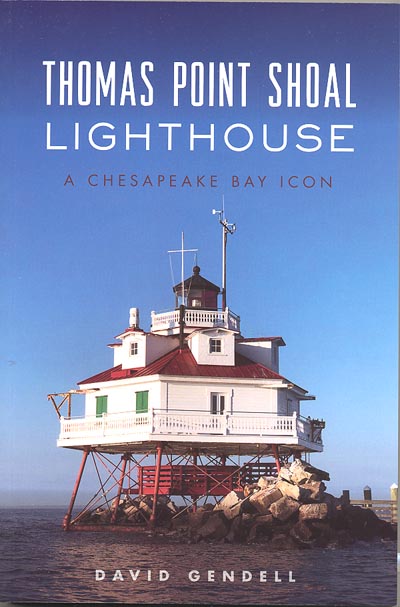
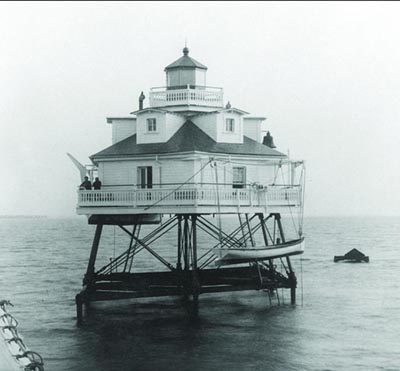
3102.
Gendell, David. Thomas Point Shoal Lighthouse: A
Chesapeake Bay Icon. History Press. 2020. 206p. Soft wraps. Well
illustrated with vintage photographs. For centuries, the hard-packed shoal at
Thomas Point menaced Chesapeake Bay mariners. Even after two separate stone
towers were built on the shoreline, sailors continued to request a light at the
end of the mile-long shoal. When a new lighthouse was finally approved in 1873,
experts deemed its novel design too fragile for the location—but it was built
anyway. Long overdue and of an inappropriate design, the iconic Thomas Point
Shoal Lighthouse was lit in November 1875 and continues to serve mariners.
Thomas Point is the last Chesapeake Bay screwpile-style lighthouse in its
original location and one of only twelve American lighthouses designated as a
National Historic Landmark. Join Annapolis sailor David Gendell as he explores
Thomas Point. This compact volume features numerous early photographs, drawn
from the author’s and other private collections, most never before published.
(M). $21.99.
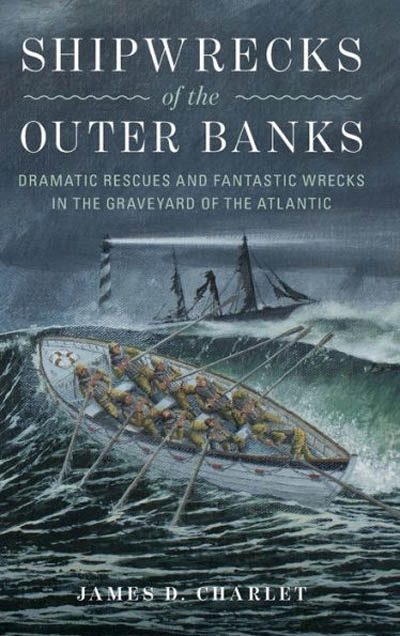
3026. Charlet, James D. Shipwrecks
of the Outer Banks: Dramatic Rescues and Fantastic Wrecks in the Graveyard of
the Atlantic. 2020. Rowman & Littlefield. 264p. Stiff wraps. More
than 6,000 ships have met their doom in the waters along the North Carolina
coast, weaving a rich history of tragedy, drama and heroics along these
picturesque beaches. Men have lost their lives and fortunes, and heroes have
been made where the combination of mixing currents, treacherous coastline and
shifting underwater sandbars spells disaster for even the most seasoned sailor.
These are the stories of daring rescues, tragic failures, enduring mysteries,
buried treasure, and fascinating legend. Unlike conventional shipwreck books
which are simply arranged chronologically, this is a themed-collection: The
Well-Known, The Lesser-Known, The Hardly Known, some Dramatic Failures and the
Mysterious. Some specific wrecks – the Tiger, the USS Huron, the SS Central
America – so impacted our history as to forever alter our fate. All are true
stories more about the rescues than the wrecks; the real-life human drama of
shipwreck victims and their heroic lifesavers. In their time, the men of the
United States Life-Saving Service responded to over 178,000 lives in peril from
the sea; of which they saved over 177,000. Yet America all but forgot these
peaceful heroes. These eye-opening accounts once again bring their stories to
light. (M). Published at $26.95. Our price $24.95.
 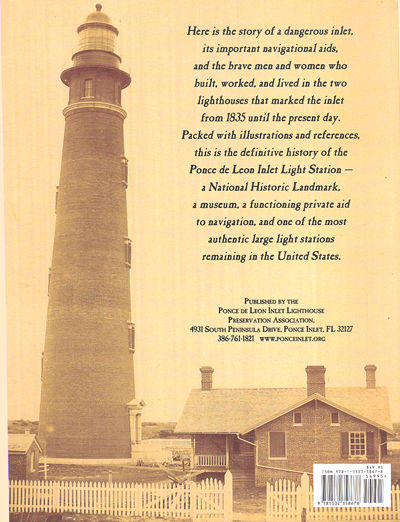
3061. Henry, Ellen J. The
Ponce Inlet Lighthouse: An Illustrated History. 2019. Ponce De Leon
Inlet Lighthouse Preservation Association. 317p. DJ. THE PONCE INLET LIGHTHOUSE:
An Illustrated History tells the story of the Ponce (originally Mosquito) Inlet
Light Station and the local Florida region from prehistoric times through the
present day. Published by the Ponce De Leon Inlet Lighthouse Preservation
Association, this extraordinary hardcover coffee table book is the definitive
history of the Ponce Inlet Light Station and represents more than 15 years of
research conducted by author and museum curator Ms. Ellen Henry. The book
features more than 400 images to bring it all to life and is filled with
fascinating stories of human perseverance, lighthouse innovation, Native
American uprisings, civil war battles, desperate shipwrecks, lighthouse builders
defying the elements, heroic sea rescues, and the lives of the light station's
historic keepers and their families. Well done. (M). $49.95
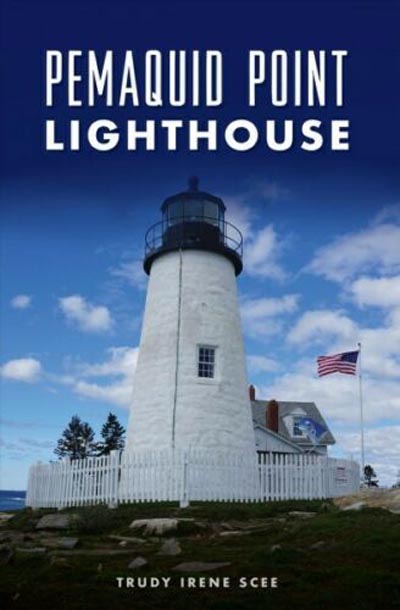

3087.
Scee, Trudy Irene. Pemaquid Point Lighthouse.
History Press. 2020. Soft wraps. 158p. Illustrated with 144 photos and images.
Pemaquid Point Lighthouse was first constructed in 1827 and still sends its beam
out seventy-nine feet above sea level. Light keepers kept the lanterns burning
from the 1820s through the 1930s, but they could not prevent every tragedy.
Ships have crashed on the rocky shoals, taking sailors to their watery graves,
while many others have been swept off the rocks by the powerful surf. Despite
advances in technology and automation, the shore around the light remains a
dangerous place. Author and historian Trudy Irene Scee uncovers the fascinating
story of this iconic Maine lighthouse, its keepers and their families, from the
construction of the first light through the present day. (M). $21.99. (x)
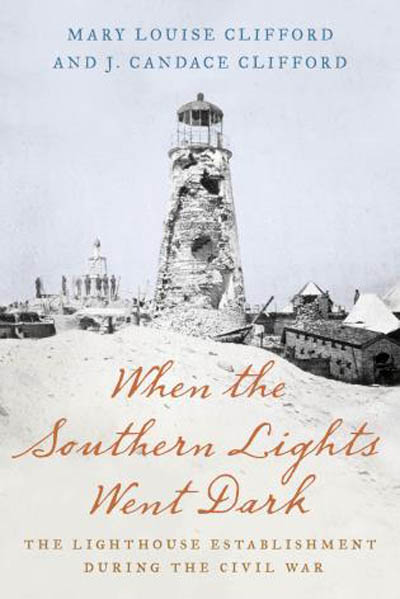 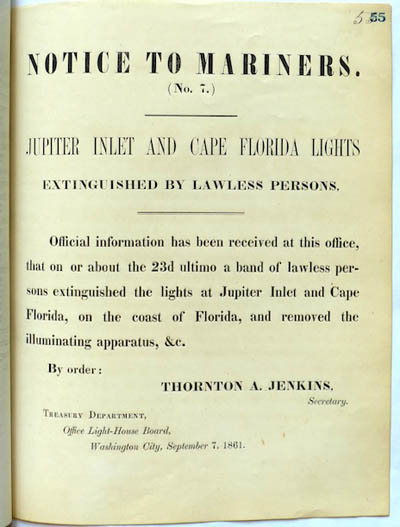
3030. Clifford, Mary L. and J. Candace
Clifford. When the Southern Lights Went Dark - The
Lighthouse Establishment During the Civil War. Globe Pequot. 2020.
192p. Soft wraps. The Confederacy extinguished the lights in all the lighthouses
it controlled long before any shots were fired at Fort Sumter. When the Southern
Lights Went Dark: The Lighthouse Establishment During the Civil War tells the
story of the men who assumed the daunting task of finding the lenses and lamps,
repairing deliberate destruction to the towers and lightships, and relighting
them as soon as the Navy could afford them protection. From Cape Hatteras to
Ocracoke Light, Jupiter Inlet to Tybee Island, St. Simons to Cockspur Island and
others, these are the stories from a unique era in United States lighthouse
history. Unlike in peace time, when military officers filled the posts of
engineer and inspector in each lighthouse district, civilians had to be found
who were not only talented enough to build and maintain lighthouses, but also
could supervise a party of workmen and make decisions on their own. Those men in
the field had to find keepers, see that they were paid, and ensure they had
food, water, and essential supplies. The Lighthouse Board was far away in
Washington and could do little more than give advice, order needed equipment,
record the dispatches from the field, and pay the bills it received. From Cape
Hatteras to Ocracoke Light, Jupiter Inlet to Tybee Island, St. Simons to
Cockspur Island and others, these are the stories from a unique era in United
States lighthouse history. Well done. (M). $19.95. (available 2021)
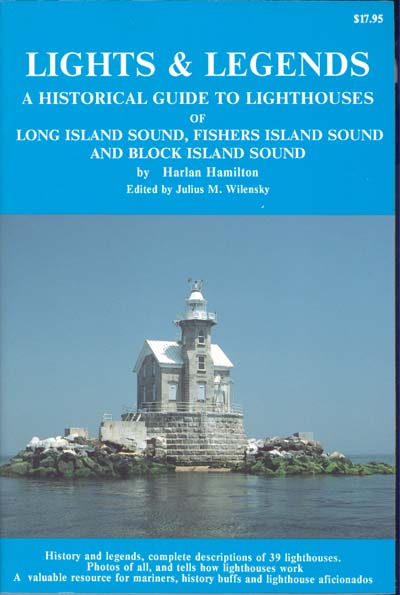
20404. Hamilton, Harlan.., LIGHTS
AND LEGENDS – A HISTORICAL GUIDE TO LIGHTHOUSES OF LONG ISLAND SOUND,
FISHERS ISLAND SOUND AND BLOCK ISLAND SOUND.
Stamford
,
Ct.
1987. 286pp. Soft wraps. Impressive reference work covers the 39 light stations
that existed in the area. Includes all manor if information from construction
information, major alterations and characteristics of the lights that existed
there, to information about the keepers work there. Well illustrated with over
50 vintage photographs. Also includes chapters on lighthouse technology, lens
apparatus, types of lights and characteristics, and more. A most excellent
reference for this area. (M). $17.95.
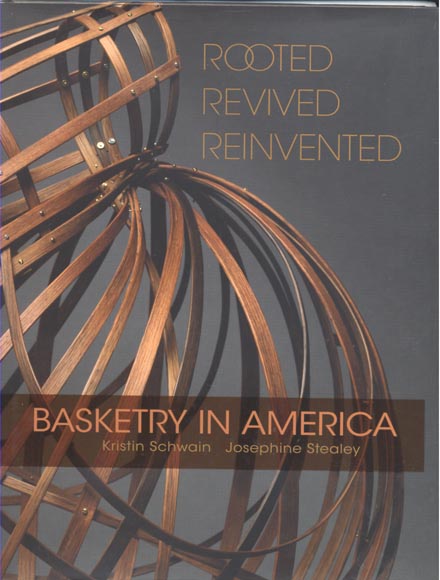

3018.
Schwain, Kristin and Josephine Stealey. Rooted,
Revived, Reinvented: Basketry in America. Schiffer. 2017. DJ. 208p.
Lavishly illustrated with over 250 superb color photographs. This book unfolds a
history of American basketry, from its origins in Native American, immigrant,
and slave communities to its contemporary presence in the fine art world. Ten
contributing authors from different areas of expertise insightfully show how
baskets convey meaning through the artists' selection of materials; the
techniques they use; and the colors, designs, patterns, and textures they
employ. Accompanying a museum exhibition of the same name, the book illustrates
how the processes of industrialization changed the audiences, materials, and
uses for basketry. It also surveys the visual landscape of basketry today; while
some contemporary artists seek to maintain and revive traditions practiced for
centuries, others combine age-old techniques with nontraditional materials to
generate cultural commentary. This comprehensive treasury will be of vital
interest to artists, collectors, curators, and historians of American basketry,
textiles, and sculpture. (M). $29.95.

3029. Hendrickson, Dyke. New
England Coast Guard Stories: Remarkable Mariners. 2020. The History
Press. 144p. Soft wraps. In 1790, Treasury Secretary Alexander Hamilton asked
President George Washington to fund a fleet of "revenue cutters" that
could halt smuggling and collect taxes in U.S. waters. Today, from northern
Maine to southern Connecticut, the Coast Guard provides the might and the
oversight to ensure that the coastlines are safe and navigable. From icebreaking
and harrowing rescues to the global war on terror, the service plays a unique
role in the region. Author Dyke Hendrickson profiles the varied careers and
contributions of the brave men and women throughout New England who ensure the
service remains Semper Paratus-Always Ready. Great reading. (M). $21.99.
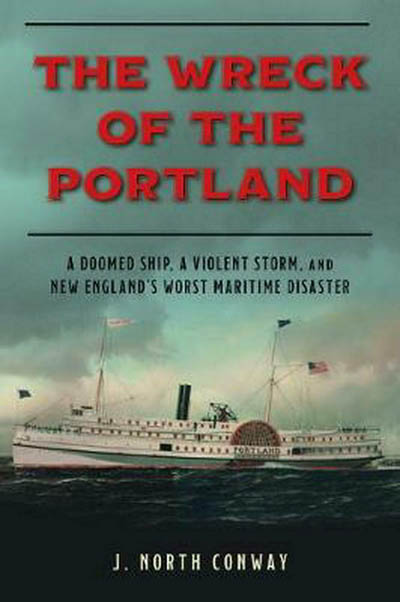
3024. Conway, J. North. Wreck
of the Portland: A Doomed Ship, A Violent Storm, and New England's Worst
Maritime Disaster. Rowman & Littlefield. 2019. 201p. Stiff wraps.
The SS Portland was a solid and luxurious ship, and its loss in 1898 in a
violent storm with some 200 people aboard was later remembered as "New
England's Titanic." The Portland was one of New England's largest and most
luxurious paddle steamers, and after nine years' solid performance, she had
earned a reputation as a safe and dependable vessel. In November 1898, a
“perfect storm” formed off the New England coast. Conditions would produce a
blizzard with 100 mile per hour winds and 60-foot waves that pummeled the coast.
At the time there was no radio communication between ships and shore, no sonar
to navigate by, and no vastly sophisticated weather forecasting capacity. The
luxurious SS Portland, a sidewheel steamer furnished with chandeliers, red
velvet carpets and fine china, was carrying more than 200 passengers from Boston
to Portland, Maine, over Thanksgiving weekend when it ran headlong into a
monstrous, violent gale off Cade Cod. It was never seen again. All passengers
and crew were lost at sea. More than half the crew on board were African
Americans from Portland. Their deaths decimated the Maine African American
community. Before the storm abated it became one of the worst ever recorded in
New England waters. The storm, now known as "The Portland Gale,"
killed 400 people along the coast and sent more than 200 ships to the bottom,
including the doomed Portland. To this day it is not known exactly how many
passengers were aboard or even who many of them were. The only passenger list
was aboard the vessel. As a result of this tragedy, ships would thereafter leave
a passenger manifest ashore. Author J. North Conway has painstakingly recreated
the events, using first-hand sources and testimonies to weave a dramatic,
can't-put-it down narrative in the tradition of Erik Larson's Isaac's Storm and
Walter Lord's enduring classic, A Night to Remember. He brings the tragedy to
life with contemporaneous accounts the Life-Saving Service, from Boston
newspapers such as the Globe, Herald, and Journal, and from The New York Times
and the Brooklyn Daily Eagle. (M). $26.95.
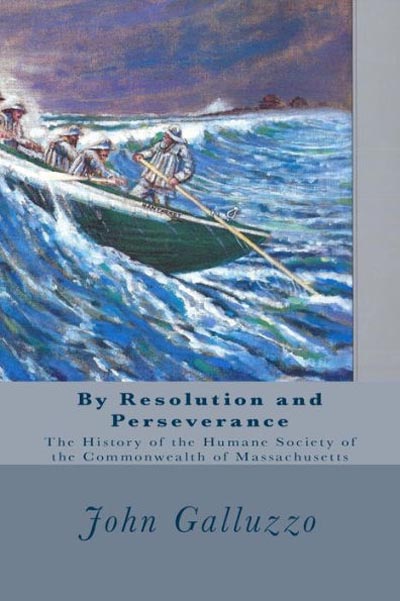 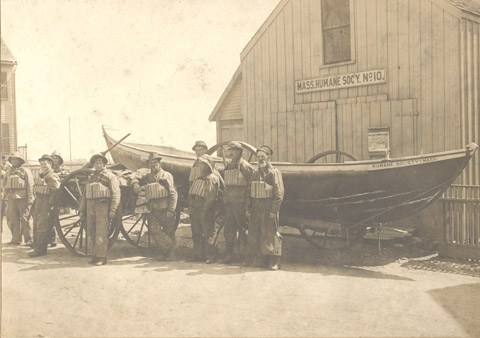 (image not included)
(image not included)
1910. Galluzzo, John. By
Resolution and Perseverance: The History of the Humane Society of the
Commonwealth of Massachusetts. 2017. CreateSpace. 143p. Soft wraps.
The Humane Society of the Commonwealth of Massachusetts is the oldest lifesavig
organization in the United States, preceding even the parent agencies of the
United States Coast Guard. Formed in 1785, inspired by the notion that the
"apparently drowned" could be revived, the Humane Society took
lifesaving of mariners in distress at sea to the next level with the
construction of the first American shore-based lifeboat in 1807. Volunteers
living under the motto "I'd like to think that if I was out there, someone
would come for me" bent over the oars for the next century and rowed into
the teeth of the biggest storms the Massachusetts coast has ever seen, as
sailing ships headed for shore. Join veteran lifesaving history author John
Galluzzo for the history of the 18th century founders, the 19th century heroes
and the 20th and 21st century champions of the Humane Society cause of
preserving life along the Massachusetts coast. One of the few references on this
important organization. (M). $29.95.
 
3025. Larson, Erik. The
Splendid and the Vile - A Saga of Churchill, Family, and Defiance During the
Blitz. 2020. 586p. Crown Pub. DJ. The #1 New York Times
bestselling author of Dead Wake and The Devil in the White City delivers a
startlingly fresh portrait of Winston Churchill and London during the Blitz. On
Winston Churchill’s first day as prime minister, Hitler invaded Holland and
Belgium. Poland and Czechoslovakia had already fallen, and the Dunkirk
evacuation was just two weeks away. For the next twelve months, Hitler would
wage a relentless bombing campaign, killing 45,000 Britons (30,000 of them
Londoners) and destroying two million homes. It was up to Churchill to hold the
country together and persuade President Franklin Roosevelt that Britain was a
worthy ally–that she was willing to fight to the end. In The Splendid and the
Vile, Erik Larson shows, in cinematic detail, how Churchill taught the British
people “the art of being fearless.” It is a story of political brinksmanship
but also an intimate domestic drama, set against the backdrop of Churchill’s
prime-ministerial country house, Chequers, and his wartime residence, Ditchley,
where Churchill and his entourage go when the moon is brightest and the bombing
threat is highest. Drawing on a wealth of untapped sources, including recently
declassified files, intelligence reports, and personal diaries only now
available, Larson provides a new lens on London’s darkest year through the
day-to-day experience of Churchill and his family: his wife, Clementine; their
daughters, Sarah, Diana, and the youngest, Mary, who chafes against her
parents’ wartime protectiveness; their son, Randolph, and his beautiful,
unhappy wife, Pamela; her illicit lover, a dashing American emissary; and the
cadre of close advisors who comprised Churchill’s “Secret Circle,”
including his dangerously observant private secretary, John Colville; newspaper
baron Lord Beaverbrook; and the Rasputin-like Federick Lindemann. The
Splendid and the Vile takes readers out of today’s political dysfunction and
back to a time of true leadership, when–in the face of unrelenting
horror–Churchill’s eloquence, strategic brilliance, and perseverance bound a
country, and a family, together. (M). Published at $32. Our
price $29.95.

1961.Hutchinson,
John. Bertie’s
Adventure to Monomoy Point. Hummingbird 2019. 195p Still wraps.
Illustrated by the author. This 3rd Book in the Bertie Series is Published &
Ready for the Holiday Season! This long-awaited addition to the Bertie series
continues the enjoyable escapades of Bertie the field mouse and his cousin
Benjie. This time, the daring duo undertake an expedition driving an old,
wooden-bodied station wagon in a beach adventure. Along the way, the fearless
mice outsmart deadly enemies, survive a powerful storm and rescue a damsel in
distress while finding time to catch fish and camp in the dunes. The book is
beautifully illustrated by the author, who lovingly brings to life the days when
you could venture onto Monomoy Beach in Chatham on Cape Cod with your beach
wagon, and drive nine plus miles to the lighthouse at the very tip in search of
adventure and monstrous striped bass. It’s a grand adventure, told with
insight and passion that will captivate the hearts of readers, young and old.
Priced at just $25. (no discounts apply) (M)

1914. Estrada, Eduardo J. Tribulations
Of A Lighthouse Service: A Story Of The Lighthouses Of Ecuador. Self.
2016. 285p. Soft wraps. Peaceful, lonely and stoic is how one imagines the life
of lighthouse keepers, who were the visible side of the Service. Intrigue,
jealousy, death, hate, weakness, bureaucracy, money; as well as love, purpose,
dedication, generosity, and passion were in the invisible side of those who
decided where to install, build and then administer the Lighthouse Services
around the world. But while living the whole range of human emotions and
experiences, they served the rest of humanity with unrelenting work and
self-sacrifice. This book will take us to a far-away land and back to the 19th
Century, where things were as different to those at home as we could imagine.
Knowing the story of a foreign lighthouse service and revisiting their trials
and tribulations, will help us to better understand and appreciate how and why
things happen in our own land. While some situations are similar no matter where
you look, we can find striking differences. "The Tribulations of a
Lighthouse Service," is a small sample of the trials and tribulations that
most, if not all, lighthouse services of the world had to endure at the time of
their golden age, when Fresnel lens illuminated the world's coasts. (M). $28.
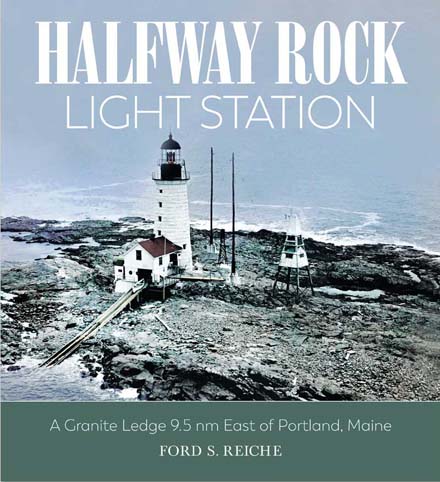
1841.
Reiche, Ford S. Halfway Rock Light Station – A
Granite Ledge 9.5 NM East of Portland, Maine. Presumpscot Foundation.
2018. 192p. Soft wraps. Illustrated with 240 historic and contemporary photos.
Written by Ford S. Reiche, the man who purchased and restored the lonely and
once doomed Halfway Rock lighthouse that sits on a rocky outcropping off the
rugged coast of Maine. Perched midway across the mouth of Casco Bay on a barren
ledge of two acres, Halfway Rock Light Station is a remote, wave-swept beacon,
nearly inaccessible and totally exposed to the ravages of Mother Nature. Built
in 1871 to guide mariners approaching Portland Harbor, the lighthouse was
finally automated in 1976 and thereafter, maintenance was limited to the bare
essentials required to keep the light and fog horn functioning. Declared surplus
government property in 2014, Halfway Rock Light Station was offered at auction
and purchased by Ford Reiche in 2015. In this book, Reiche surveys the
historical background of early light stations and chronicles the lives and
duties of lighthouse keepers. He then describes the adventure of restoring the
property, with compelling “before and after” photos. Thoroughly illustrated
and well described, this detailed work makes wonderful reading. Well done!
Shipped directly from the author. (M). $30.00 plus $5.00 shipping. (x)
 
1977.
Taylor, Charlotte. Rhode Island Shipwrecks.
Arcadia. 2017. 128p. Soft wraps. With over 200 vintage photographs. Rhode
Island, the Ocean State, has more shipwrecks per square mile than any other
state. The south coast and Block Island are the resting places of many
shipwrecks, with many more located in Narragansett Bay. The record of shipwrecks
in Rhode Island begins immediately after the arrival of Europeans in the early
17th century with the grounding of a Dutch trading vessel, and thousands more
vessels came to grief in its waters in the following centuries, through bad
weather, human error, equipment failure, and military action. Some of these
shipwrecks were epic disasters, with many fatalities and the total loss of the
vessel; others were relatively minor misfortunes in which the ships were
salvageable. Many shipwrecks from the 19th century on into the 20th were
captured in the dramatic images gathered here. These pictures show the variety
of vessels that travelled Rhode Island's waters back when the ocean was the
primary transportation corridor and the many ways in which they met misfortune.
This compact volume features numerous early photographs, drawn from the
author’s and other private collections, most never before published. Filled
with early views. (M). $21.99.
1978.
Hartman, Capt. Jeffrey D. USCG (Retired). Icebreaking
Alaska. Arcadia. 2014. 128p. Soft wraps. With over 200 vintage
photographs. The Arctic is a place of great challenges and great rewards. A
century ago, it was whale oil; today, it is motor oil. The increasing open water
in the warmer months is attracting cruise ships to tour the Arctic. Significant
offshore oil and natural gas deposits are of great interest to an oil-dependent
economy. But the history of the Arctic is full of surprises for the unwary and
the unprepared, despite native peoples having managed to live there for
thousands of years. Oil spills or maritime emergencies can—and do—arise a
long way off from assistance. Legendary Arctic storms are, if anything, becoming
more intense and dangerous. All this is in an area inaccessible by roads or by
sea except for icebreakers the majority of the year. It is of extreme interest
to the US Coast Guard, charged with protecting seafarers, enforcing laws, and
facilitating commerce. This compact volume features numerous early photographs,
drawn from the author’s and other private collections, most never before
published. Filled with early views. (M). $21.99.

1819.
Brigham, Chester. Ten Pound Island: Where the Coast
Guard Earned Its Wings. 2018. Whale’s Jaw Pub. 142p. Soft wraps. It
was the 1920s, and flapper-age fervor was in high gear in Gloucester,
Massachusetts, fueled by illegal booze flowing into every cove and beach from
rum row vessels off-shore. Here are tales of the police chief who dressed as a
flapper to infiltrate bootleg circles, and of the convicted bootleggers who,
after their stay in a federal penitentiary, were welcomed back to town with a
reception at the train station, complete with brass band. With local law
enforcement outmatched, the Coast Guard set up a cutter station to combat the
rum runners. In charge was young Lieutenant Commander C.C. Von Paulsen. This
experienced ship's officer did his best with the pursuit boats under his
command, but was frustrated that so many fast rum boats still got by. He knew a
better way. Not only a seasoned mariner, Von Paulsen was an aviator - one of the
first Coast Guard pilots. With encouragement from higher ups but no funding, he
scrambled together a makeshift seaplane base in Gloucester harbor, sharing a
tiny island with a lighthouse, the lighthouse keeper's family, and a government
fish hatchery. He borrowed a bi-wing seaplane from the Navy and, along with
Ensign Leonard Melka, they flew a relentless schedule of patrols that year,
scanning thousands of miles of coastal waters to spot rum ships and radio his
patrol boats to take up the chase. The results convinced hardened sea officers
and Washington politicians alike that there was a role for the Coast Guard in
the air. Von Paulsen was granted funding and more planes to expand his
shoestring operation on Ten Pound Island into the Coast Guard's first permanent
air station. Although bootleg whiskey still found its way into Gloucester, the
sea lanes were largely cleared of mob-financed hooch delivery ships. The
aircraft on the island were then free to concentrate on search and rescue, and
on supporting early efforts, daring and sometimes tragic, to fly across the
Atlantic. (M). $22.95.
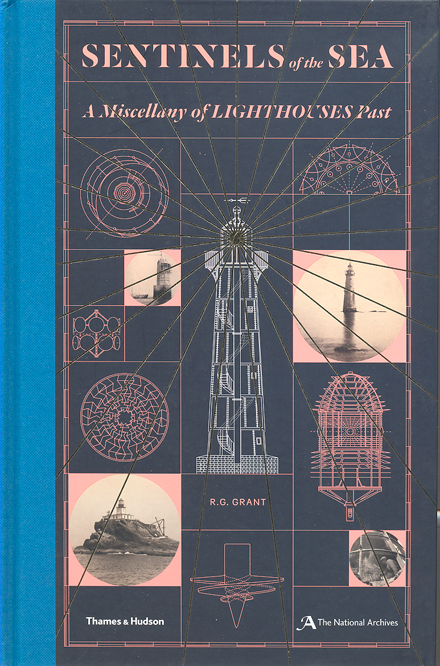
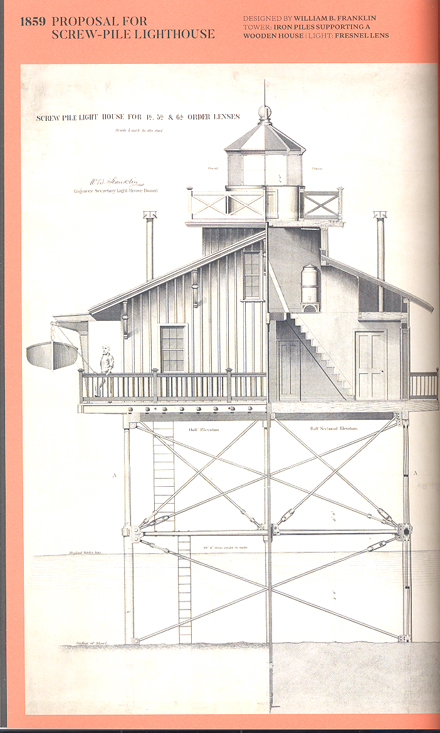
1826.
Grant, R. G. Sentinels of the Sea: A Miscellany of
Lighthouses Past. Thames & Hudson Ltd., 2018. 160p. Stiff wraps.
Lighthouses have always unsettled and attracted in equal measure, highlighting
the triumphs and failures in humanitys battle with the forces of nature. Taking
as its heroes the lighthouses themselves, Sentinels of the Sea describes the
engineering genius that allowed their construction on even the smallest of rock
outcrops and the innovations that made the lights so powerful and reliable.
Intricate, elegant architectural plans and elevations, and evocative period
drawings and photographs showcase the innovative designs and technologies behind
fifty historic lighthouses built around the world from the 17th to the 20th
century. R.G. Grants engaging and authoritative text chronicles the incredible
feats of engineering and endurance that brought these iconic, isolated towers
into being, the advances in lens technology that made the lights so effective,
and the everyday routines of the lighthouse keepers and the heroic rescues that
some performed. Packed with extraordinary stories of human endeavour, desperate
shipwrecks, builders defying the elements and heroic sea rescues, the book also
reveals the isolation and vulnerability of the dedicated lighthouse keepers.
Over 400 wonderful color illustrations. Most interesting – well worth the
price. (M). $48. (x)

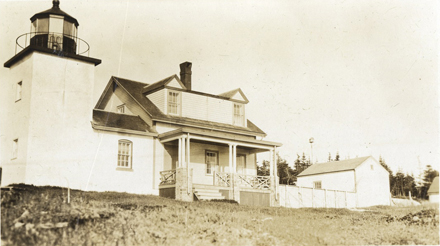
1816.
Holden, William C III. Mark Island – Songs of a
Dreamer – Lighthouse Diaries. Self published. 2016. 288p. Soft
wraps. Roaring Bull, a ledge awash in only 3 feet of water at mean low tide,
lies in eastern Frenchman Bay. When it’s blowing hard from the northwest and a
heavy sea is running from the south, the waves strike the shoals, sending the
white foam up and billowing back like a bridal train. That particular display of
the North Atlantic’s might is just one of the many dramas and memorable
moments William C. Holden III experienced while living for much of each year for
a decade on Mark Island off the western shore of Winter Harbor on the Schoodic
Peninsula. The largely treeless isle also is home to the Winter Harbor Light,
which was deactivated in 1933. During his years on the island, Holden poured his
energy (and money) into restoring the lighthouse, lighthouse keeper’s house,
workshop, oil house, henhouse, outhouse, boathouse, ways and pier. He also read,
cooked, painted and even lazed around a bit. All was recorded in a daily diary
kept most days. Twelve years after selling the island in 2004, Holden has
produced this book chronicling his decade-long adventure. Filled with the
author’s photos, drawings and more as well as numerous excerpts from his
detailed logbook. (M). $38. (x)
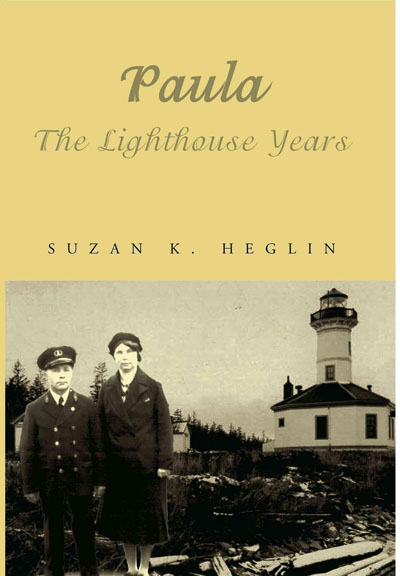
1854.
Heglin, Suzan K., Paula The Lighthouse Years.
2005. 338p. Soft wraps. Paula The Lighthouse Years based on a true story. If you
were a woman in the 1930's living in a developing, war torn country, your family
and friends, your history and culture, limited what you could be. But only your
own level of personal courage limited who you were or how far you could go.
Paula, the Lighthouse Years, is the true story of Paula, the Estonian mail order
bride of an Alaskan Lighthouse keeper. Despite his abuse and near madness, they
keep lights along the rugged Alaskan coast in the 1930's, encountering families,
foreigners, fools and phantoms. It's the story of one woman's life, but it is
also history, adventure, technology, and culture. Paula does not dare hope for
love, but love finds Paula in this touching, thrilling, true journey through one
woman's life. The lights that she and her husband were stationed at include
Point Retreat, Guard Island, and Tree Point. (M). $29. (x)
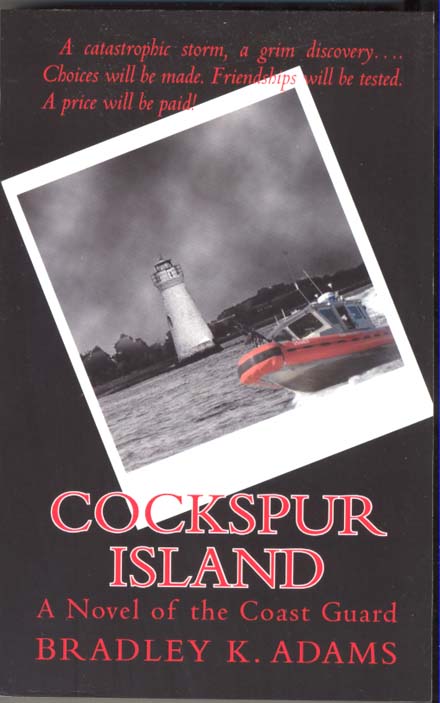
17177.
Adams, Bradley K. Cockspur Island : A Novel of the
Coast Guard. 2012. Self published. 444p. Soft wraps. Bradley Adams is
twenty-five year veteran of the United States Coast Guard. He has served at
numerous Coast Guard units in Georgia, Michigan, Illinois and California,
spending eleven years as an Officer in Charge of Coast Guard Small Boat
Stations. Set in Savannah, Georgia, "Cockspur Island: A Novel of the Coast
Guard" is an original work of fiction from Bradley K. Adams, the first book
in the Hank Morgan Series and the first in a series of books that focuses
exclusively on the Coast Guard. In the wake of a hurricane, Hank Morgan and his
crew discover the remnants of a failed, fatal, drug deal. As the story unfolds,
Hank, his crew and their families are pursued by ruthless drug runners who are
convinced that the "Coasties" have taken their money. The action,
adventure and intrigue ramp up as you, the reader, share in the peril and are
left guessing as to Hank's fate and the true holder of the stolen riches.
"Cockspur Island: A Novel of the Coast Guard" is a page turning, edge
of the seat thriller sure to leave the reader eager for the next chapter in Hank
Morgan's career. (M). $27.
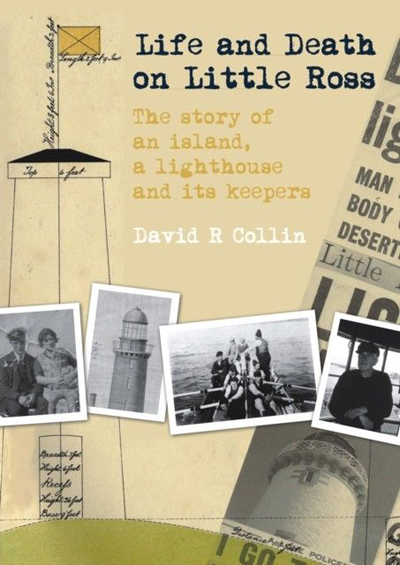
1829.
Collin, David R. Life and Death on Little Ross: The
Story of an Island, a Lighthouse and its Keepers. Whittles
Publishing. 2017. 240p. Soft wraps. Scotland’s Little Ross is an attractive
and unspoiled island and its lighthouse, beautifully designed by the famous
Stevenson family, is officially a 'lesser' light, far away from busy sea lanes,
at the summit of this remote island.The island was unknown to most people until
1960 when a murder in the lighthouse buildings brought it widespread notoriety,
to the grief and consternation of all who were involved. The author was at the
island on the day of the murder, and was a witness in the High Court trial that
followed. Over the subsequent 57 years, he has repeatedly been asked to tell his
story but the 117 years of diligent tending of the light by numerous lighthouse
keepers and their families has been largely forgotten. In Life and Death on
Little Ross, the author has redressed the balance by telling the story of the
island, its lighthouse and its people who lived and worked there including
extracts from a detailed diary that has survived from WWI. Also featured are the
island's earliest inhabitants, the ships and their crews that came to grief, the
case made by concerned local people for a lighthouse to be erected, the
political wrangling that frustrated its approval for many years, the lighthouse
design, and the eventual construction of the buildings.The story did not end
with the murder. The process of automation began immediately after the event and
the work of conversion, repair and maintenance, including first-hand accounts by
some of the tradesmen is provided. The story of the restoration and conversion
of the lighthouse keepers' derelict cottages is one of courage, patience,
stamina, skill and resourcefulness which should inspire all of the many people
that love wild, beautiful and unspoiled places like Little Ross Island and care
about the future of buildings of distinction. Illustrated with period photos.
(M). $39. (x)


1810.
Baldwin, Debra & Lighthouse Digest Magazine. Tillamook
Rock Lighthouse. Arcadia. 2018. 128p. Soft wraps. With over 200
vintage photographs. Built in 1880, Oregon's Tillamook Rock Lighthouse has had
the most notorious reputation of any lighthouse on the Pacific Coast of the
United States. Fierce storms regularly catapulted huge boulders through the
lantern, with waves that broke over its 136-foot height earning it the modern
nickname "Terrible Tilly." It has been described as a pint-sized
Alcatraz, and many keepers could not stand its confinement. However, there were
some who actually enjoyed it and even came to love it. A rare glimpse of the
more pleasant side of daily life on "the Rock" is shown in newly
rediscovered historic photographs taken by the keepers who faithfully served
there. This important visual legacy serves to temper the horrific view of
Terrible Tilly and provides a new perspective: that perhaps an assignment to
Tillamook Rock Lighthouse was not so wholly terrible after all. This compact
volume features numerous early photographs dating from the 1880’s to the
present, drawn from the author’s and other private collections, most never
before published. Filled with early views. Thoroughly researched, well done!
(M). $23.99.
1859.
Ketenheim, Bob. Coast Guard Cutter Taney.
Arcadia. 2018. 128p. Soft wraps. With over 200 vintage photographs. The Taney
was one of seven Secretary-class cutters built for the US Coast Guard during the
Great Depression. Commissioned in 1936, she served continuously for 50 years,
including service in World War II, the Korean War, and the Vietnam War. The
Taney was in Honolulu during the Japanese attack on December 7, 1941, and
participated in the defense of Honolulu and Pearl Harbor. During World War II,
she saw service in the Atlantic Ocean, the Mediterranean Sea, and the Pacific
Ocean. The Taney spent several years on ocean weather station duty in both the
Atlantic and the Pacific. Later, she patrolled the East Coast of the United
States, performing drug interdiction duties. The Taney is the only surviving
ship that was present during the Japanese attack on Pearl Harbor. She was
decommissioned in 1986 and has since been a museum ship in Baltimore's Inner
Harbor, where she hosts an annual Pearl Harbor commemoration on December 7. This
compact volume features numerous early photographs, drawn from the author’s
and other private collections, most never before published. Filled with early
views. (M). $21.99.


1857.
Panayotoff, Theodore J. and Michael R. Pittavino. Lighthouses
and Life Saving at Oswego. Arcadia. 2018. 128p. Soft wraps. With over
200 vintage photographs. The oldest freshwater port in the United States is
nestled firmly into the southeastern shore of Lake Ontario at Oswego, New York.
Since 1822, four lighthouses have guided the mariner's safe passage to shore,
and just as those lighthouses stood watch, so did the men and women who manned
them. Members of the US Life-Saving Service, Revenue Cutter Service, and Coast
Guard followed and remained vigilant in the face of danger, always ready to
assist those in distress on the inland sea. Lighthouses and Life Saving at
Oswego allows readers to step back in time and explore the iconic landmarks and
exemplary individuals that afforded Oswego its commercial prominence for nearly
two centuries. This compact volume features numerous early photographs dating
from the 1880’s to the present, drawn from the author’s and other private
collections, most never before published. Filled with early views. (M). $21.99.
1855.
D’Entremont, Jeremy. Wave-Swept Lighthouses of New
England. Arcadia. 2018. 128p. Soft wraps. With over 200 vintage
photographs. The lighthouse is a pervasive icon in our culture, often used to
symbolize positive qualities like faith, guidance, strength, and steadfastness.
No structures embody these qualities more than wave-swept lighthouses, which
were built to withstand the most extreme forces of wind and ocean waves, often
in isolated, rocky locations far offshore. In the United States, the earliest
attempts to build wave-swept lighthouses in the 1830s led to several
masterpieces of engineering, a few of which are in the New England region. This
book primarily focuses on six such structures: Whaleback (Maine), Saddleback
Ledge (Maine), Minot’s Ledge (Massachusetts), Halfway Rock (Maine), Graves
Ledge (Massachusetts), and Ram Island Ledge (Maine). All of these wave-swept
lighthouses stand in rugged testimony to the people who designed and built them,
and they also serve to remind us of the struggles and sacrifices of the
lighthouse keepers who “kept a good light” for so many years before
automation. This compact volume features numerous early photographs dating from
the 1880’s to the present, drawn from the author’s and other private
collections, most never before published. Filled with early views. (M). $21.99.

1856.
Cesari, Cornelia J., Baker Island. Arcadia.
2018. 128p. Soft wraps. With over 200 vintage photographs. Baker Island is a
quintessential Maine island, frozen in time. It was settled in 1806 by one
family, and the island’s population peaked at about two dozen people in five
households at mid-century. The US government made use of the island’s
strategic location at the entrance to Frenchman’s Bay with a lighthouse and
military facilities. Wealthy, artistic, and academic summer visitors to the
region—so-called rusticators—discovered its charm as a day trip destination.
However, by 1930, only the lightkeeper’s family remained. Now mostly part of
Acadia National Park, these 123 acres are precious to a disproportionate number
of people. Every season, visitors flock to the area, scenic tour airplanes fly
overhead, and narrated boat tours skirt the shoreline. Park rangers lead
interpretive tours almost daily, leaving from Bar Harbor for half-day visits.
Each summer, thousands moor their private boats and row ashore—honeymooning,
celebrating, and even scattering ashes. Five generations of rusticators have
held picnics on the tempestuous south shore’s expansive pink granite surface
known as the “Dance Floor.”This compact volume features numerous early
photographs dating from the 1880’s to the present, drawn from the author’s
and other private collections, most never before published. Filled with early
views. (M). $21.99.
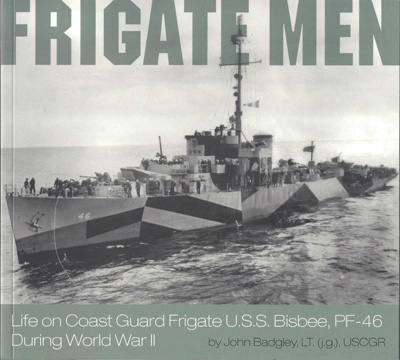
17144a. Badgley, John. Frigate
Men - Life on Coast Guard Frigate U.S.S. Bisbee, PF-46 During World War II.
Published by John Badgley, 2007. 224p. Soft wraps. A true account of the life of
United States Coast Guard sailors on board a fighting frigate during World War
II; the humor, pathos, heroism and significance of one small ship in the United
States naval armada of 1944. John Badgley (1922 – 2014) was a California
architect. He was also a life-long sailor, marine enthusiast, historian and
ecologist. After officer training at the US Coast Guard Academy, where he raced
Star boats and served before the mast on the square rigged ship DANMARK, he
joined the crew of USS BISBEE (PF-46) serving in 45 campaigns in the south and
north Pacific during WWII. USS Bisbee was awarded 5 battle stars in 3 major
theaters of operation. At wars end he was assigned to Admiral Chester Nimitz,
Commander Eastern Sea Frontier, in charge of Air Sea Rescue Operations
coordinating Atlantic traffic during the return of US forces from Europe. With
declassification of the ship's log, now the true story is being told."
Illustrated with 38 graphite sketches & watercolors by the author, as well
as 20 wartime photographs. A brisk and entertaining read. (M). $29.95. (x)

17156.
Boonisar, Richard M. Gurnet Point: A Small Remote
Summer Community with a Fascinating History. West Barnstable Press.
2017. 112p. Soft wraps. Gurnet Point is on a point of land at the tip of Duxbury
Beach, that extends out from Duxbury and protects Plymouth from the fierce
gales. Its first lighthouse was built there in 1768, and in 1806 two Huts of
Refuge were erected along the beach by the Massachusetts Humane Society. The
first life-saving station was erected at the Gurnet in 1874 following the wreck
of Brig “Regulator”. The author has spent summers on the Gurnet since 1939
and brings to this work a wealth of knowledge about the area gleaned from years
of research, as well as over 160 early photos from his private collection,
nearly all never before published. Includes two
wonderfully detailed chapters covering the history of the lighthouses and
life-saving stations there. Wonderful reading, well done. (M). $28.

1778.
(reprint) U.S. Light-House Establishment. Specifications
for the Lantern of a First-Order Light House. June 1871. Wash GPO
1871 (2017 Ohio River Trading) . 13p. Soft wraps. Nicely done reprint. Includes
specifications and details of lantern. Without figures or plates. A good
beginning reference. (M). $9.95.
1772.
(reprint) U.S. Light-House Establishment. Specifications
for a Double Dwelling for the Keepers of First Order Lights. Wash GPO
1862 (2017 Ohio River Trading) . 11p. Soft wraps. Nicely done reprint. Includes
specifications and details of double dwelling. Without figures or plates. A good
beginning reference. (M). $9.95.
1773.
(reprint) U.S. Light-House Establishment. Specifications
for A Light-Keeper’s Dwelling. (Frame) June 1877. Wash GPO 1877
(2017 Ohio River Trading) . 8p. Soft wraps. Nicely done reprint. Includes
specifications and details of frame dwelling, by Peter C. Hains, Eng’r Sec.
Without figures or plates. A good beginning reference. (M). $9.95.
1774.
(reprint) U.S. Light-House Establishment. Specifications
for a First-Order Light House (Brick Tower). October 1861. Wash GPO
1861 (2017 Ohio River Trading) . 11p. Soft wraps. Nicely done reprint. Nicely
done reprint. Includes specifications and details of brick light tower. Without
figures or plates. A good beginning reference. (M). $9.95.
1775.
(reprint) U.S. Life-Saving Service. Instructions to
Mariners in Case of Shipwreck With Information Concerning the Life-Saving
Stations Upon the Coasts of the United States. Wash GPO 1881 (2017
Ohio River Trading) . 32p. Soft wraps. Nicely done reprint. Contains information
and instructions for use by mariners so that proper co-ordination between
life-savers and sailors in distress will be achieved. Includes information on
the use of breeches buoy apparatus, signaling, rescue by surfboat, and much
more. Also includes complete listing of all Life-Saving Districts and stations
in the United States at that time. Includes some illustrations. A good beginning
reference. (M). $9.95.
1777. (reprint) [Excerpts
– Services of Crews] Annual Reports of the Operations of the Life-Saving
Service. Sixth District. 1881-1910. Wash
GPO 1881-1910 (2017 Ohio River Trading) . 34p. Soft wraps. Nicely done reprint.
Excerpts from Services of Crews (rescues) in the Sixth District (North Carolina)
as printed in Annual Reports from 1881-1910. Interesting reading. A good
beginning reference. (M). $9.95.
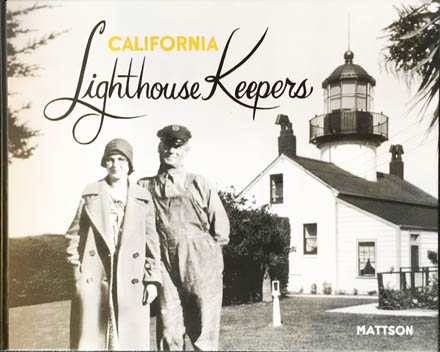
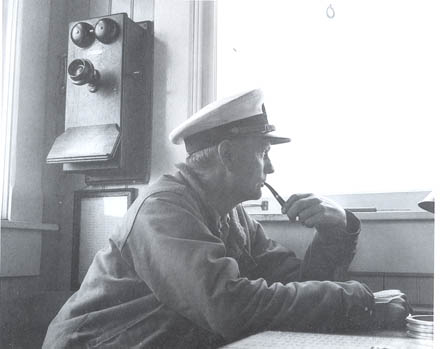
1747.
Mattson, Jan. CALIFORNIA LIGHTHOUSE KEEPERS – A Look
at Lighthouse Life Through the Eyes of the People Who Lived It. Goat
Rock. 2016. 144p. Stiff wraps. 8 ½” x 10 ½”. Filled with photos, many
never before published, of lighthouse keepers and family members. In the late
1940’s the author’s relative, a talented painter and professional
photographer, began photographing the keepers tending their apparatus at nearby
light stations and soon had compiled a photographic history of the life at
stations up and down the coast of California from San Diego to Cape Mendocino.
These wonderful black and white images present a rare view into the light
keeper’s life when their work was still a necessity. No matter what part of
the country you are from, these views of the men and women tending their
equipment and their stories will surely be of interest. (M). Published at
$29.95. Our price $28.
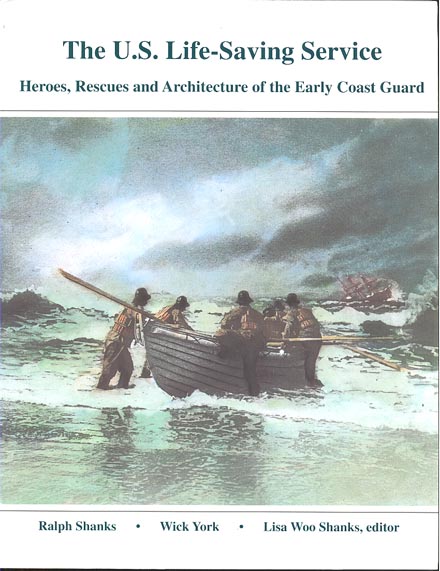
We have purchased
the publisher’s last remaining stock of this title. There will be no more
after these have sold.
6275s. Ralph Shanks, Wick York, Lisa Woo
Shanks, editor. THE
U. S.
LIFE-SAVING SERVICE - HEROES, RESCUES AND ARCHITECTURE OF THE EARLY COAST
GUARD. 1996.
Petaluma
, CA. 262p. Winner of the first Foundation for Coast Guard History Award
for Best Book on Coast Guard History, this long
heralded work by Ralph Shanks and Wick York is once again
available. Filling a longtime void in the chronicles of the Life-Saving
Service, this book is the result of two decades of research by these
highly respected maritime historians. In 272 large format pages, the
authors present unforgettable stories of the surfmen and their unsurpassed
bravery. Unique to this work is the authors coverage of the architecture
of each of the stations across the country. Using over 400 rare photos from the Library of Congress
and other historic sources, the authors provide a station by station look
at the architectural features that make them such a unique and
unforgettable piece of our history. Considered the best reference on
the U.S. Life Saving Service on the market. (M). Lightly used
softcover $34.95 while they last.
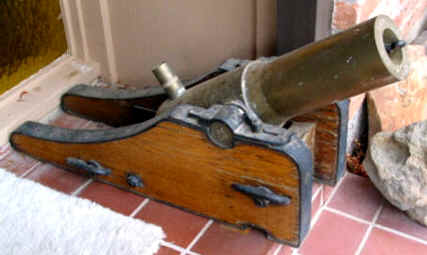

20386. Barnett, J. P., THE
LIFESAVING GUNS OF DAVID LYLE.
South Bend
. 1976. 3rd. 108p. Soft wraps. 3rd. updated edition. This is the definitive
reference on this well known backbone of the Life-Saving Service and early Coast
Guard – the Lyle Gun. Using early records and searching out makers and
specimens, the author presents a most complete account of the manufacture and
history of these important tools. Includes Manby mortar, Hunt gun, and numerous
civilian guns including Hall’s, Coston, Cunningham’s rockets, Galbraith,
General Ordnance, Naval Co., Steward, American Ordinance, Sculler, HTP, and many
more. Also includes firing mechanisms, faking equipment, projectiles, octants,
powder, performance tests, and more. Filled with vintage photos and diagrams,
this is an extremely valuable reference on the subject. (M). $21.50.

1786. Hargrove,
James L. and Carol A. Talley. Cape
St. George Lighthouse and Apalachicola Bay. Arcadia. 2017. 96p. Soft wraps.
With over 122 vintage photographs. The beacon of the historic Cape St. George
Lighthouse still guides mariners into Apalachicola Bay. Sheltered from the Gulf
of Mexico by a string of barrier islands, the port flourished as the only site
in Florida on a river that is navigable for over 300 miles to the fall line at
Columbus, Georgia, Apalachicola’s sister city. Generations of lighthouse
keepers were bound to St. George Island and its great bay by an intense sense of
duty to sustain seagoing commerce and a love for a place where they could raise
their families in freedom. When the lighthouse foundation washed away in 2005
after a very active hurricane season and a final surge from Hurricane Wilma,
residents took action to salvage and rebuild the historic lighthouse. Visitors
may still climb the lighthouse tower, surrounded by the bricks that were first
laid in 1852. This compact volume features numerous early photographs dating
from the 1880’s to the present, drawn from the author’s and other private
collections, most never before published. (M). $21.99.
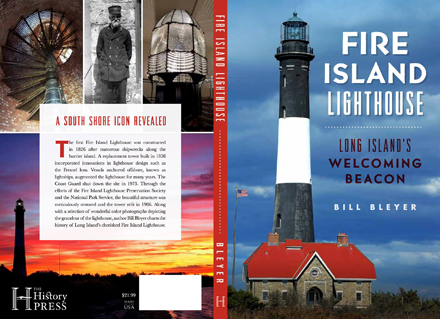
1763. Bleyer, Bill. The
Fire Island Lighthouse: Long Island’s Welcoming Beacon. 2017.
History Press. 160p. Soft wraps. This is the first complete history of the
important national landmark at Fire Island. The author begins with the site,
from the shipwrecks offshore dating from colonial times that prompted
construction of the first lighthouse on Fire Island in 1826; the inadequacies of
that lighthouse that led to construction of a new taller tower in 1858; the
development of improved lighthouse illumination apparatus including the Fresnel
lens; the Fire Island lightships that were anchored offshore to augment the new
lighthouse; how the lighthouse was shut down by the Coast Guard at the end of
1973 and replaced by a light on the water tower at Robert Moses State Park; how
the structures on the closed site deteriorated and the Fire Island Lighthouse
Preservation Society was formed in 1982 to restore the property and re-lit the
tower in 1986; how the original Fresnel lens was brought back from Philadelphia
and displayed in a new building in 2011; and the society’s future plans for
bringing back additional artifacts for display. The book is filled with dozens
of historical photographs, some never published before, and a 16-page insert of
new color photographs by retired Newsday photographer Audrey C. Tiernan showing
the restored lighthouse, keeper’s quarters and first-order Fresnel lens in all
their glory. Well done. (M). $21.99. Available May 10. (x)
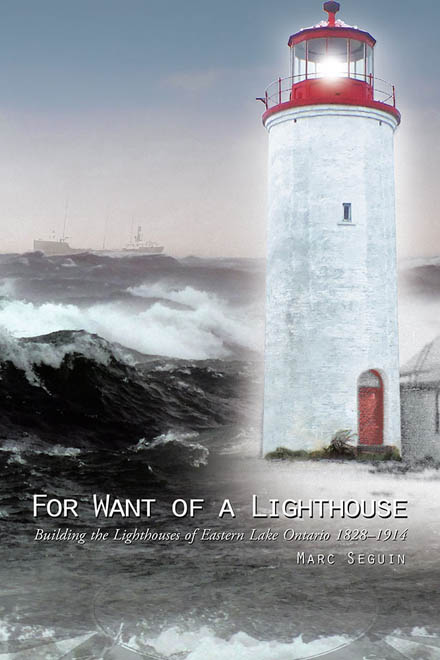
1753. Seguin, Marc. For
Want of a Lighthouse: Building the Lighthouses of Eastern Lake Ontario
1828–1914. Trafford Publishing. 2015. 566p. Soft wraps. No safe
harbours for steamboats or sailing vessels could be found along an isolated
70-mile stretch of eastern Lake Ontario, dominated by the irregular-shaped
Prince Edward County peninsula. Frequent storms, rocky reefs and sandy shoals
were among the many dangers facing 19th century mariners. So many shipwrecks
mark one narrow and shallow underwater ridge in the region that it became known
as the graveyard of Lake Ontario. It was on these shores, from Presqu ile Bay to
Kingston harbour and along the Bay of Quinte, that a network of more than forty
lighthouses and light towers was built between 1828 and 1914. For Want Of A
Lighthouse presents a sweeping look at the social and technological changes
which marked the era, and brings to life the people, politics and the hardships
involved in the construction of these essential aids to navigation. Through the
use of extensive archival material and more than 100 maps and photographs, Marc
Seguin documents the vital role these lighthouses played in the building of a
nation. There is now a race against time to save the few original towers that
are still standing. All of the author’s profits from the sale of this book
will go towards the preservation of these remaining lighthouses. (M). $26.44.
(x)

1734. Riddle, Mary Ellen. Outer
Banks Shipwrecks: Graveyard of the Atlantic. Arcadia. 2017. 128p.
Soft wraps. With over 185 vintage photographs. Ever since ships began navigating
the coast of North Carolina, the area has maintained a reputation for being
dangerous. Today, the region that stretches from the Currituck Outer Banks south
to Bogue Banks is referred to as the “Graveyard of the Atlantic.” From the
1585 grounding of the English ship Tiger off the Outer Banks to the 2012 loss of
the Bounty, more than 2,000 shipwrecks have occurred in the Graveyard of the
Atlantic. Weather, geography, war, piracy, and human error have all contributed
to this dense shipwreck zone. The stories behind the shipwrecks illustrate the
best and worst of mankind, showing courage and compassion as well as the
atrocities of war. This history informs readers about commerce, technology, war,
environment, maritime life, and the complexity of the human element. This
compact volume features numerous early photographs dating from the 1880’s to
the present, drawn from the author’s and other private collections, most never
before published. (M). $21.99.

1758.
Krueger, Steve. Lighthouses of Lake Winnebago.
Arcadia. 2017. 96p. Soft wraps. With over 122 vintage photographs. Winnebago has
a rich history as a major settlement area in the Midwest, and a significant part
of its times gone by involved water transportation for both commerce and
passengers. Throughout its history, the 137,700-acre lake has been home to six
current lighthouses, two navigation lanterns that have long disappeared from the
landscape, and one that was scheduled to be built but never came to fruition.
History has forgotten a few, but Lighthouses of Lake Winnebago will take you on
a trip around the largest lake within Wisconsin’s borders and show you the
familiar, while introducing you to the forgotten. This compact volume features
numerous early photographs dating from the 1880’s to the present, drawn from
the author’s and other private collections, most never before published. (M).
$21.99. (x)
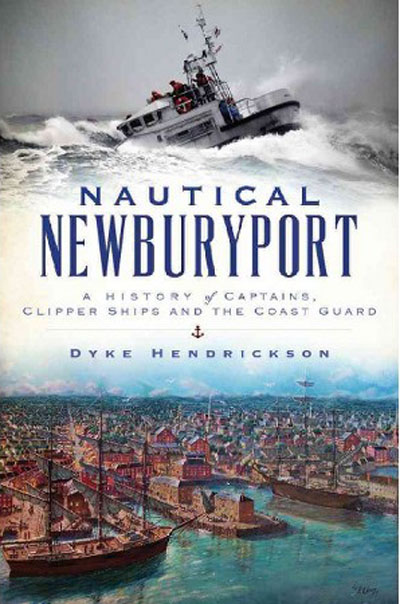
1735. Hendrickson, Dyke. Nautical
Newburyport: A History of Captains, Clipper Ships and the Coast Guard.
2017. The History Press. 144p. Soft wraps. With 56 Black And White images.
Newburyport was once the most dangerous harbor on the East Coast and one of its
most prosperous. Local captains and sailors led the nation to battle during the
American Revolution and founded the U.S. Coast Guard. They sent vessels to
Bombay, the gold rush and the farthest reaches of the world. Author Dyke
Hendrickson explores the perfection of the clipper ship, the city’s famous
Federalist mansions and the bold adventures from the Age of Sail. Follow the men
and women of Newburyport into battle, into gales and into fortune—or ruin.
Great reading. (M). $21.99.
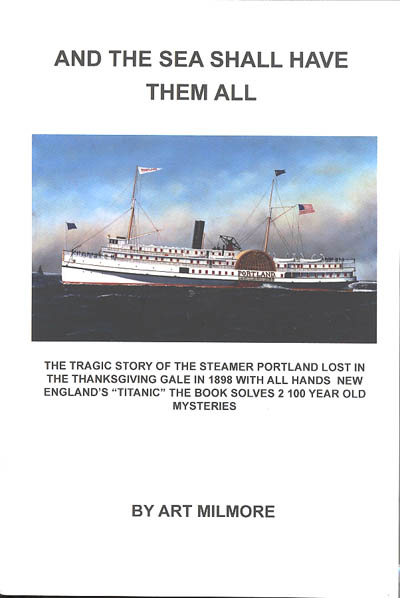
1728. Milmore, Art. And
The Sea Shall Have Them All. Self published. 2016. 234p. Soft wraps.
Over 20 miles out in Massachusetts Bay, lies the wreck of the palatial
side-wheel steamer SS Portland, tragically lost in the horrific gale of November
26 and 27th., 1898. The ship sank with all hands, was witnessed by no-one and
disappeared without trace. The Portland Steamship Company started as the
Portland Steam Packet Company in 1844, and was later consolidated into the
Eastern Steamship Company. One of their vessels, the side-wheel steamship
Portland, was one of the largest and most palatial vessels afloat in New England
during the 1890s. Built in 1889, the steamer ran between Portland, Maine and
Boston until its loss in 1898. The Portland's loss was New England's greatest
steamship disaster prior to the year 1900. The 1898 gale would become known as
The Portland Gale. The author began his research with the late author and
historian Edward Rowe Snow. “The trail ran dry in the 1970s”, the author
explained, “and Ed asked me if I ever found the rest of the material we needed
on the Portland, would I publish it…. This was to be Snow's 98th book, but
time ran out.” Edward Rowe Snow died in 1982 and now, capping 32 years of
research, the author presents what he believes is the definitive story of the SS
Portland’s history and the events of that fateful day in 1898. Extremely
interesting, filled with the results of years of interviews, accounts of the day
and much more. Quite different from other books on this subject and worth the
read. (M). $29.95. (x)
 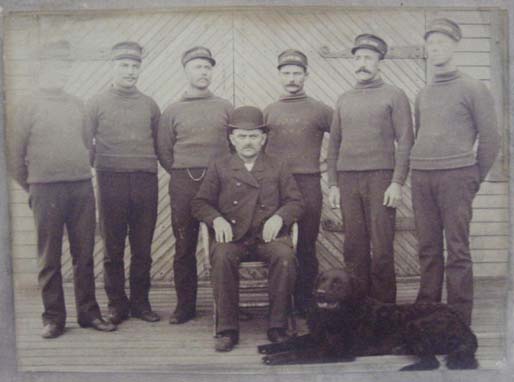
7340f. Field, Van. WRECKS
AND RESCUES ON LONG ISLAND - THE STORY OF THE U. S. LIFE SAVING SERVICE.
1997. 179p. Soft wraps. Over 188 vintage photographs. I have once again found a
copy of this long out of print work by Mr. Field. Filling a longtime void in the
chronicles of the Life-Saving Service on Long Island, this book is the result of
decades of research. In 179 large format pages, the author presents
unforgettable stories of the surfmen and their unsurpassed bravery. Unique to
this work are the 180 wonderful vintage photographs of the stations and the men
who served along this stormy coast. In this interesting chronicle, the author
provide a station by station look at the buildings, the crews and the rescues
they performed that make them such a unique and unforgettable piece of our
history. Filled with wonderful vintage photos. Clean, tight, only lightly used.
Extremely difficult to find. (M). $59.95. (x)

16236. Lehrer, Henry R. Flying
the Beam - Navigating the Early US Airmail Airways 1917-1941. Purdue
University Press. 2014. 226 pages. Soft wraps. With air travel a regular part of
daily life in North America, we tend to take the infrastructure that makes it
possible for granted. However, the systems, regulations, and technologies of
civil aviation are in fact the product of decades of experimentation and
political negotiation, much of it connected to the development of the airmail as
the first commercially sustainable use of airplanes. From the lighted airways of
the 1920s through the radio navigation system in place by the time of World War
II, this book explores the conceptualization and ultimate construction of the
initial US airways systems. The daring exploits of the earliest airmail pilots
are well documented, but the underlying story of just how brick-and-mortar
construction, radio research and improvement, chart and map preparation, and
other less glamorous aspects of aviation contributed to the system we have today
has been understudied. Flying the Beam traces the development of aeronautical
navigation of the US airmail airways from 1917 to 1941. Chronologically
organized, the book draws on period documents, pilot memoirs, and firsthand
investigation of surviving material remains in the landscape to trace the
development of the system. The author shows how visual cross-country navigation,
only possible in good weather, was developed into all-weather "blind
flying." The daytime techniques of "following railroads and
rivers" were supplemented by a series of lighted beacons (later replaced by
radio towers) crisscrossing the country to allow nighttime transit of
long-distance routes, such as the one between New York and San Francisco. While
navigational electronics have changed greatly over the years, actually
"flying the beam" has changed very little. (M). $38.95. (w)

1701. Grayson, Matthew S. Lighthouses,
Cutters and Lifeboat Stations: Life and Times of Rodger D. Dewey, BMCM 28 years
in the United States Coast Guard. 2016. 38p. Soft wraps. Follow the
twenty-eight years of service and memories of Rodger D. Dewey, who would retire
as a master chief boatswain’s mate E-9. As a young man from Denver, Colorado,
seventeen-year-old Dewey joined the United States Coast Guard in 1948 and made
the Coast Guard his life. Follow the training, lessons learned, funny stories,
and a true love of being a shallow-water sailor. His duty stations included
Humboldt Bay LBS, St. George Reef LH, San Luis Obispo LH, Marshall Islands, Pt.
Reyes LBS. Cutter assignments included CGC Gresham, Taney, Escanaba, Cahoone,
Active, Point Chico, Point Sal. Rather short but interesting account. (M).
$21.99.

16233.
Thurlow, Sandra and Timothy Dring. U.S. Life-Saving
Service: Florida's East Coast. Arcadia. 2016. 128p. Soft wraps. With
over 200 vintage photographs. Ten houses of refuge, unique to Florida s east
coast, were constructed by the US Life-Saving Service between 1876 and 1886.
When ships traveling along the almost uninhabited coast were grounded or wrecked
on reefs, survivors often made it to land but had no way to reach civilization.
House of refuge keepers and their families provided food and shelter to victims
of shipwrecks. The keepers lives were monotonous but punctuated with the
excitement of an occasional shipwreck. The US Life-Saving Service provided the
framework on which the east coast of Florida developed. With the establishment
of the US Coast Guard in 1915, the Life-Saving Service houses of refuge became
Coast Guard stations." This compact volume features numerous early
photographs dating from the 1880’s to the present, drawn from the author’s
and other private collections, most never before published, and traces the
history of the Life-Saving Service in Florida through photos and text. Filled
with early views. (M). $21.99.
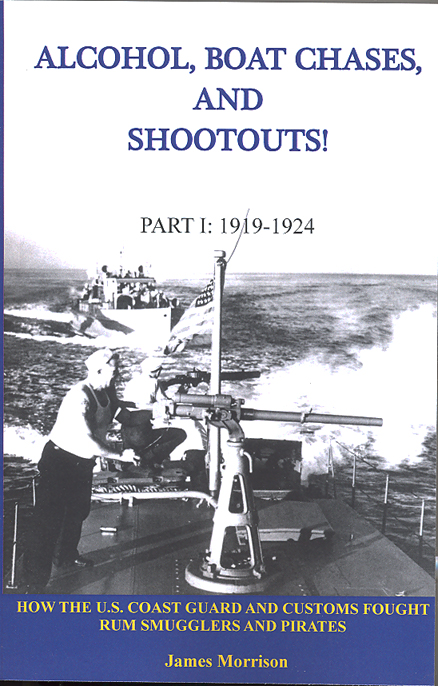
16220.
Morrison, James. Alcohol,
Boat Chases, and Shootouts!: How the U.S. Coast Guard and Customs Fought Rum
Smugglers and Pirates. Part I 1919-1924. Royal Exchange Publications. 2008.
329p. Soft wraps. A true story of rum smugglers, gangsters, pirates, and the
Coast Guard's effort to stop them, with a bit of the boat chases, corrupt
politicians, conspiracies, violence, and drunken sailors that prevailed during
the time. In the 1920s, when transporting and selling alcohol was mostly
illegal, brave men went to sea in an effort to stop rum smugglers and pirates.
The effort proved far more challenging than anyone could imagine. The author
spent two years sifting through microfilm and government documents to piece
together this epic story, buried by the sands of time. Amazingly, these true
stories of sea battles and chases are not from 200 years ago--they are from the
20th Century! Alcohol, Boat
Chases, and Shootouts tells the real stories of how the Coast Guard,
Customs, Prohibition agents, and police attempted to enforce Prohibition on the
water. Good information too about the Coast Guard equipment, stations and
operations of the day. (M). Published at $29. Our
price $22.95. (w)
 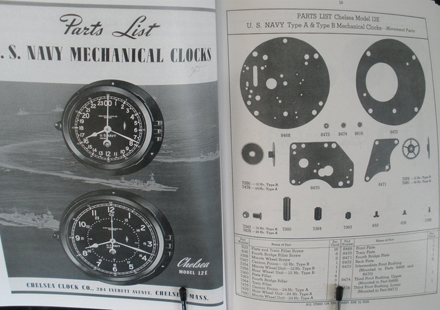

16222.
Demeter, Andrew. Chelsea Clocks: A Technical
Manual. Demeter Publications, Ltd., November, 2016. 203p. Soft wraps.
Cover Photo: Leonard Taube, retired master watchmaker for Chelsea Clock Company.
Reference includes photos and parts lists for sixteen of the most popular Marine
& Ships Bell movements made by Chelsea Clock Co. and several with
schematics. Includes Models E (Chelsea’s earliest marine movement), 12E, 12EI,
13E, 14E, 16E, 17E, F, K, 17K, L, 4L, M, 4M, V1 and V2. Eight pages listing
Interchangeable Parts alphabetically and separately by part number for Models E,
12E, 17E, F, K (Boston) 17K and 18K.Includes a brief history of Chelsea
escapements and an Escapement Comparison Table that identifies the type of
escapement used in each clock with numerous blueprints of individual escapement
parts. Identifies the parts by their Chelsea factory number as well as the
Waltham factory number. Parts diagrams for regulators that are found missing on
clocks as well as the USN Mark I Deck clock (chrome) hinge and back plates.
Chelsea Collectors and Waltham watchmakers who are seeking or selling Chelsea
clock parts will now be able to cite the part by name and factory number for the
most common Chelsea models on the market. Limited quantity available. (M).
$89.95. (w)
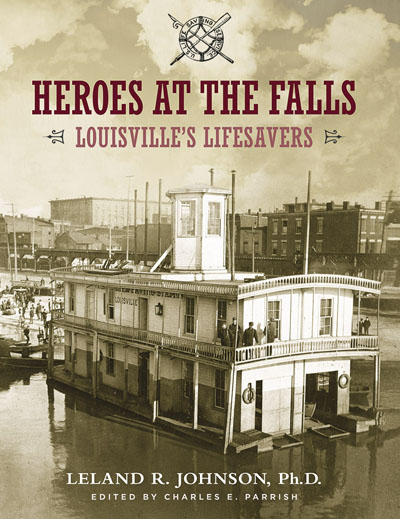
16202.
Johnson, Leland R. Ph.D. Heroes
at the Falls: Louisville's Lifesavers. Edited by Charles E. Parrish. Butler
Books. 2014. 128 pages. Large 8 ½” x 11”. Life-Saving Station #10, docked
at the wharf in Louisville, Kentucky, is a unique installation in American
history. As the only such federal installation on the inland waterways, this
rare floating life-saving station guarded against navigational disasters from
1882 until 1972. The only other similar life-saving station in the country was
the City Point Station in Boston Harbor. This station in Louisville was lobbied
for and manned by locally-grown heroes who maintained a constant vigil to
protect vessels and their passengers, cargoes and crews from destruction on the
jagged rocks of the Falls of the Ohio River in the days prior to modern lock and
dam systems. This Falls area was considered the most dangerous point along the
981 miles of the Ohio River. From the time it was authorized by Congress in 1881
until 1915, thousands of people were rescued from the treacherous falls area and
more than $5 million worth of boats, possessions and cargo were saved. The Coast
Guard would continue this fine record at the station until 1972, when the
completion of the newer McAlpine Locks and Dam submerged most of the Falls
and now required that all boat traffic pass through the canal and locks instead
of passing over the Falls. The third floating station remains today, with its
white double-decker building and watchtower aboard - the last of three river
rescue stations at the site. Dr. Johnson tells, for the first time, the
compelling story of the U.S. Life-Saving Service and Coast Guard stations at
this site, and the remarkable crews who saved thousands of lives, countless
numbers of boats, and millions of dollars of cargoes at the Falls of the Ohio.
(M). Published at $20. Our price $18.50. (x)
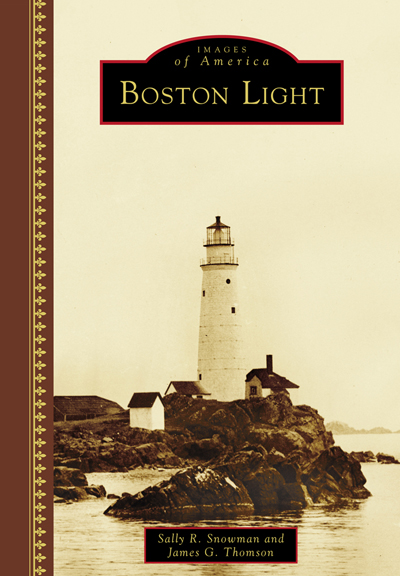
Just
in! Wonderful early photos and history:
16122.
Snowman, Sally R. and James G. Thompson. Boston
Light. Arcadia. 2016. 128p. Hard cover. With over 200 vintage photographs.
On September 14, 1716, Boston Light became the first lighthouse established in
Colonial America. With many ships foundering in the treacherous waters of the
Massachusetts harbor, there was a great need for navigational aid. At night and
during storms, it was difficult to discern the entrance to the main shipping
channel of Nantasket Roads, situated between the Brewster islands and the town
of Hull. The ledges had become a graveyard for ships, resulting in great loss to
human life and cargoa deterrent to European colonization efforts. Ship captains
and merchants petitioned the colonial government for a lighthouse to be erected
on Little Brewster Island as a way of safe passage to the inner harbor. Three
hundred years later, Boston Light continues to serve its purpose. Today, the
lighthouse is protected by an ever-present Coast Guard civilian keeper and a
cadre of specially trained Coast Guard Auxiliary volunteer assistant keepers.
Sally Snowman is the 70th Keeper of Boston Light. With her husband, Jay Thomson,
they have done extensive historical research on this distinctive piece of
Americana. Highly recommended for readers interested in history, New England,
lighthouses, sea stories. This compact volume features numerous early
photographs dating from the 1870’s to the present, drawn from the author’s
and other private collections, most never before published, and traces the
history of this light station through photos and text. Filled with early views.
(M). $24.99. Our price $22.

16171. Baltrusis, Sam. Haunted
Boston Harbor. 2016. The History Press. 144p. Soft wraps. With 56 b/w
images. Ghosts lurk in the waters near Boston’s historic seaport, haunting the
secluded islands scattered throughout the harbor. Boston Harbor brims with the
restless spirits of pirates, prisoners and victims of disease and injustice.
Uncover the truth behind the Lady in Black on Georges Island. Learn about the
former asylums on Long Island that inspired the movie Shutter Island, and dig up
the skeletal secrets left behind by the Woman in Scarlet Robes. From items
flying off the shelves at a North End cigar shop to the postmortem cries of
tragedy at the centuries-old Boston Light on Little Brewster, author Sam
Baltrusis breathes new life into the horrors that occurred in the historic
waters surrounding Boston. Great reading. (M). $19.99. (x)
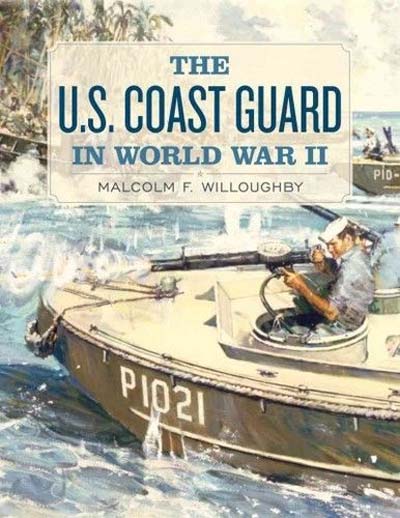
1697. Willoughby, Malcom F. The
U.S. Coast Guard In World War II. Naval Institute Press. 2016. 348p.
Soft wraps. This intimate view of the U.S. Coast Guard's dramatic World War II
record has long been considered a classic. First published in 1957 and out of
print for years, the book is now available in paperback. Handsomely illustrated
with more than two hundred photographs, the book serves as a unique memento of
one of the most illustrious periods in the Coast Guard's two hundred year
history. The author offers a story replete with incidents of devotion far beyond
the call of duty--daring rescues, adventurous high-sea missions, heroic combat
action--to clearly demonstrate the vital role the service played in the Allied
war effort. A seasoned World War I veteran who joined the Coast Guard Temporary
Reserve in 1942, Malcolm Willoughby has covered every aspect of the Coast
Guard's involvement in the war at sea, in the air, and at home. From the
invasion of Normandy, where Coast Guardsmen landed thousands of Americans and
rescued some 1,500 stranded in the surf, to Guadalcanal, where they rescued
three companies of Marines trapped on the beach, this chronicle vividly recounts
these well-documented operations and little-known stories of individual triumphs
and tragedies as well. (M). $48.95. (x)
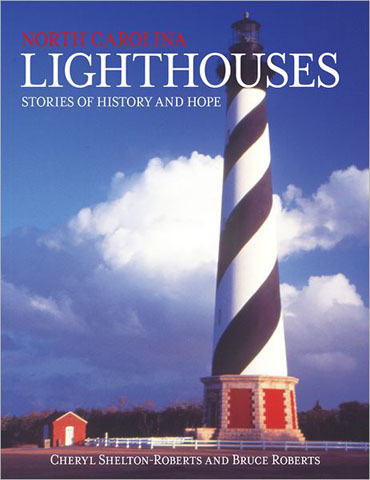
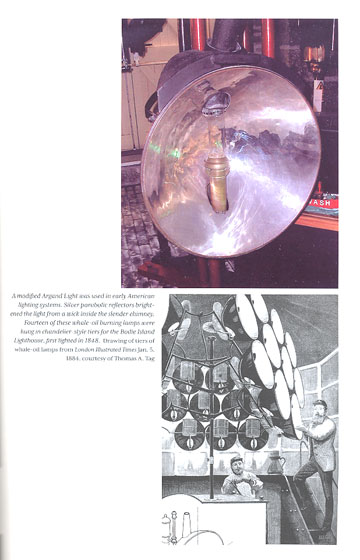

1288. Roberts, Cheryl Shelton and
Bruce. NORTH CAROLINA LIGHTHOUSES – Stories of
History and Hope. 2011. 152p. Soft wraps. Limited
Edition signed and numbered #895 of 1500 copies by the authors. This
limited coffee table genre but with lots of information will be sure to please
lovers of the lighthouses on the North Carolina coastline. A stunning,
full-color celebration of some of the world’s most famous lighthouses, the
shoreline they stand on, and the people who have worked to protect them, with
the lore and history of North Carolina’s seafaring past coming to life in the
text by Cheryl Shelton-Roberts and photographs by noted photographer Bruce
Roberts. From Cape Hatteras to Bodie Island Light, North Carolina is home to
some of the most famous lighthouses in the world, and with this book, beautiful
photography and engaging text come together to bring alive, as never before, the
lore and history of North Carolina’s seafaring past. But this is not just a
tribute to the sentinels that dot the North Carolina shoreline today, North
Carolina Lighthouses also offers a glimpse into the Golden Age of the Lighthouse
System and makes a compelling case for preserving these buildings and their
stories for posterity. WELL DONE ! Very very interesting, beautiful mix
of old and recent photos, great info. Very interesting reading. (M).
$29.95.

24374. Snow, Edward Rowe. WOMEN
OF THE SEA.
Beverly
. 2004. DJ. New Centennial Edition published in recognition of the centennial of
Mr. Snow’s birth in August 1902. Updated by Jeremy D’Entremont and with a
new forward by Dorothy Snow Bicknell. First published in 1962, this important
work and now has been meticulously updated as more and more readers discover Mr.
Snow’s wealth of titles on the subject once again. Told in Mr. Snow’s usual
readable style, here the author recounts the stories of many of the women of the
sea including Hannah Burgess, who navigated her husband’s clipper ship safely
to port after his death and the widowed Hsi Kai Ching who took command of her
husband’s pirate fleet. Certainly one of the most readable books on the
subject ever written. by this well known story teller. (M). Published at
$19.95. Special Sale Price $8.95. (x)

See
the video book trailer for Brilliant Beacons on YouTube- https://youtu.be/QUgQVFOjX2s.
1601.
Dolin, Eric Jay. Brilliant Beacons - A History of the
American Lighthouse. 2016. 448p. Stiff wraps. An
extraordinary work of historical detection and originality, Brilliant Beacons
vividly reframes America’s history through the development of its lighthouses.
In a work rich in maritime lore and brimming with original historical detail,
Eric Jay Dolin, the best-selling author of Leviathan, presents the most
comprehensive history of American lighthouses ever written, telling the story of
America through the prism of its beloved coastal sentinels. Set against the
backdrop of an expanding nation, Brilliant Beacons traces the evolution of
America’s lighthouse system, highlighting the political, military, and
technological battles fought to illuminate the nation’s hardscrabble
coastlines. In rollicking detail, Dolin treats readers to a memorable cast of
characters including the penny-pinching Treasury official Stephen Pleasonton,
who hamstrung the country’s efforts to adopt the revolutionary “Fresnel
Lens,” and presents tales both humorous and harrowing of soldiers, saboteurs,
ruthless egg collectors, and most importantly, the light-keepers themselves.
Richly supplemented with over 100 photographs and illustrations throughout,
Brilliant Beacons is the most original history of American lighthouses in many
decades. 112 illustrations; 8 pages of color. (M). Published at $29.95.
Sale
Price $21.95 plus $4.50 media mail. (x)
 Image
Copyright Walt Disney Studio Pictures
Image
Copyright Walt Disney Studio Pictures
1686. (DVD) The
Finest Hours: The True Story of the U.S. Coast Guard's Most Daring Sea Rescue.
DVD. Run time 114 min. PG-13. Based on the extraordinary true story of the
greatest smallboat rescue in Coast Guard history, THE FINEST HOURS is a tale of
courage, loyalty and honor in the face of overwhelming odds. When a massive
storm strikes off the coast of Cape Cod, it rips a T-2 oil tanker in half,
trapping more than 30 sailors on its rapidly sinking stern. As BM1 Bernie Webber
(Chris Pine) and his crew set out in the station 36-foot motor lifeboat to save
them, Chief Engineer Ray Sybert (Casey Affleck) struggles to buy his men more
time. Packed with heroic larger-than-life action and driven by the men's faith
in their mission, themselves and one another, THE FINEST HOURS is a triumph. The
Finest Hours has incredible and astonishing true-to-life heroism and
action-packed rescue scenes. This marvelous and terrifying yarn ( Los Angeles
Times ) deserves a place as a classic of survival at sea ( The Boston Globe). In
the days following the ordeal, twenty-one Coast Guardsmen involved in multiple
rescue missions would be decorated. Movie is based upon the original 1985
account by Coxswain BM1 Bernard Webber. $29.95. (x)

16111.
Quidley, Dallas Edward. The Lighthouse Keeper's Son.
LifeRich. 2013. 151p. Soft wraps. The Lighthouse Keeper's Son shares a
chronological collection of several short stories recalling author Dallas E.
Quidley Jr's life as the son of a lighthouse keeper. Light Stations tended by
family members included Drum Point, Neuse River, Cape Hatteras and Bodie Island
as well as lightships and various Coast Guard assignments. With modern marine
safety technology, the lighthouse way of life has slipped away, even though many
lighthouses still stand and are open to the public. Recalling his personal
experiences, Quidley reveals various aspects of life as a lighthouse keeper and
Coast Guardsman. The US Lighthouse Service and the US Coast Guard have
historically been foremost in safe marine navigation. The keepers were highly
qualified and dedicated mariners-people who were truly the salt of the earth. In
Quidley's family, three generations plus one son tried to live up to that
reputation. This collection of personal narratives offers stories of Quidley's
life before and after his time in the lighthouses with his family. Through these
stories of events and people, a portrait of a strong, hardworking, Christian and
family man emerges. The Lighthouse Keeper's Son chronicles a life well lived and
the cherished memories of a man who has experienced his life to the fullest.
(M). $24.95. (x)

1699. Dunn, Bill. Sea
Girt Lighthouse. Arcadia 2016. 128p. Soft wraps. With over 200
vintage photographs. In the New Jersey shore community of Sea Girt, where
Commodore Robert Stockton’s oceanfront mansion had a porch as long as a
ship’s deck from which he surveyed the waters, a lighthouse was built in 1896.
Sea Girt Lighthouse illuminated a dark space, providing a crucial guiding light
to passing ships. The station would become a lighthouse of distinction and
innovation. In 1920, it was the first land-based lighthouse with a radio beacon
transmitter, enabling ships to navigate through fog. During World War II, the
Coast Guard extinguished the light, stood watch in the tower, and patrolled the
beaches. No matter the mission, the lighthouse met every challenge. In 1956, the
town acquired the decommissioned lighthouse, making it the library and
recreation center. By 1981, however, the building needed extensive repairs and
was at risk of being sold. Concerned residents formed the Sea Girt Lighthouse
Citizens Committee to “save our lighthouse.” And they did, restoring it,
preserving its history, and keeping it busy with community events. This compact
volume features numerous early photographs dating from the 1870’s to the
present, drawn from the author’s and other private collections, most never
before published, and traces the history of this light station through photos
and text. Filled with early views. (M). $21.99. (x)

16115. Zoss, Neel R., Whalebacks
– Wrecked, Scrapped, Lost & Forgotten. Avery. 2016. 262p. Soft
wraps. last years of the 19th century, the Duluth Harbor, situated between the
sister cities of Duluth, Minnesota, and Superior, was the birthplace of a bold
and innovative and decidedly odd-looking class of Great Lakes barges and
steamships known as whalebacks. Capt. Alexander McDougall and his American Steel
Barge Company built the curved-decked, snout-nosed whalebacks on the shores of
the harbor, first at Duluth’s Rice’s Point and later in Howard’s Pocket at
Superior. The vessels were a radical departure, in design, form, and
construction, from the standard shipbuilding concepts of the era but proved
themselves more than capable as a number of the boats sailed the Great Lakes and
the seaboards of America until the 1960s. All the whalebacks are gone
now—either scrapped or sunk—with one exception. After sailing the lakes for
more than 70 years, the last whaleback, the SS Meteor, returned home to Superior
in 1972 and is now continuing its service as a magnificent maritime museum on
Barker’s Island. (M). $17.95. (x)
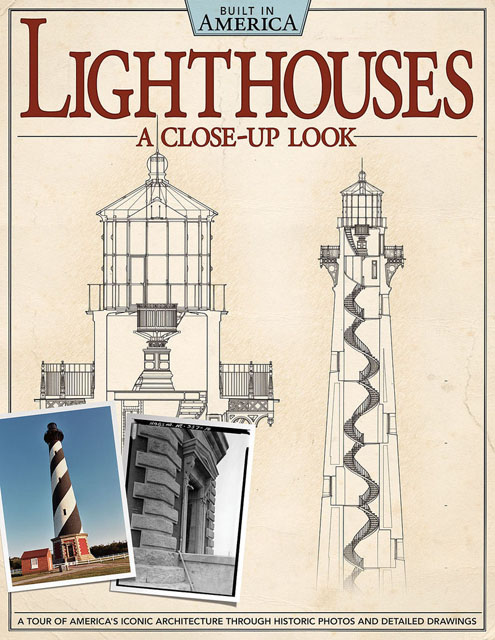
11372.
HABS Co-Author Alan Giagnocavo. Lighthouses - A Close-Up Look : An Intimate Tour Through Historic Photos and Architectural Drawings. Fox
Chapel Publishing (2011). 176p. Soft wraps. The Historic American Building
Survey (HABS) and the Historic American Engineering Record (HAER) collections
are dedicated to preserving America’s architectural history by gathering a
diverse range of historic photographs and architectural designs of buildings
throughout the country. Along with over 90 vintage and recent photos of lighthouses across the
country from the HABS/HAER website, this book includes over 50 detailed
architectural plans that feature the internal and external structure of the
lighthouses. In this book, readers will find unique lighthouse structures, such
as the Port Mahon Lighthouse, which hovers over the water on pilings and the
Portland Breakwater Lighthouse, which contains architectural details similar to
those found on the White House. Not to worry, though, the towering buildings
typically associated with the word lighthouse can also be found on these pages.
Color photos, plans, GPS coordinates and a brief history of many of the
locations are also included. Well worth reading. (M). Published at $19.95. Reduced
$6.95.

26249. Clark, Admont. LIGHTHOUSES
OF CAPE COD, MARTHA’S VINEYARD,
NANTUCKET
– Their History and Lore.
Beverly
. 2006. DJ. 244p. With a chapter devoted to each light station, this is surely
the most interesting and comprehensive book on the subject. Profusely
illustrated with fine early photographs and engravings. The author traces the
history of each lighthouse from the beginning, the story of the construction and
changes over the years, and of the men and women who lived and worked at the
stations. The author’s emphasis on stories of the people who lived and worked
in the lighthouses makes this book most enjoyable - readers are infused with a
sense of daily life at each lighthouse, while also reading the extraordinary
events that make their histories. Wonderful reading and most well done. (F).
Published at $36.95. Sale Price $12.95.
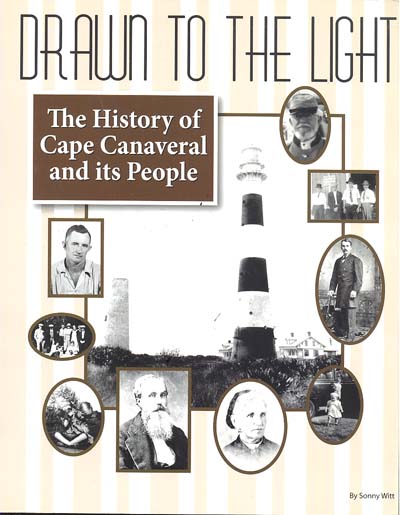
10374. Witt, Sonny. Drawn
to the Light – The History of Cape Canaveral and its People. 241p.
Soft wraps. The history of Cape Canaveral from 500 - 1945 is very sketchy or non
existent. The Ais Indians controlled Cape Canaveral until their disappearance in
about 1715. From that time the Cape lay uninhabited until about 1847 when the
Lighthouse Establishment arrived to search for a location to build a lighthouse.
About eighty years after the Ais Indians disappeared from Cape Canaveral , a
hand full of settlers arrived. Their objective was to raise families,
settle homesteads and operate the Cape Canaveral Lighthouse. Interestingly
enough, the second lighthouse keeper left Cape Canaveral because of fears of
raids by Indians and the third keeper came to the cape because Indians caused
his family to leave their homestead near Fort Pierce. Mills O. Burnham and his
wife Mary should be credited for, but not completely, populating Cape Canaveral
with the Burnham family members and the operation the Cape Canaveral Lighthouses
between 1853 and 1939 when the Coast Guard took ownership. Burnham or a member
of his family saw the beautiful state-of-the-art Iron Lighthouse first
assembled. He watched, as it got its beautiful black and white day marks. His
son-in-law became the first postmaster of Cape Canaveral. A cousin watched the
Iron Lighthouse be disassembled and moved to its current location. Thoroughly
illustrated with hundreds of photographs. A detailed account of this little
known but important light station and the life there. (M). Published at $26.95. Sale
Price $17.95.
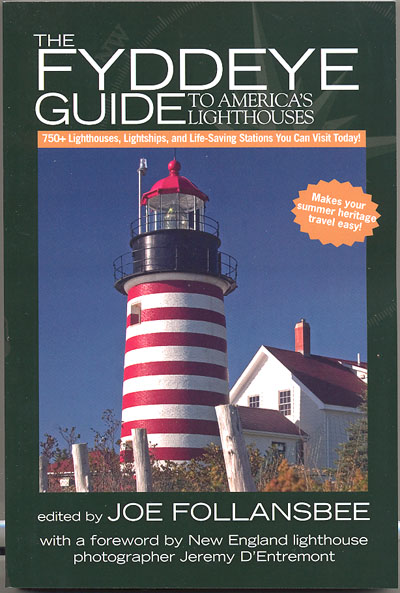
1500. Follansbee, Joe. The
Fyddeye Guide to America's Lighthouses - 750+ Lighthouses, Lightships, and
Life-Saving Stations You Can Visit Today! Fyddeye. United States.
2012. 224p. Soft wraps. Foreword by Jeremy D'Entermont. The Fyddeye Guide to
America’s Lighthouses makes your travel planning easier by showing you
hundreds of fascinating lighthouses, life-saving stations and lightships that
you can visit today on the east coast, Great Lakes, Gulf coast, and the west
coast, including Alaska and Hawaii. From remote islands in Maine to the
metropolises of southern California, you’ll discover the historic structures
that have inspired travelers for millennia. You can get close to virtually all
of America’s lighthouses, and many allow you to climb to the top and stay as
long as a month in historic buildings. More than 750 lighthouses, life-saving
stations and lightships are conveniently organized by coastal region and state.
Included are brief histories and complete contact information, including
website, email address, and phone. Includes too three maps with suggested
itineraries for discovering lighthouses in New England, Michigan, and
California, notes on whether you can stay overnight on the lighthouse grounds,
possibly in the keepers’ historic quarters, and more. Chapters also on
lightships and historic life-saving stations, including availability of
overnight accommodations. More than 40 images of many from coast to coast. (M).
$19.95. Sale Price $9.95.
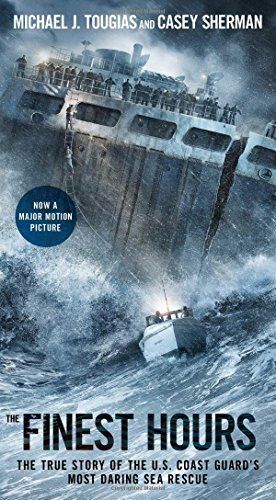
29185-mv. Tougias, Michael and Casey
Sherman. The Finest Hours: The True Story of the U.S.
Coast Guard's Most Daring Sea Rescue. 2015. Simon & Schuster.
311+p. Soft wraps. The true story behind the major motion picture from Disney
starring Chris Pine, Eric Bana, and Casey Affleck written by a recognized master
of the genre a blockbuster account of tragedy at sea (The Providence Journal ).
It s the winter of 1952 and a ferocious Nor'easter is pounding New England with
howling winds and seventy-foot seas. Two oil tankers get caught in the violent
storm off Cape Cod, its fury splitting the massive ships in two. Back on shore,
four young Coast Guardsmen (BM1 Bernard Webber, Andrew Fitzgerald, Richard
Livesey and Irving Maske) are issued a near impossible mission: save the lives
of the stranded seamen. Sailing a tiny lifeboat into the teeth of the killer
storm, the rescue crew soon loses all navigation. With no idea where the
stranded seaman are nor how to get back home, the crew continues, soon coming
upon the SS Pendleton in the darkness. Thirty three hopeful men appear at the
wounded ship’s railings. Can the tiny lifeboat save them all? Dripping with
suspense and high-stakes human drama, The Finest Hours has incredible and
astonishing true-to-life heroism and action-packed rescue scenes. This marvelous
and terrifying yarn ( Los Angeles Times ) deserves a place as a classic of
survival at sea ( The Boston Globe). In the days following the ordeal,
twenty-one Coast Guardsmen involved in multiple rescue missions would be
decorated. Based upon the original 1985 account by Coxswain BM1 Bernard Webber.
(M). $9.99. (x)
Just
in time for the movie release The Finest Hours:
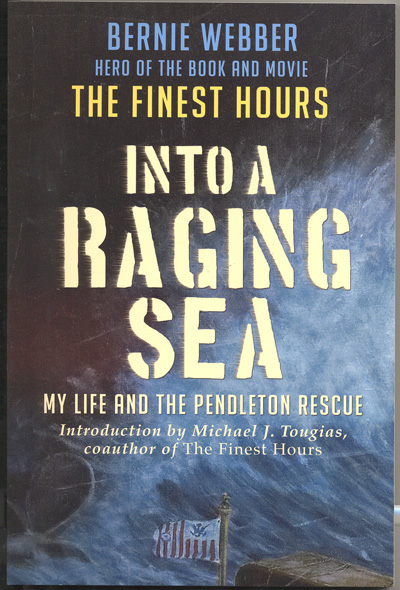
1602.
Webber, Bernie. Into a Raging Sea : My Life and the
Pendleton Rescue. 2016. On Cape Publications. 172p. Soft wraps. Into
A Raging Sea features the riveting, firsthand account of what is widely regarded
as the greatest small-boat rescue in Coast Guard history, told by BM1 Bernie
Webber. Webber and his crew were awarded the prestigious Gold Lifesaving medal
for the miraculous rescue of thirty-two men off the stern of the SS Pendleton
with a thirty-six-foot motor lifeboat, in nighttime blizzard conditions, with
seas surpassing sixty feet. Made more famous in the recently released book and
movie The Finest Hours, the rescue of 32 sailors from the sinking ship caught in
a ferocious winter storm is a dramatic tale, but what made this mission so
special is that the boat Webber skippered that terrible night was a mere 36 feet
in length and the waves were almost twice that size! In Into A Raging Sea,
Bernie tells that story, but the book is so much more than that. In these pages
you'll read about rescue attempts that did not turn out well, stories of
fishermen from a time long past, rescues done with the by-gone technique of the
"breeches buoy," humorous anecdotes, and what Cape Cod and its people
meant to Bernie. Into a Raging Sea is a story of sacrifice, bravery,
disappointment, and challenges. And in the background of Bernie's journey is one
constant, the sea. Forward by Michael J. Tougias. (M). $15.95.
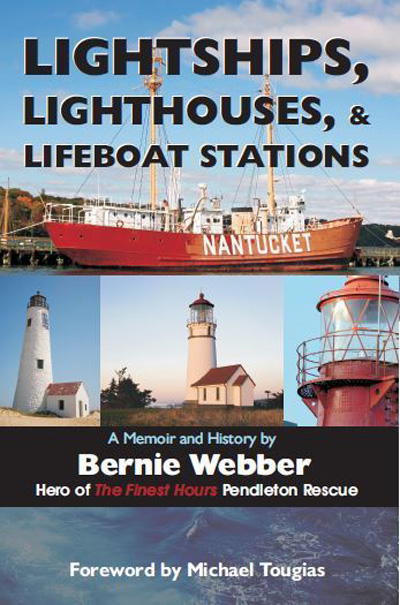
1613.
Webber, Bernie. Lightships, Lighthouses, and Lifeboat
Stations: A Memoir and History. 2015. Universal Publishers. 192p.
Soft wraps. Lightships, Lighthouses and Lifeboat Stations is part history book,
part memoir, written by Bernie Webber, recipient of the Coast Guard's highest
award, the Gold Life-saving Medal, and one of the heros of the Disney movie The
Finest Hours (released January 29, 2016). The manuscript for this book was
written by Webber but not published before he passed away. Now his daughter with
the help of writer Michael Tougias have published this his second book. While
the public will recognize Webber's name from the movie and the bestselling book
by the same name, few people know that during his lengthy Coast Guard career he
served on lightships in addition to lifeboat stations (small boat rescue
stations) and lighthouses. Webber poses the following question: "How did
the lightship men cope with the isolation, constant loneliness, boredom, fear,
or just sheer terror? All were part of life on board a lightship. Rough seas
tossed the ship about, rearing up and down on the anchor chain. This was a world
of isolation, noise from operating machinery, and blasts from the powerful
foghorn that went on for hours, sometimes days, at a time." Webber answers
that question in this book, drawing on a combination of personal experience and
meticulous historical research. Discussions of men going mad, lightships being
run down by larger ships, anchor chains breaking, and lightships cast upon
shoals are offset by humorous stories and the author's reflections on his best
days at sea. Webber also explains some of the heroic actions of a few lightship
men over the years, and points out that they received no recognition at the
time. The isolation these men faced was intense, but they learned to make do
with what they had. Fourteen historic photos are included, as well as a Foreword
by Michael Tougias. A most interesting and deserved further look into Bernie
Webber’s life and career. (M). $25.95.
Note:
I particularly enjoyed Webber’s accounts of life as a young Coast
Guardsman, working with the Keepers from the old Lighthouse Service at Highland
and Gay Head lights, and at Nauset and Gay Head Lifeboat Stations.

20212. na. RESCUE
CG36500. Orleans. 1985. Soft wraps. 48p. Illustrated with over 40
photographs. A collection of stories, photographs and illustrations detailing
the career of CG36500 and the famous rescue of thirty-two men from a broken
tanker on the night of February 8, 1952 off Chatham, Massachusetts. The
information is gleaned from official Coast Guard reports, local news stories and
the men who braved the seas that night themselves. Thirty years after the
rescue, the boat was saved from oblivion and completely restored by volunteers
of the Orleans Historical Society and still proudly plies Cape Cod waters as a
museum dedicated to the memory of life-savers of the United States Coast Guard.
(M). $19.95.
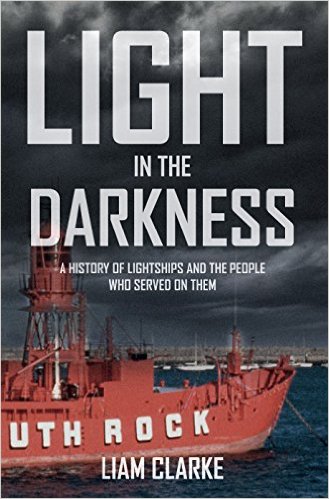
1647.
Clarke, Liam. Light in the Darkness: A History of
Lightships and the People Who Served on Them. Amberley Publishing.
2016. 224p. Soft wraps. Light in the Darkness examines the origins of the
British lightship service, the obstacles and prejudices that faced originators
of the idea and the subsequent development of the vessels and working practices
over the years. Throughout the centuries, this dangerous occupation has claimed
the lives of a number of lightship crews and those who tried to save them. The
lives and working conditions of the brave men, who for over 260 years put their
lives at risk guiding ships safely to their destinations, has been almost
forgotten. Who were these brave men? Why did they do this vital work? Where did
they live and what was the effect upon local communities when these tragedies
occurred? Dr Liam Clarke answers these questions with a discussion of local
lightship disasters including interviews with some of those who once served. The
author, born into a family with a long history of lightship service, has a deep
understanding of the dangerous working conditions and the pressures that this
lifestyle had on the men and their families. He uses this to portray a lonely
and hazardous life which few now remember, and which has rarely been written
about. (M). $24.95.
 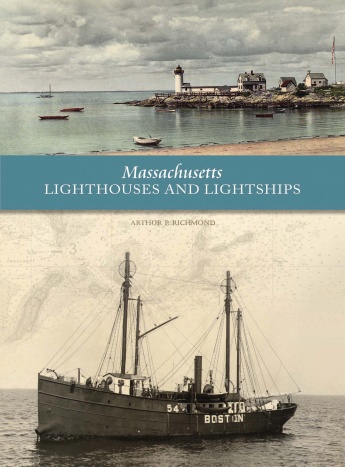
15228.
Richmond, Arthur P. Lighthouses and Lightships of Rhode
Island. Schiffer. 2015. 144p. DJ. This pictorial guide provides a
photographic tour of the last 400 years of Rhode Island lighthouse history. More
than thirty lighthouse stations are described, from Watch Hill, near the
Connecticut border in the south, to the inner harbor of Providence. The
lighthouse station locations are identified using navigational charts and their
characteristics, including date established, tower structure, optics, and fog
signals. Also included are the dozen or so lighthouses that no longer exist.
Probably not as well known, images and characteristics of these aids are
similarly discussed. Over 300 images, some more than 130 years old, show the
original towers and stations, accompanied by present-day photographs that
compare the development and evolution of these lighthouses. Many of the images
found on these pages have been collected from historical resources and are being
published for the first time. This book is a must-have for the lighthouse
enthusiast, maritime buff, and anyone who is interested in Rhode Island history.
(M). $34.99. Our Price $31.50
15218.
Richmond, Arthur P. Massachusetts Lighthouses and
Lightships. Schiffer. 2013. 256p. DJ. A must-have book for the
lighthouse enthusiast, maritime buff, and anyone who is interested in
Massachusetts history. Massachusetts Lighthouses and Lightships includes more
than 850 images, many never before published. Also include historic plans that
describe the details of these aids to navigation, and archival and contemporary
photos that trace through their history. The book covers all the lighthouses and
lightships that marked the shores (exclusive of Cape Cod and the Islands) and
guided mariners through the challenging waters surrounding Massachusetts. This
volume also explores the interiors of towers, shows the lantern rooms of
rarely-visited lighthouses and gives fascinating facts about these beacons over
their 200-year history. More than 876 images in color and b/w, some more than
130 years old, show the original towers and stations. (M). $44.99. Our
price $41.95.
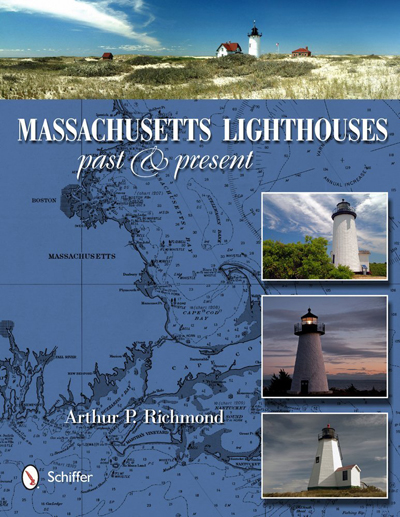
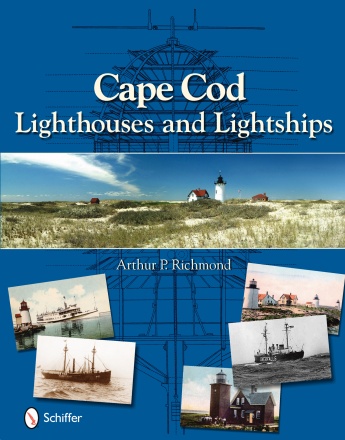
13189.
Richmond, Arthur P. Massachusetts Lighthouses: Past
& Present. Schiffer. 2013. 160p. DJ. A must-have book for the
lighthouse enthusiast, maritime buff, and anyone who is interested in
Massachusetts history, Massachusetts Lighthouses Past and Present describes the
more than sixty lighthouse stations that have been found along the coast from
Fall River in the south to Salisbury in the north, near the New Hampshire
border. The lighthouse station locations are identified using navigational
charts and their characteristics, including date established, tower structure,
optics, fog signals, and many more significant topics are presented in a
straightforward table format. A dozen or so lighthouses that no longer exist,
and probably are not as well known, are also discussed. More than four hundred
images, some more than 130 years old, show the original towers and stations and
are accompanied by present-day photographs of these beacons. Numerous images
show the insides of towers and lantern rooms not only in those open to the
public for tours, but also in restricted or rarely visited lighthouses. (M).
Published at $34.99. Our Price $31.50.
10426.
Richmond, Arthur P. Cape Cod Lighthouses and Lightships.
Schiffer. 2010. 256p. Hard cover. DJ. This is an indispensable reference for the
lighthouse enthusiast, required reading for those interested in maritime
history, and a necessity for anyone who loves Cape Cod. Step back in time and
observe the lighthouses and lightships that marked the shores and guided
mariners through dangerous waters surrounding Cape Cod. Experience these
maritime marvels and trace through the history of these lighthouses and
lightships. Archived plans describe the details of these aids to navigation with
more than 500 images, including some that have never before been published.
Complete your journey with a visit to these historic spots, using the books
comprehensive visitors’ guide. “Cape Cod Lighthouses and Lightships” is so
thoroughly researched, so packed with individual narratives and visuals, that it
is one of the most comprehensive books on Cape lighthouses to date. (M) $45. Our
price $41.95.
 (Photo
not included) (Photo
not included)
20363-pd.
Flint
, Willard. LIGHTSHIPS OF THE
U. S.
GOVERNMENT – Reference Notes. GPO. 1989. Reprint 2016. 540p. Blue
stiff binding. The most complete work ever published on
U. S.
lightships and lightship stations. Lists virtually every detail available on
each vessel, when and where built, cost, sister ships, design, length,
propulsion, when and where it served, construction notes and modifications
through the years, station assignments, masters and mates, illuminating
apparatus, fog signals, final disposition and much more. Listed by vessel and by
station assignment. The original is most difficult to find and sells in the $225
range when found. The ultimate reference on the subject. (M). $85.
 
15269. Smith, Bonnie Hurd and Nelson
Dionne. U. S. Coast Guard Air Station Salem,
Massachusetts: 1935-1970: A Pictorial and Chronological History.
Createspace. 2015 118p Soft wraps. On February 15, 1935, Coast Guard Air
Station Salem opened on Winter Island to respond to emergency calls off the
Atlantic Coast from as far south as Connecticut and as far north as Halifax. Two
years later, the Salem Evening News reported that the air station in 1937 had
established one of the most progressive records for flying and participating in
mercy errands of any Coast Guard air station in the country. A few years later,
during World War II, the men patrolled the coast in search of German U-boats.
Until the Air Station closed in 1970 during a Coast Guard consolidation, Air
Station Salem played a vital role in Salem and far beyond for thirty-five years.
The men bravely saved dozens of lives at sea, and risked their own. Drawing upon
the archive of Salem collector Nelson Dionne, this book presents a brief
chronological history of Coast Guard Air Station Salem and photographs of its
story. Although the station is no longer active, it will always be remembered.
So must the men of Coast Guard Air Station Salem who lost their lives in the
line of duty. Today the few remaining buildings and the area at Air Station
Salem are being improved and restored. (M). $26.
 
15218. Richmond, Arthur P. Massachusetts
Lighthouses and Lightships. Schiffer. 2015.
256p. DJ. A must-have book for the lighthouse enthusiast, maritime buff, and
anyone who is interested in Massachusetts history. Massachusetts Lighthouses and
Lightships includes more than 850 images, many never before published. Also
include historic plans that describe the details of these aids to navigation,
and archival and contemporary photos that trace through their history. The book
covers all the lighthouses and lightships that marked the shores (exclusive of
Cape Cod and the Islands) and guided mariners through the challenging waters
surrounding Massachusetts. This volume also explores the interiors of towers,
shows the lantern rooms of rarely-visited lighthouses and gives fascinating
facts about these beacons over their 200-year history. More than 876 images in
color and b/w, some more than 130 years old, show the original towers and
stations. (M). $44.99. (x)
15228. Richmond, Arthur P. Lighthouses
and Lightships of Rhode Island. Schiffer. 2015. 144p. DJ. This
pictorial guide provides a photographic tour of the last 400 years of Rhode
Island lighthouse history. More than thirty lighthouse stations are described,
from Watch Hill, near the Connecticut border in the south, to the inner harbor
of Providence. The lighthouse station locations are identified using
navigational charts and their characteristics, including date established, tower
structure, optics, and fog signals. Also included are the dozen or so
lighthouses that no longer exist. Probably not as well known, images and
characteristics of these aids are similarly discussed. Over 300 images, some
more than 130 years old, show the original towers and stations, accompanied by
present-day photographs that compare the development and evolution of these
lighthouses. Many of the images found on these pages have been collected from
historical resources and are being published for the first time. This book is a
must-have for the lighthouse enthusiast, maritime buff, and anyone who is
interested in Rhode Island history. (M). $34.99. (x)
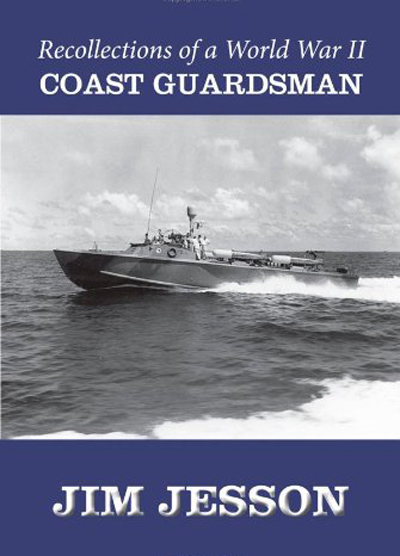
1589. Jesson, Jim. Recollections
of a World War II Coast Guardsman. 2013. 33p. Soft wraps. A series of
short stories recollected by Jim Jesson who served in the US Coast Guard in
World War II. These are actual events in Coast Guard history with the dates,
places, and statistics recalled to the best of Jim's memory. War II raged across
the world, few Americans were aware just how close to our shores the mighty
German Navy operated. Later a Boston Detective, Jim Jesson take you back to that
time, sharing his insights and experiences in a way that only a WW II veteran
can. As German U-boats approached the Atlantic shore of the U.S., they set their
sights on civilian and naval vessels alike. As a young man like so many others,
Jim Jesson set out to do his part for America. From his first confrontation with
a German U-boat as a teenage civilian working on a Boston-based tugboat to a
later military service encounter with Germans on Nantucket Island, Jesson
carries the reader back to a fearful time in history. Readers will be amazed at
the little known heroics of a team of specially trained Police Officers who came
face to face with a squad of German SS troops protecting a German communications
outpost. Jesson further brings to words the experience of a mere teenager aboard
a Mystery Q-ship out in the fierce North Atlantic. The Q-ship was heavily armed
with concealed weaponry, acting as a decoy to the merciless enemy. These and
other short stories in the book add new insights to the War in New England. (M).
$24.

15253. Towers, Guy. St.
George Reef Lighthouse. Arcadia 2015. 128p. Soft wraps. With over 200
vintage photographs. Situated at the end of a reef six miles offshore of
Crescent City, California, stands St. George Reef Lighthouse. Constructed after
the wreck of the coastal steamer Brother Jonathan in 1865, the beacon warned
mariners of the dreaded “Dragon Rocks” of St. George Reef for nearly a
century. This book chronicles the loss of the Jonathan, decades of efforts to
make the light a reality, the 10-year construction period, manning of the
station by keepers of the US Lighthouse Service and Coast Guard, and the
struggles and accomplishments of dedicated volunteers to restore what many
lighthouse historians refer to as “America’s greatest lighthouse.” This
compact volume features numerous early photographs dating from the 1870’s to
the present, drawn from the author’s and other private collections, most never
before published, and traces the history of this light station through photos
and text. Filled with early views. (M). $21.99.

15223. Barbo, Theresa Mitchell. Hidden
History of Cape Cod. The History Press. 2015. 144p. Soft wraps. The
proverbial salty waves and sandy beaches of Cape Cod disguise its fascinating
and nearly forgotten history. There’s history that is hidden beneath our feet,
over our heads and sometimes right before our eyes. Learn why one of the most
famous rescues in Coast Guard history spent nearly fifty years in the shadows
without public notice. Discover which wild creature went from the 19th century
soup pot to enjoying conservation protection under state law. Historian Theresa
Mitchell Barbo explores these mysteries and more, from the lost diary of a
nineteenth century schoolteacher to the reason Cape Codders call their lunch
“the noontime dinner.” Join Barbo as she lifts the lid on the quirky and
remarkable character of Cape Cod and its forgotten and neglected happenings of
yesteryear. Illustrated with 39 Black And White photos. Interesting reading.
(M). $21.99.
Available
once again:
 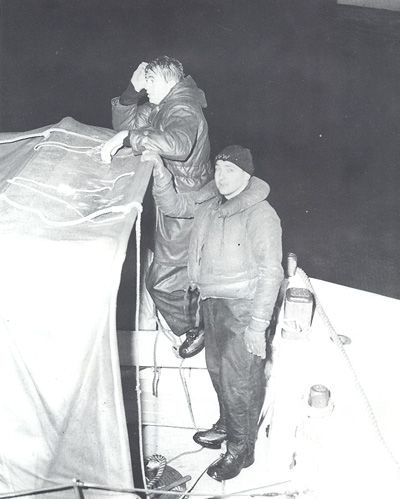
20209. Webber, Bernard C., CHATHAM
“The Lifeboatmen”.
Orleans
,
Mass.
1985. 1st. 128p. Illustrated
with numerous photographs. Late in February 1952, a northeaster swept
New England
with bitter cold, snow and gale force winds. East of Chatham 70-knot winds and
60-foot seas battered merchant vessels as the tankers SS Fort Mercer and SS
Pendleton met the full force of the storm. They both broke in two on the morning
of February 19th with 84 half-frozen men marooned on the battered hulks. The
story of how these men were rescued is retold even today. In the days following
the ordeal, twenty-one Coast Guardsmen would be decorated. The men who ventured
into 60-foot seas in the little 36-foot CG36500 motor lifeboat to rescue the
tanker crews showed what heroism really is. How this all came about, and the
story of life at Cape Cod small boat stations in the 1950’s, is a tale well
worth reading and a tribute to Coast Guardsmen everywhere. Wonderful reading.
(M). $44.95.
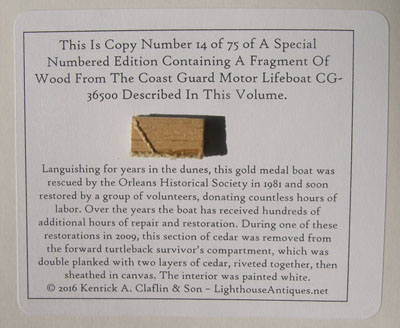
Special numbered edition
with actual wood piece from MLB CG-36500. $59.95.
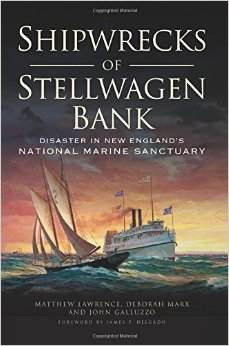 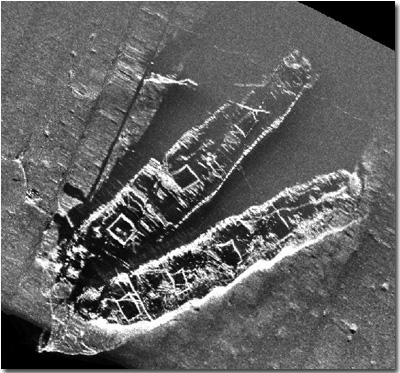
15208. Lawrence, Matthew, John
Galluzzo and Deborah Marx. Shipwrecks of Stellwagen
Bank: Disaster in New England's National Marine Sanctuary. 2015.
History Press. 144p. Soft wraps. Beneath the churning surface of Stellwagen Bank
National Marine Sanctuary rest the bones of shipwrecks and sailors alike.
Massachusetts’ ports connected its citizens to the world, and the number of
merchant and fishing vessels grew alongside the nation’s development. Hundreds
of ships sank on the trade routes and fishing grounds between Cape Cod and Cape
Ann. Their stories are waiting to be uncovered—from the ill-fated steamship
Portland to collided schooners Frank A. Palmer and Louise B. Crary and the
burned dragger Joffre. Join historian John Galluzzo and maritime archaeologists
Matthew Lawrence and Deborah Marx as they dive in to investigate the sunken
vessels and captivating history of New England’s only national marine
sanctuary. Illustrated with over 50 b/w photos. (M). $21.99. (x)
2nd Edition Just Out:
 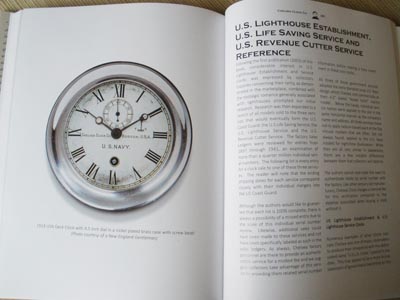
23290e. Demeter, Andrew and David. CHELSEA
CLOCK COMPANY: The First Hundred Years. 2nd edition. 2014. For over a
hundred years the Chelsea Clock Company has manufactured a distinguished line of
high quality clocks. Regarded as one of
America
’s highest quality products, Chelsea Clocks have been presented to heads of
state throughout the world. Photographs taken in the White House throughout this
century show Chelsea Clocks in settings of distinction. Collectors have long
prized them for their quality, beauty, unique design and historic significance.
Now in this updated and lengthened second edition, the history of the Chelsea
Clock Company has been written and it reads like a contemporary enterprise
including mysteries, disasters, near failure and a fascinating collection of
characters. Historical photographs, vintage advertisements, as well as
illustrations and photographs from old catalogues are included. This updated and
expanded second edition also includes: Ten more vintage models added to the
Identification Guide to help collectors in identifying seldom seen designs, with
color photographs from the finest collections in America, an Alphabetical Index
on every movement model developed by the company by date and designated purpose,
individual indices that list every clock made for the U.S. Lighthouse
Establishment & Service, U.S. Life-Saving Service, and U.S. Revenue Cutter
Service by serial number, type, and date of issuance, a new Boston Clock Co.
Index of this subsidiary’s manufacture of clocks from 1909 to 1931. With
eighty-five more pages of material to assist the collector in identifying
factory issued models and their origins, this work will surely be a “must
have” for collectors and professionals alike. Andrew and David Demeter have
created a remarkable volume complete with lists of serial numbers to aid you in
authenticating your piece, and photographs of Chelsea Clock Company’s current
staff. In Chelsea Clock Company: The First Hundred Years, the Demeters have once
again provided a valuable and sought after resource for collectors and those who
appreciate American craftsmanship at its finest. Only 1000 of this second
edition have been printed and they will be in great demand! (M). $145. (no discounts apply)
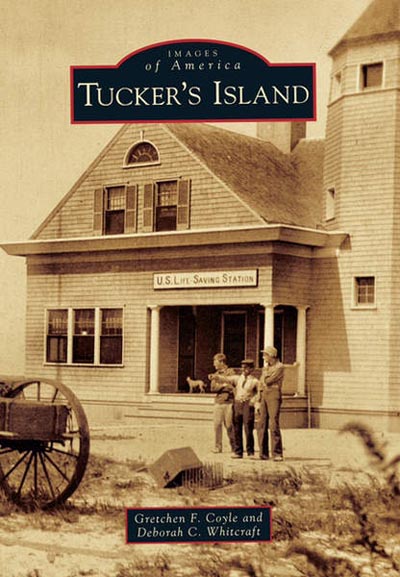
15181. Coyle, Gretchen F. and Deborah
C. Whitcraft. Tucker's Island. Arcadia 2015.
128p. Soft wraps. With over 160 vintage photographs. Once located between Great
Bay and Little Egg Harbor, along the New Jersey coast, in 1932 Tucker’s Island
disappeared into the Atlantic Ocean. Sand dunes and native foliage once covered
its eight miles. For generations, the Rider family kept the lighthouse
illuminated, and the US Life-Saving Service provided aid to ships in distress.
Two hotels were constructed by island men with building materials salvaged from
local shipwrecks. Visitors arrived by sail or steam, and the popularity of
Tucker’s Island inspired real estate agents to sell worthless lots to
unsuspecting buyers eager for their own piece of the shore. Over the years
storms battered the vulnerable island and by 1927 the lighthouse toppled onto
the sand. Soon the life-saving station washed away, and in 1932, the island was
removed from tax records. This compact volume features numerous early
photographs dating from the 1870’s through the 1920’s, drawn from the
author’s and other private collections, most never before published, and
traces the history of these services and the island through photos and text.
Filled with early Life-Saving and Coast Guard views.
(M). $21.99.

1578. Ewen, William H. Jr. and Tom
Dunlop. Steamboats to Martha's Vineyard and Nantucket. Arcadia.
2015. 128p. Soft wraps. With over 226 vintage photographs. The islands of
Martha’s Vineyard and Nantucket, off the Cape Cod coast of Massachusetts, were
first inhabited by members of the Wampanoag tribe. English settlements were
established in the mid-1600s. As the populations and commerce grew, so did the
need for reliable transportation. The islands were first served by privately
owned sailing vessels, but things began to change with the introduction of
marine steam power. In 1818, the little steamer Eagle was the first to cross
Nantucket Sound. Although she only remained in these waters for three months,
she began what was to become a tradition of steamboat travel to the islands that
lasted for 170 years. The images in this volume include well-known steamers with
familiar names like Nobska, Naushon, Gay Head, and Uncatena, as well as many
others. This compact volume features 226 early photographs dating from the
1800’s through today, drawn from the author’s and other private collections,
most never before published, and traces the history of these services through
photos and text. (M). $21.99. (x)
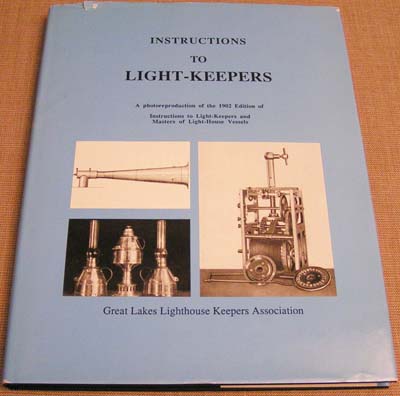
2096. Light-House Board, INSTRUCTIONS TO
LIGHT-KEEPERS AND MASTERS OF LIGHT-HOUSE VESSELS. GPO. 1902.
104 pp includes 39 plates. Nicely photo-reproduced by the Great Lakes
Lighthouse Keepers Assoc., Michigan, 1989. Available in hardcover with DJ.
This is a MUST for anyone interested in the subject. Contains a wealth of
information, particularly in the plates for use in identifying lamps.
Includes complete Instructions for Light-Keepers in Stations with Two or
More Keepers, Light Stations With One Keeper, Keepers of Light-Vessels,
Management of Lens Lights and Disposition of Lamps and Illuminating
Apparatus, Management of Mechanical Lamps, Revolving Machinery, trimming
of wicks, morning duties, and much more. Includes all aspects of station
and apparatus maintenance. A very complete and important document.
Excellent value for the price. New. Hardcover. $24.95. Softcover
$19.95
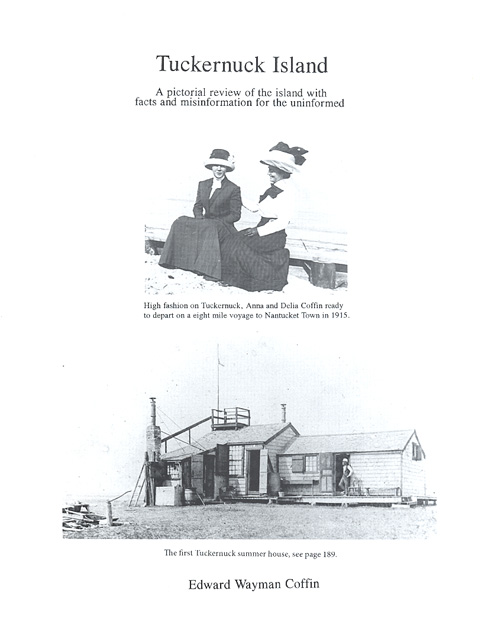
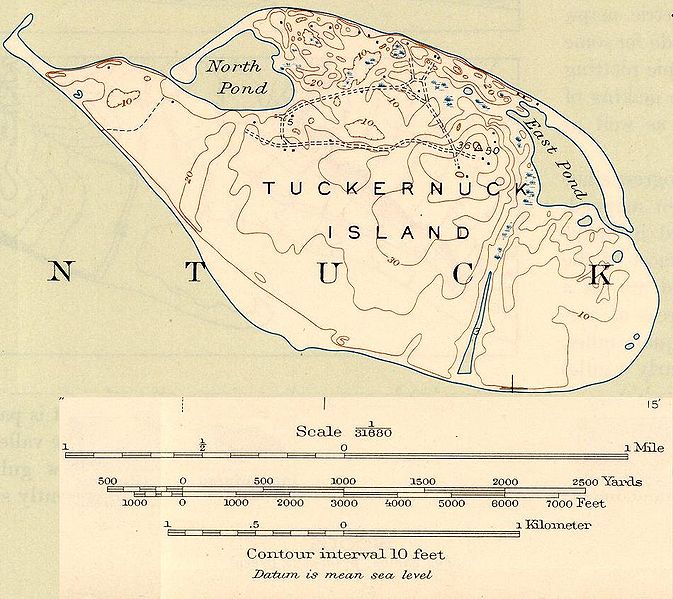
10427.
Coffin, Edward Wayman. TUCKERNUCK ISLAND – A
Pictorial Review of the Island. [self published] 2008. 200p. Soft
wraps. Lying west of
Nantucket
, just eight miles from
Martha’s Vineyard
, Tuckernuck is a low bleak island, ringed with sandy shoals and often entrapped
by foul weather. The island has an area of about 900 acres (1.4 square miles).
Often ice bound in winter with high tides, Tuckernuck, like its neighbor
Muskeget, was the scene of many shipwrecks through the years. Its population
consisted occasional fishermen with only seasonal increases by the local Island
Club gunners taking advantage of the prolific fowl population. This unusual book
is written from the point of view of an islander (the author’s father served
on the neighboring island as a Life Saving Service surfman). The book relates
many interesting tales formerly untold with interesting comments on the life and
recreation of the seasonal population. Also included are hundreds of rare
photographs from private collections. Privately published in a very limited
quantity (only 500 printed), quite difficult to find now. (M). $42.

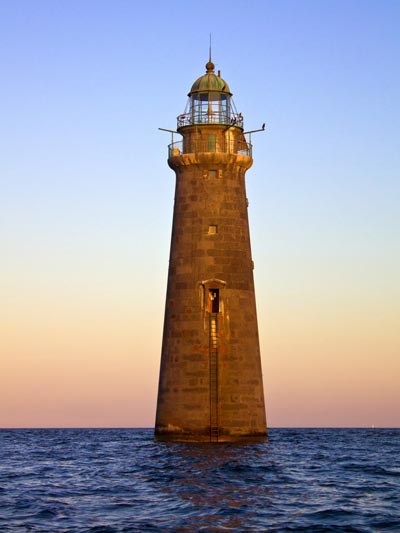
1530.
D’Entremont, Jeremy. Lovers' Light: The History of
Minot's Ledge Lighthouse. 2015. Coastlore Media. 121p. Soft
wraps. Minot's Ledge Lighthouse, off Boston's South Shore near the towns of
Cohasset and Scituate, has a fascinating history replete with heroism, tragedy,
and triumph. Widely known as the "I Love You Light" after its famous
1-4-3 flash characteristic, it has sparked the imaginations of lighthouse lovers
around the world. The present (1860) tower is one of the classic examples of a
granite wave-swept lighthouse and has withstood the battering of countless
storms. It stands today as a testament to its designers and builders and as a
monument to the brave keepers who stood watch for nearly a century. This new
book brings together a variety of source documents, including correspondence,
government documents, log entries, interviews with keepers, and much more to
help paint an historic portrait of one of the world's most dramatic lighthouses.
Well illustrated with photos, engravings and illustrations. (M). $12.95.
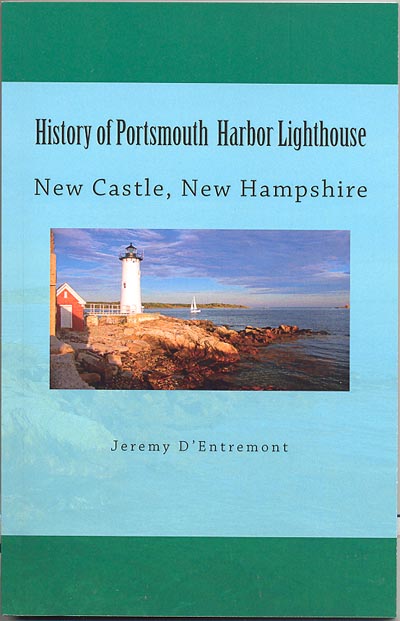
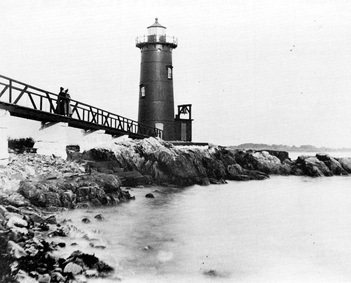
1531.
D’Entremont, Jeremy. History of Portsmouth Harbor
Lighthouse. 2013. Friends of Portsmouth Harbor Lighthouses. 66p. Soft
wraps. The large, well-protected harbor of Portsmouth, New Hampshire, on the
Piscataqua River, was an important port in colonial America. It still remains
New Hampshire's only deep water port. It was here that a lighthouse, the first
one in the American colonies north of Boston, was established in 1771. In nearly
two and one-half centuries since that time, the light station has been home to a
succession of fascinating personalities and the scene of much human drama. This
book brings together a variety of source documents, log entries, interviews with
keepers, and much more to help paint an historic portrait of this interesting
light station. Well illustrated with photos, engravings and illustrations. (M).
$8.95.
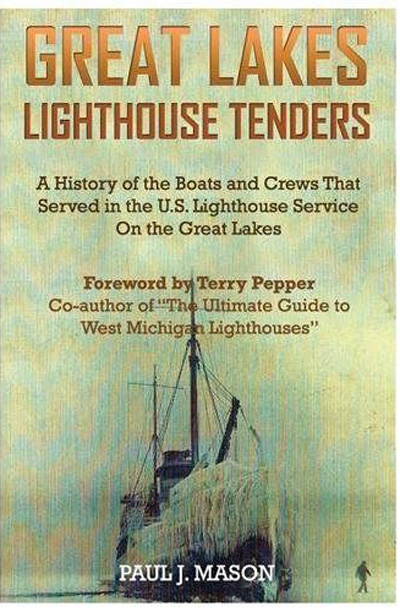
14325. Mason, Paul J. Great
Lakes Lighthouse Tenders: A History of the Boats and Crews That Served in the
U.S. Lighthouse Service on the Great Lakes. M&B Global Solutions.
2014. 66p. The ships and crews of the U.S. Lighthouse Tender Service were the
unsung heroes of Great Lakes transportation for more than a century. Yet despite
the critical role they played in maritime operations, little information is
available about these hard-working men and the ships they called home.Author
Paul J. Mason provides an illustrated history of lighthouse tenders that served
on "The Lakes," complete with rare photos and fascinating back
stories. Great Lakes history buffs will enjoy learning about these forgotten
ships and crews, and their place in maritime's golden age. Author Mason’s
interest in the U.S. Lighthouse Service and its Great Lakes tenders stems from
his grandfather, Richard H. Burdeno, was chief engineer on the USLHT Clover.
Paul joined the U.S. Coast Guard Auxiliary and currently serves as a volunteer
crew member on a Coast Guard 25-foot patrol boat at U.S. Coast Guard (AUXOP)
Station Green Bay (Wisconsin). (M). $19.
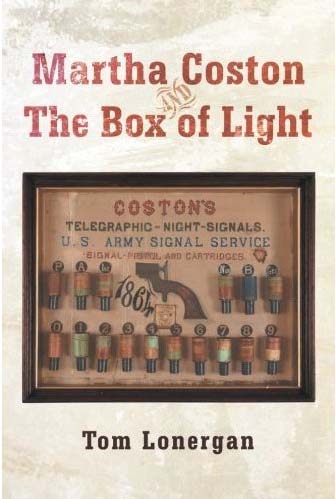
1486. Lonergan,
Tom. Martha Coston and The Box of Light.
iUniverse. 2013. 196p. Soft wraps. Widowed at the age of twenty-one, left
penniless with four children to raise, Martha Coston overcame nineteenth century
bias to carry on her deceased husband's work, patenting and manufacturing
history's first night time signal device. Traveling the world, she then
successfully marketed the Coston Night Signal to the navies, coast guardians and
railroads of every industrialized nation, founding a company that flourished for
more than a century. In her lifetime, Martha Coston became close friends with
Admiral David Farragut, was introduced to British society in Queen Victoria's
own drawing room, banqueted with Napoleon III at the Palaise de Tuilleries,
danced with the King of Sweden at his summer retreat at Rosendal, was feted by
the Admiral of the Russian fleet at Kronstadt Island in St. Petersburg,
struggled across winter ice floes in Scandinavia and fought fang and claw with
the United States Congress for her invention to be recognized. Detailed,
interesting account written in the first person. (M). 21.95.

14230. Williams, Gary. Guardian
of Guadalcanal: The World War II Story of Douglas A. Munro, United States Coast
Guard. Lakota Press, 2014 . 280p. DJ. Guardian of Guadalcanal is the
World War II biographical account of Petty Officer Douglas A. Munro, United
States Coast Guard, the Coast Guard’s only Medal of Honor recipient.
“Douglas A. Munro, a signalman first class of the United States Coast Guard,
died heroically on Guadalcanal September 27, 1942, after succeeding in his
assignment, for which he had volunteered, to evacuate a detachment of Marines
from a point where enemy opposition developed beyond anticipated dimensions.
Munro's final words were "Did they get off?" As World War II
approached, Munro left to enlist in the United States Coast Guard in 1939. He
had an outstanding record as an enlisted man and was promoted rapidly through
the various ratings to a signalman, first class. In the action [where he was
killed in action], Munro had already played an important part, since he was in
charge of the original detachment of ten boats that had landed the Marines at
the scene. He had successfully got them ashore and then had headed his boats
back to a previously assigned position. Almost immediately upon his return, he
was advised by the officer in charge that conditions had been different than had
been anticipated and that it was necessary to evacuate the men immediately.
Munro volunteered for the job of heading the boats for the evacuation. In charge
of the rescue expedition, he brought the boats in-shore under heavy enemy fire
and proceeded to evacuate the men on the beach. When most of them were in the
boats, complications arose in evacuating the last men, whom Munro realized would
be in the greatest danger. He accordingly so placed himself and his boats that
they would serve as cover for the last men to leave. It was thus that he was
fatally wounded -- protecting the men after he had evacuated them. He remained
conscious sufficiently long only to say four words: "Did they get
off?" He died, therefore, with the realization that his mission had
succeeded and his final assignment had been carried out.” In addition to the
Medal of Honor, Munro was also awarded, posthumously, the Purple Heart Medal,
and was eligible for the American Defense Service Medal, the Asiatic-Pacific
Area Campaign Medal, and the World War II Victory Medal. To this date, Munro is
the only Coast Guardsman to have been awarded the Medal of Honor. Written by the
acclaimed author of SEAL of Honor, Gary Williams, the full story of Douglas
Munro’s life and service has finally been told in it's entirety. Petty Officer
Douglas A. Munro truly led by example “…he was courageous, selfless and was
only thinking about the mission at hand”. This book is a tribute to Petty
Officer Munro and is a worthwhile read. A significant individual in
Coast Guard history who should not be forgotten. (M).
$29.99. (x)

14255. Marshall, Charles. Surfmen.
Fireship Press. 2013. 294p. Soft wraps. As lightning cracks over a roiling sea,
a young boy clings to life amidst the waves. His family... his friends... all
that he's ever known... have been taken by the storm. Drifting in the sea-tossed
wreckage, the boy is unexpectedly rescued and given a new chance at life on the
sands of the Outer Banks of North Carolina. Thirty years later, thirteen years
after the Civil War, on that same far-flung spit of sand at Cape Hatteras, seven
men of courage face the sea and its storms as men of the United States
Lifesaving Service. Recruited and trained by that same boy grown to manhood,
Confederate blockade runner Captain Thomas Hooper, the men of Cape Hatteras
Station are the only hope for sailors in distress at the treacherous Diamond
Shoals. As Thomas Hooper readies his men to fight the sea and tries to keep them
from fighting each other, he realizes that the souls he's there to save may very
well be those of his men and himself. A good read. (M). $29.95. (x)
The movie
is on the way - read now of the greatest small boat rescue in Coast Guard
History:
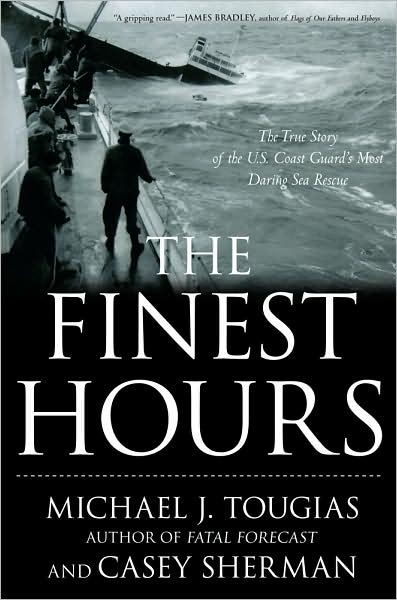
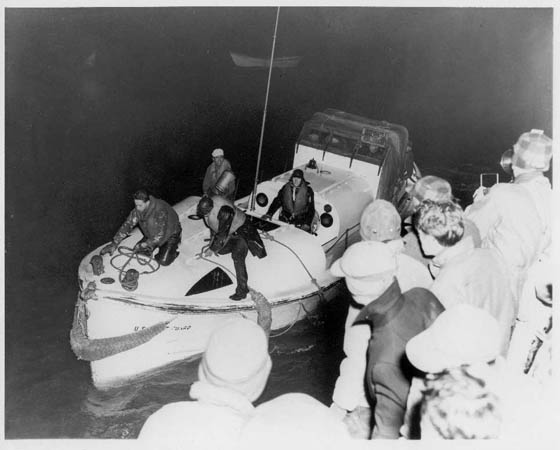
29185.
Tougias, Michael J and Casey Sherman. The Finest Hours
- The True Story of the
U.S.
Coast Guard's
Most
Daring
Sea
Rescue. Simon and Schuster. 2009. 224p. In the winter of 1952,
New England
was battered by the most brutal nor'easter in years. As the weather wreaked
havoc on land, the freezing
Atlantic
became a wind-whipped zone of peril. In the early hours of Monday, February 18,
while the storm raged, two oil tankers, the Pendleton and the
Fort
Mercer
, found themselves in the same horrifying predicament. Built with "dirty
steel," and not prepared to withstand such ferocious seas, both tankers
split in two, leaving the dozens of men on board utterly at the
Atlantic
's mercy. The Finest Hours is the gripping, true story of the valiant attempt to
rescue the souls huddling inside the broken halves of the two ships. Coast Guard
cutters raced to the aid of those on the
Fort
Mercer
, and when it became apparent that the halves of the Pendleton were in danger of
capsizing, the Guard sent out two thirty-six-foot lifeboats as well. These
wooden boats, manned by only four seamen each, were dwarfed by the enormous
seventy-foot seas. As the tiny rescue vessels set out from the coast of
Cape Cod
, the men aboard were all fully aware that they were embarking on what could
easily become a suicide mission. The spellbinding tale is overflowing with
breathtaking scenes that sear themselves into the mind's eye, as boats capsize,
bows and sterns crash into one another, and men hurl themselves into the raging
sea in their terrifying battle for survival. Not all of the eighty-four men
caught at sea in the midst of that brutal storm survived, but considering the
odds, it's a miracle -- and a testament to their bravery -- that any came home
to tell their tales at all. (M). Soft cover $14.95.
For
more information see our SS
Pendleton - SS Fort Mercer page.
A
Sleeper! Well Done! We recently purchased the author’s remaining stock and can
pass on the savings to you:

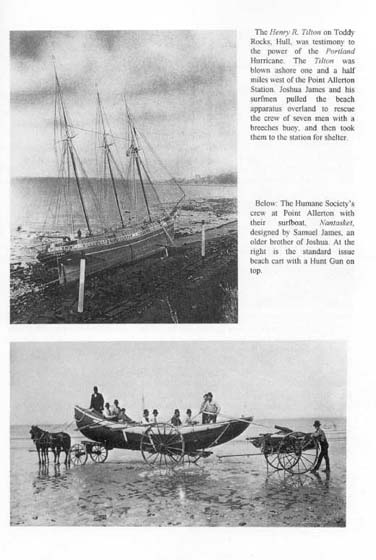
20230.
Farson, Robert H., TWELVE MEN DOWN – Massachusetts Sea
Rescues. Yarmouth Port.2000. 246p. 191 photos and illustrations. In Colonial Days Massachusetts turned
to the sea for her livelihood. With the growth of coastal and deepwater fleets,
many trips ended in disaster. The loss of life was so great that in the late
1700’s the Massachusetts Humane Society was formed. Their work up to
World War II, and the work of its successor the U. S. Life-Saving Service, are
detailed in this wonderful new work. From Martha’s Vineyard and Cuttyhunk, to
Nantucket, Cape Cod and up the coast to Salisbury Beach, there were small stations with surfboats and breeches buoy apparatus. This is
a book about rescues near the coast by men who rowed small boats into
mountainous waves, many in bitterly cold weather. Thousands of sailors were
saved by these intrepid men and their story of selfless dedication comes alive
in Mr. Farson’s work. Nicely illustrated with numerous vintage photographs.
(M). (Published at $36.) Special Purchase Price. $19.95.

14121. Ives, John G. The
Keeper. Bohme Publishing. 2013. 416p. Soft wraps. The Keeper is a
fresh, new historical fiction at its very best. Filled with electrifying rescue
scenes, pitting a handful of men against fierce storms and bitter cold. A story
of honor and love, fellowship and betrayal, strength and vulnerability. This is
a novel of the Life-Savers, set in Provincetown, on the tip of Cape Cod, in
1899. Joshua Duell, the book's hero, is a young New Yorker who returns home from
the Spanish American War. Now his mother has disappeared in a mysterious
shipwreck, and he travels to the small village of Provincetown at the outer
reach of the continent to find out how. With his friend and college roommate
Buddy, Joshua joins the United States Life-Saving Service patrolling the outer
beaches. Under the leadership of their Keeper John MacDonald, they face rigorous
training and treacherous work as the storms come. Buddy is a charmer, but he
alienates the other Life-Savers, which leads him to take drastic actions he and
Joshua will come to deeply regret. A story of intense action, beautiful
descriptions of the sea, and the coming of age of a fascinating young man. (M).
$18.95. (x)

14228. Eisner, Harvey (ed). WTC:
In Their Own Words. 2011. Cygnus. 278p. Soft wraps. With DVD of
interviews and testimonials from survivors and firefighters. Filled with
comprehensive, exclusive interviews with firefighters who responded to the World
Trade Center attack, WTC: In Their Own Words, is a special collector's edition
book from Firehouse Magazine in commemoration of the 10 year anniversary of the
attack and as a testimonial to the first responders. Eisner, a retired Tenafly,
New Jersey fire chief and longtime editor of Firehouse Magazine, felt the
calling to capture the story of 9/11 and present it through the eyes of those
who responded to the call – members of the FDNY – the New York Fire
Department. It’s more than photojournalism at its best – captured images
from a perspective never before seen by the public. It’s a reference guide.
And in years to come, it may very well be a seminal historic accounting of the
immediate aftermath of the worst terrorist attack in history. For some, still
active or retired firefighters, it was too difficult to tell the story. For
others, it was just the first, or second time, that they’ve ever articulated
the emotional pain of that fateful day, nearly 10 years ago. This softbound book
takes a highly detailed, in-depth look at the day's events and fire department
response. This book also includes an exclusive DVD which includes interviews and
testimonials from survivors and firefighters. Eisner felt it important to record
for history the words of some of those who put their lives on the line. To
present stories that have never before been publicly shared. A portion of the
proceeds from the sale of this volume will benefit these four organizations:
FDNY Foundation, National Fallen Firefighters Foundation, UFA Thomas R. Elsasser
Fund, Wounded Warrior Project. A fitting tribute to responders who we should
never forget. (M). $49.
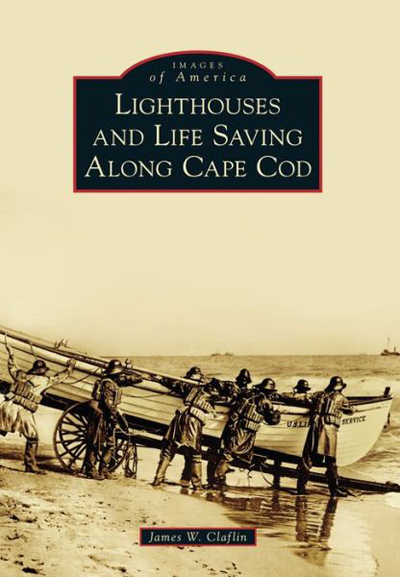

1443. Claflin, James W. Lighthouses
and Life-Saving Along Cape Cod. Arcadia. 2014. 128p. Soft wraps. With
over 200 vintage photographs, this is the fourth volume in a series of
photographic histories of lighthouses and lifesaving along the coasts of the
United States by the author. For centuries, heroic men and women have guarded
the treacherous yet beloved Cape Cod coastlines. From Provincetown to Chatham,
Sandwich to Cuttyhunk, and many towns in between, residents have relied on the
Atlantic for employment and nourishment. But Cape Cod has always been plagued
with a shifting coastline that consistently defies mariners’ efforts to pass
through Massachusetts waters. In 1792, as shipping increased, mariners
petitioned for a sorely needed lighthouse. It was not until 1797 that the first
lighthouse on Cape Cod was built at the Highlands in North Truro. More lights
and rescue stations would follow as the seas claimed their toll. Many lightship
stations were also established from Chatham through Nantucket Sound to mark the
constantly changing sandbars submerged offshore—more than in any other spot
along the US coastline. Today, as sea levels change and sands continue to shift,
some of these historic stations have been lost or moved, while still others are
preserved only in such photographs as these. This compact volume features over
200 early photographs dating from the 1870’s through the 1960’s, drawn from
the author’s and other private collections, most never before published, and
traces the history of these services through photos and text. (M). $21.99.
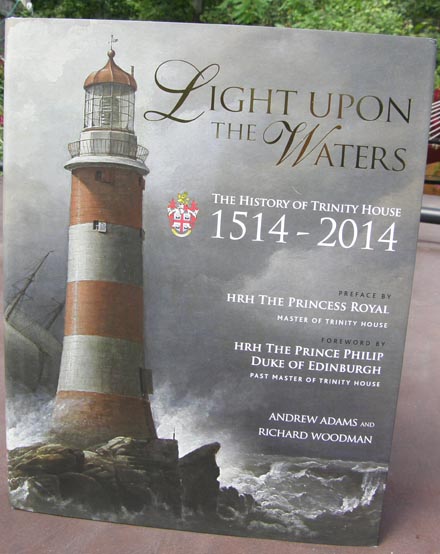
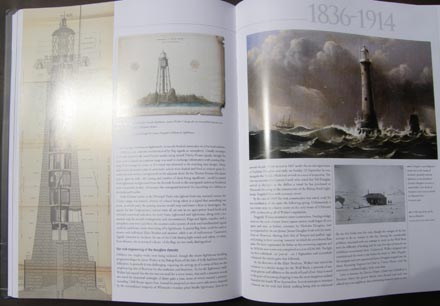
14222. Woodman,
Richard and Andrew Adams. 'Light Upon the Waters' - The
History of Trinity House. The Corporation of Trinity House. London.
2013. 320p. DJ. Hardback, large format and lavishly illustrated with 450 colour
photos and illustrations, plans and charts. As part of their quincentenary
celebrations, Trinity House has produced the definitive history book of the
Corporation, 'Light Upon The Waters'. Trinity House is a private corporation
governed under a Royal Charter. It has three core functions: it is the official
General Lighthouse Authority for England, Wales, the Channel Islands and
Gibraltar, responsible for the provision and maintenance of navigational aids,
such as lighthouses, lightvessels, buoys, and maritime radio/satellite
communication systems. Trinity House is also an official deep sea pilotage
authority, providing expert navigators for ships trading in Northern European
waters. The story of the corporation from incorporation to the current day, a
span of 500 years, has been thoroughly researched and written up and illustrated
with many beautiful and striking images from the corporation's extensive
archives and collections. The book contains a wealth of information and is
particularly good on nineteenth century lighthouse construction. This book will
serve as the official definitive history, from the days of Henry VIII to the
technological developments and changes faced in the new millennia. At the end of
five centuries, the corporation remains; striving to serve the mariner with
undiminished energy and inventiveness. This hardback, large format book delivers
a fine illustrated history of Trinity House and calls upon the strengths of two
experts in their respective fields: Captain Richard Woodman and Captain Andrew
Adams. Captain Adams was a boy seaman when he joined Trinity House in 1963.
During his over 40 year career he gained a wide experience afloat, becoming
Chief Pilot in the Port of Harwich, and an RNR Captain and Nautical Adviser. His
contribution to this book derives from his interest in a knowledge of the
history of pilotage. He is a Younger Brother of Trinity House. Captain Woodman
went to sea aged 16 and served in cargo-liners and Ocean Weather Ships before
spending more than 30 years with Trinity House, several in command afloat and
ashore. He was elected an Elder Brother in 2006. He is a keen yachtsman and an
award-winning author with over 50 published works to his credit. A splendid book
that deserves to be alongside anyone’s maritime collection and a must for
anyone even remotely interested in lighthouse history, British maritime history
and the lighthouses of the British Isles. Difficult to find. Weight 5 lbs. (M).
$145. (x)
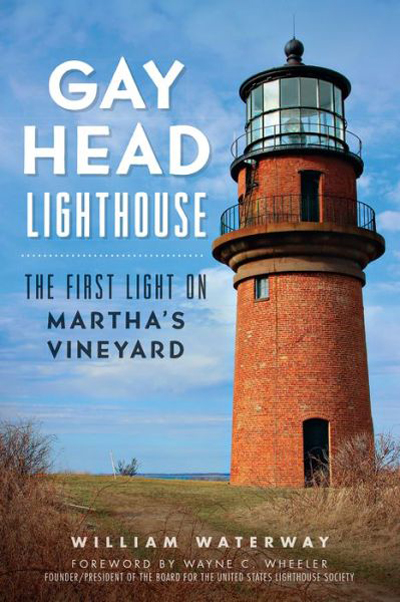 
14118. Waterway, William. Gay
Head Lighthouse – The First Light on Martha’s Vineyard. 2014.
History Press. 176p. Soft wraps. On the afternoon of October 21, 2013, Gay Head
Lighthouse researcher William Waterway discovered the 1844 stone foundation for
Martha’s Vineyard, Massachusetts’s original 1799 wooden Gay Head Lighthouse
when it was moved back 75 feet from the eroding cliffs. Today, still standing
tall on the colorful clay cliffs of Martha’s Vineyard, Gay Head Lighthouse
continues to provide safe passage to seafarers as it has since 1799. The
steadfast tower marks a dangerous and heavily traveled passage between the
island and mainland known as Devil’s Bridge. Being the first lighthouse on the
Vineyard, Gay Head Light has a rich and varied history filled with stories of
inspirational lighthouse keepers, disastrous shipwrecks and even mysterious
deaths. Today, Gay Head Light serves as an iconic symbol of the island’s
maritime history and attracts visitors from around the world. Join author
William Waterway as he charts the history of the lighthouse from the original
wooden tower lit with oil lamps to the rebuilt brick structure that houses the
famous Fresnel lens. Filled with information on the light’s keepers and their
families, changes over the years, the nearby Life-Saving station and crews, and
more, this is a long awaited addition to our lighthouse libraries. (M).
$19.99.
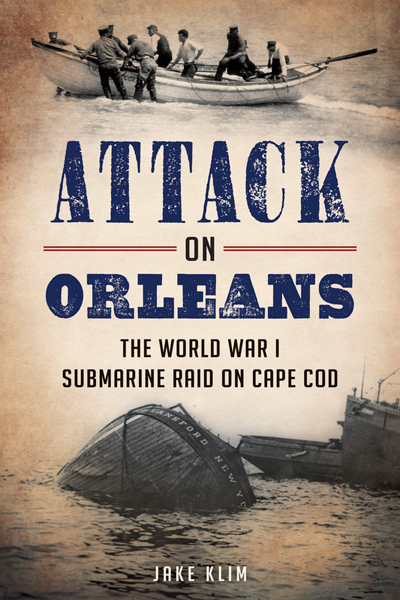 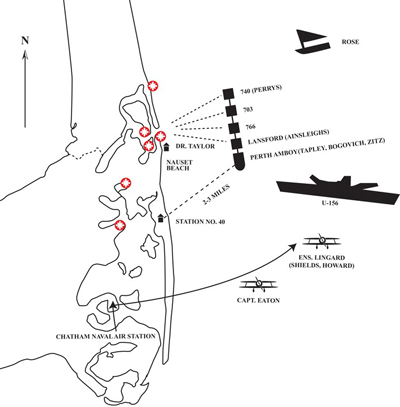
14119. Klim, Jake. Attack
on Orleans: The World War I Submarine Raid on Cape Cod. 2014. History
Press. 176p. Soft wraps. On the warm morning of July 21, 1918 – during the
last year of the First World War - a new prototype of German submarine surfaced
three miles off the coast of Cape Cod, Massachusetts and attacked an unarmed
towboat and her four barges. A handful of the shells fired by the U-boat’s two
deck guns struck Nauset Beach, giving the modest town of Orleans the distinction
of being the first, and only, spot in the United States to receive fire from the
enemy during the entire World War. Coming to Cape Cod’s defense that momentous
day were a hodgepodge of average American citizens – doctors, fishermen,
vacationing cottagers, young children - as well as two groups of first
responders that could not be more opposite; the waning United States Live-Saving
Services, now the fledgling U.S. Coast Guard, and the infant air arm of the
United States Navy. Lifesavers from the Orleans station launched a surfboat
under heavy enemy shellfire and rowed in the direction of the thirty-two sailors
trapped aboard the tug and barges. It was a situation Cape Cod’s surfmen never
imagined being in; they were far more accustomed to rescuing sailors from wooden
schooners caught in Nor’easters than from the jaws of an enemy submarine.
Meanwhile, in the sky above, rickety seaplanes from the local Naval Air Station
dive-bombed the enemy raider with payloads of TNT. It was the first time in
history that American aviators engaged an enemy vessel in the western Atlantic.
Although upwards of one thousand citizens watched the spectacle from shore, the
“Attack on Orleans” is a story very few Americans, outside the proud town of
Orleans, have ever heard. A most interesting account, well illustrated with
photos. (M). $19.99.
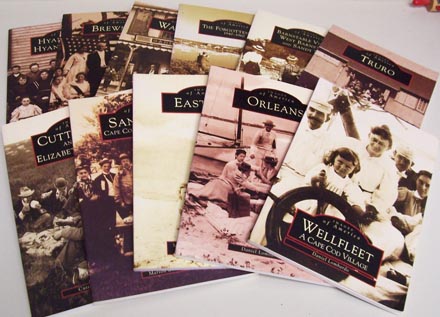
Cape
Cod Towns - Images of America Series. $21.99 each
Longley,
Jennifer. Hyannis And Hyannis Port
Lombardo,
Daniel. Orleans
Schofield,
Marilyn C and Roberta Cornish. Eastham
Vuilleumier,
Marion R. Sandwich, Cape Cod's Oldest Town
Cuttyhunk
Historical Society. Cuttyhunk And The Elizabeth Islands
Brennan,
Susan W and Diana Worthington. Truro
Edward
O…. Barnstable Village, West Barnstable and Sandy
Neck
Sicchio,
Mary. The Forgotten Cape 1940-1960
Pizzolato,
Susan and Lynda Ames Byrne. Wareham
Brewster
Historical Society. Brewster
Claflin,
James W. Lighthouses and Life Saving Along Cape Cod

13438. Simpson, Bland. Ghost
Ship of Diamond Shoals: The Mystery of the Carroll A. Deering. Univ.
of North Carolina Press. 2005. In the misty dawn of January 31, 1921, a Coast
Guardsman on watch at the Cape Hatteras Life-Saving Station sighted a mighty
five-masted schooner, all sails set, wrecked on the treacherous Diamond Shoals.
Rescuers rushed to the ship, but when they arrived they found the Carroll A.
Deering deserted, with no trace of the captain, Willis B. Wormell, or the crew.
When, several months later, a bottle was found on a nearby beach, purportedly
containing a note from a crew member who ascribed the schooner's fate to its
capture by pirates, a sensational panic in international shipping ensued. The
captain's daughter successfully lobbied for a federal investigation, but months
of inquiry failed to turn up either the missing crew or a reason for the ship's
demise. To this day, the fate of the Deering has remained one of the greatest
mysteries of maritime history. Bland Simpson assembles the known facts into a
compelling reconstruction of the Carol A. Deering's final voyage and its
baffling aftermath. Using contemporary sources including newspapers, FBI
reports, ship's logs, and personal and official correspondence, he weaves
together historical narrative with the voices of key participants in the drama.
Simpson's haunting chronicle keeps the story of the Deering alive, an apt
memorial to the ghost ship and its lost crew. (M). $19.95.
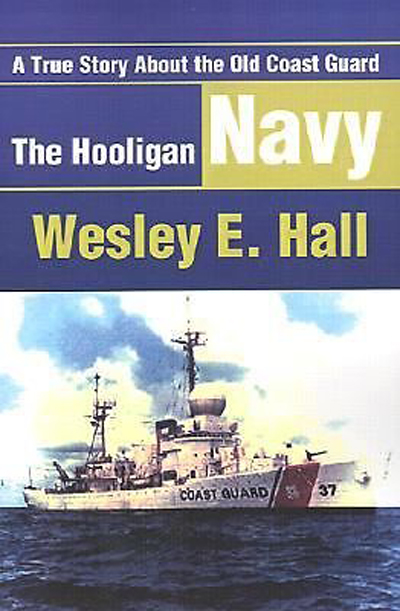
13453. Hall, Wesley. The
Hooligan Navy: A True Story About the Old Coast Guard. iUniverse.com,
Inc. 2001. Soft wraps. The Hooligan Navy is the third book of a trilogy based
upon the author's Navy (WWII) and Coast Guard (post-WWII) experiences. It is the
frank and quite often humorous confession of what life was like as a radio
operator in the late 1940s aboard a variety of U. S. Coast Guard cutters. Wesley
Hall, at the age of 22, joined the Coast Guard in Oklahoma City, near his home,
and was sent to Government Island, Alameda, California. From there he went to
the CGC Alert, based in Humboldt Bay, Eureka, California. His record was a clean
slate, and his future as a radio operator seemed bright. Fate, however,
intervened and, incredibly, during the next two years, when his hitch was up, he
served aboard five other cutters, including two Indian cutters assigned to Ocean
Station Fox (the Chautauqua and the Escanaba); the Taney, another and larger
cutter assigned to gather weather information at Station Fox; the Bramble, a
buoy tender, assigned to the northern California coast; and the Storis, an
icebreaker that took him from Baltimore, Maryland, to Juneau, Alaska. It is the
true story of a young man whose first black mark inexorably led to a second and
a third, despite his good intentions. This is a humorous book about this young
ex-Navy sailor who found out the hard way that the Coast Guard is a very small
outfit where the officers all knew each other and shared what they knew about
recalcitrant swabs. A must read if you are interested in early times in the military. (M). $46.

14149.
Smithweck, David. Mobile Point Lighthouse, Fort Morgan,
Alabama. Mobile. 2014. 70p. Soft wraps. Mobile Point is located on
the southeastern shore at the entrance into Mobile Bay from the Gulf of Mexico.
The hazards created by constantly shifting shoals as the tide waters flow into
the bay made aids to navigation a necessity for mariners. This is the story of
one of those aids--The 1872 Mobile Point Lighthouse. Filled with information,
profusely illustrated with photos, documents, plans and more. (M). $19.95. (x)

14178.
Oleszewski, Wes. The Best of Wes Oleszewski - Favorite
Great Lakes Shipwreck Stories. Avery. 2014. 202p. Soft wraps. The
author has researched and written hundreds of Great Lakes Maritime stories over
the years. He has personally chosen his "best" and is putting his
favorites in the book True, factual stories of some of the most devastating
Great Lakes shipwrecks ever documented. This book will take you through the
1800’s and the 1900’s, while in the shoes of the sailors, some lost, others
forgotten, still others remembered as heroes. Huge waves, frigid weather and
terrifying situations - relieve it all in this exciting book. A great read of
classic Wes stories. (M). $16.95. (x)

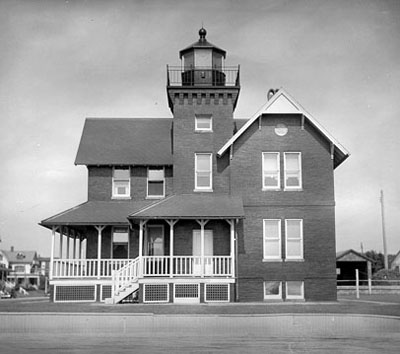
14117.
Dunn, Bill. Sea Girt Lighthouse – The Community
Beacon. Charleston. 2014. 192p. Soft wraps. Illustrated with over 100
photos. The Jersey Shore lighthouse that stands in Sea Girt has been a guiding
beacon for seafarers since the end of the nineteenth century. A revolutionary
lens, designed by Frenchman Augustin-Jean Fresnel, captured the flickering flame
of a burning wick and projected a unique flash that could be seen for fifteen
miles. The genius of Fresnel’s design, on full display at the lighthouse,
impresses as much now as it did in the days of sail. Many colorful characters
were put in command here, including a Civil War soldier, a pioneering woman, an
inventor and, for one day, the twenty-year-old daughter of a keeper. Sea Girt
Lighthouse played an important role in defending the coast during World War II,
when U.S. Coast Guard troops stood watch in the tower and patrolled the beaches.
After its decommissioning, the lighthouse served for over two decades as the
town library and recreation center, but by 1981, it was at risk of being closed
and sold. That’s when a group of community members—the Sea Girt Lighthouse
Citizens Committee—successfully fought to save and preserve the shore
landmark. Today, the lighthouse is the community beacon, alive with activity and
attracting visitors who flock from around the country and the world to
experience its history. Well illustrated, with great accounts of the keepers and
their lives here. (M). $21.99. (x)
 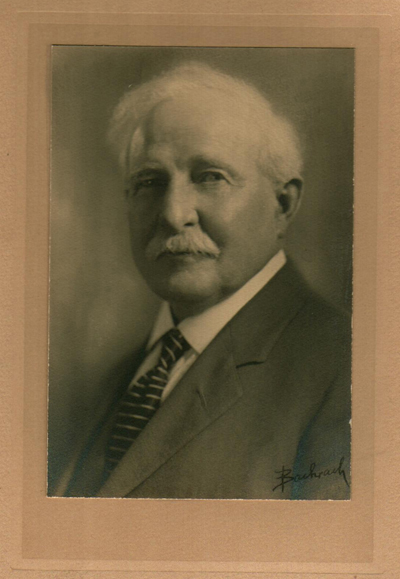
14157. Kotzian, John. Sky
Pilot of the Great Lakes. Avery. 2008. 224p. Soft wraps. "Sky
Pilot" was sailors' slang for a chaplain. This book tells the life story of
the Reverend William H. Law, a story that has never been told before. The
Reverend Law was in peril on the Great Lakes and was rescued by a U.S.
Life-Saving Service Station crew. As a result of that rescue, seeing their
heroic efforts first hand, Reverend Law dedicated the rest of his life to the
men and women stationed at Light stations and Life-Saving stations
throughout the United States. Whether it was bringing his "Floating
Library" to stations located on the Great Lakes, regular correspondence
with the crews of stations far too remote for a personal visit, or his
relentless pursuit of Congress to approve a bill to provide better pay and
pensions, Reverend Law became a fast friend to those serving in the Lighthouse
and Life-Saving services. To the men and women he served, Reverend Law was
lovingly known as "The Sky Pilot of the Great Lakes." A tale of
unconquerable optimism, the story of W. H. Law's life is as much the account of
the brave men and women of the Lighthouse Service and Life-Saving Service as it
is the saga of a long and rewarding life in the service of others. (M).
$17.95.

14120. Dresser, Thomas, Herb
Foster & Jay Schofield. Martha’s Vineyard in
World War II. Charleston. 2014. 192p. Soft wraps. Illustrated with
over 50 photos. The small, tight-knit island community of Martha’s Vineyard
was irrevocably transformed by World War II. From rationing and blackouts to a
military presence in Chilmark, the war was brought home to the residents of the
island. In the air, pilots flew training missions from the Martha’s Vineyard
Naval Auxiliary Air Facility. At sea, ferryboats served as hospital ships in the
D-Day invasion, while enemy submarines lurked offshore. Mock invasions were
undertaken by military forces from across Vineyard Sound, and remote sites were
used for training missions and bombing practice. Residents participated in the
war effort by buying war bonds, supporting USO activities and conducting air
raid drills. Remnants and reminiscences of this illustrious past can still be
found today. Join authors Thomas Dresser, Herb Foster and Jay Schofield as they
revive the story of this resilient island during World War II. (M). $19.99. (x)

1506. na. Cape
Lookout National Seashore. Cape Lookout Lighthouse Keeper’s Dwelling ( 1907)
Historic Structure Report. Cultural Resources Division, Southeast
Regional Office, National Park Service. 2004. 87p. Soft wraps. Historic
Structure Reports provide a valuable foundation for the rehabilitation,
restoration, stabilization or reconstruction of historic structures. Such a
report is particularly important for finding or fabricating significant missing
architectural details and other items that would have been found on such
structures, and for documenting the history and changes to such structures over
time. This allows one to recapture the appearance of a property at one
particular period of its history, removing later additions, or substantially
modifying existing historic fabric. In this case, the Cape Lookout, North
Carolina Lighthouse Keeper’s Dwelling (1907) was studied using evidence
present at the site, historical documents found at the National Archives,
Life-Saving Service records, logs, reports, letters from the keepers and more.
The Barden House, as the structure is now known, was the third Keeper's Dwelling
built at the lighthouse station and was occupied by the lighthouse keeper and
his family from the time it was completed in the fall of 1907 until the 1930s.
In 1957, the Coast Guard, which had taken over operation of the nation's
lighthouses in 1939, made the decision to surplus many of the buildings at the
lighthouse station and at the Coast Guard Station. In 1958, Dr. Graham Barden
acquired the Keeper's Dwelling and relocated it about 1.1 mile southwest of its
original site. The architect for the original design of the Barden House has not
been identified, but the plans were originally developed around 1886 in
Baltimore by the engineering department of the Lighthouse Board. Those plans
were modified around 1904 and used for construction of the house, which was
completed in October 1907. Included as part of that construction project was a
new summer kitchen and a brick and concrete cistern, both of which remain on
their original sites near the lighthouse. The authors are able to provide a
detailed assessment of how the structure would have looked during the period of
interest, and more. The report includes numerous period and current photos and
diagrams, architectural plans, and excerpts from Lighthouse Service and Coast
Guard books and documents, original specifications, and more for guidance. A
most important reference for anyone interested in what the building would have
contained and looked like. (M). $36. (x)

14101. Hartman USCG (Ret), Captain
Jeffrey. Guarding Alaska: A Memoir of Coast Guard
Missions on the Last Frontier. 2012. 230p. Soft wraps. Alaska
represents twenty percent of the land area, twenty percent of the oil
production, forty percent of the fresh water of the United States, but after
Wyoming, it's the least populated state. Despite that contradiction, the state
has an abundance of natural resources, history, and adventure-especially for the
members of the Coast Guard that oversee its massive coastline. Captain Jeffrey
Hartman served four tours of duty in Alaska with the Coast Guard. He outlines
the history of Alaska and its culture and describes his experiences overseeing a
number of rescue missions there. Hartman illustrates with personal experience
the challenges and dangers the Coast Guard faces in carrying out its missions
protecting the Alaska people, environment and maritime infrastructure. He flew
helicopters from Coast Guard icebreakers, on rescue and law enforcement missions
and managed the search and rescue program on Alaska's waters. Guarding Alaska
explains the many important functions that the Coast Guard serves and also
examines how it's changed in the wake of the September 11 terrorist attacks.
You'll feel like you're in the middle of the action as you gain a deeper
appreciation for the state and the people who protect it. Jeffrey Hartman
retired from active duty after thirty years with the Coast Guard as a rescue
helicopter pilot and emergency planner. In addition to his four Alaska tours he
commanded the Coast Guard Air Station in Borinquen Puerto Rico. A graduate of
the USCG Academy, he also has two masters degrees. Interesting account. (M).
$21.95. (x)
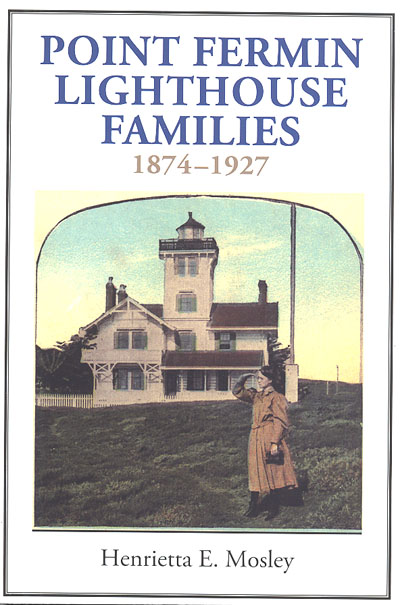 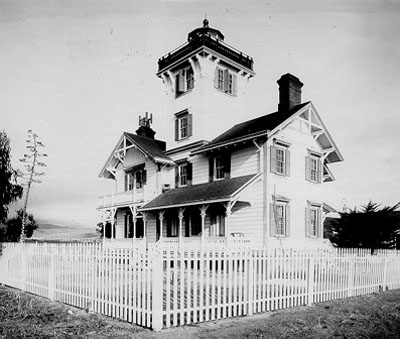
1482. Mosley, Henrietta E. Point
Fermin Lighthouse Families 1874-1927. Pacific Heritage Books. 2013. 132p. Soft
wraps. This is the first book devoted to the history of Los Angeles’ Point
Fermin Lighthouse, a 139- year old structure that still stands today. The
relates the story of families living in this big Victorian house with a light
tower, 100 feet above the ocean and their interactions with the world around
them. Based on correspondence, memoirs, newspaper accounts, census records,
station logs, pension files and other archival materials, the author relates how
the lives of the members of four lighthouse families were shaped by their
surroundings and the historical events of their times.
“Meticulously-researched…engaging and informative…sure to become a
standard reference for lighthouse scholars and fans alike." Includes rare
family and government images. Nicely done. (M). $19.95. (x)

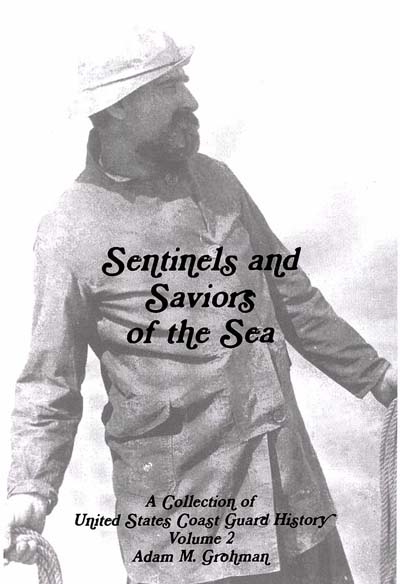
1483. Grohman, Adam M. Sentinels
and Saviors of the Sea – A Collection of United States Coast Guard History.
Volume 1. Adam Grohman. 2011. 289p. Soft wraps. Autographed by the
author. This well done volume provides thirty short histories of the United
States Coast Guard. Grohman’s work explores the determination, daring, and
dedication to duty of the men and women of the United States Coast Guard and its
predecessor services from the earliest days of the nation to present. “From
the wartime efforts of Coastguardsmen on the bloody beaches of the Pacific
Theatre of Operations and on the high seas battling German U-boats during the
Second World War to the heroic efforts of Revenue Cutter Service officers and
enlisted men … the service members have been vital to our nation’s military
efforts. Incidents recounted in this interesting volume include The February
Gale of 1880, U.S.S. Rockford, Siege of Cape Florida Light, Rescue Flotilla One,
Loss From Eatons Neck, Signalman First Class Douglas Munro, Manomet Station
Loss, Fort Mercer and Pendleton Rescues, Dots & Dashes No More, The Wreck of
the #3314, and much more. Other histories included in the book recount rescues
along the shores of souls stranded in the surf from a sinking vessel or on the
high seas from intrepid flight crews aboard fixed and rotary-wing aircraft.
These efforts, usually amidst inclement weather and harrowing conditions serve
to highlight the diligent efforts of Coast Guard members to those imperiled by
circumstance. In addition, this volume includes a host of archival photographs,
copious footnotes, and a detailed source listing for each chapter. Wonderful
reading, well done. (M). $16.95. (x)
1468. Grohman, Adam M. Sentinels
and Saviors of the Sea – A Collection of United States Coast Guard History.
Volume 2. Adam Grohman. 2014. 312p. Soft wraps. Autographed by the
author. Like the first, this volume provides thirty more short histories of
the United States Coast Guard. Grohman’s work explores the determination,
daring, and dedication to duty of the men and women of the United States Coast
Guard and its predecessor services from the earliest days of the nation to
present. “From the wartime efforts of Coastguardsmen on the bloody beaches of
the Pacific Theatre of Operations and on the high seas battling German U-boats
during the Second World War to the heroic efforts of Revenue Cutter Service
officers and enlisted men in hand-to-hand combat with British forces aboard the
bloodied decks of the Revenue Cutter Surveyor in 1813, the service members have
been vital to our nation’s military efforts. Other histories included in the
book recount rescues along the shores of souls stranded in the surf from a
sinking vessel or on the high seas from intrepid flight crews aboard fixed and
rotary-wing aircraft. These efforts, usually amidst inclement weather and
harrowing conditions serve to highlight the diligent efforts of Coast Guard
members to those imperiled by circumstance.” In addition, this volume includes
a host of archival photographs, copious footnotes, and a detailed source listing
for each chapter. Wonderful reading, well done. (M). $16.95.

1493. Chubbs, Harold and Wade Kearley.
Facing the Sea: Lightkeepers and Their Families.
Flanker Press. 2013. 132p. Hard cover. DJ. In Facing the Sea, authors Harold
Chubbs and Wade Kearley have captured an important era in the maritime history
of Newfoundland and Labrador. These tales of rescue and tragedy, of love lost
and redeemed, describe first-hand what life was like for lightkeepers and their
families in twenty-five light stations along the exposed and often inhospitable
coast of Newfoundland and Labrador. Most of these stories are told here for the
first time in print, and each story is rich with new details and insights from
the perspective of these remarkable men and women. Well illustrated with
photographs. (M). $38. (x)
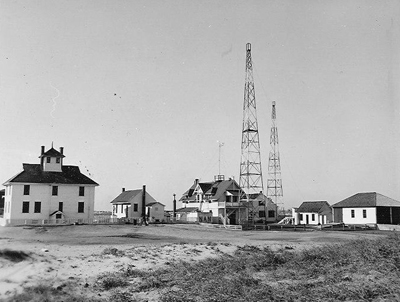
1445. Cape
Lookout National Seashore, Cape Lookout Coast Guard Station Boat House: Historic
Structure Report. 2004. 70p. Soft wraps. Cape Lookout, NC. Cultural
Resources, Southeast Region, U.S. Dept. of Interior, National Park Service.
Historic Structure Reports provide a valuable foundation for the rehabilitation,
restoration, stabilization or reconstruction of historic structures. Such a
report is particularly important for finding or fabricating significant missing
architectural details and other items that would have been found on such
structures, and for documenting the history and changes to such structures over
time. This allows one to recapture the appearance of a property at one
particular period of its history, removing later additions, or substantially
modifying existing historic fabric. In this case, the Cape Lookout, North
Carolina Coast Guard Station 1924 Boat-House was studied using evidence present
at the site, historical documents found at the National Archives, Life-Saving
Service records, logs, reports, letters from the keepers and more. The
Boat-House is a one-story, wood framed, hipped-roofed structure built in 1924
for storage and maintenance of life-boats. Altered after it was relocated in
1958, it still retains most of its historic features and original materials.
Using these and other sources, the authors are able to provide a detailed
assessment of how the structure would have looked during the period of interest,
and more. The report includes numerous period and current photos and diagrams,
architectural plans, and excerpts from Life-Saving Service and Coast Guard books
and documents, original specifications, and more for guidance. A most important
reference for anyone interested in what the building would have contained and
looked like. (M). $44.(x)

13434. McDougal, Steph. Lighthouses
of Texas. Arcadia. 2014. 128p. Soft wraps. 180 vintage photographs.
Not long after winning their independence from Mexico in 1836, Texans began
clamoring for lighthouses. Hundreds of miles of barrier islands, shifting
sandbars, and shallow bays made the Texas coast treacherous at a time when few
overland routes provided access to the new republic. Beginning in 1852,
twenty-eight lighthouses were built along the Texas coastline, on land and over
water. Lighthouse service was often a family affair, with husbands, wives, and
children working together as keepers and assistants. For nearly 70 years,
construction continued as coastal erosion, hurricanes, and wars regularly
damaged or destroyed those lighthouses already built. These “sentinels of the
sea” lessened but did not eliminate the chance of shipwreck, so lifesaving
stations, manned by able seamen with unsinkable surfboats, were established as
well. As Texas’s lighthouses were gradually automated throughout the 20th
century, many were sold to private owners or abandoned. Today, several have been
restored, and two—at Aransas Pass and Port Isabel—still function as aids to
navigation. This interesting volume draws images from public and private
collections, most never before published, to tell the story of the lighthouses
of Texas. Superb photographs of the station, keepers, equipment and more,
well worth it. (M). $21.99.

13408. Henry, Ellen J. The
Lighthouse Service and the Great War. Ponce Inlet. 2013. 72p. Soft
wraps. The Great War at the beginning of the twentieth century affected every
aspect of American life including the personnel of the Lighthouse Service. It
was even proposed that the Lighthouse Service become a part of the U.S. Navy
during the Great War. This would become a reality and the operation of the
Lighthouse Service and the lives of the personnel were greatly affected. But
many questions would arise. What orders would lighthouse personnel obey? What
would they be paid ? Could the keeper’s families remain at the light stations
as they had for years ? How would the operation of the lighthouses change in
this new age of submarine warfare? What additional duties would be required of
lighthouse personnel ? These and many other questions are discussed in some
detail in the author’s most interesting and readable account. Author Ellen
Henryis the Curator at the Ponce de Leon Inlet Light Station Museum in Florida
and is an expert on the subject of the U.S. Lighthouse Service. Her well
researched account is filled with little known information on the Lighthouse
Service during this period and will be a valued addition to your library. (M).
$9.95. (x)

13424. Barbo, Theresa Mitchell,
Captain W. Russell Webster (ret) and Julia Marshall. The
Daring Coast Guard Rescue of the Pendleton Crew. Charleston. 2013.
124p. Stiff wraps. Jack Nickerson and his faithful lab, Sinbad, wake early one
snowy Cape Cod morning, ready for winter fun. Meanwhile, miles away in the
ocean, the crew of a cargo tanker ship called the Pendleton is in serious
trouble. The waves and wind of a raging nor’easter rip the tanker in two,
leaving the people to cling for their lives in the wicked, cold storm. There’s
no time to waste—the Coast Guard, including Jack’s friend Bernie Webber,
leave Chatham Harbor in search of the Pendleton crew. They don’t yet know that
Jack and Sinbad have snuck aboard the rescue boat as stowaways. Join the young
duo in the front-row seat for the greatest small-boat rescue in American
history. Well done, with wonderful illustrations that add flavor to the story.
The Daring Coast Guard Rescue of the Pendleton has well-written and well-paced
action that keeps youth interested, wanting to read page after page.
Historically, the Coast Guard action is correct. Jack’s story is fiction, used
to bring children into the story. Sinbad, the black lab always by Jack’s side,
was a real dog that hung around the Coast Guard Station Chatham and was loved by
the crews. (M). $14.99. (x)

13272. Whatley, Merita S. Point
Arena Lighthouse. Arcadia. 2013. 128p. Soft wraps. 180 vintage
photographs. The low rumbles of the fog signal and flashing beam of light from
the powerful lens have guided mariners away from the perilous waters surrounding
Point Arena Lighthouse since 1870. After the great earthquake in 1906 and the
rebuilding of the tower in 1908, Point Arena’s navigational aids continued to
warn ships away from the peninsula off Northern California’s Pacific
coastline. The original tower was replaced with a concrete cylindrical tower
that rises 115 feet from the headland. This became the first lighthouse tower in
the United States constructed with materials found to be superior to the stone
and masonry lighthouse structures of the past. The new tower, crowned with a
nearly 13,000-pound first-order Fresnel lens, sent a beam of light 20 miles out
to sea and continued alerting ships of the dangers just offshore. This book
tells the story of Point Arena Lighthouse, as well as the people and events that
shaped its history, highlighting the heroism and dedication of the lighthouse
keepers and their familys who served. This interesting volume draws images from
public and private collections, most never before published. Superb photographs
of the station, keepers, equipment and more, well worth it. (M). $21.99.
(x)
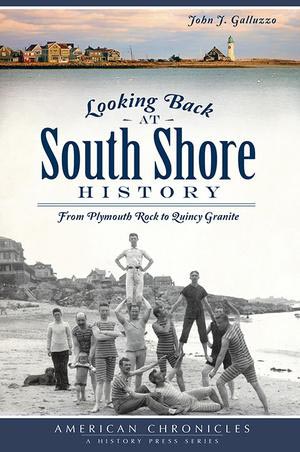 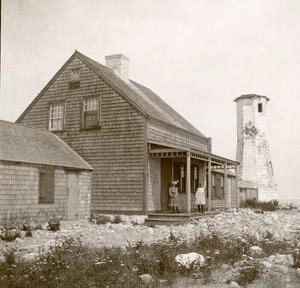
13342. Galluzzo, John. Looking
Back at South Shore History: From Plymouth Rock to Quincy Granite.
History Press. 2013. 176p. Soft wraps. From Plymouth Rock to Quincy granite, the
South Shore of Boston has been a place of revolution, relaxation and revelation.
Artists have gained inspiration from the meeting of sea and shore, enemy navies
have targeted its strategic ports and, in better days, merrymakers have sought
its warming sun, cooling breezes, amusement parks and historic and natural
landmarks. The Toll House Cookie, the song "When the Red, Red Robin (Comes
Bob, Bob, Bobbin' Along)" and the U.S. Navy's rallying cry "Don't give
up the ship!" all were South Shore born. John Galluzzo, author of The North
River: Scenic Waterway of the South Shore and When Hull Freezes Over, gathers
the best of his "Look Back" column in this compilation of historic
vignettes from South Shore Living magazine. Includes chapter on The First
Keepers of Scituate Light and more. (M). $19.99. (x)
An
Amazing Book:

13205.
Levitt, Theresa. A Short Bright Flash - Augustin
Fresnel and the Birth of the Modern Lighthouse. W.W. Norton. 2013.
288p. With 60 illustrations and 6 maps. Augustin Fresnel (1788–1827) shocked
the scientific elite with his unique understanding of the physics of light. The
lens he invented was a brilliant feat of engineering that made lighthouses blaze
many times brighter, farther, and more efficiently. Battling the establishment,
his own poor health, and the limited technology of the time, Fresnel was able to
achieve his goal of illuminating the entire French coast. At first, the British
sought to outdo the new Fresnel-equipped lighthouses as a matter of national
pride. Americans, too, resisted abandoning their primitive lamps, but the
superiority of the Fresnel lens could not be denied for long. Soon, from Dunkirk
to Saigon, shores were brightened with it. The Fresnel legacy played an
important role in geopolitical events, including the American Civil War. No
sooner were Fresnel lenses finally installed along U.S. shores than they were
drafted: the Union blockaded the Confederate coast; the Confederacy set about
thwarting it by dismantling and hiding or destroying the powerful new lights.
Levitt’s scientific and historical account, rich in anecdote and personality,
brings to life the fascinating untold story of Augustin Fresnel and his powerful
invention. Quality and contents make this an extraordinary read and a MUST for
any lighthouse organization. (M). $25.95. (x)

13244. St. Germain, Paul. Lighthouses
and Lifesaving Stations on Cape Ann. Arcadia. 2013. 128p. Soft wraps.
180 vintage photographs. The maritime history of Cape Ann, on the northern coast
of Massachusetts, is filled with stories of heroism, adventure, and human
endeavor. The lighthouses and life-saving stations surrounding Cape Ann since
the late 18th century have served to protect and safeguard the area’s mariners
and major industries. Fishing, shipbuilding, and granite quarrying businesses
all flourished under their watchful eyes. They provided artists with spectacular
subject matter and attracted tourists from around the world to visit them. This
book highlights the heroism and dedication of the lighthouse keepers and
life-saving surfmen who served. This interesting volume draws images from public
and private collections, most never before published. Superb photographs of the
station, keepers, equipment and more, well worth it. (M). $21.99. (x)

13183. D’Entremont, Jeremy. Everyday
Heroes: The True Story of a Lighthouse Family. Coastlore Media. 2013.
252p. Soft wraps. Wonderfully illustrated with 26 black and white photos and
maps. Lighthouses are an essential part of our American culture. They stand as
symbols of altruism, strength, hope, faith and guidance. And today, in the age
of automation, they also stand as memorials to the lighthouse keepers and their
families who once devoted themselves to “keeping a good light” in service to
mariners. Traditional lighthouse keeping has passed into history with
automation, but there are still those who recall lighthouse life with nostalgia.
Seamond Ponsart Roberts, daughter of a lighthouse keeper, is one of those
people. Seamond was born while her parents lived at the rugged Dumpling Rock
Light Station off Dartmouth, Massachusetts. She went on to spend the rest of her
youth at two other southeastern Massachusetts light stations: Cuttyhunk Island
and West Chop on Martha’s Vineyard. During her lighthouse years, Seamond
experienced good times and bad, tragedy and heroism. She is a born storyteller
who has always shared her memories with family and friends, and her unique story
is now told in the new book - Everyday Heroes: The True Story of a Lighthouse
Family. “I am, and always will be, a lighthouse keeper's daughter. I had the
good fortune to be born to a different kind of childhood. I didn't recognize
this fact back when I was small. I thought that everybody lived like we did on
our little island of Cuttyhunk, Massachusetts, which in itself was a life
apart,” she writes. This is the true story of a family's life at lighthouses
on the edge of civilization. It's a story of adventure, danger, devotion to
duty, and love. Seamond Ponsart Roberts shares her memories and emotions with
good humor, a sharp eye for detail, and above all an appreciation for a way of
life that has passed into history. (M). $16.99. (x)

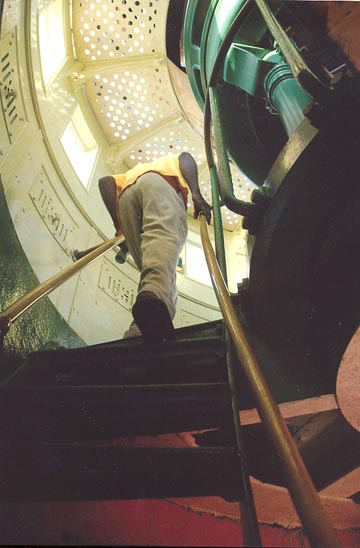
13213.
Potts, Annie. Last Lights - The Hand-Wound Lighthouses
of the Bahama Islands. Fish House Press, 2011. 136p. Soft wraps.
Between 1836 and 1887, the British Imperial Lighthouse Service commissioned
eleven manned light stations to be built as remote outposts in The Bahama
Islands. Designed during the golden age of lighthouse construction, these works
of art in architecture still stand, continuing to warn vessels off the shallow
and dangerous waters of the Bahama banks. Of the original eleven manned lights,
only three of these remain hand operated today. They are among the last hand
wound, kerosene lit lighthouses in the world. Through photographs of keepers at
work and short histories of all the original light stations, this book inspires
the continued conservation of these last lights. Through photographs and text,
the author brings us into the lives of the builders, suppliers, and the
lighthouse keepers of these little known lighthouses. A stunning book,
wonderfully illustrated, beautifully composed. (M). $29.95. (x)
 
13189. Richmond, Arthur P. Massachusetts
Lighthouses: Past & Present. Schiffer. 2013. 160p. DJ. A
must-have book for the lighthouse enthusiast, maritime buff, and anyone who is
interested in Massachusetts history, Massachusetts Lighthouses Past and Present
describes the more than sixty lighthouse stations that have been found along the
coast from Fall River in the south to Salisbury in the north, near the New
Hampshire border. The lighthouse station locations are identified using
navigational charts and their characteristics, including date established, tower
structure, optics, fog signals, and many more significant topics are presented
in a straightforward table format. A dozen or so lighthouses that no longer
exist, and probably are not as well known, are also discussed. More than four
hundred images, some more than 130 years old, show the original towers and
stations and are accompanied by present-day photographs of these beacons.
Numerous images show the insides of towers and lantern rooms not only in those
open to the public for tours, but also in restricted or rarely visited
lighthouses. (M). Published at $34.99. Our Price $31.50. (x)

13190. Oleszewski, Wes. Shipwrecks!!
Factual Accounts of Obscure Great Lakes Shipwrecks. Avery. 2013.
176p. Soft wraps. True, factual stories of some of the most obscure Great Lakes
shipwrecks ever documented. This book will take you from the 1820’s to the
1980’s, while in the shoes of the sailors, some lost, others forgotten, still
others remembered as heroes. Huge waves, frigid weather and terrifying
situations - relieve it all in this exciting book. (M). $17.95.


13162. de Quesada, Alejandro. U.S.
Coast Guard in World War II. 2010. Osprey. 64p. Soft wraps.
Illustrated with period photos and artwork by Stephen Walsh. Noted military
author Alex de Quesada reveals much of the history of the U.S. Coast Guard
throughout World War II. In particular, he draws attention to the little-known
story of how the U.S. Coast Guard operated a number of the landing craft
throughout D-Day in 1944 as well as providing crucial anti-U-boat patrols
throughout the war years. A number of Coast Guard servicemen were lost in these
two campaigns, and their undeniable contribution to the war effort deserves
greater recognition. The Coast Guard also provided aviators and gunners to the
Merchant Marine and manned Port Security Services. These roles are all fully
explained and illustrated with rare photographs and specially commissioned
artwork. Chapters include: Introduction, Pre-war Coast Guard, The Coast Guard
Auxiliary, The Coast Guard at War, Home Front, The Aleutian Campaign, The Battle
of the Atlantic, North Africa and Italy, Normandy invasion, Pacific Theatre:
From Pearl Harbor to the Philippines, Victory, Uniforms, Bibliography. Quite
interesting. (M). $19.95. (x)
13177. de Quesada, Alejandro. The
U.S. Home Front 1941-45. 2008. Osprey. 64p. Soft wraps. The outbreak
of World War II in Europe in 1939 led to cautious attempts to raise volunteer
organizations among American men and women, to back the armed forces in the
event of the USA becoming directly involved in the conflict. The attack on Pearl
Harbor caused a huge surge of patriotic response, and voluntary enlistment in a
wide range of armed forces auxiliary and civilian support services swelled
vastly. Looking firstly at the background and general character of wartime life
in the United States, this book covers a number of these services, providing an
interesting comparison with the conditions on the British Home Front and the
experiences of other countries caught up in the war, examining organizations
from the Red Cross to the Coast Guard and for the first time, containing
full-color reconstructions of over a dozen uniformed services. Chapters include:
Enemy And Homegrown Facism, Home Defense & Premilitary Training, Patriotic
Service Organizations, Humanitarian Organizations, Maritime Services including
Army Transport Service – Coast And Geodetic Survey – Merchant Marine – Us
Coastguard Auxiliary,·Aeronautical Services including Air Transport Command –
British Flying Training Schools – Civil Air Patrol – Relief Wings Inc –
Women’s Auxiliary Ferrying Squadron – Women’s Airforce Service Pilots, The
Workforce including Civilian Conservation Corps – “Rosie The Riveter”:
Women Ordnance Workers – Women’s Land Army, Children At War, Select
Bibliography, and more. Quite interesting. (M). $19.95.

13156. O'Connell, Wil and Pat. Lighthouses
of Eastern Michigan. Arcadia. 2013. 128p. Soft wraps. 200 vintage
photographs. From the Straits of Mackinac to the Detroit River, Lighthouses of
Eastern Michigan reveals intriguing stories of lighthouses and the people who
depended on them. Readers will enjoy discovering what happened when a large ship
fell 20 feet over one of the Soo Locks and the captain commented, "Good-bye
Old World," as well as of a persistent ghost that caused havoc with the
Coast Guard. Which lighthouse was a construction miracle in 1874? And whatever
happened to the lost lighthouses of the Detroit River? A collection of the
mysteries, storms, fires, and heroics surrounding the lighthouses of eastern
Michigan are waiting within. Authors Wil and Pat O'Connell have spent the last
20 years photographing and writing about the lighthouses of the Great Lakes.
Their interesting volume draws images from public and private collections, most
never before published. Superb photographs of the stations, the men, equipment
and more, well worth it for the photos alone. (M). $21.99.
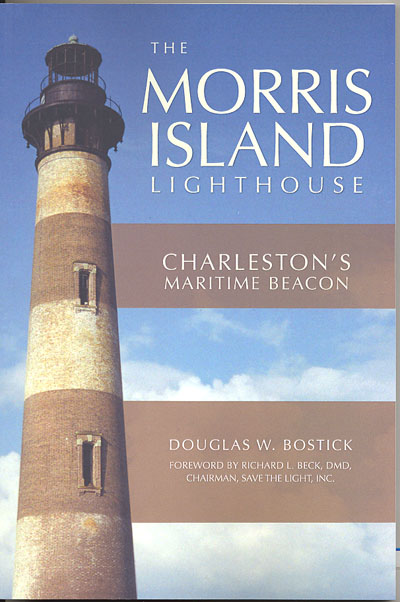
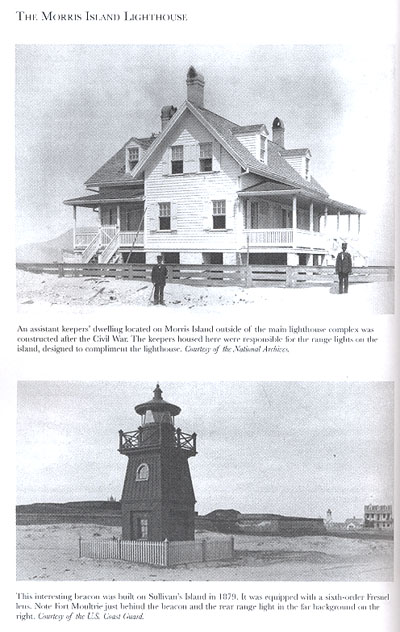
28262. Bostick, Douglas W. The
Morris Island Lighthouse: Charleston's Maritime Beacon. History
Press. 2013. 2nd. 128p. Douglas Bostick, historian and former director of Save
the Light, Inc., recounts the stories of the many light keepers and their
families who braved meager provisions, low pay and grueling conditions living on
a small island at the entrance to Charleston Harbor. Filled with over 55 black
& white photographs. Well done, most interesting lighthouse history. (M).
$19.99. (x)
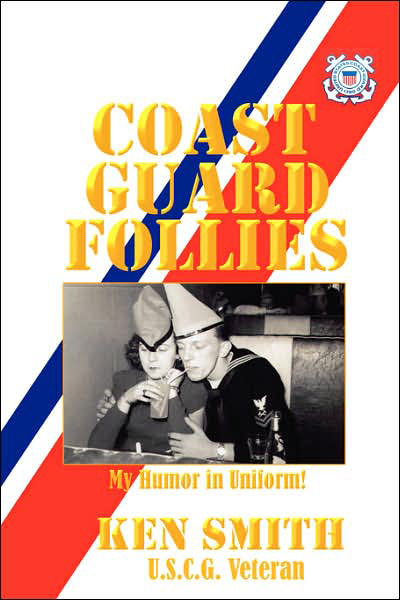
13101. Smith, Ken. Coast
Guard Follies – My Humor in Uniform. Yeoman House. 2007. 96p. Soft
wraps. Ken Smith was just a boy of 18 in 1951 when the government asked him to
serve. Despite his flat feet, he enlisted in the U.S. Coast Guard and began a
three-year adventure that took him from the frigid North Atlantic to a tiny
atoll in the South Pacific called Ulithi. This book is Smith's fond recollection
of his time in the service, when the only dangers came from the push-push girls,
the bad decisions of Lt. Lard-Ass and an ungrounded gooseneck lamp. This is a
hilarious and heartwarming story that will appeal to all old Coasties and
landlubbers alike. Great reading – takes one back for sure. (M). $16.95. (x)
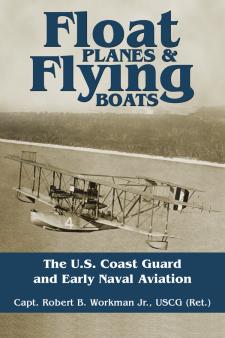
1343.
Workman, Capt. Robert B. Jr. USCG (Ret.), Float Planes
And Flying Boats – The U.S. Coast Guard and Early Naval Aviation. Naval
Institute Press. 2012. 322p. DJ. With nearly 300 vintage photographs and over
300 pages of text, U.S. Coast Guard aviator Capt. Robert Workman presents a
complete picture of naval aviation's rapid development between 1911 and 1938.
Frustrated by the lack of information about the Coast Guard's aviation heritage,
the author undertook research of his own. The result is this balanced look at
early naval aviation that, for the first time, gives full credit to the
important contributions made by Coast Guardsmen. He shows that it was thanks to
their creativity, skill, and determination, along with efforts by the other sea
services, that such great strides were possible. Several chapters are devoted to
the inventions of the float plane and flying boat and why the flying boat was
considered more seaworthy and reliable. Workman has done a magnificent job
chronicling the lives of pioneers and visionaries whose accomplishments led to
Coast Guard aviation as we know it today. Well Done! (M). $41.95.

1369.
Kroll, C. Douglas. A Coast Guardsman's History of the
U.S. Coast Guard. Naval Institute Press. 2010. 209p. DJ. The author
has melded story-telling and the evolution of the Coast Guard in a unique
fashion. More a book about Coast Guard heritage than an academic history, this
book focuses on a variety of relatively unknown Coast Guardsmen who personify
the service’s core values. The author highlights contributions of a variety of
individuals, from seamen to admirals on active duty, as well as Reserves,
Auxiliary, and civilian members of Team Coast Guard. These heroes, representing
a great diversity in age, sex, race, and ethnicity, set an example worthy of
emulation and serve as role models for today s Coast Guard men and women. (M).
$34.95.
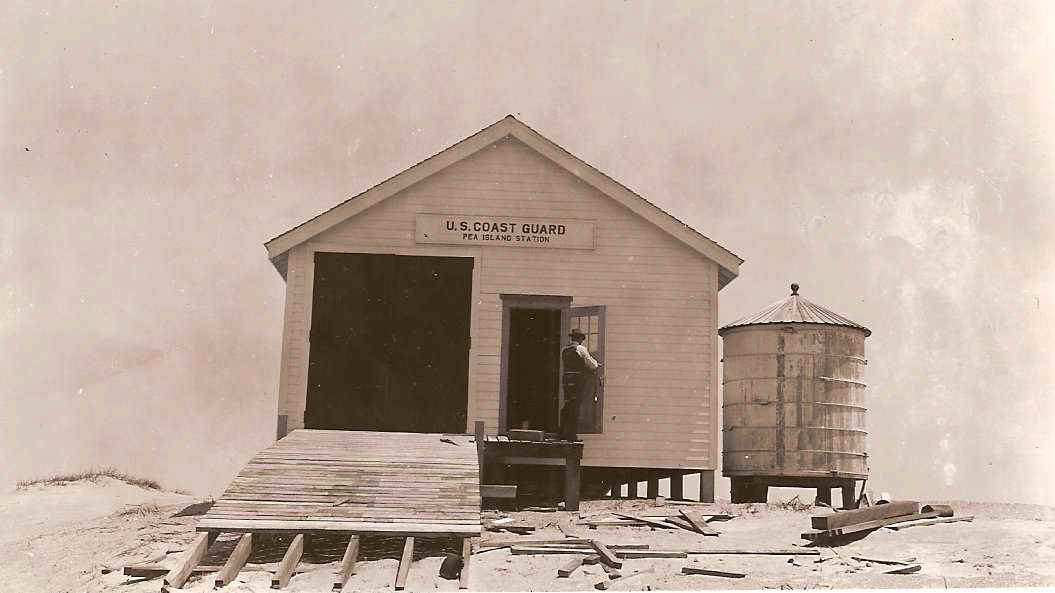
11501. Stover, Douglas. Pea
Island Life-Saving Station, Rodanthe, North Carolina, Coast Guard Station #177 :
Historic Resource Study. National Park Service. 2008. 83p. Provides a
valuable foundation for the restoration of historic structures and insights into
the lives of the crews. Report is particularly important in documenting the
historic significance of the property and the accomplishments of the Life-Saving
Service and Coast Guard crews here. In this case, the Pea Island, North Carolina
Life-Saving Station was studied using evidence present at the site, historical
documents found at the National Archives, Life-Saving Service records, logs,
reports, letters from the keepers and more. Using these and other sources, the
author is able to provide a detailed assessment of how the structure would have
looked during the period of interest, and more. The report includes numerous
period and current photos and diagrams, architectural plans, and excerpts from
Life-Saving Service books and documents, original specifications, and more for
guidance. A most important reference for anyone interested in what the station
building(s) would have contained and looked like as well as an in depth look at
the construction and work of the Life-Saving Service there. (no longer in print)
PDF File on Disc. (M) $29.95. (x)
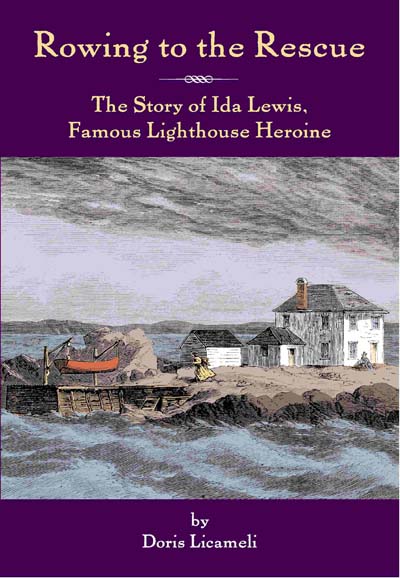
1376. Licameli, Doris. Rowing
To The Rescue: The Story of Ida Lewis, Famous Lighthouse Heroine. 2011.
80p. soft wraps. With mixed emotions, fifteen-year-old Ida Lewis said good-bye
to the little house on Spring Street on a sunny June day in 1857. Though her new
home would still be in Newport, Rhode Island, it sat on a tiny outcropping of
rocks out in the harbor, completely surrounded by water. Ida’s father, Captain
Hosea Lewis, was the keeper of the Lime Rock Light. The new lighthouse was big
enough for the entire family of six. Then just four months later, tragedy
struck. Captain Lewis was no longer able to man the lighthouse. Responsibility
for keeping the lifesaving beacon aglow soon fell on Ida’s young shoulders. It
was an awesome task, but she was determined to do a good job. She knew sailors
would be depending on her for their safety. As time went on, plenty more people
would have petite, amazing Ida Lewis to thank for their live. Masterfully
written! Ms. Licameli tells the story of a heroine that our girls are sure to
idolize! Though expertly written for preteens and young teens, it is a great
read aloud parents will enjoy, too! (M). $21.95.
Want the perfect book
for your children at Christmas ?
Winner
of the Time of Wonder Award 2012!

12419. Buzzeo, Toni. Lighthouse
Christmas. Penguin. 2011. 32p. DJ. Beautifully illustrated. A lovely
child’s tale about a family Christmas at this Maine offshore lighthouse –
would Santa even know how to find them ? Frances is determined to make Christmas
jolly for her younger brother, even if it means joining family on the mainland
and leaving Papa behind on their isolated lighthouse island. After all, would
Santa even know how to find them in this faraway spot? But when Christmas Eve is
ushered in on a wild storm and Papa risks his life to rescue a drowning man, the
children realize that the most important thing about the holiday is being
together. As in all great Christmas stories, a happy ending is in store, and
Santa finds them after all. Cozy and nostalgic, this story was inspired by the
Flying Santa program, a New England tradition since 1929. It's the perfect book
for a family to read together in front of the fire on Christmas morning. There's
a charmingly nostalgic feel both to the story and to the illustrations, which
convey a sense of time and place and are very appealing - a gentle but dramatic
story of an earlier time, when just one care package could make a happy
Christmas for an entire family. Reading this book with your young ones is sure
to become a family tradition. (M). $16.99.

12289. Murray,
Steve. Guardians of
the Hereford Inlet. 2010. Rio Grande, NJ. 201p. Soft wraps. A wonderful
detailed and interesting work documenting the history of the Hereford Inlet, and
includes a history of the Hereford Inlet Light Station, the Anglesea
Life-Saving Station, and the U.S. Coast Guard Lifeboat Station No. 133.
Filled with period photos, maps, plans as well as a chapter on each light
keeper, rescues, the life of a keeper, the work of the Life-Saving Service and
Coast Guard in the area, restoring the structures and much more. A most
interesting work that is difficult to find. (M). $38.
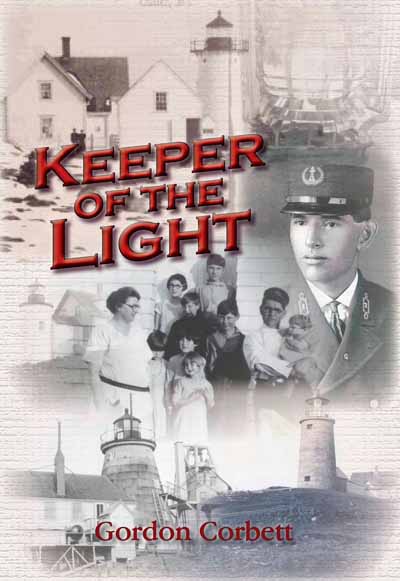
12484.
Corbett, Gordon. Keeper of the Light. FogHorn
Publishing. 2012. 72p. Soft wraps. Riveting new book from by Gordon Corbett
details his grandfather Willie W. Corbett's life as a lighthouse keeper at four
Maine lighthouses during the era of the United States Lighthouse Service and the
transitional period to the Coast Guard. The book details his early life, through
his retirement years, with remarkable stories of a way of life that will never
again be repeated. The book includes a large selection of historic family and
lighthouse photos and a bonus section on the history of the lighthouse where
Corbett was the last official Lighthouse Service keeper on the eastern most
island lighthouse in the United States. (M). $9.95.

12492. Epstein, Becky Sue and Ed
Jackson. American Lighthouse Cookbook.
Sourcebooks. 2012. 295p. Hardcover. This mouth-watering book takes readers on a
culinary journey across America to visit 47 lighthouses, read dozens of short
stories about them, both heroic and tragic, and sample more than 300
mouthwatering recipes from eight coastal regions of the United States. The
American Lighthouse Cookbook celebrates the local cuisines that have long been
the staple of lighthouse keepers. Arranged geographically in eight regions of
America, the lighthouses were chosen for their interesting backgrounds and
stories. Following the story of each lighthouse is a menu for a modern-day
lighthouse meal. Traveling through these pages, you will discover a new way to
experience lighthouses and coastal food you won't soon forget. (M). $26.99.

12466. Cook, David E. Hudson
River Light-Keepers – A Research Tool. Mayfield. 2012. 48p. Spiral
bound. A biographical anthology of at over 100 men and women who maintained the
light stations along the Hudson River before they were all automated. This
detailed work is filled with lots of great historical and family history of
lighthouse keeping along New York’s Hudson River shorelines. Includes a
listing both chronologically and an alphabetical of the lighthouse keepers. In
addition to listings of the many keepers over the years, includes a biography of
each, stations served and great information about the station and his activities
and occurrences there. Illustrated with a few photos when available. Packed full
of information. (M). $24.95.
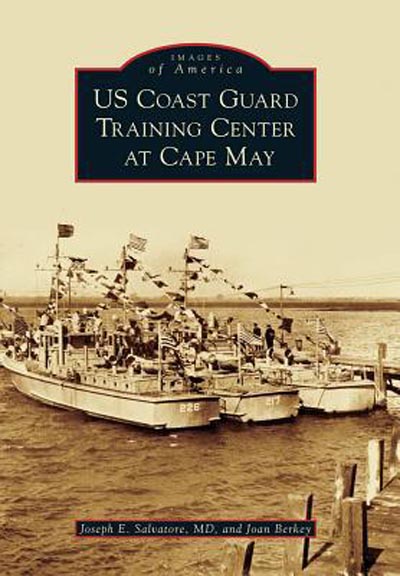
12480. Salvadore, Joseph E. and Joan
Berkey. U.S. Coast Guard Training Center at Cape May.
Arcadia. 2012. 128p. Soft wraps. 180 vintage photographs. Commissioned as Navy
Section Base 9 in 1917, the U.S. Coast Guard Training Center at Cape May stands
on the site of a former amusement park that bordered the Atlantic Ocean a few
miles east of Cape May in southern New Jersey. Dirigibles, submarines, and
minesweepers were based here during World War I. Because of its proximity to the
ocean and Delaware Bay, the base was used by Coast Guard patrol boats and
cutters to chase rumrunners during Prohibition in the 1920s. An airfield was
established adjacent to the base in 1926, and in 1940, both combined to become
Naval Air Station Cape May. The station protected the coast line from German
U-boats during World War II. The Coast Guard took over the facility in 1946, and
in 1948, the base became the only recruit training center in the country, today
graduating more than 4,000 recruits per year. Through a wealth of vintage
photographs, many previously unpublished, and descriptive text, the authors
reveal the work and history of this important Coast Guard base. Superb
photographs, well worth it for the photos alone. (M). $21.99.
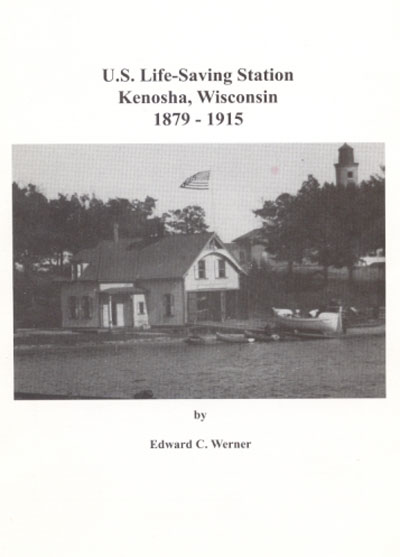
12427.
Werner, Edward C. U.S. Life-Saving Station, Kenosha,
Wisconsin 1879-1915. 87 p. Soft wraps. Interesting detailed work by
Mr. Werner (USCGR Ret.) traces the history and operations of the U.S. Life
Saving Service at Kenosha, Wisconsin from the station’s commissioning in 1879
until the change-over to the Coast Guard in 1915. A great deal of information is
presented regarding the crews, their life at the station and the wrecks and
services rendered. Also the station, changes over the years, equipment and more
are covered. Well illustrated with vintage photographs. Nicely done, well worth
it. (M). $17.95.

12366.
Truman, Stephen, Grace & Joel. STORMS
AND SAND - A Story of Shipwrecks and the Big Sable Point Coast Guard Station. Pine
Woods Press. 2012. 208p. HC. Illustrated with 69 photos and illustrations. Great
Lakes maritime history encompasses epic stories of heroic rescues, tragic
losses, and changing times. Storms and Sand is a glimpse into the world of the
brave men of the U.S. Life-Saving Service/ U.S. Coast Guard Station at Big Sable
Point, Michigan. The station was located on land that is now part of Ludington
State Park. The book tells the history of the station; including the sacrifices
by the life-savers and Coast Guardsmen, and their courageous struggles in
rescuing Lake Michigan shipwreck victims. Storms and Sand also chronicles
lesser-known events in the lives of the men, their families, and the Big Sable
Point lighthouse keepers. Great reading about an interesting area. (M). $29.95.

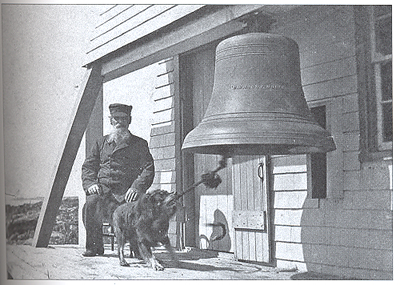
12211. Wood, Allan. New
England Lighthouses: Famous Shipwrecks, Rescues, & Other Tales.
Schiffer. 2012. 160p. Soft wraps. Immerse yourself in New England s maritime
history through tales of historic shipwrecks and heroic rescues. From
Connecticut to Maine, meet the special individuals who helped those in peril.
Learn about the disasters that led to the pioneering of travel safety. As told
by the people who witnessed these incredible and often life-changing events,
stories tell also of the Flying Santa, miracle baby rescues, and paranormal
activity. Amusing accounts from one of the last surviving lighthouse keepers
also provide an indelible look at life in and around the lighthouses. With an
appendix of lighthouses that can be viewed by boat and a glossary of Mariner
terms, this is a great resource for historians, maritime enthusiasts, and a
guide for tourists and local residents alike. There s something for everyone in
this photographic look at New England s lighthouses. (M). $29.99.
Just
Arrived - and even Better than Expected:
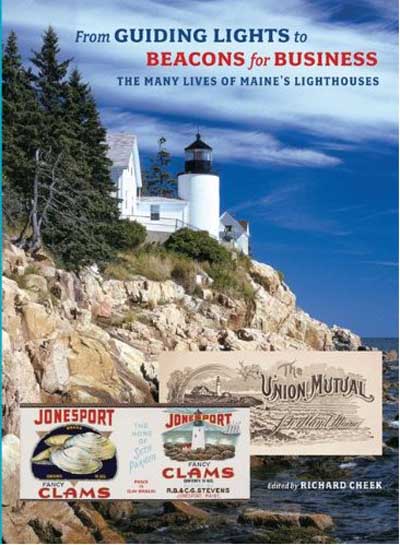

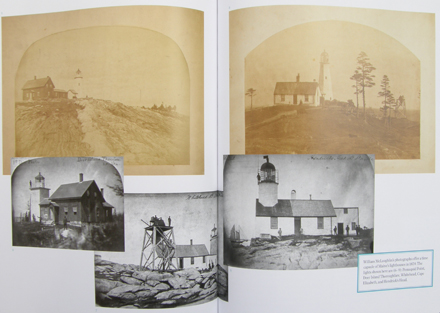 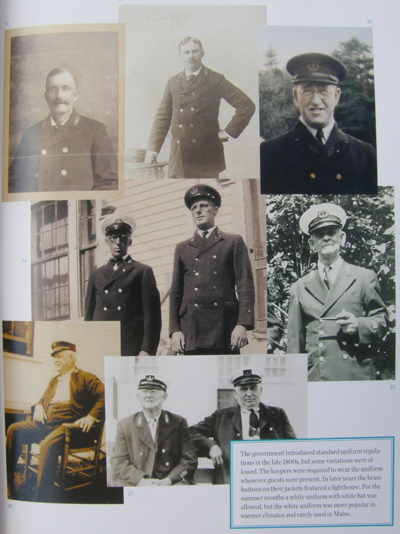
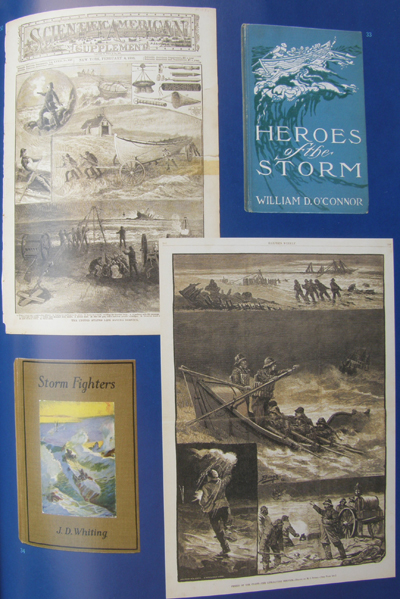 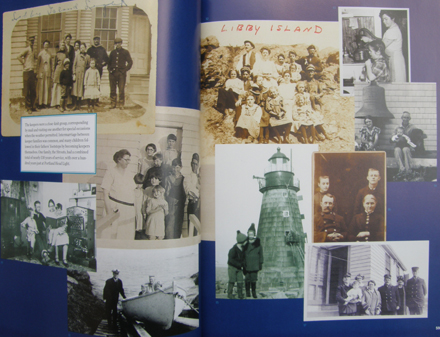
1276. Cheek, Richard (ed). From
Guiding Lights to Beacons for Business: The Many Lives of Maine's Lighthouses.
Historic New England. 2012. 240p. Soft wraps. Published by Historic New England,
this new book contains an amazing amount of material with a layout and design
like no other book published about Maine's Lighthouses. The influence of Maine's
lighthouses derives not just from the structures themselves but from the myriad
forms of writing, representation and reproduction that they have inspired. This
book is the third volume in the visual history series that Historic New England
is publishing, and contains ten detailed chapters by seven authors, with
an introduction by Senator Snowe. With 240 pages and hundreds of color and b/w
images, the book is loaded with amazing facts and wonderful visual imagery. Some
chapters include: Throw Out the Life-Line, Shaping the Towers, All Alone and
Ever Ready, Children Lighthouses and Lifeboats, Saving the Sentinels. The
perfect, entertaining, Maine lighthouse book and a must-have for anyone with
interest in lighthouses and how they have influenced society, advertising and
more over the last century. Shown above is an image from the book, Keepers
Robert T. Sterling and Frank Hilt, keepers at Portland Head Light. This is a
limited printing and sure to sell out fast. (M). $34.95.
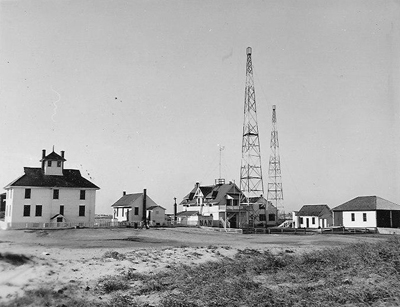
12297. Cuzzart,
Melissa Leigh. From
Surfman to Petty Officer: The History and Legacy of the U.S. Life-Saving
Service and the U.S. Coast Guard at Cape Lookout, North Carolina.
2009. Proquest. 110p. Soft wraps. Quietly nestled among the dunes of Cape
Lookout North Carolina lie the remnants of what once was a working Life-Saving
Service and Coast Guard Station, and numerous locally owned shanties.
Although the buildings are slowly decaying, the stories of these men and their
impact on the surrounding community continue to provide a basis upon which the
local culture and way-of-life exists. This study details how the presence of the
Life-Saving Service and the Coast Guard affected the lives and experiences of
the local people and shaped the reflection, memory, and meaning of the site for
present day visitors. Through local oral history interviews including past Coast
Guardsmen stationed there, as well as the log books of the Keepers, the memory
and legacy of both agencies in this unique place offers a link between the past
and present. Interesting accounts from this different perspective. (M). $89.95.

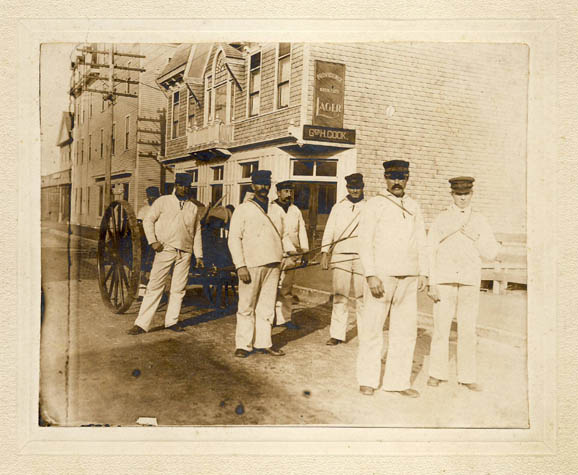
12181. Karentz, Varoujan. The
Life Savers - Rhode Island’s Forgotten Service. Amazon. 2012. 252p.
Soft wraps. An incredible story of men against the sea and the U.S. Life Saving
Service of the 19th century. For almost 40 years, between 1878 and 1917 nine
U.S. Life Saving Stations along Rhode Island’s coastline and Block Island
saved both ships and crews in weather that froze hands, feet and limbs. The Life
Savers were remarkable men of courage and endurance patrolling beaches and
signaling ships standing in danger. They rowed their surfboats into dangerous
seas or rigged beeches buoys rescuing lives. Their lost stories and history have
been captured by Karentz from official government archives and told in their own
words. Included are synopsis of Rhode Island’s worse marine disasters as the
passenger steamer SS Larchmont in the dead of winter was holed and sunk by the
schooner Harry Knowlton with a loss of 145 lives, to the rumored purposeful
shipwrecker’s on Block Island who decoyed wayward vessels to their doom to
salvage wreckage and cargo. Dozens of shipwrecks and rescues by the men assigned
to the Life saving stations are covered with direct words from the rescuers
themselves. The Life Savers will intrigue you as how these gallant men fought
the elements and how they saved lives. (M). $14.95.


1291.
Stonehouse, Frederick. Steel On The Bottom - Great
Lakes Shipwrecks. Avery. 2012. 224p. Soft wraps. Historical photos,
maps, illustrations and underwater photos. Noted maritime historian Frederick
Stonehouse recounts the final voyages of eight Great Lakes ships in this volume
from Avery Color Studios, a firm specializing in Great Lakes-related books,
posters, maps, etc. The ill-fated vessels chosen for inclusion share only the
common trait of being steel-hulled ships whose loss tickled the author's fancy.
They include a car ferry lost in 1910, a Netherlands freighter lost in 1953, a
sand dredger lost in 1950 and so on. In most cases the ships succumbed to the
terrifying storms that all too often sweep across the Great Lakes; the others
collided in poor visibility. Yet in reading through these accounts, time and
again human stupidity, incompetence, inadequate crew training, poorly done ship
inspections and related factors played roles in the sinkings and/or excessive
loss of life. Stonehouse does a good job of evoking the tedium, tension and
sometimes stark terror of sailing the Great Lakes and enduring its vicious
storms. Though none of these vessels will ever enjoy the notoriety of the Edmund
Fitzgerald, their voyages and endings are well told in this book, which includes
over 80 black & white photographs and maps. This book is sure to please both
the Great lakes history and shipwreck buff. (M). $16.95.
1292.
Stonehouse, Frederick. Wood On The Bottom- Great Lakes
Shipwrecks. Avery. 2012. 208p. Soft wraps. Historical photos. A
follow up to his very popular Steel On The Bottom, this well researched and well
written shipwreck book focuses on wood ships that have met their demise on the
Great Lakes. For many centuries wood was the preferred material for ships, both
salt and freshwater. Masts, cabins, decks and hulls were all made from it. It
was strong, resilient, easy to work with and inexpensive. Properly used and
maintained, a wooden ship could last for many years. But it was no guarantee of
safety as Wood On The Bottom proves beyond a doubt. Stress of storm, collision,
poor navigation, bad luck and human folly all played a part in sending thousands
of wooden ships to the bottom of the Great Lakes, where they are quietly rotting
away into the ages. Wood On The Bottom tells the dramatic tales of a dozen
wooden shipwrecks. Some like the Alvin Clark, Lady Elgin and Rouse Simmons (the
infamous Christmas Tree Ship) are well known, but others, including the Persian,
Oriole and Bon Voyage are cloaked by history. Another outstanding Stonehouse
book. (M). $16.95.
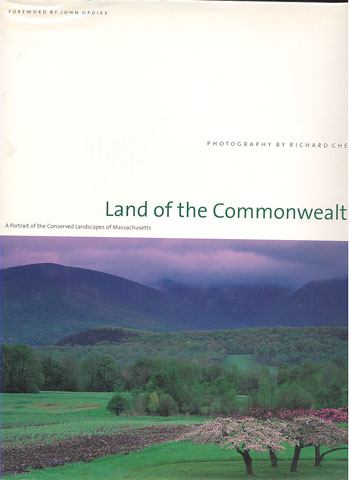 
1278. Cheek, Richard, John Updike and
Robert E Cook. Land of the Commonwealth: A Portrait of
the Conserved Landscapes of Massachusetts. Trustees of Reservations.
Oct 2000. 160p. Soft wraps. 190 color illus. Forward by John Updike. When The
Trustees of Reservations was founded in 1891 as America's first private,
statewide conservancy, belief in the restorative powers of nature was a
relatively new idea in America. Gradually, the colonial impulse to subjugate the
wild was transformed into a humanistic reverence for the spiritual power of
nature, and land was set aside for preservation. Thanks to the efforts of The
Trustees of Reservations and many others, Massachusetts now has 1.1 million
acres of land permanently protected from development-more than one-fifth of the
state. Land of the Commonwealth is the first photographic book devoted
exclusively to the conserved landscapes of a single state. It is both a visual
introduction to the diverse natural and cultural sites that have been protected
and a tribute to the accomplishments of all those who have worked to safeguard
Massachusetts's rich landscape heritage. Organized geographically into five
regional sections, the book uses spectacular color photographs by Richard Cheek
to capture the scenic, historic, and ecological dimensions of the conserved
landscapes of Massachusetts. Each chapter begins with a description of the
region's defining characteristics, followed by images of exemplary natural,
designed, working, historical, and literary landscapes. Some are popular and
beloved, others little-known and waiting to be discovered. Superb work by this
nationally recognized photographer. (VG+). $38.
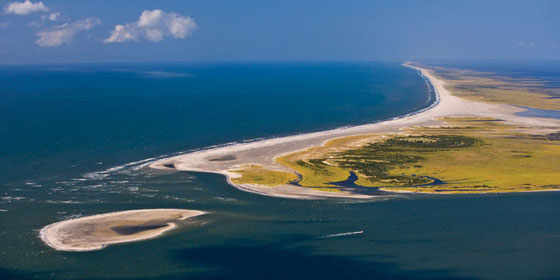
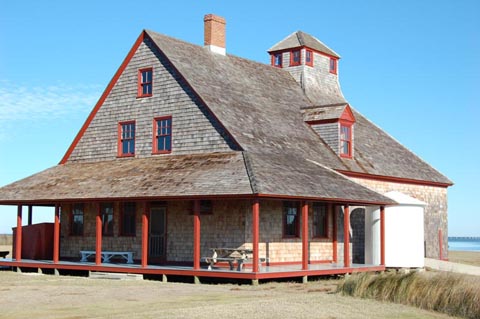
1274. Salter, Ben B. Portsmouth
Island - Short Stories and History. 1972. Softcover, 80 pages.
Illustrated. Portsmouth Island stands as a reminder that some wild places cannot
be tamed. Contained within the sandy borders of Portsmouth Island, North
Carolina, lies Portsmouth village, a 250-acre hamlet once known to be a bustling
Southern Outer Banks settlement bordered by precious, undisturbed beaches. This
an easy read about simple times in this once bustling fishing village. Anyone
who has ever visited our nation’s outer beaches can appreciate these tales.
The stories recount the history of the island and some of it's inhabitants
before the last resident moved off the island and before the National Park
Service took it over in the 70's. Includes chapters on the Life-Saving / Coast
Guard station, shipwrecks off the island, caught in a storm, life on the island
and more. Great accounts for those who long to escape the hustle and bustle of
contemporary life. Clean, tight. Difficult to find. (VG+). $26.

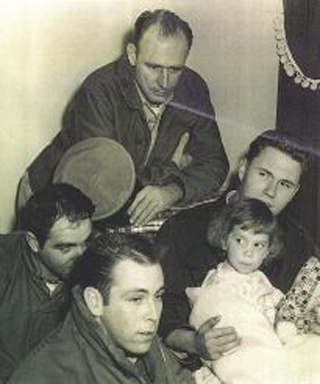 The
entire Coast Guard Crew visited Tammy in the hospital the day after the rescue. The
entire Coast Guard Crew visited Tammy in the hospital the day after the rescue.
11495. Alley, Margo. Rogue
Wave – Wood Island Lighthouse and The Historic Rescue of Tammy Burnham.
2012. Instant. 187p. Soft wraps. On the afternoon of November 29, 1960,
two-year-old Tammy Burnham almost lost her life when the small skiff she was in
capsized in Wood Island Harbor. Because of deteriorating weather conditions, the
United States Coast Guard called off the search for her and her rescuer, Seaman
Edward Syvinski USCG. Tammy’s father, Laurier Burnham, was the lighthouse
keeper on Wood Island, where the family lived. When told of the accident,
Burnham was ordered to remain on the island. Nevertheless, Burnham set out,
against orders, searching for them himself. He found his child and the seaman,
but both were near death. Burnham successfully transported them to the larger
USCG boat. Unfortunately, their problems did not end there as the U.S. Coast
Guard boat crew was disoriented in the fog and heavy breaking seas. A local
lobsterman would finally render assistance and play a major part in saving
little Tammy’s life. There was a delay of over 30 years before the men
involved became recognized and awarded. Today, over 50 years later, Edward
Syvinski, who held onto Tammy that fateful night and fought for their very
lives, authors his own chapter in Rogue Wave, breaking his silence at last. The
story has a history of controversy, but readers may easily reach their own
conclusions. (M). $19.95.
(Editor's Note: There appears to be some controversy into the
facts pertaining to this rescue but to date no book refuting the above account
has appeared. If or when it does we will be sure to present it as well.)
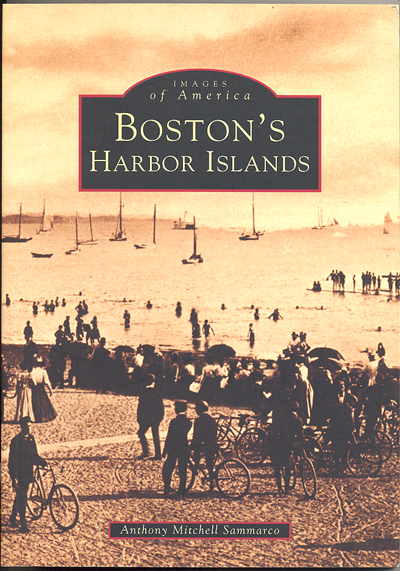
12268.
Sammarco, Anthony Michael. Boston's Harbor Islands. Arcadia.
1998. 128p. Soft wraps. 180 vintage photographs. First discovered in 1630, the
many harbor islands have come to play an integral part in the history and
development of the city. Boston’s Harbor Islands uncovers the fascinating
stories of such places as Long Wharf, Castle Island, Minot’s Light, Marine
Park, and the Boston Floating Hospital, to name but a few. View the rare
photographs of Governor’s Island, and much more. Through a wealth of vintage
photographs and descriptive text, the author reveals the history and lore of
this historic area. Superb photographs, well worth it for the photos alone. (M).
$21.99.

2312. MacAlindin, Bob. NO PORT IN A STORM.
Scotland
. 2000. 146 p. Soft wraps. Now in its second printing. The ships of this book
evoke none of the usual romantic images of ships and yet may be the noblest of
all. Invariably painted a gaudy red, no other ships spent more time at sea yet
sailed fewer miles, their crews compelled to scan the same water and stretch of
coastline for the bulk of their working lives. The life of a lightshipman in a
hurricane was a sleepless nightmare of holding on, body braced against every
combination of rolling and pitching, with tons of water burying the ship. This
enthralling book describes 18 factual adventures from many countries including
America, Denmark, Ireland, Canada, England, Holland, Scotland, Australia and
Belgium giving vivid accounts of life aboard and the many hazards and disasters
that occurred. (M). $34.95.

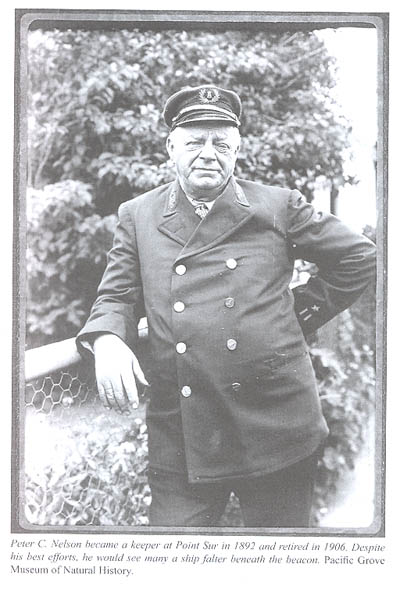
12115. Semones, JoAnn. Sea
of Troubles: The Lost Ships of Point Sur. Glencannon
Press. 2012. 229p. Stiff wraps. According to Celtic legend, “Thin Places”
are areas where two disparate worlds touch, such as land and sea. And so
it is with the rugged coastline of Big Sur. Twisting and turning along steep,
craggy cliffs, high above white-tipped waves, the region’s raw beauty is both
spectacular and inspiring. Most breathtaking is a gigantic dome-shaped rock
which seemingly sits at the edge of the world. Known as Point Sur, the
lofty monolith is surrounded by massive offshore boulders, dangerous reefs, and
swift currents. Its troubled seas doomed many fine ships to destruction.
Even a lighthouse, thought impossible to build, could not end further tragedy.
The many shipwrecks chronicled in these pages illuminate specific moments in
time. They allow us to reach into another era, shedding light on who we were and
who we have become. Thoroughly illustrated with vintage photographs, this work
provides a most interesting account of the many wrecks in the area, survival as
well as loss. (M). $27.95.

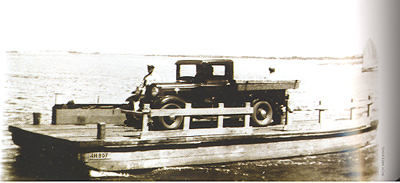
12197.
Dunlop, Tom. The Chappy Ferry Book. Back and Forth
Between Two Worlds ~ 527 Feet Apart. 2012. Vineyard Stories. 128p.
Soft wraps. Photographs by Alison Shaw. DVD by John Wilson. This is a
delightful, fact-filled history of one of the shortest, oldest and most unusual
ferries in the country – the Chappaquiddick ferry on Martha’s Vineyard. It
includes stories about the blind man who skippered it for nearly forty years,
the seaplane that struck it in 1937, and the roles it played in the filming of
the movie Jaws. The book includes a centerfold illustration showing how the
ferry works and a 15-minute DVD of The Chappy Ferry Movie hosted by Dick Ebersol,
former chairman of NBC Sports, who has loved the ferry all of his life. Filled
with hundreds of vintage photographs and more. Fine reading. (M). $25.95.
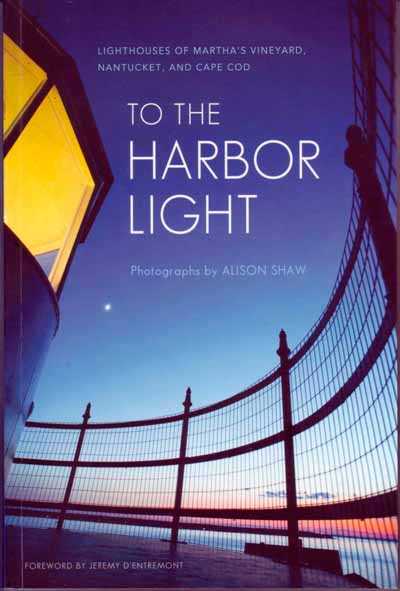
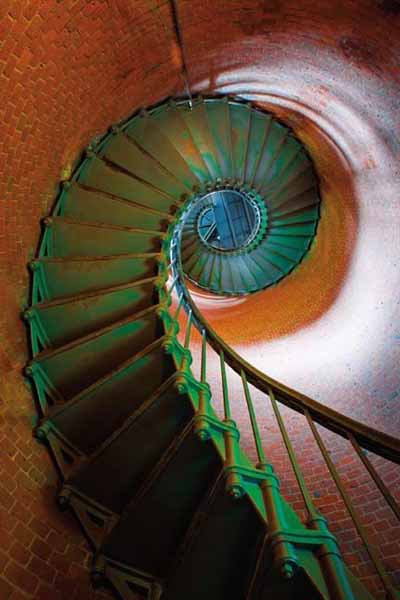
12193.
Shaw, Allison. To The Harbor Light - Lighthouses of
Martha’s Vineyard, Nantucket & Cape Cod. 2012. Vineyard
Stories. 96p. Soft wraps. Photographs by Alison Shaw. Text by Brenda Horrigan.
Foreword by lighthouse historian Jeremy D'Entremont. Lighthouses constantly
fascinate us. We look at them as links to a romantic past, as sentinels of our
shores. Organizations have grown up to protect them, admirers have built their
own private lighthouses, and millions of people visit the public ones each year.
And nowhere is there more variety, more history, and more beauty than along the
Massachusetts shores of Cape Cod and the islands of Martha s Vineyard and
Nantucket. Seen through the lens of Alison Shaw, the lighthouses take on a life
of their own caught in the reflection of the water they face, their lights
shining against a night sky, their windows ablaze with life. The images by
Allison Shaw of the twenty lighthouses featured in the book are more than just
photography. In this case, the back cover of the book is telling the truth: each
photograph truly is a work of art. Plus, the book is a practical guide to the
lighthouses of Cape Cod and the islands that also includes historical text
within its 96 pages. As an extra bonus, the publishers went out of their way to
print the book on some of the best quality paper we’ve seen in a long time for
a soft cover book. Lay this book on your coffee table or toss it into your
backpack to use as a guide when you go off to discover the joys of lighthouse
viewing. To The Harbor Light is nothing short of exquisite and we highly
recommend it. (M). $20.95.

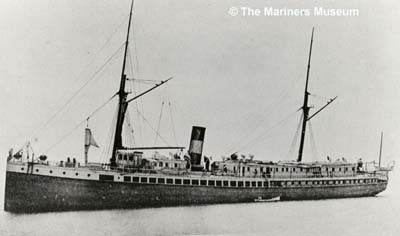
12134. Dresser, Thomas. Disaster
off Martha’s Vineyard. 2012. History Press. 160p. Soft wraps. With
its rocky coast and treacherous shoals, shipwrecks were a common occurrence in
nineteenth-century Massachusetts. Few claimed as many lives as the City of
Columbus. The night was clear and the route familiar for Captain Schuyler Wright
and his experienced crew as they sailed a ship equipped with the latest
technology. Yet with all this, the City of Columbus went down with 103 souls.
Over a century later, Eric Takakjian and the Quest Marine Services team located
the wreckage of the City of Columbus on the north ledge of the Devil’s Bridge,
off the southern tip of Gay Head. Historian Thomas Dresser takes us into the icy
waters of the Atlantic as he recounts the terrible chain of events that led to
disaster on that fateful night. (M). $19.99.
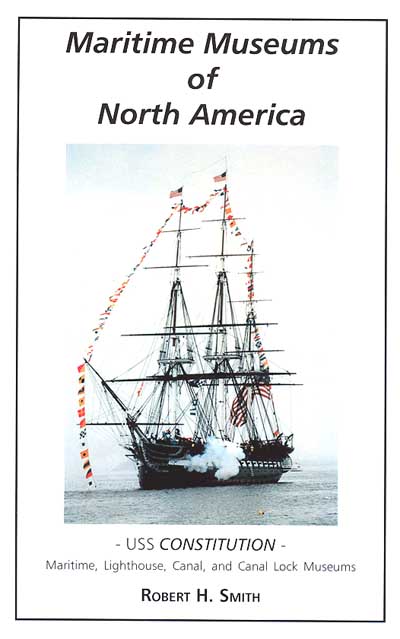
2739. Smith, Robert H. SMITH’S
GUIDE TO MARITIME MUSEUMS OF NORTH AMERICA. Del Mar. 2006. 6th. 250p.
with photo CD of maritime subjects. Soft wraps, spiral bound. This month we have
received a pair of books by Robert H. Smith that are valuable additions to any
maritime history collection. The first is the latest version of
“Maritime Museums of North America” listing over 600 maritime museums,
canals and canal locks, and lighthouse museums. Smith’s work has for many
years been the only comprehensive guide in print. In it you will find such
information as location and how to get there, phone numbers, description of
major exhibits, history, gift shops and more. Every page is filled with vivid
descriptions of ships on display, lighthouses and their surroundings, and almost
anything the author, researcher or visitor would need to know. Fully updated and
illustrated. I use this guide as a reference to contact lighthouse related
museums and I am sure that it will be of great use to you as well. This latest
edition has pointers to museum Web sites and accompanying photo CD with more
than 400 images of maritime subjects from around the country organized by state.
(M). Published at $19.95. Our Price $18.95.
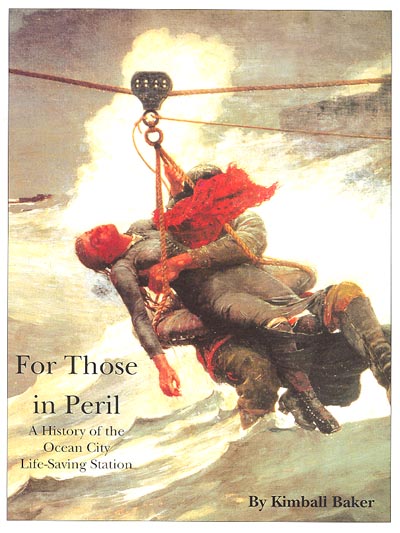

12147. Baker, Kimball. “For
Those in Peril”: A History of the Ocean City Life-Saving Station.
2011. Ocean City, NJ. 40p. Soft wraps. This story of the Ocean City Life-Saving
Station is twofold: the story of the station and its rescuers, and the story of
those who, through vision and perseverance, saved this important piece of our
history from the wrecking ball. This 40-page, illustrated booklet provides both
histories, and invites you to take part in making the rest of the story. A
special feature of the booklet is a chronology of station-saving events,
beginning with the listing of the property for sale in August 1998 and leading
to the station’s restoration phase. Also included: an acknowledgement of those
who rallied to preserve this beautiful station on site, and a chart with much
information about its U.S. Life-Saving Service rescuers. Interesting account of
the 1871 Red-House Type station and the later 1882-Type stations. (M).
$10.95.
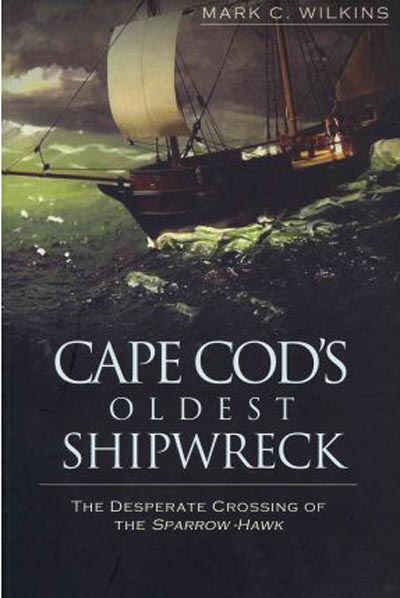
1287. Wilkins, Mark C. Cape
Cod's Oldest Shipwreck - The Desperate Crossing of the Sparrow-Hawk.
2011. History Press. 128p. Soft wraps. Over 40 images. In 1626, the Sparrow-Hawk
began its final journey across the brutal winter waves of the Atlantic Ocean,
departing from the southern coast of England-with America as its goal. As cases
of scurvy and whispers of mutiny rose, the hopes of those aboard the small
vessel began to fade. The ever-changing coastline of Cape Cod caused the
Sparrow-Hawk to run aground. Desperate to repair their ship and attain their
goal of becoming wealthy Virginia tobacco planters, they wrecked her again,
forcing them to abandon their beloved ship, and take up residence in Plymouth
colony. Revealed by the tides over two hundred years later, the wreckage was
pillaged by local scavengers and put on display in Boston. Join Mark Wilkins as
he delves into the secrets of the Sparrow-Hawk. (M). $19.99.
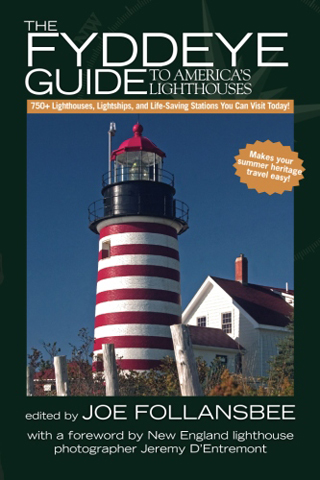
12113. The
Fyddeye Guide to America's Lighthouses: 750+ Lighthouses, Lightships, and
Life-Saving Stations You Can Visit Today! Seattle. 2012. 242p. Soft
wraps. Well illustrated. The most comprehensive travel guide to hundreds of
lighthouses, lightships, and life-saving stations in the United States - the
Fyddeye Guide to America’s Lighthouses helps families, retirees, veterans, and
visitors find the most interesting maritime heritage attractions for the summer
travel season. From islands in Maine to the metropolises of southern California,
you’ll discover the towering historic structures that have inspired travelers
for millennia. You can get close to virtually all America’s lighthouses, and
many allow you to climb to the top and stay as long as a month in historic
buildings. Includes more than 750 lighthouses, conveniently organized by coastal
region and state; brief histories and complete contact information, including
website, email address, and phone; three maps with suggested itineraries for
discovering lighthouses in New England, Michigan, and California; notes on
whether you can stay overnight on the lighthouse grounds, possibly in the
keepers’ historic quarters; chapters on lightships and historic life-saving
stations, including availability of overnight accommodations; more than 40
images of lighthouses from coast to coast; and more. (M). $17.95.

12112. Dresser, Thomas. The
Wampanoag Tribe of Martha’s Vineyard - COLONIZATION TO RECOGNITION.
History Press. 2011. 192p. Soft wraps. The Wampanoag tribe of Gay Head/Aquinnah
is a group of indigenous people on Martha’s Vineyard. From their legendary
giant leader Moshup, Wampanoags can trace their ancestry back more than 10,000
years. The tribe weathered colonization by missionaries in the 1600s and then
endured two centuries of domination, only to have its land taken in 1870.
However, over the past 140 years, the Wampanoag tribe, which still lives in its
ancestral home of Aquinnah, has shown endurance and fortitude as it continues to
practice traditional crafts and its tribal heritage. In this book, Thomas
Dresser captures the spirit of the tribe, tracing its survival through to
recognition by the federal government in 1987, nearly 25 years ago. Brief
interviews with elders and current tribal members offer insight into the
tribe’s remarkable history. (M). $19.99.
 
12148.
Wright, John Hardy. Provincetown Volume I.
Arcadia. 1997. 128p. Soft wraps. 180 vintage photographs. On November 11, 1620,
the Mayflower landed at the tip of Cape Cod, allowing the Pilgrims their first
glimpse of America and their first contact with what was to become their new
home. In the nearly four hundred years since their arrival, Provincetown, a
charming and historic seaport town, has been an important port for fishing and
whaling vessels, a favorite destination for vacationers, and a haven for those
looking to make this unique community their home. Established in 1727,
Provincetown first found prosperity in the trade and commerce of the fishing and
whaling industries. At the turn of the twentieth century, however, the
seaport’s beguiling charms and innate beauty were discovered by artists and
writers who flocked to the seashore in successive droves. The more than two
hundred black and white images in this delightful volume, chronicle the
evolution of Provincetown—from the conception, building, and dedication of the
Pilgrim Memorial Monument, America’s tallest granite monument, to the
activities of residents and tourists at work and play in the three neighborhoods
of this enchanting Cape Cod town. Superb photographs, well worth it for the
photos alone. (M). $21.99.
12149.
Wright, John Hardy. Provincetown Volume II.
Arcadia. 1998. 128p. Soft wraps. 180 vintage photographs. By the beginning of
the twentieth century, picturesque Provincetown–– incorporated in
1727––was no longer one of the major seaports of Massachusetts involved in
the whaling industry. The fishing industry was still going strong due to the
hard-working Portuguese fishermen, but commercial interests looked towards
tourism as they had in many other towns and cities. Where once fishing shacks
and warehouses dotted the shoreline off Commercial Street, comfortable and
well-appointed guesthouses and restaurants emerged to support the growing
numbers of day-trippers (many of whom arrived by ferry from Boston) and
vacationers who were discovering this charming town at the very tip of Cape Cod.
Tourists had visited Provincetown early on. Henry David Thoreau made three
walking trips on Cape Cod around 1850, but it was not until the turn of the
century that artists, followed by playwrights, authors, and musicians, realized
they could live inexpensively in a community that fostered creativity. The
artistic and literary culture of Provincetown was enhanced by hangers-on who
enjoyed the Bohemian lifestyle. Counter-culture hippies of the 1960s blended in
with the colorful personalities of those individuals who came to “P-town” to
pursue an alternative lifestyle. Gays and Lesbians have transformed many aspects
of the town—both architectural and cultural––in its evolution from a
fishing village to a popular and prosperous year-round resort community.
Provincetown Volume I focuses on the architecture and social history of this
atypical town. This eagerly anticipated sequel features views of the shore,
harbor, and ocean, the whaling and fishing industries, art and artists,
playwrights and authors, entertainers, and alternative lifestyles. Superb
photographs, well worth it for the photos alone. (M). $21.99.

1215.
Sicchio, Mary. The Forgotten Cape: 1940-1960.
Arcadia. 2007. 128p. Soft wraps. 180 vintage photographs. In the 1940s through
the 1960s, the Cape Cod Chamber of Commerce promoted Cape Cod as an alluring
vacationland where the blue begins, and the frets of life cease. At the same
time, a young, exuberant man with a camera, Richard Cooper Kelsey, arrived in
Chatham. Kelsey began compiling a photographic record of small town life, of
Cape Cod tourist landmarks, and the real people of Cape Cod with precision and
clarity. He portrayed a Cape Cod of much beauty and charm, an earlier, more
youthful time, and a time just within reach of memory. The photographs in The
Forgotten Cape: 1940-1960 were culled from the over 7,000 item Kelsey Collection
of the Nickerson Room at Wilkens Library, Cape Cod Community College. Superb
photographs, well worth it for the photos alone. (M). $21.99.
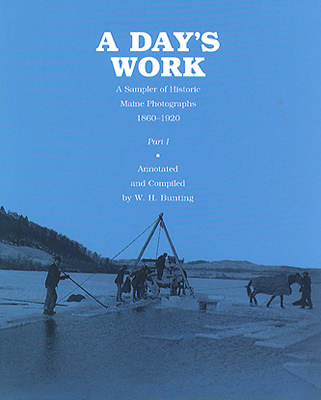 
7415. Bunting, W. H. A
DAY’S WORK: A SAMPLE OF HISTORIC PHOTOGRAPHS, 1860-1920. Part I.
Gardiner
,
Maine
. 1997. 384pp. With 225 b/w photographs. Any of you who have seen and enjoyed
Mr. Bunting’s previous work Portrait of a Port:
Boston
1852-1914, will surely enjoy this companion piece. Once again the author puts
together a collection of astonishing historic photographs accompanied by
narrative captions. Here the author leads the eye with extraordinary skill as we
view coastwise cargo schooners, traveling from island to island by scow, a
lumber batteaux shooting rapids, granite-cutting operations, long teams of oxen
hauling a building through Waldoboro, a mowing gang, train wrecks, lumber camps,
and much more. A grand collection for lovers of
Maine
, the coast,
New England
or just an earlier time. (M) Available in Paperback for $35 Reduced to
$22. or
Hardcover $55 Reduced to $33.
20370. Bunting, W. H. A
DAY’S WORK: A SAMPLE OF HISTORIC PHOTOGRAPHS, 1860-1920. Part II.
Gardiner
,
Maine
. 2000. 384pp. Soft cover. With 225 b/w photographs. Any of you who have seen
and enjoyed Mr. Bunting’s previous works Portrait of a Port:
Boston
1852-1914, and A Day’s Work: A Sample of Historic Photographs, 1860-1920,
Part I, will surely enjoy this companion piece. Once again the author puts
together a collection of astonishing historic photographs accompanied by
narrative captions. Here the author leads the eye with extraordinary skill as we
view coastwise cargo schooners, traveling from island to island by scow, a
lumber batteaux shooting rapids, granite-cutting operations, ship building, and
much more. A grand collection for lovers of
Maine
, the coast,
New England
or just an earlier time. (M). Published at $35. Reduced to $22.


1291.
Stonehouse, Frederick. Steel On The Bottom - Great
Lakes Shipwrecks. Avery. 2012. 224p. Soft wraps. Historical photos,
maps, illustrations and underwater photos. Noted maritime historian Frederick
Stonehouse recounts the final voyages of eight Great Lakes ships in this volume
from Avery Color Studios, a firm specializing in Great Lakes-related books,
posters, maps, etc. The ill-fated vessels chosen for inclusion share only the
common trait of being steel-hulled ships whose loss tickled the author's fancy.
They include a car ferry lost in 1910, a Netherlands freighter lost in 1953, a
sand dredger lost in 1950 and so on. In most cases the ships succumbed to the
terrifying storms that all too often sweep across the Great Lakes; the others
collided in poor visibility. Yet in reading through these accounts, time and
again human stupidity, incompetence, inadequate crew training, poorly done ship
inspections and related factors played roles in the sinkings and/or excessive
loss of life. Stonehouse does a good job of evoking the tedium, tension and
sometimes stark terror of sailing the Great Lakes and enduring its vicious
storms. Though none of these vessels will ever enjoy the notoriety of the Edmund
Fitzgerald, their voyages and endings are well told in this book, which includes
over 80 black & white photographs and maps. This book is sure to please both
the Great lakes history and shipwreck buff. (M). $16.95.
1292.
Stonehouse, Frederick. Wood On The Bottom- Great Lakes
Shipwrecks. Avery. 2012. 208p. Soft wraps. Historical photos. A
follow up to his very popular Steel On The Bottom, this well researched and well
written shipwreck book focuses on wood ships that have met their demise on the
Great Lakes. For many centuries wood was the preferred material for ships, both
salt and freshwater. Masts, cabins, decks and hulls were all made from it. It
was strong, resilient, easy to work with and inexpensive. Properly used and
maintained, a wooden ship could last for many years. But it was no guarantee of
safety as Wood On The Bottom proves beyond a doubt. Stress of storm, collision,
poor navigation, bad luck and human folly all played a part in sending thousands
of wooden ships to the bottom of the Great Lakes, where they are quietly rotting
away into the ages. Wood On The Bottom tells the dramatic tales of a dozen
wooden shipwrecks. Some like the Alvin Clark, Lady Elgin and Rouse Simmons (the
infamous Christmas Tree Ship) are well known, but others, including the Persian,
Oriole and Bon Voyage are cloaked by history. Another outstanding Stonehouse
book. (M). $16.95.
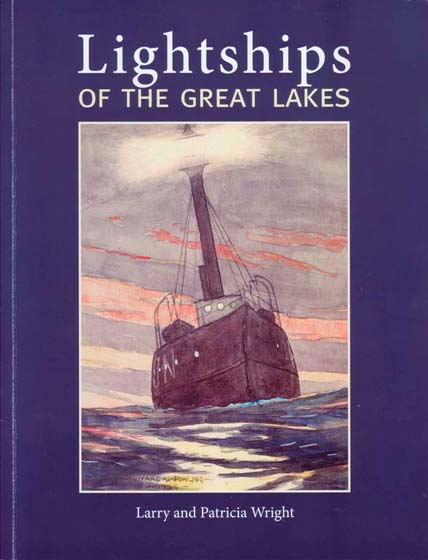
11420.
Wright, Larry & Patricia. Lightships of the Great
Lakes. Severn Bridge. 2011. 146p. Lighthouse historians Larry and
Patricia Wright have researched and compiled a wealth of information on
lightships all around the Great Lakes including the St. Lawrence River, with a
special chapter on vessel designations. Filled with accounts of life aboard
these vessels, their history, storms, damage and more, as well as over 100
vintage photos. (M). Published at $29.95. Our price $28.95.

20272a,b,c.
Gleason, Sarah C., KINDLY LIGHTS – A History of the
Lighthouses of
Southern New England
.
Boston
. 1991. 175p. DJ. A wonderful account of the evolution of a lighthouse system in
Southern New England
with considerable historic detail on the 98 light stations in the area.
Covering the area from Great Captain Island in Connecticut, to Newburyport
Harbor Light on the Massachusetts/New Hampshire border, the author weaves tale
of Pleasonton, Winslow Lewis and notable others in the evolution a system of
lights. Well done and a most worthwhile investment. (VG+). $15.95.
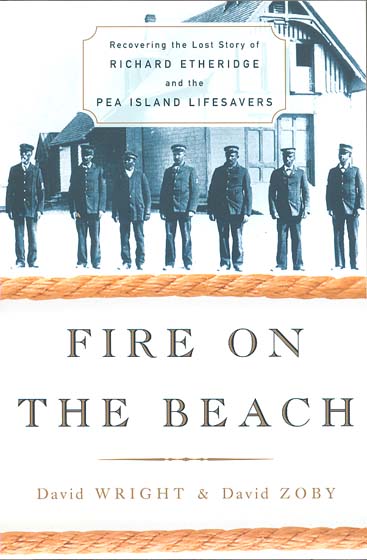
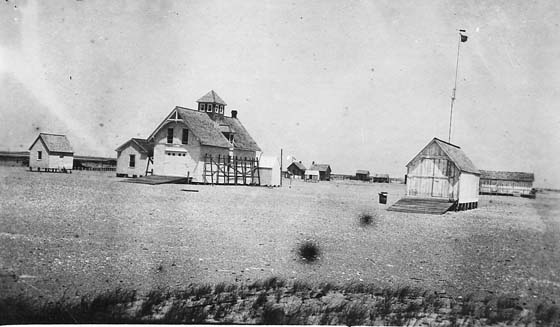
21430.
Wright, David & David Zoby. FIRE ON THE BEACH –
Recovering the Lost Story of Richard Etheridge and the
Pea
Island
Lifesavers.
New York
. 2000. 335p. DJ. Fire on the Beach recovers a lost gem of American history,
telling the story of the US Life-Saving Service and particularly the true-life
story of the early Life-Saving Service and Coast Guard and one crew of
African-American life-savers who fought storms and saved lives off
North Carolina
’s Outer Banks. This historic account of the
Pea
Island
surfmen and their keeper leaves nothing to the imagination as the authors
chronicle their lives and work on the outer beach. Magnificent detail of their
daily lives and of numerous rescues that they performed. Surely one of the best
on the subject and great reading. (M). Published at $26. Our
price $24.95. Now available in soft cover $16.95.

11478. Arrigo, Joseph A. Historic
Northern Lighthouses Coloring Book. Apple-Wood. 2002. 48p. Soft
wraps. Lighthouses, with their bright, intense beacons of light, were built to
guide ships and boats of all kinds, helping to protect them from disaster. Every
lighthouse has its own unique story of shipwrecks, heroic rescues, romance, and
even ghosts. All lighthouses shown in these These coloring books will amuse,
entertain, and educate children of all ages and anyone who is fascinated by
these historical towers of light. (M). $8.45.

11476. MacKenzie, Morgan. American
Lightships, 1820-1983 : History, Construction, and Archaeology within the
Maritime Cultural Landscape. Lambert Academic Publishing. 2011. 128p.
Soft wraps. Lightships served a vital role in protecting U.S. maritime interests
from 1820 to 1983. Employed as navigational aids, lightships were stationed
along shipping lanes and intercoastal waterways in the Atlantic, Pacific, Gulf
of Mexico, Great Lakes, and various estuarine environments in the Chesapeake,
North Carolina, and the Pacific Northwest. Addressing gaps in the current
historical and archaeological record pertaining to lightships, this thesis
answers different research questions and discusses the role of lightships in the
American maritime cultural landscape. The development of lightship construction
is included as well as an explanation of changes in wooden, composite, iron, and
steel techniques. Information regarding characteristic features of lightships
focuses on improvements in light and fog signaling equipment. In total, this
historical and archaeological study analyses use, construction, and meaning of
lightships in America. (M). $98.

11473. McLintock-Hubbard, Doris M., Dory
of the Lighthouse. 2011. 72p. Soft wraps. This heart-warming story of
the memories of Doris M. McLintock-Hubbard’s childhood days at three
lighthouses will captivate your imagination while it draws you back in time, to
an amazing way of life that can never again be repeated in the annals of
history. The story takes you back to another era lost in time of a lighthouse
keeper’s family at three uniquely different lighthouses: The Esopus Meadows
Lighthouse, a beacon built in the middle of New York’s Hudson River,
Connecticut’s Saybrook Breakwater Lighthouse that is located at the end of a
long breakwater, and the land-based Eatons Neck Lighthouse, built to mark the
entrance to Long Island Sound’s Huntington Bay. You will be captivated as you
read the pages of the home-spun recollections from the days of yesteryear as
seen through the eyes of a child and now remembered many years later in life. As
well as preserving lighthouse history for future generations. Dory of the
Lighthouse will be loved by everyone; a book that will be read over and over and
treasured through the ages. (M). $10.95.

11463. Wachholz, Ted, The Eastland
Disaster Historical Society, The Chicago Historical Society. The
Eastland Disaster. Arcadia. 2005. 128p. Soft wraps. 180 vintage
photographs. More than 7,000 people living in the Chicago area and Michigan
City, Indiana, eagerly anticipated Saturday morning, July 24, 1915. The fifth
annual midsummer excursion and picnic had been organized by the employees of the
Western Electric Company’s Hawthorne Works. Thousands of carefree merrymakers
would enjoy a festive day including a lovely cruise across Lake Michigan to an
awaiting parade and day-long picnic. For thousands of hard-working immigrant
laborers and their families and friends, it was going to be a day to remember.
Instead, the day’s scheduled event turned into a tragedy unlike any other. The
SS Eastland, while still tied to the wharf, rolled into the Chicago River with
more than 2,500 passengers on board. Nearly 850 people lost their lives,
including 22 entire families. The ensuing struggle for survival, and the
resulting death, heroism, cowardice, greed, and scandal gripped the city of
Chicago. Thoroughly interesting and important account. (M). $21.99.

11431.
Whalen, Richard F., Everyday Life in Truro – From the
Indians to the Victorians. Charleston. 2008. 120p. Soft wraps.
Everyday Life in Truro describes the idyllic days of the Pamet Indians and the
storm-lashed hardships of Truro's first families as they worked to carve an
enduring settlement amid the sandy soil and dangerous fishing grounds of Cape
Cod. Have you ever wondered how life on the Outer Cape used to be, before
traffic and summer visitors? In Everyday Life in Truro, longtime Truro resident
Richard Whalen, author of the companion volume Truro: The Story of a Cape Cod
Town, illuminates Truro's past, describing in fascinating detail the everyday
triumphs and tragedies of pre-World War II life on remote and windswept Truro.
(M). $16.99.
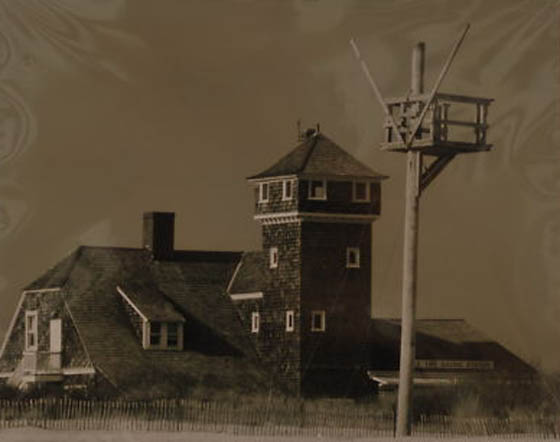
11411. Lee, James J. III. Spermaceti
Cove Life-Saving Station – Historic Structure Report. Lowell, Mass.
Historic Architecture Program, Northeast Region, National Park Service, U.S.
Dept. of Interior, National Park Service. Harpers Ferry. 2008. (Reprint 2011)
312p. Soft wraps. Historic Structure Reports provide a valuable foundation for
the rehabilitation, restoration, stabilization or reconstruction of historic
structures. Such a report is particularly important for finding or fabricating
significant missing architectural details and other items that would have been
found on such structures, and for documenting the history and changes to such
structures over time. This allows one to recapture the appearance of a property
at one particular period of its history, removing later additions, or
substantially modifying existing historic fabric. In this case, Spermaceti Cove
Life-Saving Station was studied using evidence present at the site, historical
documents found at the National Archives, Life-Saving Service records, logs,
reports, letters from the keepers and more. Using these and other sources, the
author is able to provide a detailed assessment of how the structure would have
looked during the period of interest, and more. The report includes a number of
period photos and diagrams, and excerpts from Life-Saving Service books and
documents for guidance. A most important reference for anyone interested in what
the station building (s) would have contained and looked like. (M). $78.

11337. Cann, Donald J., John J.
Galluzzo, Capt. W. Russell Webster, USCG (Ret.). The
Coast Guard in Massachusetts. Arcadia. 2011. 128p. Soft wraps. 180
vintage photographs. The Coast Guard’s deepest roots run through
Massachusetts, the ancestral home to three of the five predecessor agencies that
make up the service today. The Coast Guard formed in 1915 and since that time
has served the citizens of the Bay State at lifeboat stations, air stations,
lighthouses, LORAN stations, and radio stations, as well as on lightships and
cutters of all sizes. They have protected the Massachusetts coastline during
numerous wars, performing some of the most dramatic rescues in American
history—from the Pendleton to the Argo Merchant to the Etrusco and more. The
story of the Coast Guard in Massachusetts is one of heroism, honor, respect, and
devotion to duty. Nicely told by this trio of respected Coast Guard authors.
This interesting volume draws images from public and private collections, most
never before published. Superb photographs of the stations, the men, equipment
and more, well worth it for the photos alone. (M). $21.99.
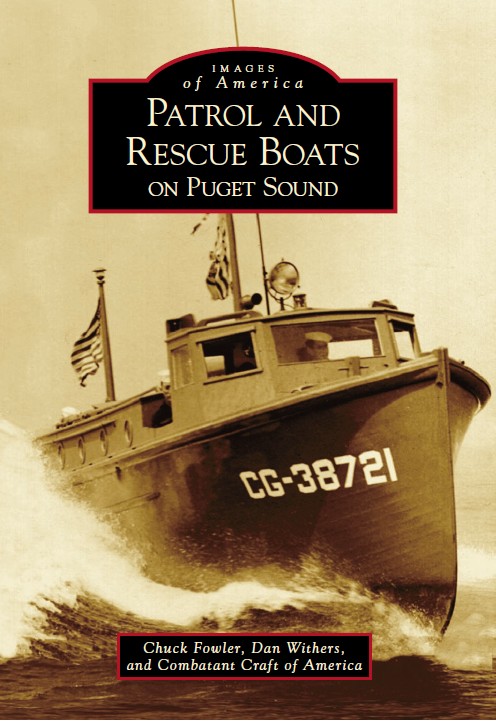
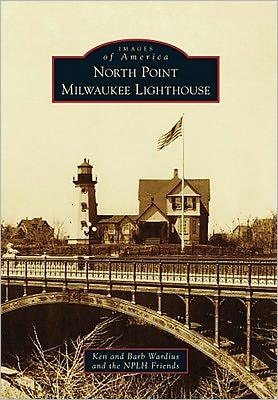
11339.
Fowler, Chuck, Dan Withers, Combatant Craft of America. Patrol
and Rescue Boats on Puget Sound. Arcadia. 2011. 128p. Soft wraps. 180
vintage photographs. The history of impressive battleships, aircraft carriers,
and submarines on Puget Sound has been well chronicled. However, the story of
the smaller, fast patrol and rescue boats that have protected its vast inland
waters is largely unknown. This book, through more than 200 rare images and
engaging text, reveals the fascinating story. It covers Navy, Coast Guard, and
Army Air Force craft in the sound, including the famed patrol torpedo boats of
World War II. Featuring evocative photographs from the National Archives, as
well as veterans’ personal collections, this book highlights these military
craft, their proud crews, and essential wartime and peacetime operations. Superb
photographs, well worth it for the photos alone. (M). $21.99.
11338.
Wardius, Ken, Barb Wardius, NPLH Friends. North Point
Milwaukee Lighthouse. Arcadia. 2011. 128p. Soft wraps. 180 vintage
photographs. The North Point Milwaukee Lighthouse, neatly nestled in beautifully
landscaped Lake Park on Milwaukee’s east side, is a local maritime jewel.
Incorporated as part of legendary landscape architect Frederick Law Olmsted’s
grand design for this scenic urban park, North Point rests far atop a bluff
overlooking Lake Michigan, making it one of the highest light stations on the
Great Lakes. Three distinctly different lighthouses have been located here, each
with its own unique story. Notable keepers include Georgia Stebbins, who came to
North Point as a sickly young woman and was transformed by fresh air and hard
work into a feisty, dedicated lightkeeper and served with distinction for over
30 years. Abandoned and boarded up for many years, North Point has been
resurrected from near ruin. Today, the North Point Lighthouse Friends see to it
that this historic sentinel is preserved for future generations. This
interesting volume draws images from public and private collections, most never
before published. Superb photographs of the stations, the men, equipment
and more, well worth it for the photos alone. (M). $21.99.

889. Williams,
Lawrence
W., A COLLECTORS GUIDE TO SOUVENIR
CHINA
– Keepsakes of a Golden Era, Identification and Value Guide.
Paducah
,
KY.
1998. 232p. Soft wraps. Completely illustrated with over 500 color photographs.
A hundred years ago, souvenir china was all the rage in the
US
. For the first time this well known expert from
Chatham
,
Mass.
presents a complete guide to the background and manufacturers, along with an
in-depth analysis, descriptions, and current values. For those of you who have
been collection lighthouse and life-saving commemorative pieces, or who would
like to collect pieces from your hometown, this is a most valuable reference.
Wonderful reading, with over 500 beautiful, clear color photographs of every
type and style, manufacturer’s marks and details. (M). $24.95

11341.
Sherrard, Raymond H. (Special Agent, Ret., U.S. Treasury Department). The
Encyclopedia of Federal Law Enforcement Patches. Garden Grove. 2000.
232p. Soft wraps. Thoroughly illustrated with thousands of color photographs.
The long awaited book by the Dean of U.S. Federal Police Emblem collectors,
is the definitive collector's guide to 4212 federal patches. The author’s
comprehensive book covers all federal agencies, combining Federal Law
Enforcement Patches Volumes I and II (out of print) with additional new patches
into one large reference volume. Full color throughout. This book can help you
avoid reproduction patches, and know what patches you need. All of the patches
in this book are numbered, and will assit you in identifying the patches you are
trading for. Chapters include: Department of Agriculture, Department of Commerce
NOAA NMFS, Central Intelligence Agency CIA, National Security Agency NSA,
Department of Defense DOD, Department of Education, Department of Energy DOE,
Environmental Protection Agency EPA, Federal Law Enforcement Associations, FDA /
HHS / SSA / HUD / OPM, Department of the Interior, Department of Justice DOJ,
Drug Enforcement Administration DEA, Federal Bureau of Investigation FBI, United
States Border Patrol, Immigration and Naturalization Service INS, United States
Marshal Service USMS, Department of Labor, United States Postal Service USPS /
USPIS, Department of State, Interpol / United Nations / USIA, Department of
Transportation DOT, Amtrak, United States Coast Guard USCG, Federal Aviation
Administration FAA, Department of the Treasury, Bureau of Alcohol, Tobacco, and
Firearms ATF, United State Customs Service USCS, Internal Revenue Service IRS,
United States Secret Service USSS, Judicial Branch / Federal Courts, Veterans
Administration / Department of Veterans Affairs VA, Legislative Branch / United
States Congress, Independent and Quasi-Federal Agencies, National Aeronautics
and Space Administration NASA, National Science Foundation, Tennessee Valley
Authority TVA, U.S. Trusts, Territories, and Possessions. (M). $39.95.
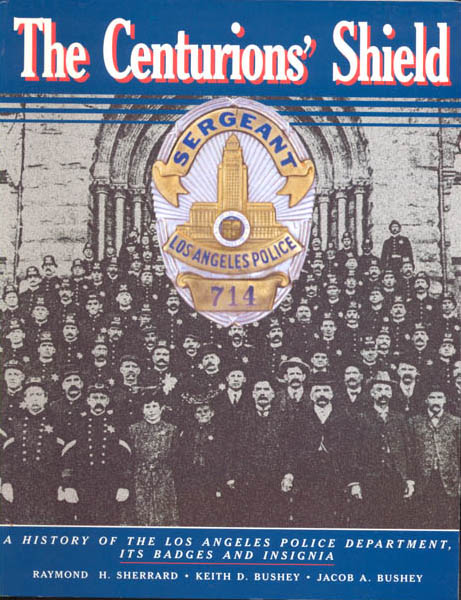
11340.
Sherrard, Raymond H. (Special Agent, Ret., U.S. Treasury Department), Keith D.
Bushey and Jacob A. Bushey. The Centurions’ Shield. Garden
Grove. 1996. 320p. Soft wraps. Profusely illustrated with hundreds of
photographs, (some in color), appendices, biblio., index. This book is THE
definitive, LAPD-authorized and comprehensively-researched history of arguably
what is the world's most famous law enforcement organization. Included is a
comprehensive pictorial guide to the hundreds of badges, patches and other
insignia of the LAPD as well as other City of L.A. departments, many of them
shown in full-color. Included are the Jack Webb/Dragnet years; rare badge
hallmarks, Reel Cops (the LAPD in TV and film), career info, collecting tips,
and much, much more! A must-have reference for all law enforcement personnel,
researchers and collectors! Well done! (M). $29.95.
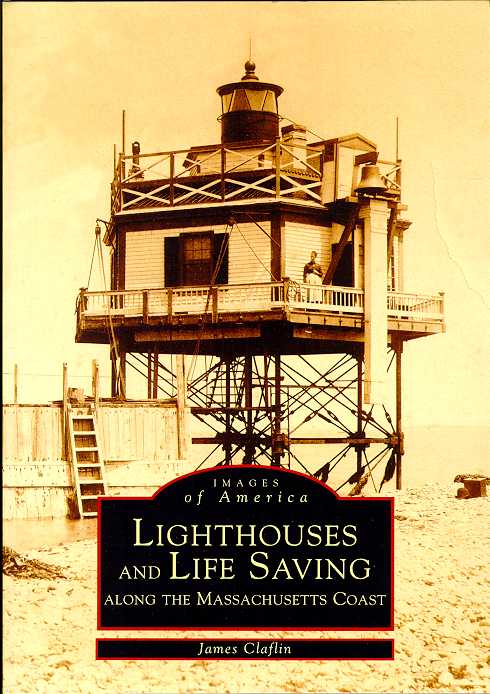
8248. Claflin, James W., LIGHTHOUSES AND LIFESAVING
ALONG THE MASSACHUSETTS COAST. 1998. 228p. 200 vintage photographs. Published as part of the Images of
America series by Arcadia Publishing. This is the first volume in a series of
photographic histories of lighthouses and lifesaving along the coasts of the
United States. Arcadia is a well known publisher of local and regional
histories, including the popular Images of America series. This compact volume features over 200 early photographs dating from the
1870's through the 1940's, drawn from my and other private collections, most
never before published and traces the history of these services through photos
and text. (M) $21.99.
Also available from the same author:
LIGHTHOUSES AND LIFESAVING
ALONG THE MAINE & NEW HAMPSHIRE COAST
LIGHTHOUSES AND LIFESAVING
ALONG THE CONNECTICUT & RHODE ISLAND COAST
9230. Applegate, Lloyd R., A
LIFE OF SERVICE: WILLIAM AUGUSTUS NEWELL.
Toms
River
, NJ. 1994. 153p. Soft wraps. William Augustus Newell (1817-1901) founded the
U.S. Life Saving Service by getting a $10,000 appropriation tacked onto the
Lighthouse Bill of 1848. Newell was a physician/surgeon, three-term congressman
from
New Jersey
, the first term being with Abraham Lincoln with whom he roomed, governor of
New Jersey
and later
Washington
Territory
, White House physician in 1865, Indian agent in the Northwest in his 70's etc.
For us, however, his extensive efforts in the establishment of the Life-Saving
Service are of considerable interest and the author devotes fully one quarter of
the book to these efforts, improvements in equipment and the memorial
established by the New Jersey Legislature in 1896 commemorating his efforts. The
only comprehensive account of the life’s work of this important figure. (F-).
$19.95.
Available Now!
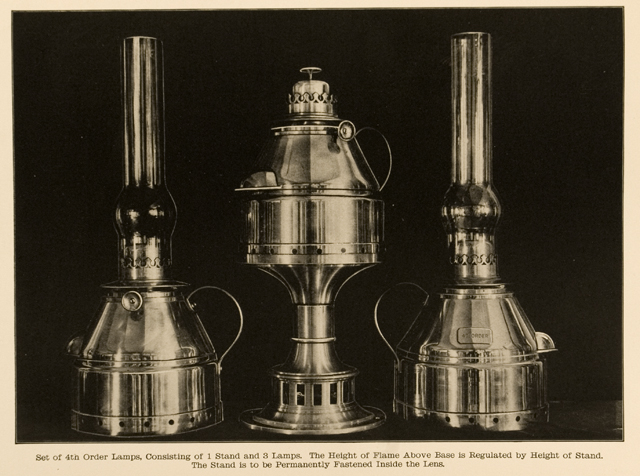
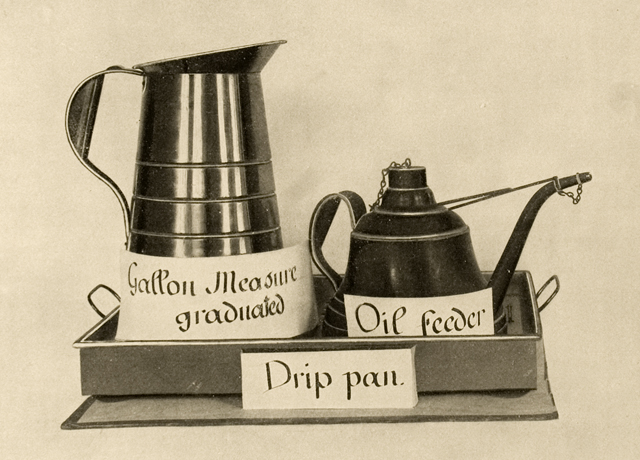
1166. United States Light House
Establishment. “Price List of Standard Articles (for
Lighthouse Purposes) Furnished from General Depot, Thompkinsville, New York.
1901”. Washington. GPO. 83p. We have known of the existence of this
document but until now have been unable to find it. It includes listings and
descriptions of items available from the General Lighthouse Depot in Staten
Island, for use by keepers at light stations, depots, for use on light vessels
and tenders, and more. Included are 18 text pages, 44 full page photo
plates and 21 fold-out plates of implements and equipment. Prices are included
for budgeting purposes when requesting such items from the General Depot
(keepers Service basket $5, First Order Revolving Lens $6,328, etc). Plates
include steam whistles, automatic sirens, electric buoy lantern, engines
to power fog signals, fog signal house, Daboll trumpet, bell striking apparatus,
air pressure lamps, 4th, 5th, 6th order lamps, lightship and tender lamps, table
lamp, locomotive headlight lantern, lens lantern, light vessel lanterns, post
lantern, revolving clock mechanisms, revolving lenses, keeper’s service
basket, oil carrier, dustpan, drip pan, oil feeder, oil measure, and more. A
“must” for museums, collectors, writers and researchers on the subject and
anyone interested in the apparatus used by the Lighthouse Service. Spiral bound,
photo-reproduced copy. (M). $86.
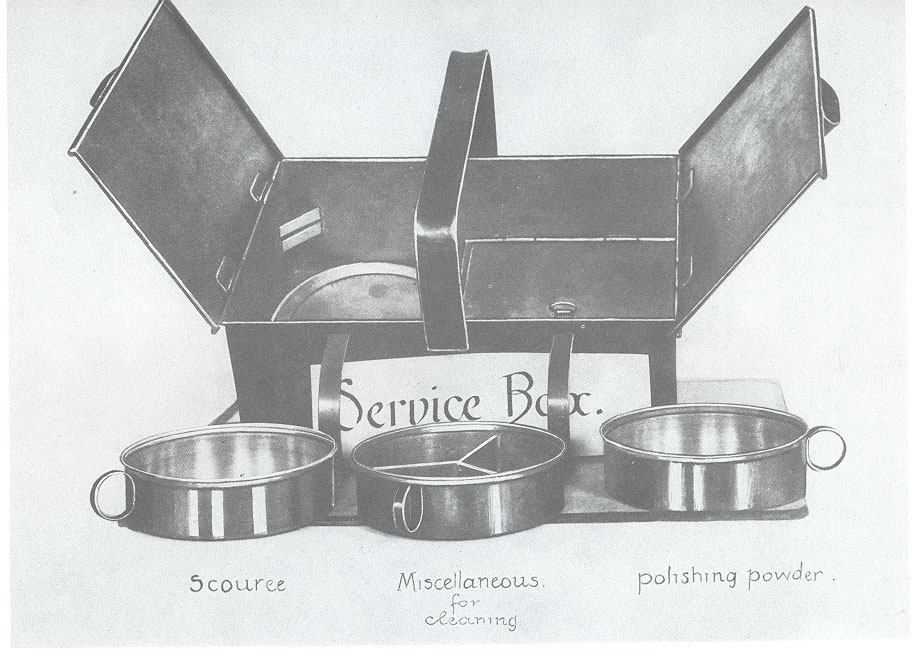
1104.
Menz, Katherine. POINT LOMA LIGHTHOUSE: CABRILLO
NATIONAL MONUMENT, SAN DIEGO, CALIFORNIA – Historic Furnishings Report. National
Park Service. Harpers Ferry. December 1978. 243p. Soft wraps. Historic
Furnishings Reports provide a valuable foundation for the rehabilitation,
restoration, stabilization or reconstruction of the interior furnishings of
historic structures. Such a report is particularly important for finding or
fabricating significant missing furnishings, tools and other items that would
have been found in the structures or used by the inhabitants. This allows one to
recapture the appearance of a property at one particular period of its history,
removing later additions, or substantially modifying existing historic fabric.
In this case, Point Loma Light Station was studied using evidence present at the
site, historical documents found at the National Archives, Light House
Establishment records, logs, reports, letters from the keepers and more. Using
these and other sources, the author is able to provide a detailed assessment of
how the interiors would have looked during the period of interest, what
furnishings and amenities would have been present, keeper’s tools and
equipment, clocks and more. The report includes a number of period photos and
diagrams, and excerpts from Light House Establishment books and documents for
guidance. A most important reference for anyone interested in what the inside of
light station buildings would have contained and looked like. (M). $48.
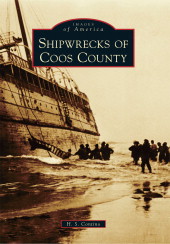
11162.
Contino, H.S. Shipwrecks of Coos County. Arcadia.
2011. 128p. Soft wraps. 180 vintage photographs. European settlement of Coos
County began with a shipwreck. The Captain Lincoln wrecked on the north spit of
the Coos Bay in January 1852. The crewmen built a temporary camp out of the
ship's sails and named it "Camp Cast-Away." This was the first white
settlement in the area. The men eventually traveled overland to Port Orford,
where they told other settlers about the Coos Bay and its many natural
resources. By December 1853, Coos County was established by the territorial
legislature, and several towns were founded; the history of the area had been
completely altered by a single shipwreck. The author has been the research
assistant at the Coos Historical and Maritime Museum for the past five years,
and has thoroughly researched over 100 local shipwrecks. Covering a 150-year
period, she has chronicled the misadventures of the vessels that traveled on the
county's two main bodies of water, the Coos Bay and the Coquille River. From
small fishing boats to lumber freighters, the vessel types vary greatly, and
their stories range from tragedies to simple maritime mishaps. Superb collection
of photographs. (M). $21.99
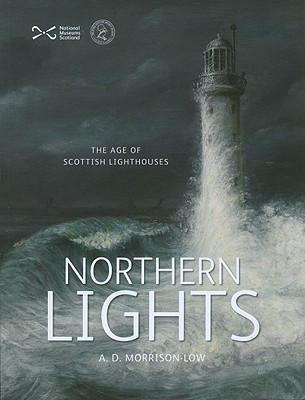
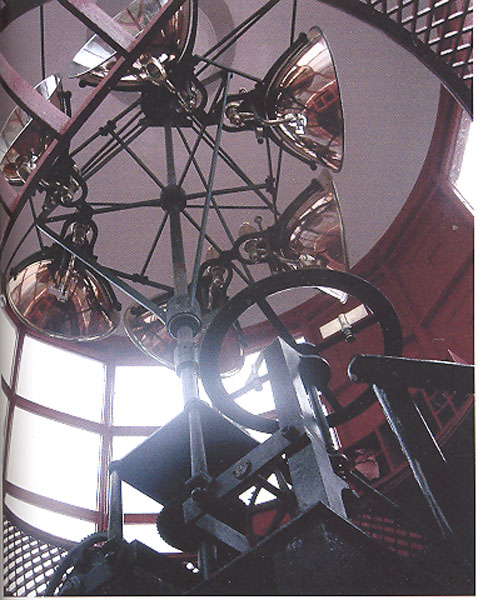
10507.
Morrison-Low, A. D. Northern Lights: The Age of
Scottish Lighthouses. National Museum of Scotland. 2010. 176p. Soft
wraps. Northern Lights has been published to mark the 200th anniversary in 2011
of the world’s oldest rock lighthouse, on the Bell Rock or Inchcape Reef, off
the east coast of Scotland. The Bell Rock Lighthouse, the world's oldest rock
lighthouse situated off the coast of the county of Angus, was built by the
famous Stevenson engineers, and has its 200th anniversary on 11 February 2011.
Northern Lights celebrates that occasion. This fully illustrated book tells the
story of Scotland's lighthouses through objects, charts and photographs, using
National Museums Scotland's pre-eminent collection of sea-marking material from
the Northern Lighthouse Board, and also items from the Stevenson family. For
reasons explained in the book, historic items relating to the building of the
earlier Eddystone Lighthouse, located in the English Channel, are also held by
the museum, and John Smeaton's stone-built construction there must be seen as
the inspiration for Robert Stevenson's structure. Wonderfully illustrated,
worth it for the lamp and lens photographs alone. (M). $24.95.

1186.
Henry, Karen Anderson. Papa Was a Lighthouse Keeper.
Author House. 2004. 76p. Soft wraps. Little Doris Hanson lived in the lighthouse
on Chambers Island, Wisconsin, every summer from the age of 11 days to 10 years.
Doris's father, Sam O. Hanson, was the assistant lighthouse keeper in the early
1900's. What was it like to live on a remote island in a lighthouse? Doris told
of her adventures and unique experiences of the life of a youn girl living in
just such a place for much of her childhood. Having lost her mother at the age
of 3, Doris learned the importance of having loving relationships with the rest
of her family. Her experiences shaped her life and taught her self-reliance.
This is the story of one summer on the island. (M). $14.95.

1171.
na. RESCUE – True Stories of the U.S. Life Saving
Service. Avery. 2011. 224p. Soft wraps. Forward by Frederick
Stonehouse. A compilation of U.S. Life Saving Service rescue accounts from the
United States Life Saving Service Heritage Association. Exciting true rescue
accounts from the Atlantic, Pacific and Great Lakes. Illustrated with photos.
Riveting reading. (M). $17.95. Available April 2011.
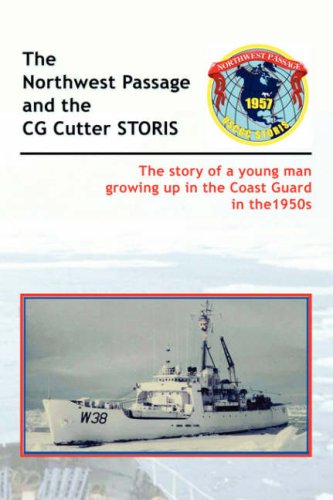
1194.
Juge, Dick. The Historic Northwest Passage and the
C.G.C. Storis - The Story of a Young Man Growing up in the Coast Guard in the
1950s. AuthorHouse. 2007. 300p. Soft wraps. In 1955 Dick Juge dropped
out of his final semester of high school to join the Coast Guard in time to
qualify for the Korean Conflict GIBill. This book takes you on his journey
through the Coast Guard enlistment and training process, and then on voyages
aboard three Coast Guard Cutters: Sebago out of Mobile, Alabams, Storis in
Alaska, and Duane from Boston. The author tells of boot camp mishaps, formidable
icebergs, liberty adventures, and much more as we accompany him in his career.
You will feel like a member of the crew aboard an icebreaker as it crosses the
Arctic. Good reading. (M). $35.
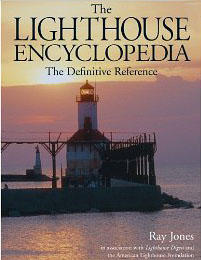
23254s.
Jones, Ray. THE LIGHTHOUSE ENCYCLOPEDIA – A
Definitive Reference.
Guilford
. 2004. 274 p. Soft wraps. Who was Augustine Fresnel? What is a clamshell lens? When
was the Cape Hatteras Lighthouse moved? What is a daymark? Lighthouse lovers and
anyone interested in history will find the answers to these and hundreds of
other questions in The Lighthouse Encyclopedia. This one-stop resource offers an
amazing wealth of information about the history of lighthouses, key people
associated with lighthouses, lighthouse technology, lighthouse organizations and
much more. Organized in typical A-Z encyclopedia style, this compendium of
information allows the reader to easily find historical fact, famous keepers, or
lighthouse mechanisms and much more. Lavishly illustrated with over 300 color
and b/w photographs, including many archival views of stations, keepers and
their equipment, 4 maps and more. This is a one-of-a-kind reference and should
prove an essential resource. (M). Published at $19.95. Our price
$15.95.
Special purchase price:
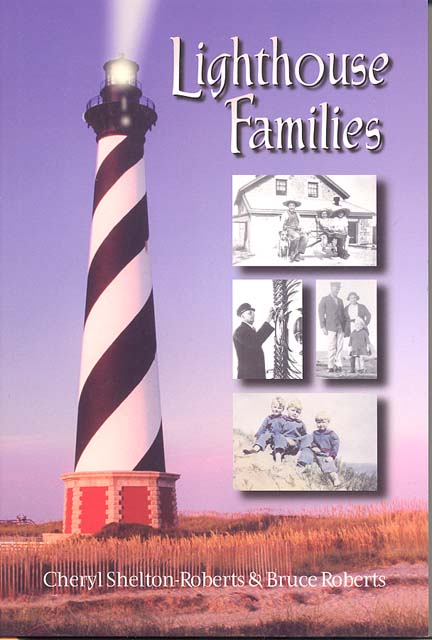
7209s. Shelton-Roberts, Cheryl. LIGHTHOUSE
FAMILIES. 2006. 210p. Soft cover. Living in a lighthouse was a way of
life for the families of more than 5000 keepers and employees of the United
States Lighthouse Service. These quiet people faithfully manned their remote
outposts and withstood enemy attacks, hurricanes, and dishonest bureaucrats
while saving countless thousands of lives. These men, women and children daily
experienced physical hardship, round-the-clock work, isolation, and danger - and
the strong bond of family. Though the Lighthouse Service no longer exists, many
of the children who grew up at these stations do and their stories are preserved
for the first time in this remarkable book. Family tales from Pigeon Point
California, St. Augustine Florida, Saddleback Ledge Maine, Old Mackinac Point
Michigan, Morris Island South Carolina and many more. Illustrated with over 100
family vintage photographs and a beautiful full color photo of the light as it
appears today. This is a book that you won’t want to put down. (M). Published
at $14.95. Our price $9.95.

1165.
Castro-Bran, Rose. Lighthouses of the Ventura Coast.
Arcadia. 2011. 128p. Soft wraps. 180 vintage photographs. The Ventura County
coast has been illuminated for more than a century by three distinctive
lighthouses, united in their mission of warning mariners of coastal hazards and
guiding ships to safe passage. Port Hueneme's original 1874 Victorian Stick
Style lighthouse stood sentry until it was replaced in 1940 by the
still-standing art moderne structure, which guards the only deepwater port on
the California coast between San Francisco and San Pedro. The Anacapa Island
Light, a cylindrical brick structure in the Channel Islands lit in 1932, was the
last new lighthouse on the West Coast. Ventura, originally dubbed San
Buenaventura by Fr. Junipero Serra in 1782, extends its "good fortune"
to the steamers, warships, tankers, and other craft guided to safety by these
navigation beacons. The author, a flotilla commander in the U.S. Coast Guard
Auxiliary and a member of the Coast Guard's Aids to Navigation Team, helps
maintain California's lighthouses and has been museum curator of Point Hueneme
Lighthouse since 2002. The evocative vintage images showcased here are from her
collection, local museums, lighthouse keepers' families, and the Point Hueneme
Lighthouse collection. Through these vintage photographs and detailed text,
Lighthouses of the Ventura Coast uncovers the history of these structures that
kept watch over the coastline. Superb photographs of the stations, keepers,
equipment and more, well worth it. (M). $21.99.
A Must Read !

23439. Lane. Anthony. GUIDING
LIGHTS – The Design & Development of the British Lightvessel from 1732.
Charleston
. 2001. 208 p. Over 200 photographs and illustrations. Soft wraps.
Anthony Lane
has researched the history of light vessels over a period of many years. Now he
has drawn his research into a book that covers the period from 1732 until the
present day. These light vessels have protected ships from the sandbanks and
treacherous waters surrounding the
British Isles
throughout war and peace. Until 1986, they were manned by a very special breed
of men who lived in arduous conditions to keep the light shining whatever the
weather thrown at them. The book is full of drama and technical detail and is a
must for any maritime enthusiast. The first lightship in the world was placed at
the Nore Sands, at the entrance to the Thames Estuary on the east coast of
England
, in 1732. About seven years later a lightship was placed at the entrance to the
Liffey: it remained on station until around 1782 when the Poolbeg Lighthouse was
established. These, and other early lightships were operated by private
entrepreneurs as commercial enterprises. The earliest lightships were converted
mercantile ships, with lanterns hung from yards. But from the turn of the
nineteenth century purpose-built lightships were designed. Through the
nineteenth century the number of lightship stations increased. At the beginning
of the twentieth century Irish Lights had twelve lightship stations, and three
or maybe four spare vessels, but Trinity House had around 65 stations. Dr Lane
describes in great detail the construction and arrangement of a typical
nineteenth century Trinity House lightship, including the general arrangements,
machinery space, crew accommodation, stores, deck machinery, and mooring
systems. The first Trinity House all-steel lightship was No 81, completed in
1926. The design of steel lightships varied through the ensuing years. Dr Lane
gives a detailed description of a typical steel lightship and also documents
changes in the design as they developed over the years. A separate chapter is
devoted to lanterns, lights, and optics and another to the various types of fog
signaling equipment. Includes superb photographs and information on early
burners, reflector lamps and much more. Thanks should go to the author, for
there is a wealth of information here that might have been lost had not Dr Lane
recorded it. Working life on board Trinity House lightships is described too,
and a hard life it was. Includes rarely seen views of crew spaces, working
spaces and much more. The book concludes with a chapter on lightvessel
automation and records the present whereabouts and condition of the surviving
British and Irish light vessels. The book has many excellent photos and drawings
showing details of machinery and equipment, vessels, and lightshipmen at work
and relaxing. An entire chapter consists of a photographic survey of steel
lightships. It is obvious that this book has been meticulously researched and it
is likely to become a standard reference book for the future. This is surely
a Must Read whether you are interested in US or British lightships, many of the
photos and information pertain to both and should not be missed. (M).
$76.
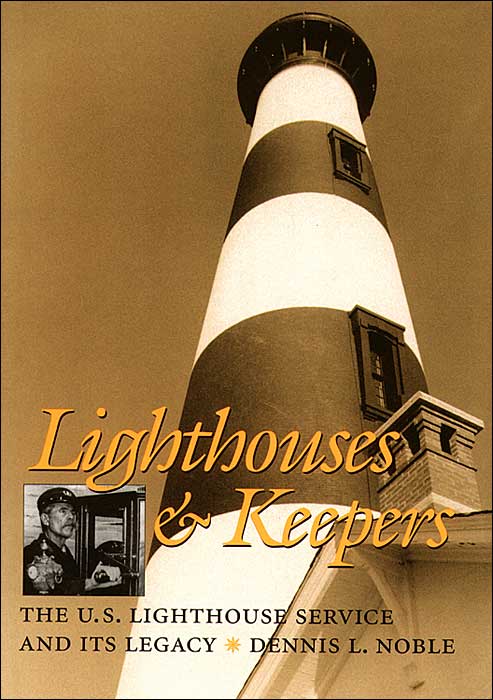
7452. Noble, Dennis L., LIGHTHOUSES
& KEEPERS - The U. S. Lighthouse Service and Its Legacy. 1997.
Annapolis. 244p. DJ. Certain to capture the imagination of his readers, this
renown author tells of shipwrecks, rescues, and of tending the lights during
long and lonely nights. All aspects of this fascinating topic are covered
including not only the work at the lighthouses and lightships, but also the
keepers, buoy tenders, buoys, fog signals and electronic aids. A book with a
special, personal appeal, great reading. (M). Retail $36.95. Our price $27.95.
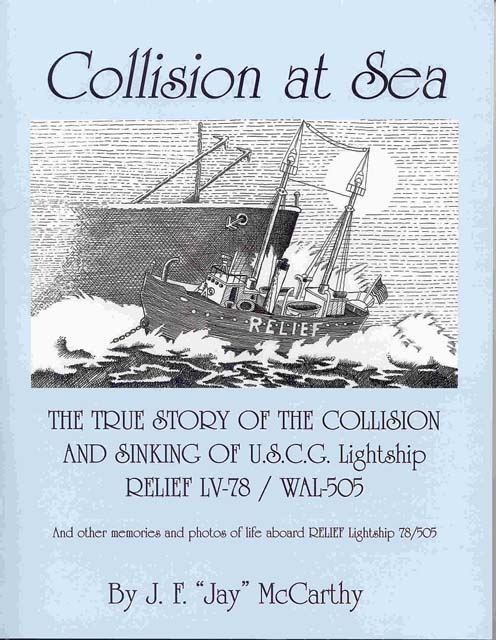
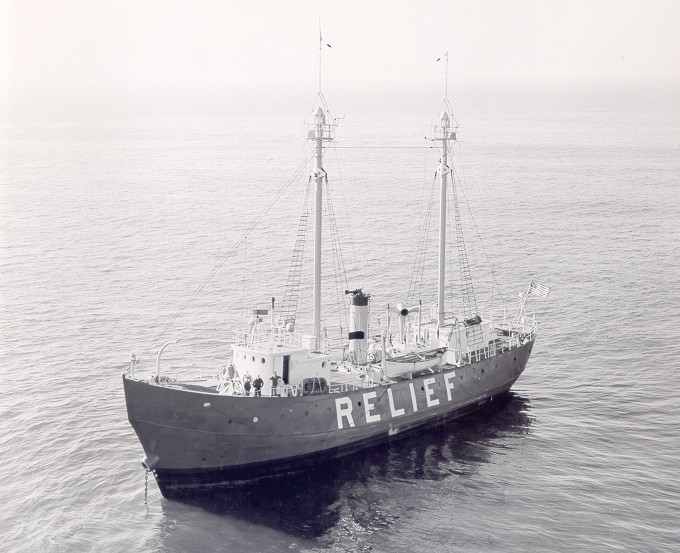
1103. McCarthy, James F. “Jay”. Collision
at Sea – The True Story of the Collision and Sinking of U.S.C.G. Lightship
RELIEF LV-78 / WAL-505, and Other Memories and Photos of Life Aboard RELIEF
Lightship 78/505. Infinity. 2010. 84p. Lightships were often called
floating lighthouses - they were stationed where it would not be practicable to
place a lighthouse, in exposed and dangerous locations, such as, far out to sea
in deep water, close in to shore with soft sandy bottoms or treacherous and
shifting shoals, in busy shipping channels or wherever maritime needs dictated.
Often, the defenseless lightship, anchored and incapable of avoiding a
collision, paid the ultimate price for remaining in this hazardous and
vulnerable position. This is a true story of one such collision. The author,
James F. “Jay” McCarthy, served 2 years on the RELIEF Lightship
LV-78/WAL-505. He speaks with firsthand knowledge of the ship and crew. He was
shipmates with a number of the crew that survived the collision by the freighter
SS Green Bay and the sinking of the lightship. He tells the whole story -
pre-collision, collision and post-collision and draws from excerpts of the
Official U.S.C.G. Joint Marine Board of Investigation into the collision between
the SS Green Bay and the USCG Lightship RELIEF 78 / WAL 505, and the survivors
story, as told largely in the words and memories of RELIEF LV 78/505 survivor
Bobbie R. Pierce, BM3. He attempts to tell this story in chronological order,
with a view into what was occurring on both ships during this timeframe. Most
interesting look into the lives and dangers of these “lightship sailors”.
Well illustrated with crew and ship photos. (M). $11.95.


1133.
Costopoulos, Nina. Lighthouse Ghosts and Legends.
Crane hill. 2003. 116p. Soft wraps. Following on the heels of Crane Hill's best
selling Lighthouse Ghosts (now in its sixth printing), Lighthouse Ghosts and
Legends brings fans of watery hauntings more of their favorite lore. Author
Costopoulos here weaves more than two dozen tales of mystery surrounding some of
America's best know beacons, including St. Simon's Island, New London Ledge,
Yaquina Bay, Saginaw River, Tillamook, Thunderbay Island, and more. Covering the
extent of coastal America and the Great Lakes, Lighthouse Ghosts and Legends
also runs the gamut of sprites, spirits, mysteries, miracles, and madness.
Lighthouse fans will consider this unique volume a must-have. The stories
featured in Lighthouse Ghosts and Legends are drawn from the Atlantic, Pacific,
and Gulf coasts, as well as the Great Lakes. (M). Pub $12.95. Our price
$9.95.
1134.
Field, Van. MAYDAY! Shipwrecks, Tragedies & Tales
from Long Island’s Eastern Shore. Charleston. 2008. 96p. Soft
wraps. Since the mid-1600's, eastern Long Island's shoals, sandbars and assorted
submerged hazards have caused many an unlucky vessel to become shipwrecked. The
frequency of wrecks rose to a grim crescendo during the mid-nineteenth century
as New York and New England peaked as shipping centers. Then came the dawn of
the twentieth century and the arrival of advanced navigational aids. Although
the number of wrecks declined, the high drama persisted as rumrunners and German
submarines kept the coast humming with rumors and anticipation. In MAYDAY!,
author Van R. Field painstakingly assembles a compendium of Long Island's most
harrowing, amazing and notorious shipwrecks and ocean-going incidents. (M). Pub
$17.99. Our price $14.99.
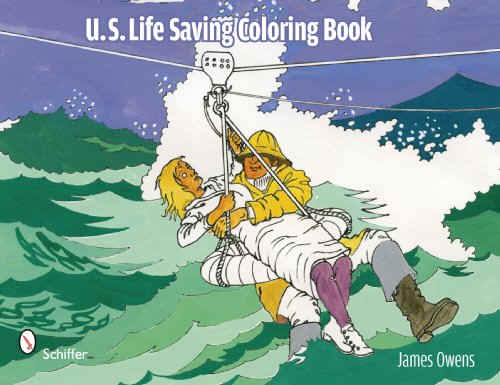
10508. Owens, James E. U.
S. Life Saving Coloring Book. Schiffer. 2010. 50p. Soft wraps.
Illustrated with 48 drawings. The history of the nation's Life Saving Service
comes alive in this 50-page activity book, with scenes of life on the sea and
water rescues depicted. Color the pages while learning about efforts to aid
shipwrecked sailors and the fates of wrecked ships. From Massachusetts, to the
Great Lakes, and the East and West Coasts, the history of lifesaving stations
can be preserved through this fun and colorful activity. Grades 3-6 recommended
(great for use with colored pencils). (M). $6.99.
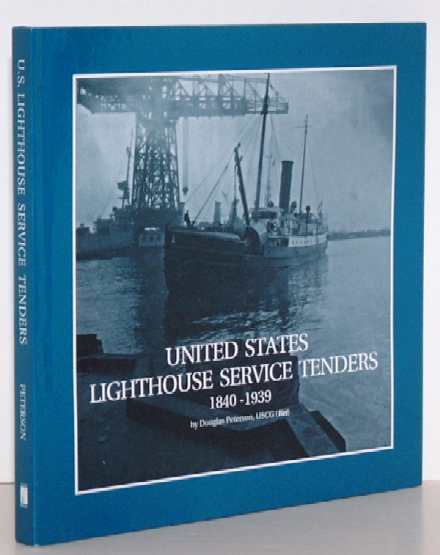
9496.
Peterson, Douglas, (U.S.C.G. Retired)
U. S.
LIGHTHOUSE SERVICE TENDERS. Eastwind Publishing. 2000. 169p. DJ.
This is the first book to feature all of the lighthouse tenders and auxiliary
craft of the United States Lighthouse service from 1840 until 1939. Lighthouse
Tenders, the lifeline to the keepers of America's lighthouses and lightships,
towed lightships, tended buoys, carried necessities and saved lives day and
night, in weather fair or foul. Without these services the keepers of
America
's lighthouses and lightships could not have survived. More than 150 years ago
the first tender was launched, to be followed by 300 ships of varying design
used for lighthouse service-all of which are presented in this thoroughly
researched book. Vintage photographs, drawings, plans and statistics illustrate
the historic profile of each ship. This long awaited book recognizes these often
overlooked ships of the U.S. Lighthouse Service and their important contribution
to
America
's maritime heritage. 9.5"x9.5", hardbound. 175+ b/w photos and plans.
Out of print - difficult to find. (M). $79.95.
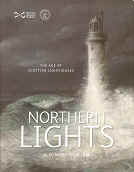 
10507. Morrison-Low, A. D. Northern
Lights: The Age of Scottish Lighthouses. National Museum of Scotland.
2010. 176p. Soft wraps. Northern Lights has been published to mark the 200th
anniversary in 2011 of the world’s oldest rock lighthouse, on the Bell Rock or
Inchcape Reef, off the east coast of Scotland. The Bell Rock Lighthouse, the
world's oldest rock lighthouse situated off the coast of the county of Angus,
was built by the famous Stevenson engineers, and has its 200th anniversary on 11
February 2011. Northern Lights celebrates that occasion. This fully illustrated
book tells the story of Scotland's lighthouses through objects, charts and
photographs, using National Museums Scotland's pre-eminent collection of
sea-marking material from the Northern Lighthouse Board, and also items from the
Stevenson family. For reasons explained in the book, historic items relating to
the building of the earlier Eddystone Lighthouse, located in the English
Channel, are also held by the museum, and John Smeaton's stone-built
construction there must be seen as the inspiration for Robert Stevenson's
structure. (M). Please inquire.
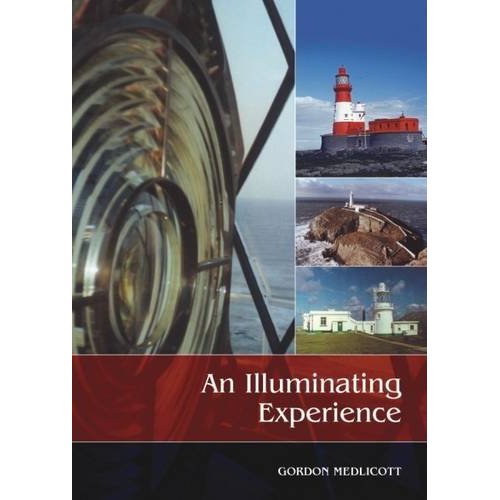
10509. Medlicott, Gordon. An
Illuminating Experience. Whittles. 2009. 144p. Soft wraps. Liberally
illustrated. A welcome addition to the slowly growing library of Lighthouse
Keepers' memoirs. The author's story begins in 1966 - a time when oil lights
were rotated by a hand-wound clockwork mechanism and keepers handled explosive
fog signals. Throughout the 1960s and '70s, despite having the technology to
land men on the moon, some of our lighthouses were still operated by oil, not
only for the main navigation light, but also in the keepers' living quarters.
With some of the offshore stations lacking even the basic facilities of running
water, a bathroom or heating life onboard was, to say the least, pretty basic.
Little did the author realize that he would witness, and become part of, a new
technological age that would sweep through the industry. Unmanned lighthouses
being operated by remote control via telemetry links to a computer and satellite
information provided by GPS. The narrative gives a great account of daily life
working in the lighthouse service covering a long period including the
mass-automation of stations and the end of manned lighthouses. In turn
exhilarating, funny and sad. (M). $31.95.

10488. Marc, Jacques F. Pacific
Coast Steamship China. UBC Press. 2009. 182p. Hardcover. 300+
color and 80 b/w photographs. At the height of Pacific-coast steamship travel in
the late 1800s and early 1900s, passengers enjoyed a sit-down dinner served on
china with silver flatware. Today, the only places you can still find this china
is at flea markets and antique shops or by diving at old dock sites and on
shipwrecks. Pacific Coast Ship China identifies and dates shipping china used
along the Pacific coast of North America. It identifies more than 280 china
patterns used on vessels and in-shore establishments of shipping organizations
registered in Alaska, Yukon Territory, British Columbia, Washington, Oregon,
California, Idaho and Hawaii; it describes patterns used in coastal,
intercoastal and transpacific services. In addition to passenger vessels, it
documents the china used by freighter operations, oil companies, government
services and yacht clubs. This easy-to-use guide identifies almost 300 china
patterns. It provides collectors, museum technicians, divers, history buffs and
anyone else interested in identifying and dating Pacific-coast ship china with
all the information they need. It also includes brief descriptions of 73
Pacific-coast shipping companies and government services including Lighthouse
Service and Coast Guard. (M). $79.95.
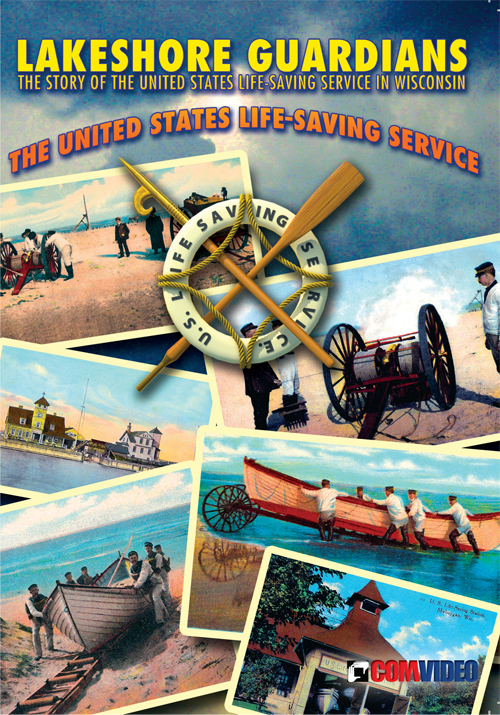
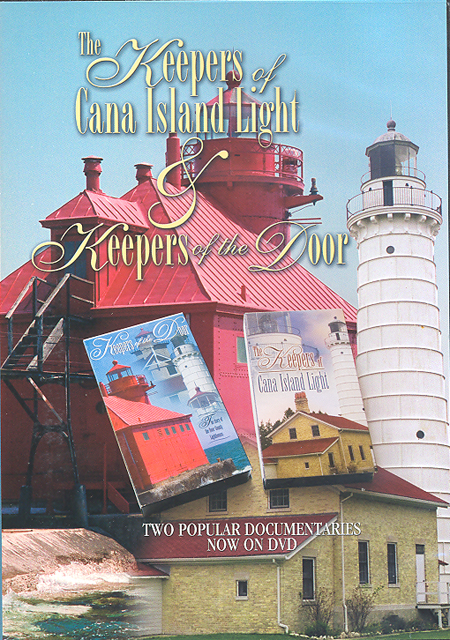
10459. (DVD) Lakeshore
Guardians - The Story of Nine Wisconsin Life-Saving Stations. 2010.
59 minutes. Written, shot, and edited by filmmaker Dan Larson who also produced
the Keepers of the Door series. Dan Weaver composed and recorded the music
score. Steve VanBekum provided voice-over narration. Between 1875 and 1896, nine
U.S. Life-Saving Stations were completed along the Lake Michigan coast,
stretching from Kenosha to Plum Island in Death’s Door Passage. Staffed by a
keeper and a seven-man crew, these “guardians” saved countless mariners
wrecked along the shore. Seven years in the making, this 59-minute documentary
tells the story of their sacrifice and bravery. Larson has spent the past
several years traveling the Lake Michigan coast shooting and documenting what
remains of the United States Life-Saving Service. The result is a comprehensive
video that includes such topics as the Sturgeon Bay Station’s rescue of the
schooner Otter’s crew, the Service’s role in the loss of the Christmas Tree
ship, the 1913 winter storm’s impact on the Plum Island Station and much more.
(M). $24.95. Our price $23.45.
10470. (DVD) The
Keepers of Cana Island Light & Keepers of the Door. 2006. (two
documentaries in one) In the Keepers of Cana Island Light, actor Stephen King
plays the part of Keeper Clifford Sanderson, who was Assistant Keeper at Cana
Island From 1884-1892, and keeper from 1924-1933. Join him as he begins the
story in 1867 when plans for the lighthouse were first discussed, and follow the
lives and work of each of the eight keepers at Cana Island over the years.
Keepers of the Door documents the many lighthouses of Door County, Wisconsin,
and the many keepers who dutifully kept the lights burning. Beginning in 1836 at
Pottowatomie Lighthouse on Rock Island and looks at twelve light stations, with
interviews of relatives of the keepers, looks inside the light towers and homes,
and more. (M). $29.95. Our price $28.45.
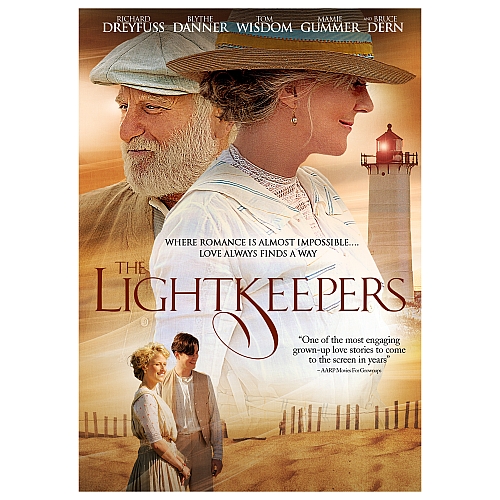
10448. (DVD) The
Lightkeepers with Academy Award® winner Richard
Dreyfuss (Jaws, The Goodbye Girl) stars with Emmy and Tony winner Blythe
Danner (Meet the Fockers) and Oscar® nominee Bruce
Dern (Coming Home) in this warmhearted tale of lost love and second
chances. This highly anticipated movie was filmed on location at the Race
Point Lighthouse on Cape Cod. The year is 1912. Vowing to swear off women
for good, curmudgeonly Seth Atkins (Dreyfuss) takes refuge tending a remote Cape
Cod lighthouse. Then, a mysterious stranger (Tom Wisdom, Pirate Radio) literally
washes up in Seth's life, with a past full of secrets and a similar aversion to
females. But the arrival of two beautiful, spirited women (Danner and Mamie
Gummer) will test the men's resolve - and send all four of them sailing into
uncharted romantic waters! Regular Price $27.95. Our Price $24.50.
 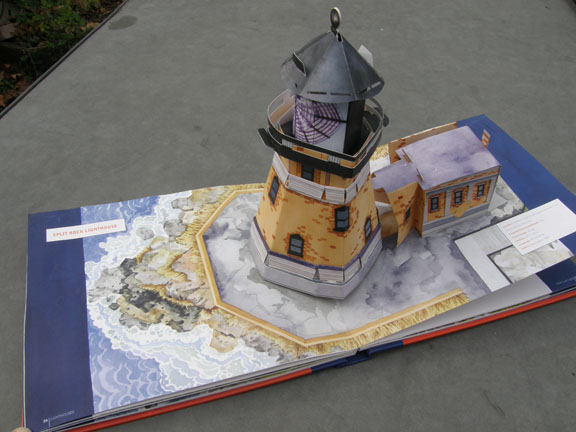
10490. Costello, Linda, and Bruce
Foster, Wendy Edelson, Al Mitchell. Lighthouses – A
Pop-Up Gallery of America's Most Beloved Beacons. Thunder Bay Press,
2007. Hardcover. From the busy Atlantic waters to the rugged Pacific coast,
explore the country's most historic and beautiful lighthouses with amazing 3-D
pop-ups. Lighthouses features more than 25 color photographs and original
illustrations showcasing America's coastal guardians. From the historical to the
technical, author Al Mitchell, a renowned expert in the field of lighthouse
study, explains the important roles played by each beacon through the years.
This unique tribute includes 5 amazing, architecturally accurate 3-D pop-ups
designed by acclaimed paper engineer Linda Costello. Beautifully illustrated
pop-ups stand approximately 9 1/2 inches tall and 5 inches in diameter and
demonstrate each lighthouse's unique design and function. Pop-ups include some
of the most famous landmarks in the country: Cape Hatteras Light, North
Carolina's distinctive black-and-white light tower; Old Point Loma Light, the
beacon for California's Gold rush traffic; and Florida's prominent Ponce de Leon
Inlet Light. This is the ultimate book for admirers of lighthouses and
architecture. (M). $28.95.
Lightships
of the United States of America Volumes I, II, III by Thomas Schoenewolff:

The
3 volumes of Lightships of the United States of America consist of a
comprehensive listing of all the lightships that served under the lighthouse
service and the Coast Guard. Each ship is outlined with the technical
specifications of service, officers, and crews of each ship. The data and
information includes all of the research done by noted lightship historian
Willard Flint, as well as from other sources across the country, organizations
and historical archives, providing a comprehensive view of the history of each
ship. These volumes provide the reader with a complete historical reference of
the lightship service in this country. Also included are hundreds of photographs
of the lightships including on-station photographs, mechanical drawings,
officers, crews and more.
10453a.
Schoenewolff, Thomas. Lightships of the United States
of America, Volume I – Northeast. RoseDog Books. 2010. Soft wraps.
368p. $61.
10453b.
Schoenewolff, Thomas. Lightships of the United States
of America, Volume II – Southeast. RoseDog Books. 2010. Soft wraps.
146p. $28.
10453c.
Schoenewolff, Thomas. Lightships of the United States
of America, Volume III – Gulf, Western, Great Lakes. RoseDog Books.
2010. Soft wraps. 188p. $38.

10425. Majher, Patricia. Ladies
of the Lights: Michigan Women in the U.S. Lighthouse Service. Univ.
of Michigan Press. 2010. 120p. Soft wraps. Michigan once led the country in the
number of lighthouses, and they're still a central part of the mystique and
colorful countryside of the state. What even the region's lighthouse enthusiasts
might not know is the rich history of female lighthouse keepers in the area.
Fifty women served the sailing communities on Lakes Huron, Michigan, and
Superior, as well as on the Detroit River, for more than 100 years. From
Catherine Shook, who raised eight children while maintaining the Pointe Aux
Barques light at the entrance to Saginaw Bay; to Eliza Truckey, who assumed
responsibility for the lighthouse in Marquette while her husband fought for four
years in the Civil War; to Elizabeth Whitney, whose combined service on Beaver
Island and in Harbor Springs totaled forty-one years. The stories of Michigan's
"ladies of the light" are inspiring. "Ladies of the Lights"
pays long overdue homage to an overlooked part of Great Lakes maritime history.
(M). Published at $22.95. Our price $21.50.
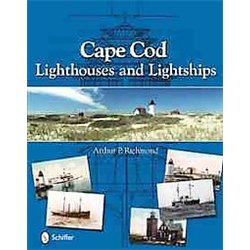 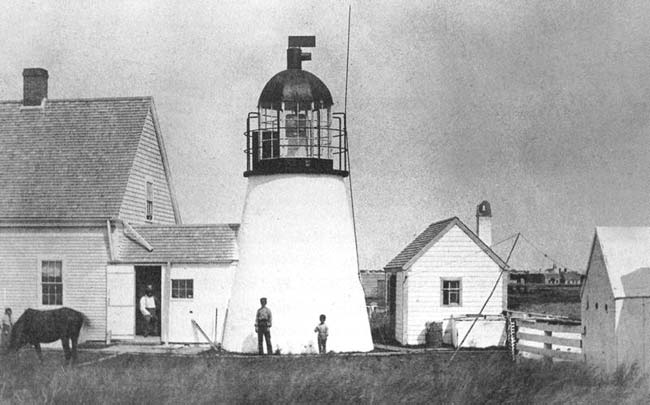
10426. Richmond, Arthur P. Cape
Cod Lighthouses and Lightships. Schiffer. 2010. 256p. Hard cover.
This is an indispensable reference for the lighthouse enthusiast, required
reading for those interested in maritime history, and a necessity for anyone who
loves Cape Cod. Step back in time and observe the lighthouses and lightships
that marked the shores and guided mariners through dangerous waters surrounding
Cape Cod. Experience these maritime marvels and trace through the history of
these lighthouses and lightships. Archived plans describe the details of these
aids to navigation with more than 500 images, including some that have never
before been published. Complete your journey with a visit to these historic
spots, using the books comprehensive visitors’ guide. “Cape Cod Lighthouses
and Lightships” is so thoroughly researched, so packed with individual
narratives and visuals, that it is one of the most comprehensive books on Cape
lighthouses to date. (M) $45. Our price $41.95.

10397. Collins, George M. To
Guide, Guard, and Rescue: Building the Yaquina Lighthouses, Jetties, and
Life-Saving Station. Newport. 2010. 112p. Soft wraps. An interesting
new book, actually four tales in one; Chapter One details the establishment of
the Yaquina Lighthouse on this site, which was short lived (only three years).
The lighthouse here later served as a U.S. Life Saving station. Chapter Two
details the construction of the more famous Yaquina Head Lighthouse. Chapter
Three discusses the construction of the Yaquina Bay jetties. Chapter Four
discusses the establishment and history of the U.S. Life Saving station at the
former lighthouse facility. Includes extensive information on the construction,
the keepers and men stationed there, the operation of the Light House
Establishment, shipwrecks in the area, and much more. Well illustrated with over
100 b/w photos, maps and illustrations. (M). Publisher’s price $21.95. Our
price $20.45.
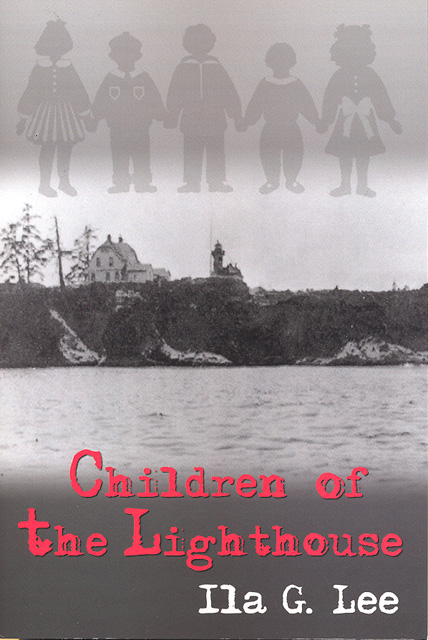
10395. Lee, Ila G., Children
of the Lighthouse. Bloomington. 2003. 125. Soft wraps. Children of
the Lighthouse preserves the unique experiences of the author, living at a
lighthouse during the Great Depression and Worls War II. The daughter of a
lighthouse keeper, Lee grew up along the Pacific coast, occupying with her
family different light stations in Oregon and Washington. Featuring
historical photographs and letters, this is a great opportunity to relive a
bygone era. Great reading. (M). $13.95.
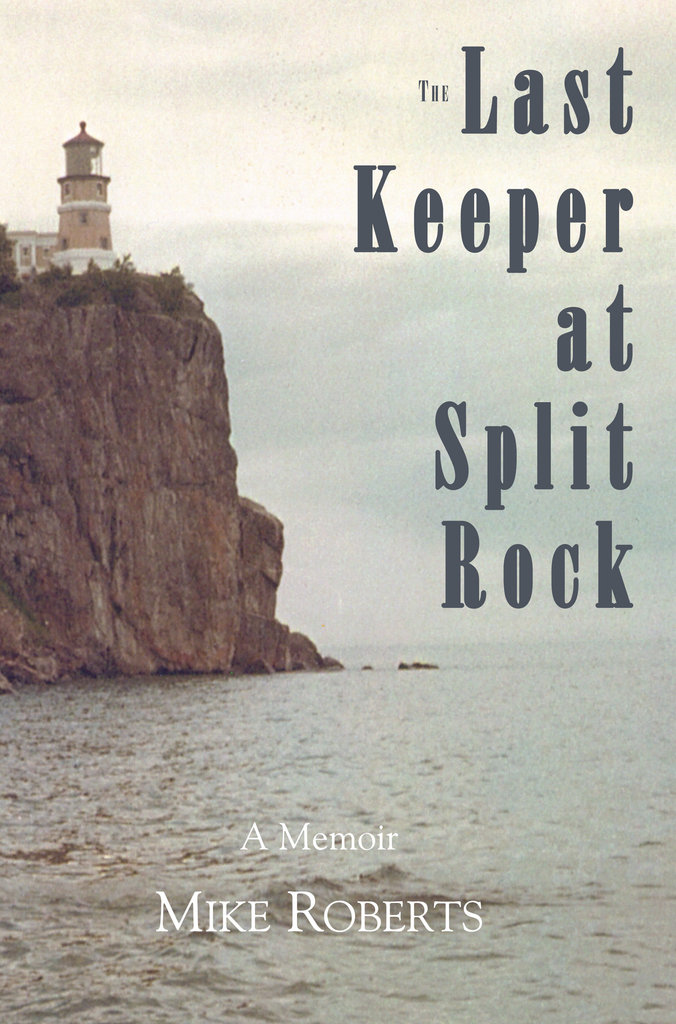
10343. Roberts, Mike. The
Last Keeper at Split Rock. St. Cloud. 2010. 180p. Soft wraps. Mike
Roberts was the last U.S. Coast Guard officer on duty at Split Rock Lighthouse,
the Minnesota tourist destination near Two Harbors that draws more than 100,000
visitors a year. The St. Cloud-area resident has the distinction of being the
person who extinguished the landmark's light for the last official time when it
was decommissioned in 1969 by the Coast Guard. Evolving technology had made the
landmark obsolete. More than 40 years later, Roberts returned to the lighthouse
to celebrate its 100th year. This book chronicles his four-year enlistment in
the U.S. Coast Guard from 1966-1970, most of which was spent on Lake Superior as
a search-and-rescue crew member and as a lighthouse keeper. He notes that
"There are tons of books written about lighthouse keepers, but very few
actually written by lighthouse keepers." Roberts began telling his life
stories to his children and grandchildren as they grew up and now he has
published them for us to enjoy. These are his stories of life at Split Rock, of
the great Superior, and of making ends meet on the North Shore. (M). $14.95.

2806. Cavallaro, Lenny and Lou Cook, Bob Jannoni. SOLVED:
The Mystery of the General Arnold. Carver. 2007. 112 p. Soft wraps.
In 1778, the brigantine General Arnold went aground on the White Flat off
Plymouth, Massachusetts. More than 70 men froze to death in one of the most
horrible naval disasters of the Revolutionary War. Almost two centuries later,
the skeletal remains emerged from the waters. Was this the Arnold? The debate
lasted for many years. Finally, in this work, the authors solve this mystery and
relate the tale of this stricken vessel. (M). $8.95.

10166. Harrison, Timothy and Walter C.
Plohocky, BMCS, USCG Ret., Thunder Bay Island
Lighthouse and Life Saving Station. Foghorn Pub. 2010. 32p. Soft
wraps. This new book tells 3 different stories of the life on the small island
of Thunder Bay near Alpena, Michigan. First is "A Season On Thunder
Bay Island" by former US Coast Guard lighthouse keeper Walter C. Plohocky,
telling of life on the island for one complete shipping season, March through
December. Also included is a history of the lighthouse and the story of Capt
John and Celia Persons, the Icons of Thunder Bay Island. Well illustrated with
historic photographs. Soft cover. (M). $8.95.
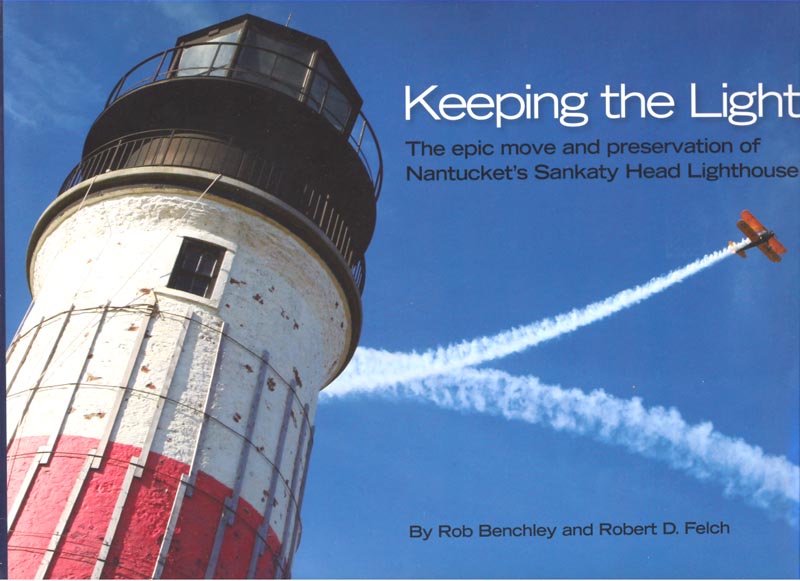
10115.
Benchley, Rob and Robert D. Felch. Keeping the Light
– The Epic Move and Preservation of Nantucket’s Sankaty Head Lighthouse.
2009. Sconset Trust. 144p. DJ. A lighthouse has stood on Sankaty Head near the
village
of
Siasconset
since 1850, the third such aid built on the island. However, in recent years
coastal erosion had brought the surf perilously close to the lighthouse,
threatening to topple it into the sea with a future gale. Fortunately the
’Sconset Trust took on the project to oversee the light’s restoration and to
raise funds to move the light tower safely away from the eroding cliffs. This
epic historic preservation project was successful due to a tremendous
island-wide outpouring of support. The new ’Sconset Trust book, Keeping the
Light, documenting this historic move, has just been released. Lavishly
illustrated with hundreds of photographs, the book chronicles the formation of a
plan, the move and the tower’s restoration, once again the famous
"Blazing Star". Beautifully done, this will make a superb addition to
anyone’s collection. (M). $98.

10180.
Thompson, Kalee. Deadliest Sea: The Untold Story Behind
the Greatest Rescue in Coast Guard History. New York. 2010. 309p. DJ.
Deadliest Sea by Kalee Thompson is the spellbinding true story of the greatest
rescue in U.S. Coast Guard history. It's no secret that commercial fishing on
the Bering Sea is easily one of the world's most dangerous and deadly
professions. For the men of the vessel 'Alaska Ranger', this fact presented
itself on March 23, 2008, when the ship began taking water only to be fully
submerged just a few hours later. In "Deadliest Sea," author Kalee
Thompson offers readers the harrowing account of the Ranger's accident, and the
daring rescue attempt by U.S. Coast Guard helicopter rescue teams which
succeeded in saving the lives of more than twenty of the crew members--thus
becoming the single most successful cold-water rescue in Coast Guard history. A
fascinating and gripping account for all. (M). Reduced $16.99.
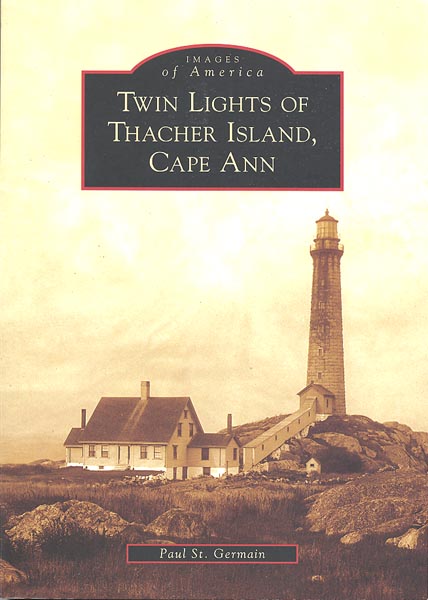
10121.
St. Germain, Paul. Twin Lights of Thacher Island, Cape
Ann. Arcadia. 2010. 128p. Soft wraps. 180 vintage photographs.
Thacher Island was named for Anthony Thacher who, in 1635, lost his four
children and other family members in a shipwreck during the most severe storm to
ever hit the Massachusetts coast. Some time later beacons were established on
the island to warn mariners away. In later times, the lighthouses there have
played an important role in several wars, including the Revolutionary War and
World Wars I and II, when the navy established a radio compass station and
lookouts to protect the coast from enemy submarines. A ship bearing a U.S.
president almost wrecked on Thacher Island, and the island was used as a witness
protection site for a Mafia criminal. Twin Lights of Thacher Island, Cape Ann
captures the history, adventures, and intimate stories from over 200 years of
lighthouse keepers living on the island, including how the two towers were built
and how scientific discoveries were applied to improve the lights over the
years. This interesting volume draws images from public and private collections,
most never before published. Superb photographs of the station, keepers,
equipment and more, well worth it. (M). $21.99. 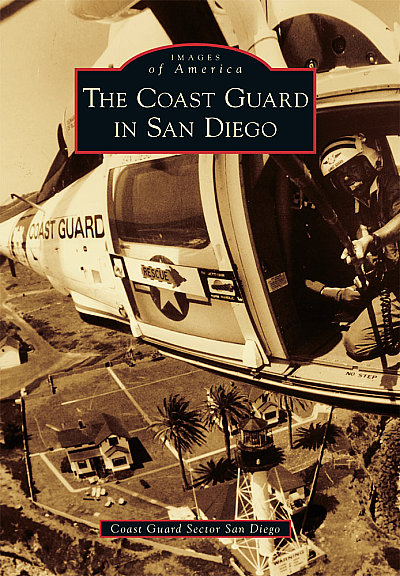
10122.
Coast Guard Sector San Diego. The
Coast Guard in San Diego. Arcadia. 2010. 128p. Soft wraps. 180
vintage and recent photographs. Located a few miles north from the border of the
United States and Mexico, the U.S. Coast Guard has maintained a continual
presence in San Diego since 1935. It was in May of that year that a single air
detachment, led by Cdr. Elmer F. Stone, began operating out of a commercial
hangar at Lindbergh Field. From those humble beginnings, a base was constructed
on 23 acres of tidelands adjacent to the airstrip and eventually formed into
Sector San Diego. Through the years, their units and missions have evolved as
new technology and changing world events dictated new missions for the Coast
Guard. Today Coast Guard Sector San Diego stands as a model of interagency
cooperation for the Department of Homeland Security as the Coast Guard works
with other federal agencies to protect San Diego's maritime domain. This
interesting volume draws images from the Coast Guard archives as well as public
and private collections, most never before published. Superb photographs of the
station, men, equipment and more, well worth it. (M). $21.99.
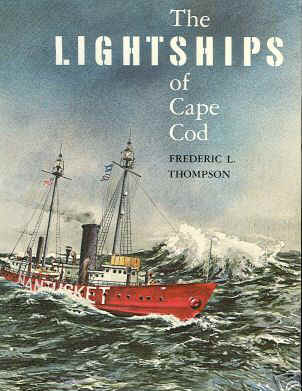
6697. Thompson,
Frederic L., THE LIGHTSHIPS OF CAPE COD.
1996. 2nd printing. 112 pp. Soft wraps. Signed by the author. Illustrated with over 93 beautifully
detailed photographs. Much sought after, this scarce volume chronicles the
history of the lightships in this vital area. Wonderfully detailed b/w
photographs enhance the author's vivid description of the history and life
aboard these vessels. One of the only volumes ever written exclusively on this
subject, this fine work will make a fine addition to any library (M). $14.95.
(Wholesale discounts available)
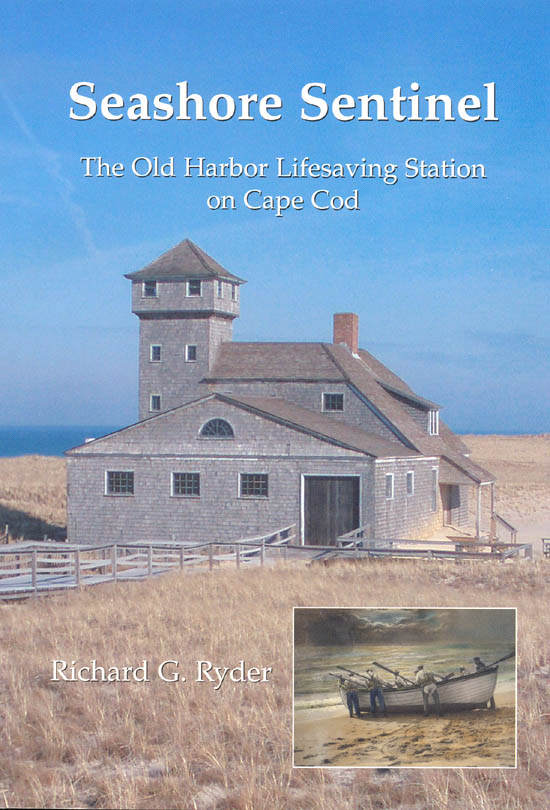
29313.
Ryder, Richard G. Seashore Sentinel: The Old Harbor
Lifesaving Station on Cape Cod. West Barnstable. 2009. 120p. Soft
wraps. This latest account of the history and life at Cape Cod’s Old Harbor
Life-Saving Station updates his older work -
OLD
HARBOR
STATION
CAPE
COD – now long out of print but still in demand. This extremely worthwhile
account of the life-savers at the Old Harbor Life Saving Station in
Chatham
, Mass., is a one of a kind, chronicling not only much of the wrecks and work of
the life savers, but particularly looking at the equipment issued to such a
station at the time and the lives of the men living and working there. Includes
many photographs, wreck accounts, life at the station, moving the station and
much more. A most interesting chronicle. (M). $12.95.
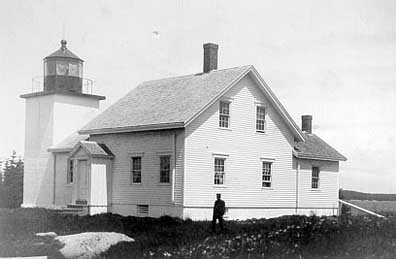
1002.
Crowell, Marnie Reed. Mark Island Light.
Sunset, Maine. 2009. 27p. Soft wraps. Mark Island Light, officially known as the
Deer Island Thorofare Lighthouse, was fitted with a fourth-order Fresnel lens
showing a fixed white light and was first lighted on New Year's Day in 1858. The
25-foot tower was attached to a one-and-one-half-story wood-frame keeper's
dwelling. In 1998, some 140 years after its light beamed for the first time,
Mark Island Light entered another chapter in it ownership when it passed into
the hands of Island Heritage Trust. To highlight the acquisition of the light,
the author has published a comprehensive and fascinating history of the light,
its keepers and operational details, as well as a record of the heroic keepers
who lived the isolated life we tend to romanticize today. Included in Crowell's
affectionate history are vintage and contemporary photographs and drawings and
excerpts from journals, letters and newspapers. (M). $13.95.

1007.
Maginley, Charles D. and Bernard Collin. The Ships of
Canada's Marine Services. Vanwell. 2001. 288p. DJ. With one of the
longest coastlines in the world and a significant inland waterway, Canada
possesses an unparalleled civilian fleet providing essential marine services.
This detailed work presents an illustrated record of the historical and
hard-working ships that have shaped their history and maritime heritage, current
to the year 2001. The ships included belong to the Canadian Coast Guard and its
predecessors, to the Customs Preventive Service, patrol vessels of the RCMP, and
the civilian-crewed vessels of the Canadian Naval Auxiliary Service. These ships
include hydrographic survey vessels, icebreakers, fisheries patrol boats, search
and rescue craft both station-based and offshore, lighthouse supply vessels and
buoy tenders, lightships, tugs, and northern exploration ships. Included are work
histories, specifications and photographs (some quite rare) or paintings of each
ship are given. Many ships are illustrated in rare old photographs digitally
enhanced for clarity, in sketches and paintings by talented marine artists, and
in a stunning 24-page colour section within the book. Ship histories have been
compiled from many sources, both published and obscure, to provide as complete a
record as possible. (M). $59.95.

1019.
Foster, Colonel Frank C. and Lawrence H. Borts. Military
Medals of the United States. Fountain Inn. 2010. 192p. Soft wraps.
Military Medals of the United States, here in its seventh edition, is an
authoritative reference work on the subject. Included are complete criteria for
every Army, Navy, Marines, Air Force, Coast Guard, and Merchant Marine award
since 1939. All decorations, service medals, and ribbons shown in b/w or
full-color and accompanied by dates and campaigns as well as detailed
descriptions on proper wear and display. The many illustrations make this book a
truly beautiful reference work. The book also contains detailed information
about the various devices worn on each ribbon, guides to the proper wear of
medals and ribbons on the uniform, and much more. There is even a special
section on United Nations mission medals. Included are: Criteria for all medals
listed in full detail with dates and campaigns; Superb front and back color
pictures of all U.S. Military decorations, service medals, marksmanship medals
and ribbons, plus commonly awarded foreign medals; Separate color ribbon display
in correct order of precedence for Army, Navy, Marine, Air Force, Coast Guard,
and Merchant Marine awards since 1939; Complete chapter on devices for awards
and ribbons – cross referenced with medals; Complete section on wear and
display of U.S. Military Medals for all branches; Valuable section on how to
claim your medals from the government. (M). $24.95.

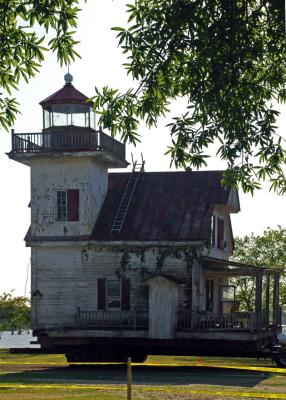
29371. Murphy, Mary. Preservation
Values in the United States: A Case Study of Three Lighthouses. Masters
Thesis. Texas Tech University. 2007. 142p. This study is an analysis of the
preservation values evident in three historic lighthouses: The Roanoke River
Lighthouse in Plymouth, North Carolina; the Old Plantation Flats Lighthouse in
Cape Charles, Virginia; and the Old Roanoke River Lighthouse in Edenton, North
Carolina. These three lighthouses are compared and analyzed according to the
preservation values set forth by Austrian historian Alois Riegl in his essay
"The Meaning of Monuments and Their Historical Development" and the
values implied in the Secretary of the Interior's Standards for the Treatment of
Historic Properties. This study serves four purposes: First, this study
establishes the relationship between Riegl's preservation theory and the current
preservation guidelines in the United States. Second, this study presents the
histories and current conditions of three related historic lighthouses together
in a single work. Third, this study makes a recommendation of treatment for the
Roanoke River Lighthouse in Edenton based on Riegl's preservation theory.
Fourth, this study concludes with a summary regarding the current state of
preservation theory in the United States, and of lighthouse preservation in
particular. Filled with photographs, drawings and illustrations. Worthwhile
reading, and an interesting source of reference for those interested in similar
restorations. Available in: High quality paperback ($124) spiral bound
($32) or as PDF on disc ($24).

29325.
Karentz, Varoujan. Beavertail Light Station on
Conanicut Island. Booksurge. 2008. 242p. Soft wraps. For over 250
years, America’s 3rd oldest lighthouse has stood as a sentinel at the entrance
of Rhode Island's Narragansett Bay. The author tells the story of technological
innovation and federal bureaucratic conflict as four different organizations,
beginning in 1749, attempt to improve operations and reliability of the light
station there. Woven into this history, the author follows the early slave trade
and Colonists who insisted that the lighthouse be built, and describes the work
ethics and reporting requirements of the generations of 'Keepers' who tended the
light. (M). $24.99

29411.
Osmers, Henry. On Eagle’s Beak - A History of the
Montauk Point Lighthouse. Outskirts Press. 2008. Soft wraps. 371p. A
history of Montauk Point Lighthouse has been long overdue! Henry Osmers fills
the void with a chronicle that is thorough and appealing. The author blends
scholarly research with supreme storytelling skills to chronicle this graceful
treasure perched atop Turtle Hill, at the eastern tip of Long Island. On Eagle's
Beak details many facets of the Montauk story, from the settlement of the
peninsula and construction of the light station, to the keepers who staffed it
until automation and its modern day operation as a museum. Especially noteworthy
is Osmers' coverage of Montauk Light's long struggle with erosion, a problem
facing many lighthouses in the nation. With more than 70 photographs,
illustrations and graphs, as well as scores of anecdotes culled from diaries,
newspapers and ledgers, “On Eagle’s Beak” is perfect for devoted
lighthouse aficionados and casual admirers alike. (M). $19.95.

29410.
Osmers, Henry. Living on the Edge - Life at the Montauk
Point Lighthouse 1930-1945. The story of the Montauk Point Lighthouse
is also a profoundly human one. Dozens of keepers and their families called the
lighthouse home over the years. Theirs was an often lonely existence, and Osmer
does justice to their experiences with two chapters detailing notable
keeperships under both civilian leadership and, later, Coast Guard
administration. Also sprinkled throughout are reflections of the lighthouse’s
numerous visitors over the years – notably an 1861 visit to the Point by Walt
Whitman, who wrote a laudatory poem on Montauk, from which the book takes its
title. Modernization in recent times ended the era of the lighthouse keeper, and
the Montauk Point Lighthouse, now automated, became a museum in 1987. (M).
$19.95.

29324.
Weymouth, Kent. Lighthouses of the Golden State –
California’s Shining Beacons. Sacramento. 2008. 200p. Soft wraps.
With a population of about 200 people Yerba Buena was a sleepy little town in
1846. The following year, Yerba Buena would become San Francisco. With the
discovery of gold at Sutter's mill by James Marshall in 1848, a rush to
California began that would swell the population of San Francisco to more than
36 thousand by 1850. Risking their lives for the promise of fortune, men
traveled from all over the world to this new prosperous land, at a time when the
coast of California and the waters surrounding it were unexplored, dangerous and
unprotected. Magnificent structures would rise in the decades to follow, built
by brave and adventurous souls. At these isolated outposts, hearty individuals
were stationed as light-keepers to protect the ships bringing commerce, supplies
and the peoples that would build the west. Step back in time to an era of
adventure, hardship, loneliness and isolation, when lighthouses rose on the
shores of the Golden State. Exhaustively researched and thus thoroughly
informative, Lighthouses of the Golden State offers up a truly complete and
detailed history of the construction, purpose, and current condition of the
towering structures. Weymouth covers the individual history of dozens of
lighthouses, and extensively specifies the reason that each particular
lighthouse was built, what the operating procedures for each were, and general
points of information and interest about them. Well illustrated. (M).
$19.95.
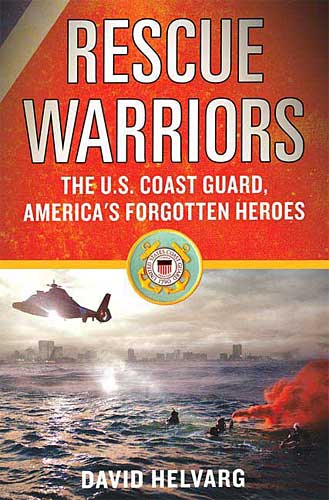
29310. Helvarg, David. Rescue
Warriors: The U.S. Coast Guard, America's Forgotten Heroes. Thomas
Dunne Books. 2009. 356p. DJ. The men and women of the Coast Guard are the
forgotten heroes of the armed services, writes journalist David Helvarg. Since
its founding more than two hundred years ago, the United States Coast Guard has
rescued over a million people. On any given day, “Coasties” respond to 125
distress calls and save over a dozen lives. Yet despite having more than 50,000
active-duty and reserve members on every ocean and on our nation’s coasts,
great lakes, and rivers, most of us know very little about this often neglected
but crucial branch of the military. In Rescue Warriors, award-winning journalist
David Helvarg brings us into the daily lives of Coasties, filled with a salty
maritime mix of altruism and adrenaline, as well as dozens of death-defying
rescues at sea and on hurricane-ravaged shores. The definitive book on
America’s “forgotten heroes.” (M). $25.95

29303.
Meininger, William F. Recollections of Thirty-Two Years
in the U.S. Coast Guard, and Other Ramblings. Authorhouse. 2008.
383p. Soft wraps. Mr. Meininger was born and raised in the Midwest and joined
the Coast Guard in 1961. He served on several ships in both the north Atlantic
and south Pacific. Returning from overseas in 1965, he was assigned to a small
boat rescue station and later a patrol boat. He attended Officers Candidate
School in 1970 and completed naval flight training receiving his wings in 1971.
He then served as a search and rescue pilot at Cape May, NJ; Kodiak, AK;
Clearwater, FL; Astoria, OR and Detroit, MI. He spent his last five years as a
staff officer assigned to Coast Guard Headquarters in Washington, DC. retiring
after thirty-two years of service in 1993. The author notes that “this is a
collection of humorous stories I recall from my time in the service, and shortly
thereafter. It is my nature to poke fun at things I find funny, or in some
cases, sad. Most, almost all, of these recollections are accurate.” Wonderful
account of the author’s thirty two year career in the Coast Guard, well
written, funny, a treat to read. (M). $19.95.

29261.
Borch, Fred L. and Charles P. McDowell. Sea Service
Medals – Military Awards and Decorations of the Navy, Marine Corps and Coast
Guard. Annapolis. 2009. 184p. DJ. Sea Service Medals is the first and
only complete historical examination of all the personal awards, decorations and
medals that may be awarded to Navy, Marine Corps and Coast Guard personnel for
heroism, achievement and service. As a comprehensive history of all awards and
decorations of the United States' three sea services, this book serves as a
valuable guide to the rich traditions of the Navy, Marine Corps and Coast Guard.
It provides little-known historical information on the background and
development of each award and decoration, along with details of its design and
award criteria. The decorations examined include well-known awards for combat
heroism such as the Navy Medal of Honor, the Navy Cross, and the Silver Star.
Non-combat heroism awards such as the Navy and Marine Corps Medal and Coast
Guard Medal are also discussed. All decorations and medals for achievement and
service are examined, ranging from the Navy and Coast Guard Distinguished
Service Medals, the Legion of Merit, and the Meritorious Service Medal to the
Navy and Marine Corps Commendation Medal, Coast Guard Achievement Medal, and
Combat Action Ribbon. Fifty full color photographs of sea service awards,
including illustrations of never-before-published rare Navy Medals of Honor,
provide context for this unique history. (M). $34.95. Our Price $31.46.
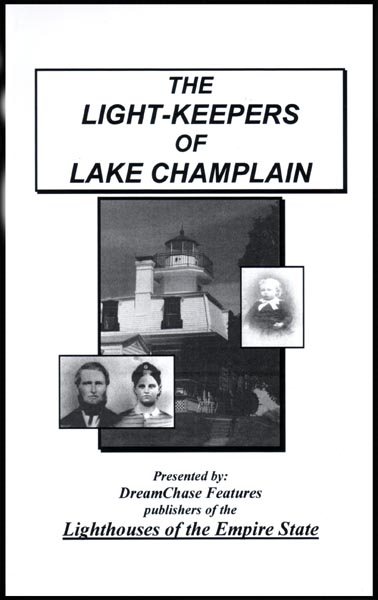
29307.
Cook, David E. The Light-Keepers of Lake Champlain. Mayfield.
2009. 232p. Soft wraps. A biographical anthology of at least 146 men and women
who maintained the light stations of Lake Champlain before they were all
automated, this detailed work is filled with lots of great historical and family
history of lighthouse keeping on Lake Champlain's New York and Vermont
shorelines. Includes a listing both chronologically and an alphabetical of the
lighthouse keepers. In addition to listings of the many keepers over the years,
includes a biography of each, stations served and great information about the
station and his activities and occurrences there. Illustrated with photos when
available. Packed full of information. (M). $16.95.
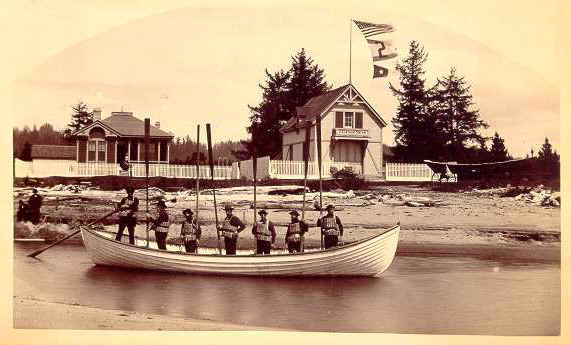

28348.
Wilkinson, William D. and CDR Timothy R. Dring, USNR (Retired). American
Coastal Rescue Craft - A Design History Of Coastal Rescue Craft Used By The
United States Life-Saving Service And The United States Coast Guard. University
Press. 2009. 185p. Unjacketed cloth. With CD-ROM with 323 b/w illustrations.
Long awaited, this exhaustive reference work describes detailed history and
technical design information on every type of rescue craft ever used by the U.S.
Life Saving Service (USLSS) and the U.S. Coast Guard (USCG) from the 1800s to
current day. By looking at these vessels, many of which featured innovative
designs, the authors shed light on the brave men and women who served in these
heroic services. The first of its kind ever to be published in the United States
on this topic, the book and accompanying CD provide detailed information,
drawings, and photographs (many of which have never before appeared in print)
for each type of surfboat, lifeboat, and utility craft, along with a complete
list of every boat ever built and assigned coastal rescue station(s). Included
are motorized, wind-powered and human-powered vessels. The book is organized
into two major sections: 1) a general, historical narrative, and 2) detailed
technical appendices. This college text-sized book is 185 pages in length, with
about 140 photos and diagrams. In addition, a reference/appendix section on a
co-packaged CD will include 323 additional photos and diagrams. The book is
co-authored by William D. Wilkinson, Director Emeritus of the
Mariners
Museum
in
Newport News
,
VA
, and CDR Timothy R. Dring, USNR (Retired). Mr. Wilkinson has been engaged since
the 1950s in the historical research of small craft used for rescue purposes,
and is a well-recognized expert in this field. He is currently an official
historical consultant to the USCG on this subject. CDR Dring, although not a
professional historian, has had previous experience in the Navy working closely
with the Coast Guard on harbor and coastal defense, and has a great interest in
and respect for the humanitarian rescue operations this Service conducts with
specialized small craft. The extensive research that went into this book,
including reference to original USLSS and USCG documents held by the National
Archives, has had the full support of the USCG’s Historian, Dr. Robert
Browning, and his staff. The most comprehensive work on Coastal Rescue Craft
used by the United States Life-Saving Service and the United States Coast Guard
ever published. (M). $125. Order
now as only a limited number have been printed.
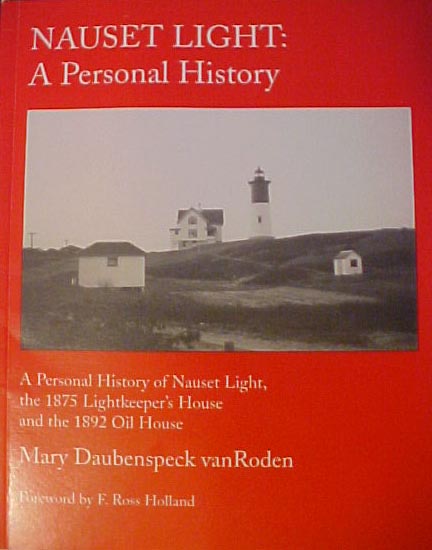
6281. vanRoden, Mary. Nauset
Light, A Personal History - the1875 Lightkeeper’s House and the1892 Oil
House.
Lyme
,
NH
. 1995. 82pp. Soft wraps. This wonderful book by the recent owner of the
Keepers Quarters at Cape Cod’s Nauset Light Station presents a personal
and detailed look at life at this exposed location, as well as the action
of the sea and efforts to preserve the buildings. Illustrated with
wonderful detailed historical photographs, drawings and more - wonderful
reading. (M) $19.95.

25237.
Quinn, William P., SHIPWRECKS ALONG THE
ATLANTIC
COAST
– A Remarkable Collection of Photographs of Maritime Accidents from
Maine
to
Florida
.
Beverly
. 2004. DJ. 244p. Illustrated with over 260 photographs. News photographer Bill
Quinn has been taking and collecting photographs of shipwrecks since he filmed
the sinking of the Andrea Doria in 1956. For nearly half a century he has added
to his remarkable archive, and his books represent some of the largest
collections of shipwreck images in print. First published in 1988 and long out
of print, Shipwrecks Along The Atlantic Coast has been reedited and redesigned
for this new edition. The waters along the
Atlantic
Coast
have claimed thousands of ships over the years. In this classic work, noted
news photographer, historian and author Bill Quinn features hundreds of
photographs of schooners and square riggers stranded, from the 1870’s to the
1980’s, from rock bound
Maine
down past the sandy shores of Cape Cod, through the sounds of
Sandy Hook
,
New Jersey
and on down the coast to
Florida
. With detailed text, the author describes numerous wrecks and the work of the
Life-Saving Service and Coast Guard over the years. Notable wrecks Include the
loss of the General Slocum, the City of
Worcester
, the Andria Doria, Normandie fire, Amerique fire, wrecks on the many sandy
capes on the coast, Diamond Shoal Light Vessel No. 69, and many more.
Exceptional vintage photographs and riveting reading. (M). $29.95 Our Price
$21.95. 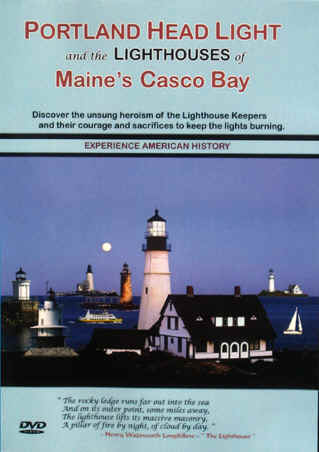 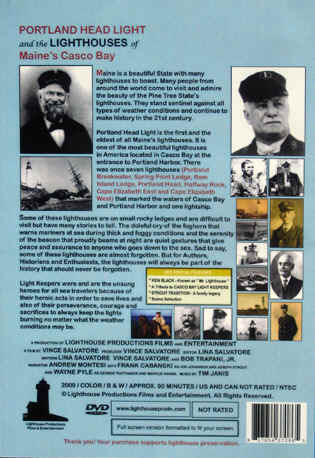
29231.
(DVD) Portland Head Light and the Lighthouses of
Maine's Casco Bay. Portland Head Light is the first and the oldest of
all Maine's lighthouses, located in Casco Bay at the entrance of Portland
Harbor. There was once seven lighthouses (Portland Breakwater, Spring Point
Ledge, Ram Island Ledge, Halfway Rock, Portland Head, Cape Elizabeth East and
Cape Elizabeth West) and one lightship that marked the waters of Casco Bay and
Portland Harbor. Learn the stories surrounding the keepers and their
descendants, their hardships and the lives that they led. (M). $19.95. 
29205.
Hawley, Jonathan P. Point Betsie - Lightkeeping and
Lifesaving on
Northeastern Lake Michigan
.
Ann Arbor
. 2008. 250p. Soft wraps. 61 b&w photographs. Point Betsie: Lightkeeping and
Lifesaving on Northeastern Lake Michigan is the compelling story of a key
Great Lakes
lighthouse whose beam has pierced night skies for 150 years. This rich history
recounts the efforts of the U.S. Lighthouse Service, the U.S. Life-Saving
Service, and the U.S. Coast Guard on
Lake Michigan
's wreck-strewn northeastern coast, near the treacherous Manitou Passage. Much
of Point Betsie's story is told in the accounts of dedicated keepers who served
there with their families since 1858. Photographs also chronicle the
lighthouse's expanding services through the years and the site's transition from
early isolation to today's frequently visited attraction on
Lake Michigan
's northeastern shore. The author devotes equal attention to the courageous
lifesaving crews that served mariners off Point Betsie from 1877 to 1937.
Keepers' logs bring to life the heroic rescues from wrecks that surfmen
discovered while conducting their lonely night-time beach patrols, and document
Point Betsie's central but previously untold role in the area's important
maritime and social history. An illustrated, thoroughly researched history of
dedicated lightkeeping and courageous lifesaving at
Lake Michigan
's famed Point Betsie. (M). $29.95.
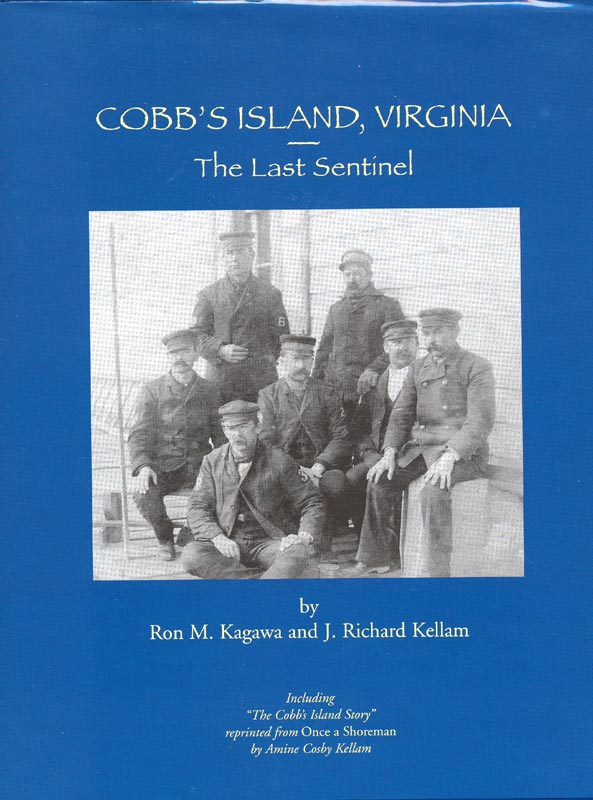
2986. Kagawa, Ron M. and J. Richard
Kellam. Cobb's Island, Virginia : The Last Sentinel. Virginia
Beach. 2003. 128 p. DJ. This one is definitely a sleeper – once I picked it up
I was unable to put it down. Cobb's Island, Virginia: The Last Sentinel,
co-written by Associate Professor of Landscape Architecture Ron Kagawa and J.
Richard Kellam, charts the history of the now-barren Virginia barrier island
that was once a flourishing hunting and fishing resort and home to the first
U.S. Life Saving Service facility there. However, 99% of the history there
relates directly to the Life Saving Service and early Coast Guard there. From
cover to cover, the authors trace the work of the life-savers on the island, and
particularly the history of the 1875-76 life-saving station and later Coast
Guard stations there, their modifications over the years and finally
moving of the Coast Guard station in its entirety to the mainland between
1997-2001. The book is chock full of vintage photographs, architectural plans
and much more. Well worth a place in your library. The book is now out of print
but we have been able to obtain a quantity of copies, new, never opened. (M).
$38.95

29173. Chance, Toby and Peter
Williams. Lighthouses – The Race to Illuminate the
World. London. 2008. 272p. DJ. Illustrated. Written by Toby Chance,
James Chance's great-great-grandson and grandson of Sir Hugh Chance, the last
Chairman of an independent Chance Brothers, Lighthouses attempts to fill the gap
in lighthouse history concerning the development of illumination technology
during the 19th and early 20th centuries. The main characters are James Chance,
who started the lighthouse department at the firm founded by his uncle Lucas
Chance in 1822; and Sir David Brewster, a radical Scottish optical scientist
whose entreaties to the British establishment to take the lighthouse question
seriously from the 1820s were largely ignored until a Royal Commission on
lighthouse reported in 1861. During this time Britain lost its lead in
lighthouse technology to the French, mainly due to the invention in 1819 of what
has come to be known as the Fresnel lens, named after its inventor Augustin
Fresnel. Fresnel, like Brewster, was an optical physicist but unlike Brewster
was entrenched in the French scientific establishment and was hired by the
Astronomer Royal to head up the French lighthouse service's investigations into
improved methods of lighthouse illumination. The true-life story that follows is
of one man and his family's unexpected role in an exciting race to perfect this
technology, against European rivals and colleagues, as they strive to regain for
Britain the leadership position she had lost to the French in the 1820s. A must
for serious lighthouse enthusiasts. (M). $26.99
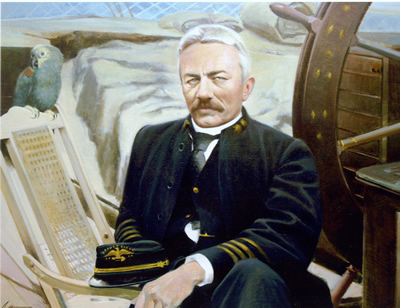
29199.
Noble, Dennis L. and Truman R. Strobridge. Captain
“Hell Roaring" Mike Healy - From American Slave to Arctic Hero. Gainsville.
2009. 352p. DJ. Captain “HeLL Roaring" Mike HeaLy remains One of the
Coast Guard's great heroes. In the late 1880s, many lives in northern and
western maritime Alaska rested in the capable hands of Michael A. Healy
(1839-1904), through his service to the U.S. Revenue Cutter Service. Healy
arrested lawbreakers, put down mutinies aboard merchant ships, fought the
smuggling of illegal liquor and firearms, rescued shipwrecked sailors from a
harsh and unforgiving environment, brought medical aid to isolated villages,
prevented the wholesale slaughter of marine wildlife, and explored unknown
waters and lands. Captain Healy's dramatic feats in the far north were so widely
reported that a New York newspaper once declared him the "most famous man
in America:' But Healy hid a secret that contributed to his legacy as a lonely,
tragic figure. In 1896, Healy was brought to trial on charges ranging from
conduct unbecoming an officer to endangerment of his vessel for reason of
intoxication. As punishment, he was put ashore on half pay with no command and
dropped to the bottom of the Captain's list. Eventually, he again rose to his
former high position in the service by the time of his death in 1904.
Sixty-seven years later, in 1971, the U.S. Coast Guard learned that Healy was
born a slave in Georgia who ran away to sea at age fifteen and spent the rest of
his life passing for white. This is the rare biography that encompasses both sea
adventure and the height of human achievement against all odds. (M). $34.95
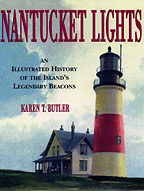
29201. Butler, Karen. Nantucket
Lights: An Illustrated History of the Island’s Legendary Beacons. Nantucket.
1996. (151 pp. / 148 illus.) DJ. Lavishly illustrated, Nantucket Lights tells
the story of the island’s lighthouses and lightships and the men and women who
faithfully kept them. This is one of the most comprehensive and attractive books
ever done on the lighthouses of Nantucket. Dazzling images including fascinating
historic illustrations as well as recent photographs and paintings, and a
carefully researched text illuminate an important aspect of Nantucket’s
maritime past. Nantucket's three lighthouses all have fascinating history --
little Brant Point Light, which has been rebuilt more than any other American
lighthouse; remote Great Point Light, completely destroyed in a storm in 1984
but rebuilt only two years later; and Sankaty Head Light, the famous
"Blazing Star." There's also an excellent chapter on the Nantucket
Lightship. Even if you've never been to the "Far Away Island," this
book is a must. (M). $24.95.
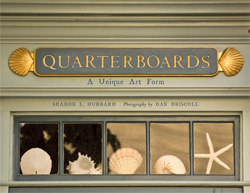
29202. Hubbard, Sharon, with
photography by Dan Driscoll. Quarterboards: A Unique
Art Form. Nantucket. 2008. 100p. DJ. Quarterboards explores the
tradition on Nantucket of naming homes and adorning them with the type of
stunning signs found on ships. ‘Sconset’s 1680 house Shanunga, for example,
takes its name from the quarter board salvaged from the wreck of a schooner in
1852. Lavishly illustrated with striking photography throughout, capturing the
unique charm of Nantucket’s historic homes, bringing the deftly woven
narrative filled with colorful characters and fascinating anecdotes to life.
(M). Published at $39.95. Our price $36.95.

29203. Philbrick, Nathaniel. Away
Off Shore: Nantucket Island and Its People, 1602-1890. Nantucket.
1993. 273p. Soft wraps. This local best-seller focuses on the real people –
great and obscure, famous and infamous – behind the island at the center of a
whaling empire. “For everyone who loves Nantucket, this is the indispensable
book.” (M). $19.95.

29200. na. Cornfield
Point Light Vessel LV-51 – A Connecticut State Archaeological Preserve. Published
for the Connecticut State Historical Preservation Office by Historical
Perspectives, Inc. c.2006. 24p. Soft wraps. Quite a nice publication, Details
the history of Light Vessel No. 51 including her recent discovery in Long Island
Sound off Old Saybrook. After serving for 27 years, on April 14, 1919 she was
rammed by an oil barge and sank within eight minutes. The crew disembarked to
the lifeboat and were picked up by a tug. Booklet includes chapters on lightship
history, design and technology, LV No. 51, Life on board, Reminiscences of a
retired light vessel crewman, Sister ships, The sinking of light vessel No. 51,
Underwater survey of the wreck, and more. Thoroughly illustrated. Well done.
(M). $12.95.
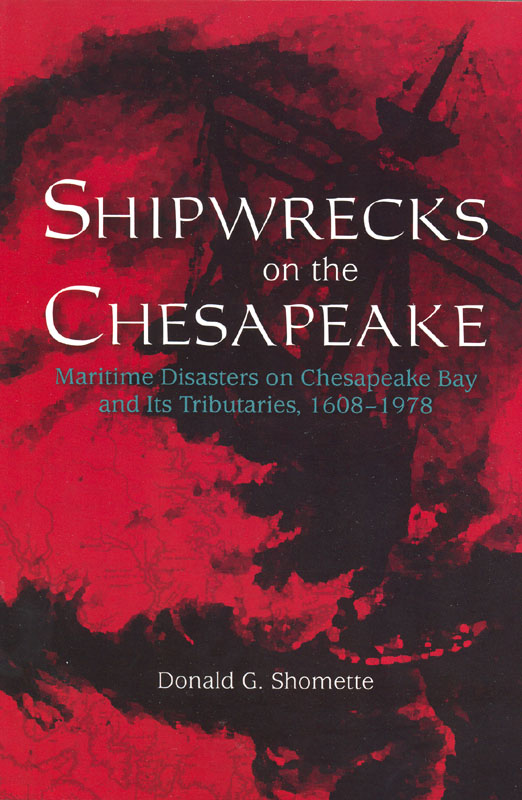
4571. Shomette, Donald G., SHIPWRECKS
ON THE
CHESAPEAKE
- Maritime Disasters on
Chesapeake Bay
and its Tributaries 1608-1978. Tidewater. 1982. 324pp. 7th
printing. 2007. 324 p. DJ. Fascinating, detailed accounts of the wrecks and
rescues of the area, full of information and stories that will fascinate any
reader interested in the Chesapeake and her ships as well as maritime history in
general. Covers the 370 year period from the 1600’s to date. Illustrated. With
large chronological index of vessels lost in the area. (M) $19.95.
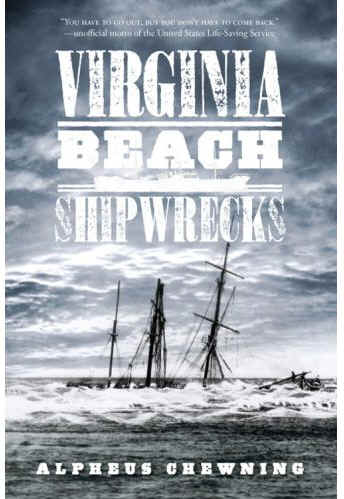
29105. Chewning, Alpheus. Virginia
Beach Shipwrecks. 2008. History Press. Soft wraps. 128p. 40 b/w
photos. The waters of coastal Virginia swirl with tales both tragic and heroic.
Join Virginia Beach native Alpheus Chewning as he recounts harrowing stories of
storms at sea, loss of life and fortune and the heroism of the United States
Life-Saving Service. Marvel at the blunders and bungles that have plagued the
Chesapeake Bay Bridge Tunnel and learn about the U-boats that lurked off the
coast during World War II. Extensively researched and filled with fascinating
details, "Virginia Beach Shipwrecks" is a treasure for sea lovers of
all ages. (M). $19.99.


29190.
Eldridge, Dana. Once Upon Cape Cod; From Cockle Cove to
the Powder Hole. Brewster. 1997. 112p. Soft wraps. A group of essays
describing Dana Eldridge's early years on Cape Cod in the 30’s – so very
different from today’s Cape. Written with humor and warmth, this is a must
read for anyone with a love of all things Cape. This is a book of essays where
time stands still, the way it should. His boyhood adventures remind you of
Huckleberry Finn and Tom Sawyer. He had loving, laconic parents, and perfect
grandparents. The whole watery world of Cape Cod was full of freedom and
adventure for a boy. Here is the classic theme of local, small town life before
we began to run away from it. (M). $10.95. 9191.
Eldridge, Dana. Cape Cod Lucky - In Another Time.
Brewster. 2000. 170p. Soft wraps. This sequel to Once Upon Cape Cod
treats the reader to more insights and antics of growing up on Cape Cod. Dana
Eldridge's unique prose brings us back to a time when young people explored and
played with a freedom we rarely see today. This is a story of growing up on the
Cape in the mid 40’s and 50’s – one of the last remnants of the unhurried
life of the nineteenth century. That Cape is gone now, but Eldridge brings it
vividly to life. You’ll smell the salt wind, you’ll hear the surf roaring on
the bar, and you’ll laugh out loud at the wonderfully wry stories that fill
this book. (M). $12.95. 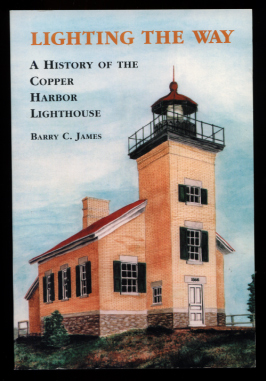
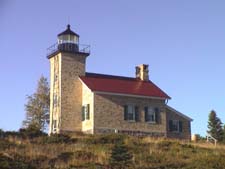
29163.
James, Barry C. Lighting the Way - A History of the
Copper Harbor Lighthouse. Copper Harbor. 2000. 128p. Soft wraps.
Action providing improved navigational aids at Copper Harbor followed closely
upon the Keweenaw copper rush. The shipwreck of the John Jacob Astor in 1844 and
rapidly expanding Lake Superior shipping traffic influenced President Polk and
Congress to authorize construction of the Copper Harbor Lighthouse in 1847. For
$4,800, Charles Rude built the original 65-foot-tall split stone, whitewashed
tower on Hays Point between 1848-1849 about of the steel tower. A new lighthouse
was built in 1866, incorporating the light towers and keeper’s dwelling in the
same building. The present 62-foot steel tower was erected in 1933, with the
light being converted to electricity in 1937. Detailed history includes all
aspects of the operation of the station with a great deal on the work and life
of the keepers there. Well illustrated with vintage photos. (M). 16.95. 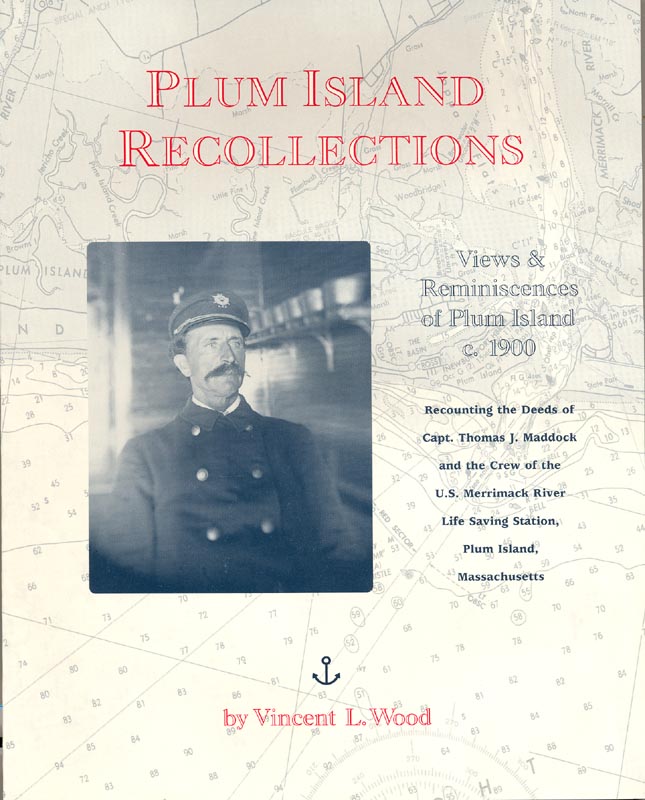
6641.
Wood, Vincent L., PLUM ISLAND RECOLLECTIONS - Views and
Reminiscences of Plum Island c.1900 Recounting the Deeds of Capt. Thomas J.
Maddock and the Crew of the U. S. Merrimack River Life-Saving Station, Plum
Island, Massachusetts.
Newburyport
. 1995. 81p. Soft wraps. Signed by the author. Whatever your interest, you are sure to enjoy this
readable account of every day life at a station of the U. S. Life-Saving
Service. This wonderful account of life as Keeper of the Merrimack River
Life-Saving Station brings together over 80 never before published vintage
photographs made from the family’s archives of glass plate negatives. Taken by
Mr. Wood’s grandfather, these negatives provide unusually clear, crisp views
which have been faithfully reproduced in a high quality format. Using these
views, along with personal notes and family memories, Mr. Wood presents a rare
portrait of station life and training in 1910. This interesting account is only
available here and is priced unusually low considering the rare accounts and
quality photographs, well worth the retail price. A wonderful addition to your
library. (M). $19.95. 
2998.
Harrison, Timothy E. Lighthouses of Bar Harbor and the
Acadia Region. Arcadia. 2009. 128p. Soft wraps. 180 vintage
photographs. With the exception of Mount Desert Island’s Bass Harbor Head
Lighthouse, the lighthouses of Bar Harbor and the Acadia region are among the
most remote and lesser-known lighthouses of Maine. As the vessel traffic changed
in these areas in the early 1900s, some of these lighthouses were sold into
private ownership while others became less important as aids to navigation.
Since the structures were located on remote islands or in a highly restricted
military installation, the photographs and historical firsthand memories of most
of these lighthouses have remained elusive and seemingly lost in the dusty pages
of time. Through vintage photographs, Lighthouses of Bar Harbor and the Acadia
Region uncovers the history of these structures that kept watch over Maine’s
rocky coast. Superb photographs of the stations, keepers, equipment and
more, well worth it. (M). $21.99. 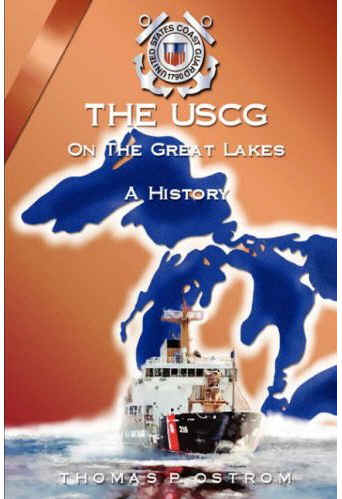
29109.
Ostrom, Thomas P. The United States Coast Guard on the
Great Lakes - A History. Elderberry Press. 2007. Soft wraps. 223p.
The United States Coast Guard traces its origins to 1790, but was not officially
named until 1915. At last there is one definitive volume, though a bit crude,
describing its history on The Great Lakes from inception to the present. The
author, Thomas P. Ostrom, served in the U.S.C.G.R. from 1961-69, and had basic
and advanced training at the U.S.C.G. Base, Alameda, California. He served
subsequently in the Port Security Reserve Unit in Duluth, Minnesota, and
participated in monthly and active duty assignments each summer, earning petty
officer rank. Chapters include: A Brief Coast Guard History (1790 to 2006),
Predecessors on the Great Lakes (1790-1915), The Coast Guard Emerges
(1915-1939), World War II to the Present (1945 to 2006), Station Duluth (1866 to
2006), The U.S.C.G. Reserve and Auxiliary, Aids to Navigation, Great Lakes Light
Stations, Great Lakes Ice Breakers, Buoy Tenders on the Lakes, Life Saving,
Environmental Protection, Law Enforcement, Port Security, National Defense, and
Commerce, An Overview of the Ninth Coast Guard District, Coast Guard Command
Leadership, and more. (M). $19.95. 
29142.
Holmes, Richard. RHODE ISLAND LIGHTHOUSES – A
Pictorial History. 2008. 212p. Soft wraps. A complete pictorial guide
of the past and present
Rhode Island
light stations, with vintage photographs, prints and postcard views and a brief
history and description of each. With hundreds of illustrations. (M). $24.95. 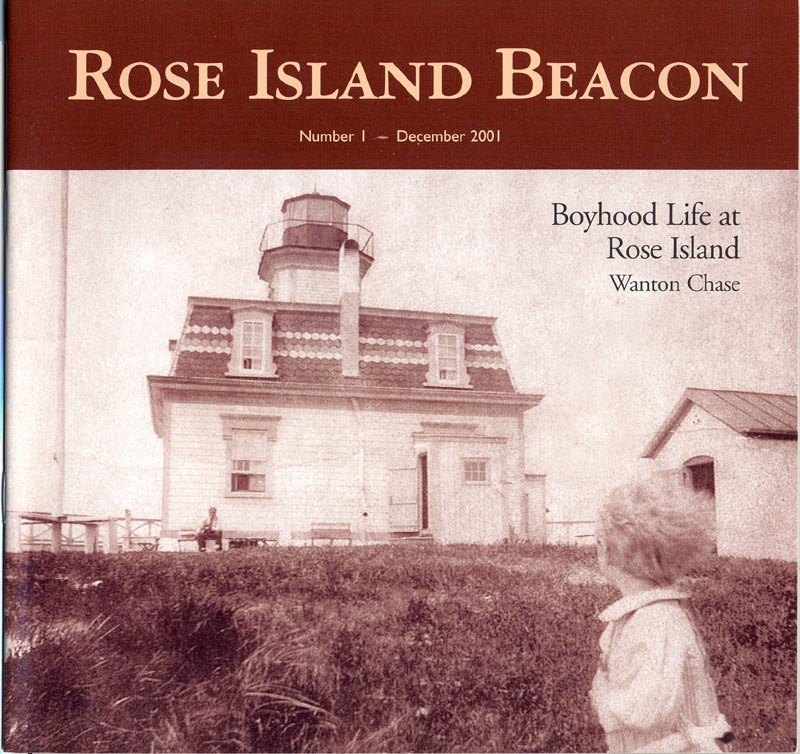
2946.
Chase, Wanton. Boyhood Life at Rose Island [Lighthouse].
Rose Island Beacon. Rose Island Lighthouse Foundation. Number 1. December 2001.
26p. Soft wraps. Wonderful out of print booklet recalling the boyhood life at
Rose Island Lighthouse by Wanton Chase, who passed away this past December at 99
years of age. This high gloss page booklet details his memories of life growing
up at the lighthouse in the early 1900s. Because he was a “sickly baby” he
was sent to live at the Rose Island lighthouse with his grandparents from 1910
to 1918. Wonderful reading. (M). $9.95. 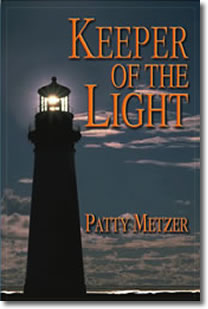
2984.
Metzer, Patty. Keeper of the Light. Focus
Pub., Bemidji. 1997. 2nd. 368p. Soft wraps. Colin McRae seems to have found his
life's fulfillment in his position as keeper at Highland Lighthouse in North
Truro on Cape Cod. His life changes when he must travel into Provincetown to
find a housekeeper and companion for his ailing sister. The only person
available is a young, mysterious girl who is thought of as the town 'dummy'
because she is mute. Life at Highland Light would never be the same. A story
with strong characterization, unpredictable plot and an intriguing 1797 Cape Cod
setting. Readers will not be disappointed. (M). $12.95. 
2097.
Egan, Leona Rust. PROVINCETOWN AS A STAGE.
Parnassus, Orleans. 1994. 296p. DJ. In 1916 this remote fishing village
extending 25 miles into the Atlantic was teeming with unprecedented numbers of
tourists; there were battleships from Teddy Roosevelt’s Great White Fleet in
the harbor, and a significant segment of Greenwich Village’s Avant-Garde was
there. By all contemporary accounts, never before in America had so many people
who wrote, painted, or acted been thrown together in one small place. Of great
significance to American theatre was a young struggling playwright named Eugene
O’Neill, who settled in the old Peaked Hill Bars Life-Saving Station, where he
remained for nine years that was to culminate in a Nobel Prize. O’Neil’s
life in Provincetown, in the station and his career are the focus of this
interesting book. (M).
$14.95. 
2936.
Halperin, James L. and Gregory J. Rohan. The
Collector’s Handbook – Tax Planning, Strategy, and Estate Advise from
Collectibles Experts for Collectors and their Heirs. Dallas. 2008.
4th. 120p. Soft wraps. The Collector’s Handbook is a step-by-step guide to tax
and estate planning for collectors. From record keeping to disposition methods,
this handy primer cuts right to the chase on every topic. It is mostly written
to the active collector, but pertinent chapters also have “Tips for Heirs”
sections to aid non-collectors in avoiding common pitfalls when inheriting a
collection (and once you've read this book, its convenient size makes it perfect
for inclusion alongside your collection in a bank vault or safe deposit box).
Whatever your motivations in collecting, this book will help make you a more
intelligent collector. Nearly every collection involves making reasonable
financial decisions; doing so repeatedly will improve the monetary value you or
your heirs ultimately reap from your collecting endeavors, as well as increase
your satisfaction. Making your hobby more productive and rewarding is easiest
done while you are actively pursuing these pieces of history. This booklet is
written by three owners of Heritage Coin, the world’s largest and most
respected rare coin dealer and auctioneer, and offers sound advice and the
experience gained from billions of dollars in collectible transactions over four
decades. Chapters include record keeping, caring for your collection,
safeguarding your collection, tax options for estate planning, charitable
giving, art attribution and authentication, having your collection appraised,
selling your collection, insurance companies offering collectible coverage, and
more. A wealth of sound and practical information, written in a clear and
concise manner. Must reading for every serious collector! (M). $16.95.


2908.
Hanable, William S. Lighthouses and Lifesaving on
Washington's Outer Coast. Arcadia. 2008. 128p. Soft wraps. 180
vintage photographs. Washington’s storm-ridden outer coast stretches from Cape
Disappointment, at the mouth of the Columbia River, to Cape Flattery, at the
entrance to the Strait of Juan de Fuca, a distance of about 150 miles.
Historians have labeled these waters “the Graveyard of the Pacific” and
“the Unforgiving Coast.” Despite their hazards, sea routes to, from, and
along the coast have been busy. Maritime fur traders and explorers, warships,
Gold Rush shipping, passenger vessels, lumber carriers, break-bulk freighters,
container ships, and tankers have plied these waters. Concurrently, fisheries
developed along the coast, adding to the number of vessels at risk. To assist
mariners sailing these waters, the United States built its first lighthouse on
the Washington coast at Cape Disappointment in 1856. Additional lighthouses,
lightships, and lifesaving stations soon followed. With more than 180 images
from archives throughout the Pacific Northwest, this collection documents their
history. This interesting volume draws from public and private collections, most
never before published. Superb photographs of the station, keepers, equipment
and more, well worth it. (M). $21.99. 2907.
Barnette, Michael. Florida's Shipwrecks. Arcadia.
2008. 128p. Soft wraps. 200 vintage photographs. The Sunshine State has a rich
maritime history spanning more than five centuries. Tragically, part of that
history includes thousands of ships that have met their fates in Florida waters.
Potentially more than 5,000 shipwrecks reside off Florida’s 1,200 miles of
coastline, with hundreds more lost in the state’s interior rivers. In and of
itself, the Florida Keys archipelago, consisting of approximately 1,700 islands
stretching 200 miles, is littered with the remains of close to 1,000 shipwrecks.
In fact, many features of the Florida Keys were named after various shipwreck
events, such as Fowey Rocks, which earned its name after the 1748 wrecking of
the British warship HMS Fowey, and Alligator Reef, where the schooner USS
Alligator met her demise in 1822. Florida’s Shipwrecks utilizes captivating
images to illustrate dramatic stories of danger and peril at sea, introducing
readers to a fascinating cross-section of Florida’s shipwreck history. This
interesting volume draws from public and private collections, most never before
published. Superb photographs of the station, keepers, equipment and more,
well worth it. (M). $19.99. 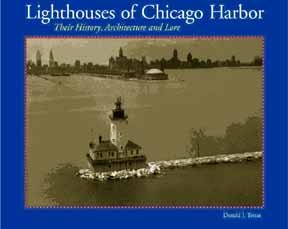
28452.
Terras, Donald J. Lighthouses of Chicago Harbor –
Their History, Architecture and Lore. Evanston. 2006. 96p. Soft
wraps. Since 1831 Chicago’s harbor has been home to a succession of
lighthouses to grant safe access to one of the great historical port cities of
the country. This beautifully illustrated book tells the story of the
structures, the keepers, and the role that they played in Chicago’s
development. Wonderfully illustrated with numerous vintage images, many
beautifully reproduced in full page views. One of the first that you will
encounter as you thumb through the pages is a full page color image of an 1848
Pleasonton map of Great Lakes lighthouses – a spectacular map by this early
overseer of lighthouse construction in the United States. Other rare views
include many keeper photos, lamps and equipment and much more. Well worth the
price for these images alone. (M). $19.95.

28426.
Steinberg, Maurice “Moe” RM 3/c. A Sailor at War:
On the Greenland Patrol - WWII. Xlibris. 2002. 178p. Soft
wraps. A wonderful memoir of Radioman 3/c Maurice Steinberg’s experiences of
World War II – from boot camp, to becoming a Morse Code radio operator on
board a 240-foot Coast Guard convoy escort, and anti-submarine duto in the North
Atlantic. U-boats remained a constant threat as his vessel patrolled the North
Atlantic routes. This is part of the story of the Greenland Patrol, and life
aboard a Coast Guard vessel. Wonderfully written in a down-to-earth style that
every veteran and civilian alike will appreciate. (M). $24.95.

28418.
Patten, Juliana Fern. Another Side of World War II: A
Coast Guard Lieutenant in the South Pacific. Shippensburg. 2006.
156p. Autographed by the author. Another Side Of World War II is the engaging
personal story of one man's experiences of World War II in the South Pacific
Theatre. Coast Guard Lieutenant Jules Fern’s letters, spanning two years at
sea in the South Pacific, offer a poignant view of life aboard ship during World
War II. Compiled from his letters, logs, and photographs of the time, this
account penned by his daughter after his death, provides readers with an
intimate and vivid detailing of events from the perspective of someone deeply
involved with the progression of the war. A welcome contribution to the growing
library of World War II military memoirs an and biographies, Another Side Of
World War II is very highly recommended to all readers with an interest in
first-hand accounts, as well as those in search of a better understanding of
World War II and America's participation in the South Pacific combat zones. Well
illustrated with his photos taken at the time, orders, messages and more. (M).
16.95.
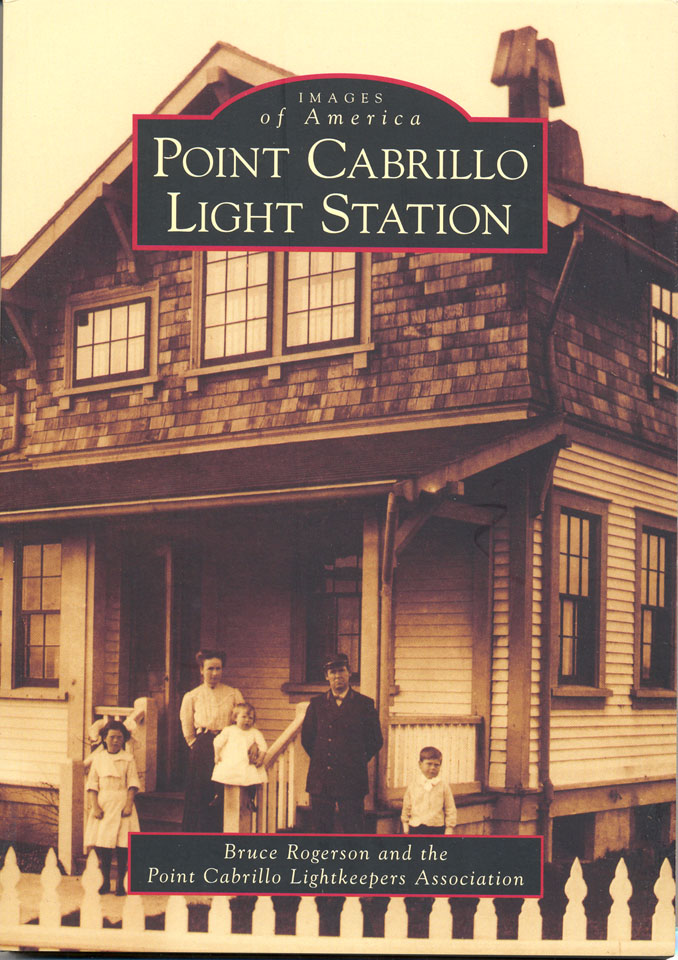 28359.
Rogerson, Bruce et al. Point Cabrillo Light Station.
Arcadia
Publishing. 2008. 128 p. Soft wraps. 200 vintage photographs. Point Cabrillo
Lighthouse, on the rugged coast of Mendocino County in Northern California, was
first lit as an aid to navigation on June 10, 1909. The light station continues
to serve mariners and is regarded as one of the crown jewels of lighthouses on
the West Coast. In July 1850, just north of the future site of the lighthouse,
the clipper brig Frolic wrecked in its journey from China to Gold Rush–era San
Francisco. European settlers in search of salvage from the cargo found instead
Mendocino’s vast strands of virgin redwood timber stretching inland from the
coast. Getting this valuable lumber to market in the mid-19th century required
ships, and ships needed lighthouses to guide them. In 1909, the light known
today as Point Cabrillo was built on a windswept promontory two miles north of
the village of Mendocino. Another in the series from
Arcadia
, this volume draws from public and private collections, most never before
published. Superb photographs of the station, keepers, equipment and more,
well worth it. (M). $19.99.
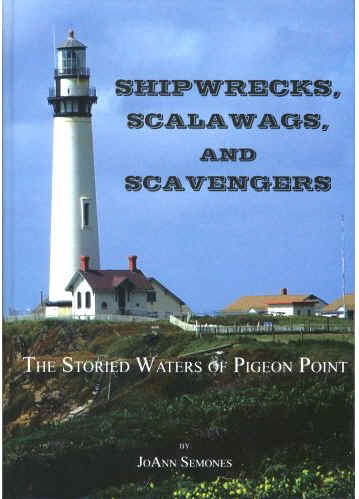
28367.
Semones, JoAnn. Shipwrecks, Scalawags, And Scavengers -
The Storied Waters Of Pigeon Point. Glencannon Press. 2007.
160p. DJ. Over 70 photos and illustrations. Pigeon Point - Those lucky enough to
survive the bloodiest of shipwrecks at Pigeon Point say the San Juan, an old
steamer, was doomed from the moment it collided with an oil tanker just before
midnight on Aug. 29, 1929. "We heard the crash and the lights went
out," said the San Juan's second officer. "Then, in a second, I got
covered with water and the vessel sank from under me." Fifty-five
passengers and 20 crewmen perished in the fog as the waves overtook the
splintered steamer. Just one child survived the wreck as his mother threw him
onto the deck of the oil tanker, itself damaged from the collision. Such tales
haunt the pages of "Shipwrecks, Scalawags, and Scavengers: The Storied
Waters of Pigeon Point." Between 1853 and 1953, ships of all types –
clipper ships, barks, schooners, steamers — sailing the central California
Coast fell victim to Pigeon Point’s unpredictable weather and rocky shoreline.
Author and historian JoAnn Semones offers the first- ever history of shipwrecks
at San Mateo County's notoriously treacherous Pigeon Point, using rare
photographs and historic accounts from the people whose lives were altered by
their experiences there. (M). $24.95.

28261. Harrison, Timothy. Lighthouses
of the Sunrise County. Foghorn Publishing. 2008. 189p. Soft wraps.
The most complete photographic book ever published about the eleven lighthouses
where the rays of the sun first touch the coast of the United States of America
- Maine's Washington County. This detailed work by noted lighthouse historian
and writer Tim Harrison utilizes hundreds of early photographs to detail the
lives of the keepers of the lighthouses at some of Maine's most pictures and
remote light stations from the days of the U.S. Lighthouse Service to the days
of U.S Coast Guard and then to the present. Superb accounts by keeper and their
families and descendents make this a most interesting read. Includes many early,
rare photos, memories and storied about the keepers and their families, their
pets, work and improvements to the station over the years, and much more.
Includes an entire chapter on Connie Small, the "First Lady of Light."
Light stations include Avery Rock, Libby Island, Little River, Lubec
Channel, Moose Peak, Narraguagus, Nash Island, Petit Manan, St. Croix River,
West Quoddy Head and Whitlock's Mill. Great reading, well worth the price for
the images alone! (M). $18.95.

28319.
Peterson, Harold L., THE AMERICAN SWORD 1775 – 1945
– A survey of the Swords Worn by the Uniformed Forces of the United
States from the Revolution to the close of World War II. Dover. 2003.
Soft wraps. A complete classification and description of all the major types of
swords worn by the armed forces of the
United States
, the Revenue Cutter Service the Public Health Service, cadets, diplomat.
Includes a directory of 400 American sword makers, the evolution of scabbards,
sword nomenclature, silver hilted and presentation swords, and a complete
classification and description of all of the major types of swords worn by the
services, dealers and inspectors. Enhanced with more than 400 illustrations of
swords from rare documents, plus much more. Includes 186 halftones of swords,
b/w plates and drawings. Original blue cloth with silver stamping and vignette
on front cover. An excellent reference. (M). Please inquire for pricing. 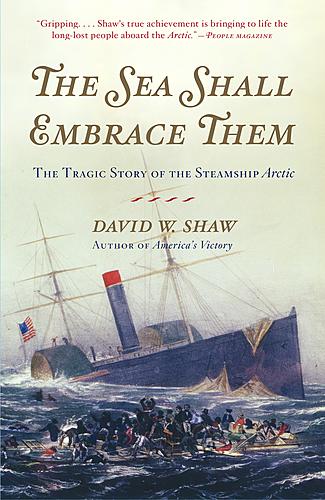
28365.
Shaw, David W. The Sea Shall Embrace Them - The Tragic
Story of the Steamship Arctic. Free Press. 2002. DJ. 241p. The 1854
collision at sea between the American ship Arctic and the Vesta, a much smaller
French steamship, set in motion one of the most harrowing events in maritime
history. David W. Shaw has based this fascinating account on the firsthand
testimony of the few who survived the wreck, including the Arctic's heroic
captain, James C. Luce, who was forced to fight his mutinous crew as they took
the lifeboats and left hundreds of passengers to suffer a cruel and painful
death. Not only did 400 people -- including Luce's own frail son -- die by
daybreak, but the wreck also ended the domination of the seas by the American
maritime fleet for the rest of the nineteenth century. Utterly compelling, The
Sea Shall Embrace Them is a stirring slice of heretofore little-known American
history. Beautifully written, it puts the reader on deck as a ship full of men,
women, and children do battle both with a mighty ocean and with their own baser
instincts. (M). Published at $24.95. Our price $22.95.

28375.
Hodgkins, John. A Soldier's Son: An American Boyhood
during World War II. Down East Books. 2006. 325p. Soft wraps. John
Hodgkins was eight years old when his father was drafted into the army and left
for Europe to fight in World War II. After his return, John's father never spoke
much about the war, but John knew he'd kept a diary. After his father's death,
John opened his diary and two boxes of memorabilia. What began as John's attempt
to tell his father's story became the story of his own life. This memoir
recounts what life was like on the home front of Temple, Maine, during the war
-- as well as what life was like on the front lines, thanks to what John learned
from his father's letters home and his war diary. It also provides a firsthand
look at the hardscrabble lives of rural Mainers and a way of living that is now
mostly gone. (M). $16.95.
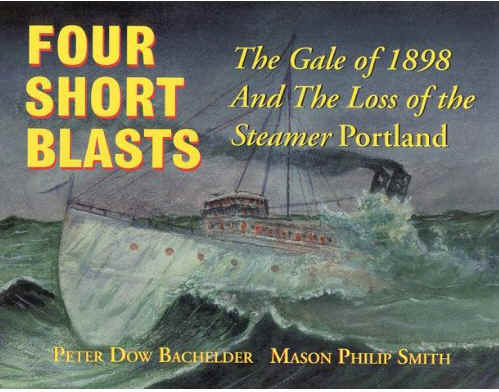
8298.
Bachelder, Peter Dow and Mason Philip Smith. FOUR SHORT
BLASTS – The Gale of 1898 and the Loss of the Steamer
Portland
. 1998. 138p. Soft wraps. Cleanly written, this interesting account
details the mysterious disappearance of the state of the art steamer, S.S.
Portland, in November of 1898. Since there were no survivors, sources are
newspaper articles of the day and interviews with survivors of the gale in other
craft. The authors provide details of the storm itself, the tragic foundering of
the
Portland
, the storm's effect ashore, the official investigation of the sinking and
ongoing legends which exist to this day. Illustrations and photographs are
plentiful and poignant. In addition to a helpful index and bibliography, the
authors have provided appendices—lists of victims as well as vessels lost or
damaged in the gale, an amazing 3000 or more schooners, yachts, steamers and
barges between New Jersey and Nova Scotia. Although the loss of the steamer and
140 passengers and crew is the primary subject, Four Short Blasts contains
fascinating tangential stories, about the U. S. Life-Saving Service (long
defunct) which at the time of the storm had 13 stations along the
shore
of
Cape Cod
. $17.95.

28240.
Buker, Commander George E., THE METAL LIFE CAR- The
Inventor, the Impostor, and the Business of Lifesaving. University of
Alabama Press. 2008. DJ. 224p, 17 illustrations. This title presents the
fascinating story of American ingenuity and its struggle against bureaucracy and
chicanery. For centuries sailing vessels crept along the coastline, ready to flee
ashore in case of danger or trouble; this worked well until weather or poor
sailing drove these ships against an unforgiving coast. Joseph Francis, born in
Boston, Massachusetts in 1801, was an inventor who also had the ability to
organize a business to produce his inventions and the salesmanship to sell his
products. His metal lifeboats, first used in survey expeditions in Asia Minor
and Central America, came into demand among the world's merchant marine, the
U.S. Navy, and the U.S. Revenue Service. His corrugated "life car"
would become an important tool of the U.S. Life-Saving Service. The metal boats
also played an important role in the Third Seminole War in Florida. Francis'
metal pontoon army wagons served in the trans-Mississippi campaigns against the
Indians. In Europe, he was acclaimed as a genius and sold patent rights to
shipyards in Liverpool and the Woolwich Arsenal in England, Le Havre seaport in
France, in the free city of Hamburg, and in the Russian Empire. But while
Francis was busy in Europe, Captain Douglass Ottinger, U.S. Revenue Marine
Service, claimed to be the inventor of Francis' life car and obtained support in
the U.S. Congress and the Patent Office for his claim. Francis had to battle for
decades to prove his rights, and Americans remained generally unfamiliar with
his devices, thereby condemning Civil War armies to inferior copies while Europe
was using, and acclaiming, his inventions. Long awaited account of the work of
this important life-saving equipment inventor. (M). $29.95.
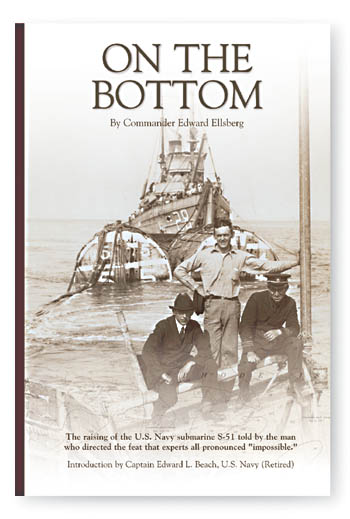
28308.
Ellsberg, Commander Edward. On the Bottom. Flat
Hammock Press. 2004. 256 pages w/ photos, with added CD, & DVD. With
an introduction by Edward L. Beach, Captain, U. S. Navy (Retired). First
published in 1929, this enthralling work has become one of the greatest true
stories of adventure, dogged determination, courage and loyalty ever written. On
the evening of September 25, 1925 the U.S. Navy Submarine S-51 was rammed by the
steamship SS City of Rome in open seas off Block Island, Rhode Island, and sank
in 132 feet of water, with the loss of 33 lives. This disaster evoked such a
storm of popular indignation against the Navy Department that something had to
be done. It was felt that at all costs a determined attempt must be made to
raise the S-51, if only to restore public confidence. No vessel had ever been
raised from such a depth, and to the technical mind the thing was impossible.
The task of salvaging the submarine fell to Lieutenant Commander Edward Ellsberg
and a group of naval divers scavenged from all over the fleet. It was done
painstakingly over a nine month period and involved obstacle after obstacle, all
the while battling rough seas, icy waters, and "the bends." Working in
hard hats with lead boots, in minimal light, while dragging air lines behind
them, each diver had about an hour of exhausting and terrifying work before a
lengthy decompression process. It is no exaggeration to say that the impossible
was achieved. Originally published in 1929, this magnificent account of the
struggle on the ocean floor to salvage the sunken U.S. Navy submarine, S-51, has
become a modern classic of the sea. What was not included in Edward Ellsberg’s
gripping account are specifics of the accident, the aftermath, and the extent
that the event touched the nation. This expanded edition presents this and more
by including an introduction, a publisher’s preface, additional photographs,
an afterword, and appendixes. Also added is a recording of the period song
"Sinking of the Submarine S-51," an oral history by Commander Ellsberg,
and a video disc of rare on scene newsreel footage. "A marvelous tale,
filled with moments of horrified expectancy, of glad thrills, of impossible
deeds and endurances, of achievements that smack of magic." (The New York
Times). (M). $34.95
Due in soon:
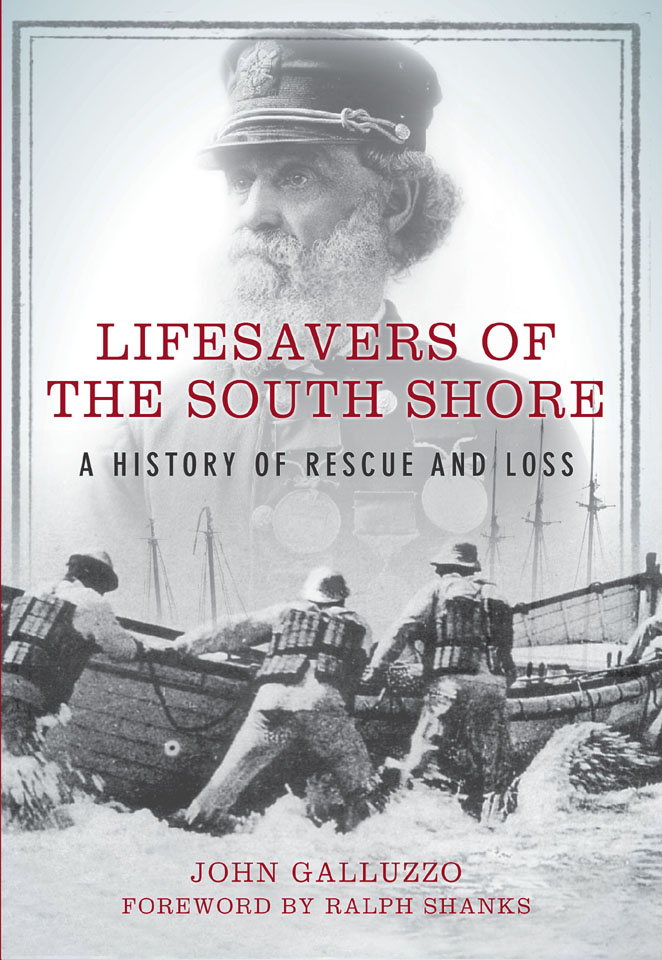
28129.
Galluzzo, John. Lifesavers of the South Shore – A
History of Rescue and Loss. History Press. 2008. DJ. 128p. However cruelly
the rocks of
Massachusetts
's
South
Shore
have treated storm-driven sailors, there can be no questioning the selflessness
and courage of the keepers and surfmen who played host to the no man's land
between frozen beach and gale-tossed sea. Read John Galluzzo's enthralling
account of the Life-Saving Service and meet legends like Joshua James, whose
surfboat, Nantasket, once saved twenty-nine men from six boats in a grueling
thirty-six hours. Chart a course through the service's history, from its humble
beginning in the refuge huts built after the American Revolution until its
absorption into the U.S. Coast Guard in the twentieth century. (M). $19.99.
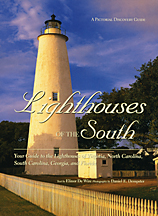
28300.
DeWire, Elinore. LIGHTHOUSES OF THE SOUTH – Your
Guide to the Lighthouses of Virginia, North Carolina, South Carolina, Georgia,
and Florida.
Stillwater
. 2004. 160 p. DJ. A Pictorial Discovery Guide. A fresh look at the history and
technological evolution of lighthouses in the area, the development of
apparatus, architecture, construction and maintenance on their remote sites, the
daily life of the keepers and much more. The author presents an exciting history
illustrated with stunning photographs, historical anecdotes, architectural
details and local legends. Lavishly illustrated, an excellent text on the
subject and guide for the area. (M). Published at $29.95. Our Price $21.95.
Nominated
for the 2008 Foundation for Coast Guard History book award:
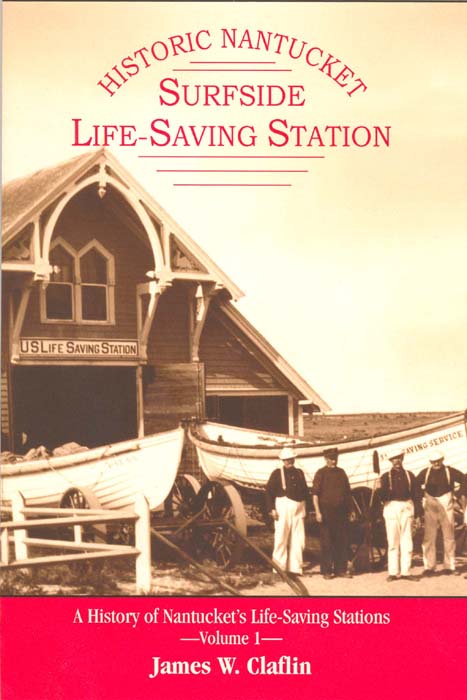
27268.
Claflin, James W. HISTORIC NANTUCKET: SURFSIDE
LIFE-SAVING STATION - A History of Nantucket’s Life-Saving Stations.
Volume I. Worcester. 2007. 79 p. Soft wraps.
Special edition, signed and numbered of 500, includes pasted in wood chip
from Surfside Life-Saving Station. Historic Nantucket: Surfside Life-Saving
Station is one of a continuing series of booklets that tell the story of
historic lighthouses, lightships and life-saving stations along the New England
Coast
. The Nantucket coastline has long been one of the most dangerous areas along
the New England
coast. Over the years four life-saving stations and eight Massachusetts Humane
Society stations stood guard over the island’s shores, standing ready to
combat the seas in an effort to rescue shipwrecked mariners in their time of
need. With thousands of vessels plying the dangerous waters, the chance of a
shipping disaster was always great. Hundreds of shipwrecks did indeed occur off
the coast with startling losses. Using descriptive text and a variety of vintage
images from private as well as museum collections, we get a rare glimpse into
the history of the area and the lives of these dedicated government men and
women. Author James Claflin combines an extensively researched text with his
exquisite collection of vintage photographs, many previously unpublished, to
tell the story of this important piece of history. (M). $8.95.

28169.
Thurlow, Sandra Henderson and Deanna Wintercorn. GILBERT’S
BAR HOUSE OF REFUGE – Home of History. Stuart. 2008. 96p. Soft
wraps. The Houses of Refuge in Florida were a series of stations operated by the
United States Life Saving Service along the coast of Florida to rescue and
shelter ship-wrecked sailors. Five houses were built on the east coast in 1876,
with five more added in 1885. There was also two Life Saving Stations built, one
just south of the Jupiter Inlet, the other on the Gulf coast on Santa Rosa
Island near Pensacola. The houses were manned by civilian keepers, contractors
who lived in the houses with their families. Most of these houses remained in
service as life-saving stations until 1915 or later. Some of the locations
became United States Coast Guard stations after the Life Saving Service was
merged into the Coast Guard in 1915.Today, only one remains – Gilbert’s Bar.
This rare and wonderful account of the life and work at these lonely outposts is
long overdue. (M). $16.95.
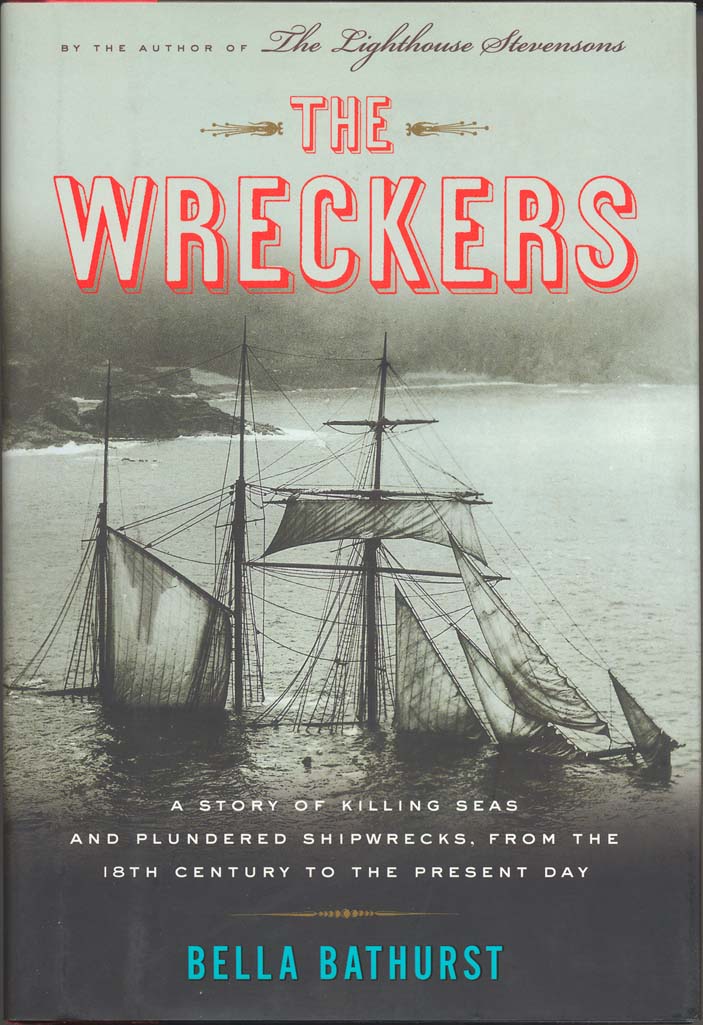
28238.
Bathurst, Bella. The Wreckers – A Story of Killing
Seas and Plundered Shipwreck, from the Eighteenth Century to the Present Day.
Boston. 2005. 326p. DJ. Bella Bathurst's first book, the acclaimed The
Lighthouse Stevensons, told the story of Scottish lighthouse construction by the
ancestors of Robert Louis Stevenson. Now she returns to the sea to search out
the darker side of those lights, detailing the secret history of shipwrecks and
the predatory scavengers who live off the spoils. Even today, Britain's
coastline remains a dangerous place. An island soaked by four separate seas,
with shifting sand banks to the east, veiled reefs to the west, powerful
currents above, and the world's busiest shipping channel below, the country's
offshore waters are strewn with shipwrecks. For villagers scratching out an
existence along Britain's shores, those wrecks have been more than simply an act
of God; in many cases, they have been the difference between living well and
just getting by. Some plunderers were held to be so skilled that they could
strip a ship from stem to stern before the Coast Guard had even left port, some
were rumored to lure ships onto the rocks with false lights, and some simply
waited for winter gales to do their work. From all around Britain, Bathurst has
uncovered the hidden history of ships and shipwreck victims, from shoreline
orgies so Dionysian that few participants survived the morning to humble homes
fitted with silver candelabra, to coastlines rigged like stage sets to villages
where everyone owns identical tennis shoes. Spanning three hundred years of
history, The Wreckers examines the myths, the realities, and the superstitions
of shipwrecks and uncovers the darker side of life on Britain's shores. (M).
Published at $25. Our Price $16.95.

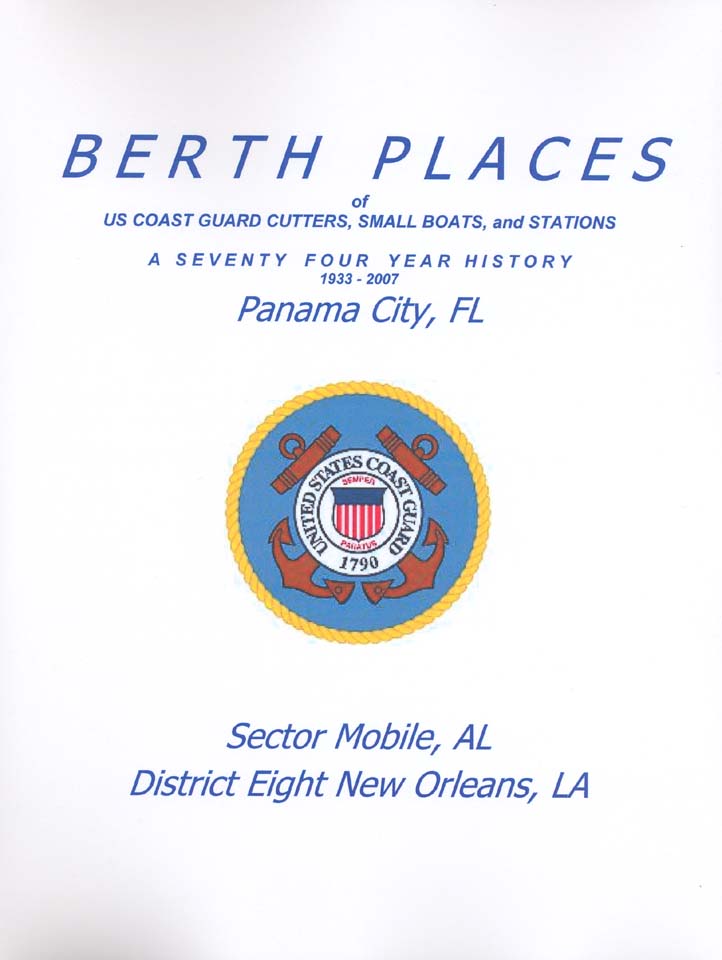
28192.
Raffield, John C. UNITED STATES COAST GUARD STATION ~
PANAMA CITY - A Seventy Two Year History 1933-2005.
Jacksonville. 2005. 111p. Soft wraps. United States Coast Guard Station ~ Panama
City, A Seventy Two Year History," was the first and only documented Coast
Guard history for Panama City and Bay County since the United States Coast
Guard’s arrival in 1933. The station featured nine C.G. Cutters, four C.G.
manned Lighthouses, and WW II Coastal Defense Gun Emplacements at the Pass, K-9
and mounted beach patrols, and the forty LSTs that conducted their two-week
shakedown exercises in the Gulf, and anchored in St. Andrews Bay for ‘safe
harbor’ at night to escape the German U-boats activity in the Gulf. Growing up
in Panama City, the author had both direct and indirect relationship with the
Coast Guard crews, CG Auxiliary personnel, and retirees. Over the years, Coast
Guard retirees have made Panama City their new home, and made boating at one
level or another, their business. The author has always had a fondness for the
beaches, water, boats, and has felt a friendship with the Coast Guard as his dad
had throughout WW II as a member of the CG Auxiliary, and having lived in the
old Coast Guard Headquarters ~ barracks as a child. In this privately published
work, the author presents a detailed history of Coast Guard Station – Panama
City including the men and facilities, history of cutters assigned there over
the years, harbor defenses and beach patrols, lighthouses in the area, LSTs and
World War II activities, and more. Thoroughly illustrated with photographs. (M).
$58.
28202.
Raffield, John C. BIRTH PLACES OF U.S. COAST GUARD
CUTTERS, SMALL BOATS, AND STATIONS – PANAMA CITY, FL. - A Seventy Four Year
History 1933-2007. Jacksonville. 2007. 292p. Soft wraps. Birth Places
Of U.S. Coast Guard Cutters evolved as an additional detailed Coast Guard
history – a companion to the author’s earlier work United States Coast Guard
Station ~ Panama City. In this work he includes additional CG Cutters, bringing
the total U.S. Coast Guard Cutters to eleven being homeported in Panama City.
Through the years, there have been four different Station locations, and the
eleven cutters, four small boats, and four aids to navigation boats making their
berths in seven different locations in St. Andrews Bay. The author felt the need
to complete a more in depth look into the cutters and boats. The author felt
that the new historical information and photos needed to be documented before
all the existing personal historical resources “Cross The Bar,” resulting in
their accounts of local Coast Guard history being lost to Station-Panama City,
Panama City, and Bay County. Growing up in Panama City, the author had both
direct and indirect relationship with the Coast Guard crews, CG Auxiliary
personnel, and retirees. Over the years, Coast Guard retirees have made Panama
City their new home, and made boating at one level or another, their business.
The author has always had a fondness for the beaches, water, boats, and has felt
a friendship with the Coast Guard as his dad had throughout WW II as a member of
the CG Auxiliary, and having lived in the old Coast Guard Headquarters ~
barracks as a child. In this privately published work, the author presents a
detailed history of the vessels of U.S. Coast Guard Station – Panama City.
Thoroughly illustrated with photographs. (M). $68.

28196.
Hill, Peter. Stargazing. Knopf. 2004. 275p.
DJ. When Peter Hill, a student at Dundee College of Art, answered an
advertisement seeking relief lighthouse keepers, little did he imagine that
within a month he would be living with three men he didn't know in a lighthouse
on Pladda, a small remote island off the west coast of
Scotland
. The year was 1973, Hill was nineteen, and he was to spend the next six months
in various lighthouses, "keeping" with all manner of unusual and
fascinating people. The resulting book is a charming and beautifully written
memoir that is not only a heartfelt lament for Hill's own youth and innocence
but also for a simpler and more honest age, for the life of the keepers kept
awake by the spray and the cold wind, and mush more. (VG+). Published at $29.95.
Our Price $14.95.
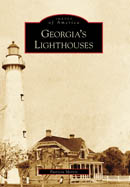

28209.
Morris, Patricia. Georgia's Lighthouses.
Arcadia
Publishing. 2008. 128 p. Soft wraps. 200 vintage photographs. When British
general James Oglethorpe landed on
Georgia
’s coast in 1733, he realized that the success of his new colony,
Savannah
, depended largely on its establishment and development as a commercial port.
Only three years later, in 1736, the first lighthouse was built on
Tybee
Island
. Beginning there at the mouth of the
Savannah River
, this volume travels down the coast, telling the very different stories of the
Cockspur Light, Sapelo Light, St. Simons Light, and Cumberland Light, which is
now located on a private island. Rich in history, these lighthouses help to
define the story of
Georgia
’s 100-mile coastline. Of the lighthouses built, only five remain today; two
are operational lights—
Tybee
Island
and
St.
Simons
Island
. Another in the series from
Arcadia
, this volume draws from public and private collections, most never before
published. Superb photographs, well worth it. (M). $19.99.
28210.
Grand
Traverse
Lighthouse
Museum. Grand Traverse Lighthouse.
Arcadia
Publishing. 2008. 128 p. Soft wraps. 200 vintage photographs. The Grand
Traverse Lighthouse sits majestically at the entrance of
Grand Traverse Bay
, guiding vessels between Chicago and the Straits of Mackinac. For over 150
years, it has been an important beacon for all who have plied the waters of
Lake Michigan
. The original 1852 lighthouse was used for six years before being torn down. In
1858, a larger lighthouse with an attached nine-sided tower was erected on a
site farther west. Over the course of its history, 66 lighthouse keepers,
assistant keepers, and U.S. Coast Guard personnel have maintained the light.
Today visitors tour the restored lighthouse, which is now a living museum filled
with displays and exhibits depicting a simpler way of life. Another in the
series from
Arcadia
, this volume draws from public and private collections, most never before
published. Superb photographs, well worth it. (M). $19.99.
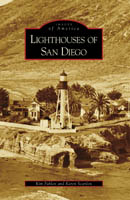

28211.
Fahlen, Kim and Karen Scanlon. Lighthouses of San
Diego.
Arcadia
Publishing. 2008. 128 p. Soft wraps. 200 vintage photographs. As his ship
rounded the
high point
off Point Loma,
San Diego
, in 1859, Richard Henry Dana wrote, “We were greeted by the cheering presence
of a light-house.” In reality, beams from
San Diego
’s first lighthouse were repeatedly lost in cloud and fog, and all too soon
came agitation for a more effective light at a lower elevation. By 1891, two new
lighthouses were constructed to achieve what one could not—a major light on
the low tip of Point Loma and a secondary light at Ballast Point. Although
abandonment of the first lighthouse structure was nearly catastrophic, it still
survives today to charm millions of visitors. Now, and long overdue, are new
glimpses of the famous and lesser-known lighthouses of San Diego thanks to the
memories and photographs belonging to families of the men who kept the lights
burning. Another in the series from
Arcadia
, this volume draws from public and private collections, most never before
published. Superb photographs, well worth it. (M). $19.99.
28212.
Fahlen, Kim and Karen Scanlon. Lighthouses of San Diego.
Arcadia
Publishing. 2008. 15 p. Soft wraps.
San Diego
’s first lighthouse on top of Point Loma was replaced by 1891 with two others,
at the base of the cliff and on Ballast Point, where their beams were less
affected by fog and low clouds. In this collection of vintage-photograph
postcards, the authors explore these historic beacons’ pasts. Another in the
series from
Arcadia
, this volume draws from public and private collections, most never before
published. Superb views, well worth it. (M). $7.99.
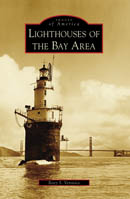
28213.
Veronico, Betty S. Lighthouses of the Bay Area.
Arcadia
Publishing. 2008. 128 p. Soft wraps. 200 vintage photographs. The 1848
discovery of gold in the hills of
California
brought prospectors and adventurers west; many came across the country on the
treacherous western trails, while others came by sea. The rugged coast of
California
and the dangers of the
San Francisco
Bay
waters claimed many ships and their passengers. The loss of these ships and the
ever-increasing number of vessels converging in the
San Francisco
Bay
made it evident that navigational aids were desperately needed. To enhance
maritime safety in the region, the
San Francisco
Bay
’s first light, located on
Alcatraz
Island
, began construction in 1852. Light stations soon followed at Fort Point, Point
Bonita, and the
Farallon
Islands
. An additional 15 lights later served the bay, and two lightships were
stationed outside the
Golden Gate
. Another in the series from
Arcadia
, this volume draws from public and private collections, most never before
published. Superb photographs, well worth it. (M). $21.99.
28214.
Veronico, Betty S. Lighthouses of the Bay Area.
Arcadia
Publishing. 2008. 15 p. Soft wraps. The
San Francisco
Bay
’s first light, on
Alcatraz
Island
, began construction in 1852. Light stations soon followed at Fort Point, Point
Bonita, and the
Farallon
Islands
. An additional 15 lights later served the bay, and a lightship was stationed
outside the
Golden Gate
. In this collection of vintage-photograph postcards, the authors explore these
historic beacons’ pasts. Another in the series from
Arcadia
, this volume draws from public and private collections, most never before
published. Superb views, well worth it. (M). $7.99.
Due out in August.
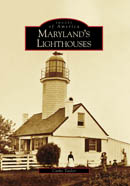
 
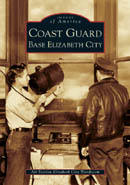
28215.
Taylor, Cathy. Maryland's Lighthouses.
Arcadia
Publishing. 2008. 128 p. Soft wraps. 200 vintage photographs. In Colonial
times, as the Chesapeake Bay and larger rivers became vital shipping channels,
the need arose to mark
Maryland
’s dangerous shoals and waterways. Lighthouses sprang up throughout the 1800s
and early 1900s, including wood-framed cottages placed upon screw pile
foundations that stood offshore in the unforgiving waters. Most of these unique
structures did not survive, lost tragically to ice that also occasionally
claimed the lives of the keepers who faithfully tended them and rescued mariners
in trouble. With the advent of electricity and GPS, many beacons succumbed to
vandalism and neglect, leaving a fraction remaining. Another in the series from
Arcadia
, this volume draws from public and private collections, most never before
published. Superb photographs, well worth it. (M). $19.99.
28216.
Clary, Margie Willis and Kim McDermott. South Carolina
Lighthouses.
Arcadia
Publishing. 2008. 128 p. Soft wraps. 200 vintage photographs. Boasting one of
the oldest lighthouses in North America and the most working lighthouses today,
South Carolina
has a long seafaring history. In 1767, the Morris Island Lighthouse was built
at the entrance to
Charleston
Harbor
, and before 1860, there were lighthouses in
Georgetown
,
Cape
Romain
, Bull’s Bay, and
Hunting
Island
. During the Civil War, all lighthouses on the eastern coast were darkened. Many
were destroyed. After the war, towers that had been damaged were repaired, and
additional lights were erected on Daufuskie and
Hilton
Head
Islands
. In 1962, the new Charleston Light on Sullivan’s
Island
replaced the Morris Island Lighthouse, which was suffering from erosion by the
ever-encroaching sea. The new light contained an elevator and two rotating
beacons capable of producing 28 million candlepower, a light that can be seen 26
miles out to sea. At that time, it was considered one of the most powerful
lights in the
Western Hemisphere
. Another in the series from
Arcadia
, this volume draws from public and private collections, most never before
published. Superb photographs, well worth it. (M). $19.99.
28217.
Clary, Margie Willis and Kim McDermott. South Carolina
Lighthouses.
Arcadia
Publishing. 2008. 15 p. Soft wraps. With one of the oldest lighthouses in the
country and the most working lighthouses today,
South Carolina
boasts a rich lighthouse history. In this collection of vintage-photograph
postcards, the authors explore these historic beacons’ pasts. Another in the
series from
Arcadia
, this volume draws from public and private collections, most never before
published. Superb views, well worth it. (M). $7.99.
28218.
Author(s): The
Air
Station
Elizabeth
City
Wardroom. Coast Guard Base Elizabeth City.
Arcadia
Publishing. 2008. 128 p. Soft wraps. 200 vintage photographs. Situated on the
northern end of
North Carolina
’s Outer Banks,
Elizabeth
City
has a strong aviation tradition. The Wright brothers used the “
Harbor
of
Hospitality
” as a final way station before traveling on to
Kitty Hawk
. This coastal town has been the center of United States Coast Guard Aviation
since the establishment of the only Coast Guard–owned airport in 1939. Coast
Guard Base Elizabeth City began as an installation of six seaplanes operating
off of the
Pasquotank
River
. During World War II, the population ballooned to 8,000 assigned personnel.
Post-war USCG Aviation expansion saw the addition of many maintenance functions
that led to the creation of the Aviation Repair and Supply Base, the center of
USCG Aviation maintenance. The base was expanded with a separate air station,
the
Aviation
Technical
Training
Center
, CG Aviation’s schoolhouse,
Support
Center
Elizabeth
City
, and
Small
Boat
Station
Elizabeth
City
. The mission of providing the finest aviation maintenance to Coast Guard
Aviation and the highest level of service to mariners of the
Virginia
Capes
and Outer Banks remains an integral part of the installation. Another in the
series from
Arcadia
, this volume draws from public and private collections, most never before
published. Superb photographs, well worth it. (M). $19.99.
Due out in September.

28155.
Campbell, Lyall. Sable Island Shipwrecks - Disaster and
Survival at the North Atlantic Graveyard. Nimbus. 1994. 200p.
Illustrated. More than 500 ships have gone aground in this "graveyard of
the Atlantic" since 1583 when one of Sir Humphrey Gilbert's ships, the
"Delight", went down. Campbell has studied the marine disasters around
Sable Island and tells many of their stories. This best-selling book tells of
disaster, danger, rescue, and survival, and the people who provided care and
safe haven for those unlucky enough to be shipwrecked in the Graveyard of the
North Atlantic. $17.95.

28162.
Floca, Brian. LIGHTSHIP. New York. 2007.
40p. DJ. This is a truly beautiful picture book about a subject most young
readers may never have encountered. Author-illustrator Floca, in brisk but
poetic words and stunning watercolors that are both witty and informative, tells
the story of the red-hulled Ambrose Light. Young adventurers are sure to be
drawn into the life of the crew and its cat, as the ship weathers fog, storms,
and close encounters with other vessels, while all the time she "holds her
one sure spot." From the shining lights high on the masts to the domain of
the engineer deep in the hull, Floca's research lets readers explore the
equipment of a lightship and the perils of the sea. Though each picture deserves
attention, especially striking are the ones of the scarlet hull in a snowstorm
(through portholes, cat and cook are seen snug below) and of the huge black
shape of the S.S. Ardizzone (a tribute to the English illustrator) looming over
the Ambrose as a crewman shouts his warning. (M). $19.95.

27302. Powers, Dennis M. SENTINEL
OF THE SEAS – Life and Death at the Most Dangerous Lighthouse Ever Built.
Citadel Press. 2007. 380p. DJ. Miles off the coast of northern California lies a
mariner’s nightmare. Concealed by roiling sea and thick fog, the jagged edges
of a submerged volcanic mountain chain await approaching vessels like predators
in the mist. This is one of the most hazardous reefs off the West Coast. And for
over a century, it has been home to the most remote, most expensive, and most
dangerous lighthouse ever built in America. In Sentinel of the Seas, Dennis M.
Powers chronicles the heroic stories of men and women who have gone where land
and sea collide. To build the St. George Reef Lighthouse, Alexander Ballantyne—probably
the only man alive who was qualified and brave enough to supervise such a
project—faced incredible hurdles, including the haul of six-ton granite blocks
onto a spit of washed-over land from a quarry seventy-five miles away. In 1937
George Roux, the tough, longtime head lighthouse keeper, was trapped for two
months by howling winds and stories-high waves with his crew on the verge of
mutiny. In 1951 a rogue wave capsized a Coast Guard launch being lowered from
the lighthouse, challenging keeper Fred Permenter to attempt a nearly impossible
rescue that would win him a place in Coast Guard history. Based on five years of
research drawing on the National Archives, original journals, and personal
interviews, Sentinel of the Seas is the first book to capture the tumultuous
history of this astounding engineering feat and the lives that have been
influenced by it. (M). $21.95.

2873.
na. H. K. CUMMINGS REVISITED, 1887-1905. Vol. I.
Intro. by Henry Scammell. Bobi Eldridge (Coordinator). Snow Library. Orleans.
2004. 35p. Soft wraps. Superbly reproduced images from the collection of 750
glass plate photographs taken by H. K. Cummings at the turn of the previous
century. Henry Knowles Cummings, born in the last year of the Civil War,
discovered the fascination of photography the years from 1885 to 1905. His
photos bore images of the town as it then was, streets and buildings, horses and
rigs, and people and dogs. Other plates held images made by the ever present
sea. He pointed his camera everywhere, at the treeless moors of the Outer Cape,
at the wooden sailing ships storm-smashed against the shore, at the crews of
life-saving stations. That was H. K. Cummings pursuing his avocation, as two or
three of his Orleans contemporaries did. On the counter of his dry good store on
Main Street, he kept a pile of prints from his negatives, which he sold for 25
cents each. By the time of his death in the 1950s, at 87, Cummings the
photographer had amassed about 1,000 views of Orleans scenes and people. His
plates and some of his prints are preserved now at the Snow Library, a valuable
record in the history of the town. Volume I contains thirty three impressions
including Chatham Twin Lights, the wreck of the Kate Harding (December 1892),
Orleans Life-Saving crew, town views and much more. A joy to peruse through,
beautifully done. (M). $17.95.

2874.
na. H. K. CUMMINGS REVISITED, 1887-1905. Vol. II:
Working. Intro. by Henry Scammell. Bobi Eldridge (Coordinator). Snow
Library. Orleans. 2006. 35p. Soft wraps. Superbly reproduced images from the
collection of 750 glass plate photographs taken by H. K. Cummings at the turn of
the previous century. Henry Knowles Cummings, born in the last year of the Civil
War, discovered the fascination of photography the years from 1885 to 1905. His
photos bore images of the town as it then was, streets and buildings, horses and
rigs, and people and dogs. Other plates held images made by the ever present
sea. He pointed his camera everywhere, at the treeless moors of the Outer Cape,
at the wooden sailing ships storm-smashed against the shore, at the crews of
life-saving stations. That was H. K. Cummings pursuing his avocation, as two or
three of his Orleans contemporaries did. On the counter of his dry good store on
Main Street, he kept a pile of prints from his negatives, which he sold for 25
cents each. By the time of his death in the 1950s, at 87, Cummings the
photographer had amassed about 1,000 views of Orleans scenes and people. His
plates and some of his prints are preserved now at the Snow Library, a valuable
record in the history of the town. Volume II contains thirty three impressions
including Wellfleet Lighthouse, wreck of Charles A Campbell, Orleans Life Saving
crew, Orleans Cable Station, salt works, town views and much more. A joy to
peruse through, beautifully done. (M). $17.95.
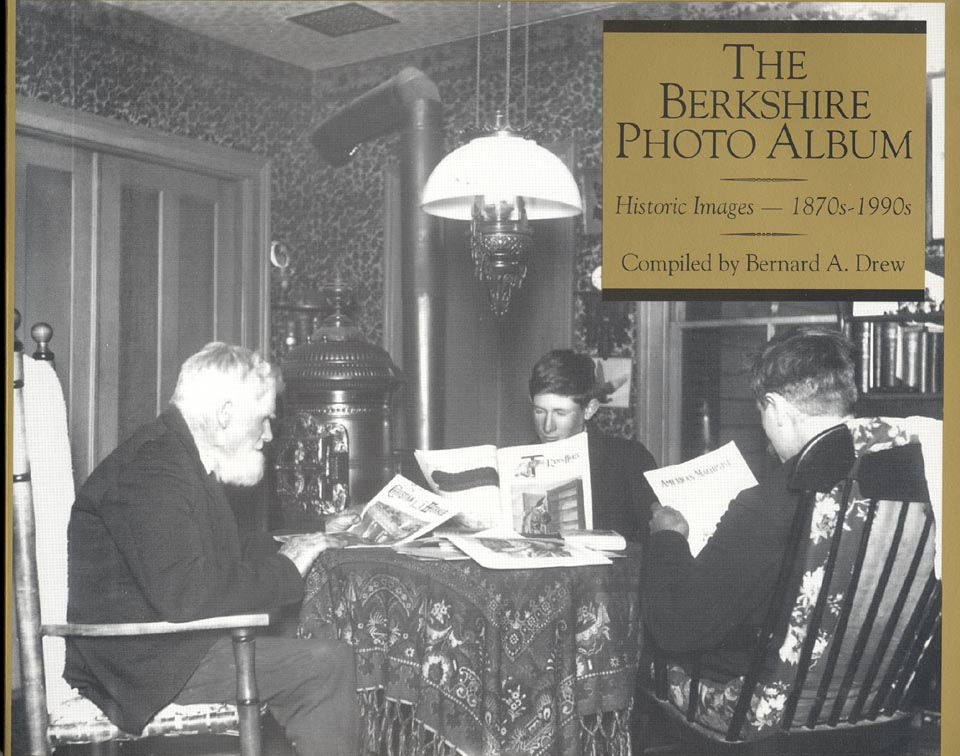
28114.
Drew, Bernard A., The Berkshire Photo Album –
Historic Images 1870’s – 1990’s. Pittsfield. 1999. 128p. A
wonderful collection of some 440 images from The Berkshire Eagle’s extensive
archive, this book provides a look at life, love, and labor during the last
century and a half in the two cities and thirty towns of Massachusetts’
western-most county. Many of the views are published here for the first time and
feature people, places and events both well remembered and long-forgotten.
Excellent New England reading. (M). $16.95
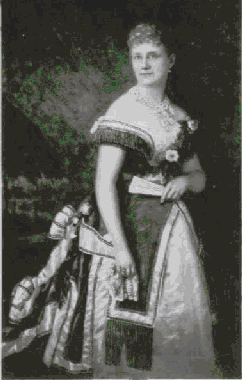
2890. Coston,
Martha J., SIGNAL SUCCESS. The Work and Travels of Mrs.
Martha J. Coston. An Autobiography. Kessinger. 2007. 333p. Reprint.
Soft wraps. Widow of the inventor of the Coston flares used extensively by the
Life-Saving Service, tells of her efforts to sell his night signals. Martha
Coston was born in 1826. Widowed at 21, she discovered her late husband's (a
former naval scientist) notes on the invention of a ship-to-ship, land-to-ship
pyrotechnic flare signal system. Martha Coston perfected AND then patented her
deceased husband’s idea for a pyrotechnic flare. Martha Coston developed the
idea into an elaborate system of flares called Night Signals that allowed ships
to communicate messages nocturnally. The U. S. Navy eventually bought the patent
rights to the flares. Coston’s flares served as the basis of a system of
communication that helped to save lives and to win battles. The Coston flare was
also used extensively by the U. S. Life Saving Service and later Coast Guard.
Martha Coston credited her late husband with the first patent for the flares,
but in 1871 she received a patent for an improvement exclusively her own. Her
system was also adopted by the governments of France, Italy, Denmark, the
Netherlands, and Haiti. As of the late 1970s, the Coston Supply Company
established by Mrs. Coston remained in business. This system of bright,
long-lasting signal flares revolutionized naval communication and continues to
be in use. (M). $36.
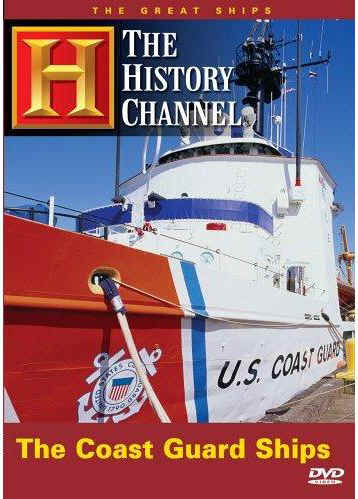
27459. (DVD) The Great
Ships - The Coast Guard Ships (History Channel) c.2005. New old
stock, factory seaeled, from program presented in 1997 on the History Channel
and A&E Home Video. The United States Coast Guard has policed the nation's
waters since the 1790s. From the first official vessels of the U.S. Government
to today's specialized lifesaving craft, the ships of the Guard have played a
vital role in maritime history. This in-depth program goes aboard some of the
many craft employed by the Coast Guard, from the small boats used for shoreline
rescue operations to the deep-sea patrol ships that form the vanguard in
America's war against drugs. See dramatic footage of real-life search and rescue
operations, and hear incredible stories of life-and-death missions from Coast
Guard sailors and officers. And trace the evolution of the Guards' ships from
the earliest Revenue Cutters to the myriad vessels of the modern force. The DVD
also presents the history of the Coast Guard including the U.S. Life Saving
Service and the Revenue Cutter Service to the present day cutters and boats.
Color and B&W. 50 minutes. (M) $24.95

27303. Wardius, Barb and Ken. WIND
POINT LIGHTHOUSE.
Arcadia
Publishing. 2007. 128 p. Soft wraps. Several lighthouses have called Racine
home, but none is more synonymous with the nautical heritage of the “Belle
City” than Wind Point. Always a beehive of activity, the Wind Point Lighthouse
is one of the larger lighthouse complexes on the Great Lakes, and a hardworking
keeper, two assistants, and their families made their livelihood here. For over
125 years, the tall stately tower has faithfully stood guard, shining its bright
beam out over Lake Michigan nightly. Countless mariners relied on the Wind Point
Lighthouse, along with a booming trademark foghorn for safe passage. Today the
Wind Point Lighthouse is the most well-known symbol of Racine and is a success
story among Great Lakes lights. The Wardiuses’ interest in lighthouses began
nearly 30 years ago and today, their prints and photos carry the island’s
history for future generations. Now they have put the rich lighthouse history
into a book, filled with more than 200 archival photographs of the light,
keepers and their families, equipment, everyday routines and more. Rare station
and crew images are especially noteworthy. (M). $19.99.
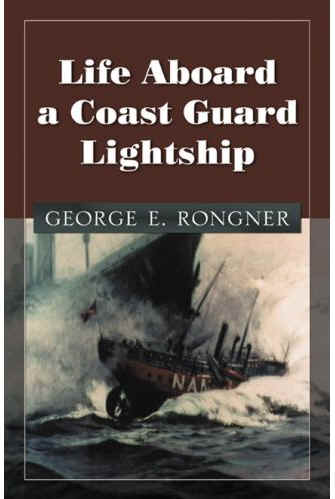
27301. Rongner, George E. LIFE
ABOARD A COAST GUARD LIGHTSHIP. Infinity Publishing. 2007. 247p. Soft
wraps. George E. Rongner served 32 years in the U. S. Coast Guard, enlisting as
a surfman and rising to Chief Warrant Officer. One of his many assignments
included ass Officer in Charge, Buzzards Bay Lightship. His readable account
chronicles the ceaseless dangers and constant tedium experienced by the men
living closely together at sea for such lengthy periods of time. He describes as
no outsider can, how they reacted to the routine, the piercing emanations of the
fog signal, and the perils from storms and passing vessels. Former lightship
sailor and anyone interested in the sea, will enjoy this look into the everyday
life aboard a Coast Guard Lightship. Nicely done, a great read. (M).
$14.95. Reduced $9.
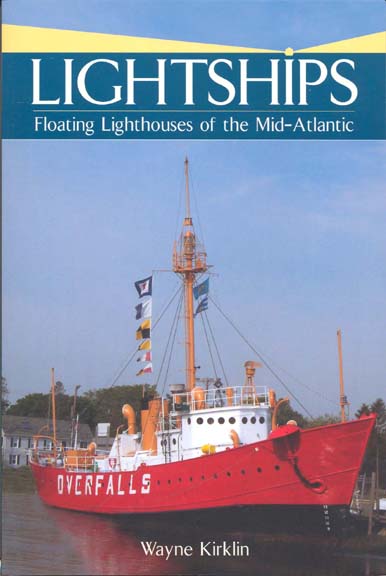
27296. Kirklin, Wayne. LIGHTSHIPS:
Floating Lighthouses Of The Mid-Atlantic. History Press. 2007. 128p.
Before radar, depth finders and satellite-guided navigation—before the
seafloor was charted with scientific precision—mariners had to rely on
alternative means to approach a coastline safely. Lightships played an
invaluable role in filling the void. In Lightships, author Wayne Kirklin
chronicles the heyday of these crucial navigational aids. (M). $19.99.
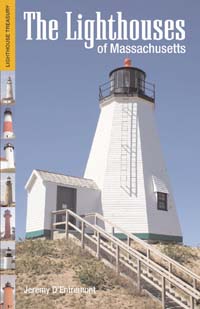
27330. D’Entremont, Jeremy. THE
LIGHTHOUSES OF MASSACHUSETTS. Beverly. 2007. Soft wraps. 240 p. With
The Lighthouses of Massachusetts, author Jeremy D’Entremonthe continues his
new series, "Lighthouse Treasury," which describes the fascinating
history of our American lighthouses, state by state. The author focuses on the
human side of lighthouse history, telling the tales of the courageous keepers,
male and female, and their families who kept the beacons burning, braved
ferocious storms, and saved hundreds of lives in the days when shipwrecks were
commonplace. In The Lighthouses of Massachusetts, D'Entremont continues his
definitive series, narrating the histories of more than sixty lights from
Buzzards Bay to Newburyport. The Lighthouses of Massachusetts is meticulously
researched and copiously illustrated, with photographs from the author's
enormous collection. (M). $21.95

27234.
Edgett, Ruth. A WATCH IN THE NIGHT: THE STORY OF
POMQUET
ISLAND
’S LAST LIGHTKEEPING FAMILY. Nimbus. 2007. Soft wraps. 196p. A
Watch in the Night chronicles the struggles of one
Nova Scotia
family to survive on a tiny windswept island without running water,
electricity, or reliable communication with the mainland. George and Ruth Millar
are in their twenties in April, 1924, when they set out with two small children
on their first rowboat voyage to Pomquet Island, half a mile off Bayfield on the
southern shore of St. George’s Bay, Nova Scotia. They will spend the next
thirty-six years raising children and keeping the light on this bleak teardrop
of land. There they will raise generations of livestock, brought up their 6
children, and lived through violent storms and other weather disasters. A Watch
in the Night is not a dry account of light-keeping life, but rather a tale in
which faith, ingenuity, and tenderness triumph over adversity. A Watch in the
Night takes the reader on a memorable voyage through a vital period of Atlantic
Canadian history with one extraordinary light-keeping family. (M). $19.95.
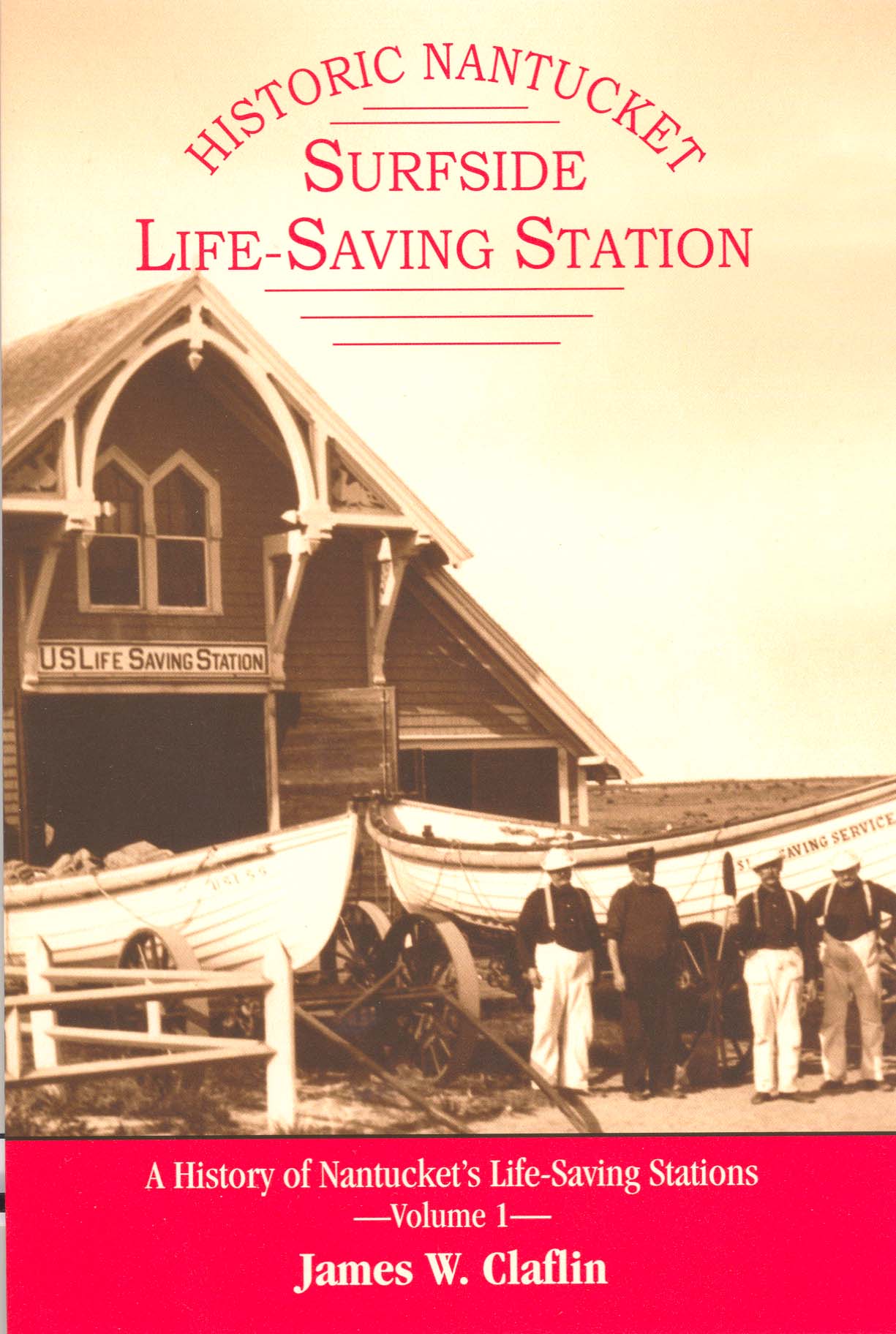
27268.
Claflin, James W. HISTORIC NANTUCKET: SURFSIDE
LIFE-SAVING STATION - A History of Nantucket’s Life-Saving Stations.
Volume I. Worcester. 2007. 64 p. Soft wraps.
Historic Nantucket: Surfside Life-Saving Station is one of a continuing series
of booklets that tell the story of historic lighthouses, lightships and
life-saving stations along the New England
Coast
. The Nantucket coastline has long been one of the most dangerous areas along
the New England
coast. Over the years four life-saving stations and eight Massachusetts Humane
Society stations stood guard over the island’s shores, standing ready to
combat the seas in an effort to rescue shipwrecked mariners in their time of
need. With thousands of vessels plying the dangerous waters, the chance of a
shipping disaster was always great. Hundreds of shipwrecks did indeed occur off
the coast with startling losses. Using descriptive text and a variety of vintage
images from private as well as museum collections, we get a rare glimpse into
the history of the area and the lives of these dedicated government men and
women. Author James Claflin combines an extensively researched text with his
exquisite collection of vintage photographs, many previously unpublished, to
tell the story of this important piece of history. (M). $8.95.
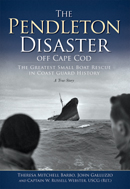
27259.
Barbo, Theresa M., John J. Galluzo and W. Russell Webster. THE
PENDLETON DISASTER OFF CAPE COD: THE GREATEST SMALL BOAT RESCUE IN COAST GUARD
HISTORY. History Press. 2007. 128p. Soft wraps. Late in February
1952, a northeaster swept
New England
with bitter cold, snow and gale force winds. East of Chatham 70-knot winds and
60-foot seas battered merchant vessels as the tankers SS Fort Mercer and SS
Pendleton met the full force of the storm. They both broke in two on the morning
of February 19th with 84 half-frozen men marooned on the battered hulks. Four
Coast Guardsmen set out from Cape Cod during a fierce storm in a seemingly
impossible quest to locate and rescue the crew of the damaged tanker Pendleton.
They returned as heroes. This book chronicles the miraculous true story of
Bernie Webber and the Coast Guard 36500. The story of how these men were rescued
is retold even today. $19.99.

27223.
Sutherland, Kenneth G. UNITED STATES COAST GUARD HARBOR
PATROL FLEET 1924-1980. Bloomington. 2007. Soft wraps. 248p. One of
the most important activities of the U.S. Coast Guard is Port Security under the
control of the Captain of the Port. This book is a first attempt to collect and
share data on the various types of small boats used by the C.O.T.P. On
June 15th, 1917, Congress passed the Espionage Act, forming the basis for the
Coast Guard's Port Security and Port Safety Missions and by 1918, jurisdiction
over the anchorage and movement of vessels in harbors changed from the War
Department to the Treasury Department, with Coast Guard officers as Captains of
the Ports. The U. S. Coast Guard's Port Security Small Boat Stations and Units
have a long and proud tradition of duty and service, from enforcing the rules
and regulations to anti-sabotage patrols, search and rescue, fire-fighting, and
placing marine inspection teams aboard large supertankers underway in all
weather conditions. Covering the period from 1924-1980, this book provides the
first look at the variety of craft used to carry out these missions. (M).
Published at $34.99. Our price $31.99.
 
27171.
Hall, Thomas. THE T.W. LAWSON: THE FATE OF THE WORLD'S
ONLY SEVEN-MASTED SCHOONER.
Charlestown
. 2006. 160p. Soft wrtaps. Over 70 images. Armed with curiosity and a desire to
piece together the story of the world’s only seven-masted schooner, Tom Hall
spent years researching, diving on the Lawson wreck and interviewing the
relatives of those involved in the rescue efforts. The result of his work is the
most complete account of the T.W. Lawson’s story, ranging from her building
and launch in
Massachusetts
to her fated wreck off the Scilly Isles. Wonderfully illustrated, a joy to
peruse. (M). $21.99.
27155. Waugh, Chris. MISTY MEMORIES OF GUARD ISLAND,
ALASKA – Ketchikan’s Legacy of a Lighthouse Family.
Newport
. 2006. 135. Soft wraps. In 1952 the author’s young family moved to tiny Guard
Island Light Station, 12 miles northwest of
Ketchikan
,
Alaska
. As a child, Chris lived at this isolated lighthouse island for almost two
years. Her parents related the details of their lives there, and her father took
pictures to document them. This story is about their life, laughter and tears as
they lived in confinement and isolation. It's also about going back, which they
did more than fifty years later. (M). $14.95.

27179b.
Kroll, C. Douglas. COMMODORE ELLSWORTH P. BERTHOLF –
First Commandant of the Coast Guard. Annapolis. 2002. 160p. DJ.
Written by a former Coast Guard officer, the book chronicles Bertholf’s
colorful early career with the service when he patrolled the vast reaches of the
Pacific, enforced maritime laws regulating the fishing, sealing, and whaling
industries, participated in daring rescues, and transported Siberian reindeer
from Russia to the starving Inuits. When Ellsworth P. Bertholf was
court-martialed and dismissed from the Naval Academy for a hazing incident, no
one could have predicted his future greatness. But undaunted by his experience
at the academy, Bertholf pursued a career in the U.S. Revenue Cutter Service and
by 1902 had earned a special Gold Medal of Honor from the U.S. Congress for his
role in a dramatic overland relief expedition to Alaska. By 1915 he had bypassed
twenty-two officers senior to him to become the first commandant of the U.S.
Coast Guard and went on to successfully steer his fledgling service through the
trials of World War I. This biography of the man who has been called the savior
of the Coast Guard offers a revealing portrait not only of Bertholf but also of
the last years of the Revenue Cutter and Life-Saving Services and the early
formative years of the Coast Guard. (F). $49.95.

27201.
Pinyerd, David. LIGHTHOUSES AND LIFESAVING ON THE
OREGON COAST. 2007. Arcadia Publishing. 128 p. Soft wraps. 200
vintage photographs. The Oregon Coast has been the site of shipwrecks even
before Lewis and Clark’s arrival in 1805. Even as the population grew, the
federal government let the Oregon Coast go unguarded by lighthouses and
lifesavers for decades. Economic and political pressures finally forced the
government to build the first Oregon lighthouse in 1857 at the Umpqua River. The
LifeSaving Service followed in 1878 with a station at the mouth of Coos Bay.
Eventually, most of the harbor entrances and headlands were protected by both
the Lighthouse Service and the LifeSaving Service, the precursor to today’s
Coast Guard. Lighthouses and Lifesaving on the Oregon Coast commemorates the
true heroes who served to warn, protect, and rescue those who went to sea.
Another in the series from
Arcadia
, a well known publisher of local and regional histories, this volume draws
from public and private collections, most never before published. Superb
photographs, well worth it. (M). $19.99
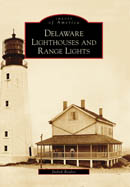
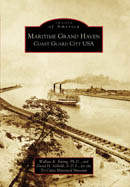
27200.
Roales, Judith. DELAWARE LIGHTHOUSES AND RANGE LIGHTS.
2007. Arcadia Publishing. 128 p. Soft wraps. 200 vintage photographs. Delaware
does not usually come to mind as one of America’s great maritime states. Yet
it has a long history of “firsts,” innovations, and improvements in
lighthouse construction and technology dating from the beginning of lighthouse
history in the United States. One of the original six lighthouses built before
the founding of this country was in Delaware. In the following years, major
offshore lighthouses and an extensive system of range lights were established.
At the height of its lighthouse history, Delaware had 27 manned light stations
that warned mariners of the shoals and colliding currents at the mouth of the
Delaware Bay and guided ships safely from the Atlantic Ocean to the inland ports
of Wilmington and Philadelphia. Most of Delaware’s lighthouses are gone now,
preserved only in faded photographs and yellowed documents such as those
collected here. The lights that remain struggle daily to survive the punishing
hands of vandals and Mother Nature. Another in the series from
Arcadia
, a well known publisher of local and regional histories, this volume drawns
from public and private collections, most never before published. Superb
photographs, well worth it. (M). $19.99
27199.
Ewing, Wallace K and David H. Seibold. MARITIME GRAND
HAVEN: COAST GUARD CITY USA. 2006. Arcadia Publishing. 128 p. Soft
wraps. 200 vintage photographs. Settlers arrived at the mouth of the Grand River
on November 2, 1834. Their community was christened Grand Haven, as it offered a
secure harbor. As the logging industry grew, shipping expanded, and Grand Haven
Harbor became especially busy during the financial boom and westward expansion
that followed the Civil War. Northwest Ottawa County became an established
resort destination, and passenger boats frequented the harbor as well. Heavy
traffic through Grand Haven caused concern about shipwrecks. The first crew of
lifesavers was formed in 1871 and soon joined the United States Lifesaving
Service. In 1915, the United States Lifesaving Service merged with the United
States Coast Guard. Grand Haven has long had a proud association with these
dedicated crews, and in 1998, the relationship was marked when Congress
designated it “Coast Guard City USA.” Another in the series from
Arcadia
, a well known publisher of local and regional histories, this volume drawns
from public and private collections, most never before published. Superb
photographs, well worth it. (M). $19.99

26323.
Trapani
, Robert Jr.
DELAWARE
LIGHTS – A History of Lighthouses in the
First
State
. History Press. 2007. 160 p. Soft wraps. In Delaware Lights, this
noted author recounts the stories of twenty-seven beacons from the lost Cape
Henlopen Light Station, completed in 1767, to the Marcus Hook Range Rear Light
Station, constructed in 1920. He not only discusses their construction and the
changes they have undergone, but also tells dramatic tales of their keepers, who
sometimes braved storms, isolation and poor conditions so that the lights would
stay burning for those at sea.
Trapani
also brings
Delaware
’s lighthouse history full circle by conveying to the reader that though these
guiding beacons are now automated and aging, the lights are hardly finished
making history here in the 21st century. (M). $19.99.

27101. Szelog, Thomas and Lee Ann Szelog. OUR
POINT OF VIEW – Fourteen Years at a Maine Lighthouse. Down East
Books. 2007. 112p. DJ. Beautifully illustrated with 106 color photos by the
authors. Our Point of View offers moving personal glimpses about living in a
lighthouse keeper's home, as well as arrestingly beautiful visual images of the
lighthouse and property and views from this one-of-a-kind vantage point. Tom
and Lee Szelog were the first tenants to live in the newly renovated former
lightkeeper’s house at Marshall Point Light in Port Clyde, Maine. Being a
professional photographer, Tom naturally kept a visual record of their years at
Marshall Point. Both of the Szelogs also kept personal journals, and when the
time came to put together a record of their time in this most remarkable home,
they delved back into their journals, selecting the most vivid and interesting
recollections to share with their readers. After nearly 14 years at the Marshall
Point light-keeper’s house, the Szelogs moved to their current home in
Whitefield, Maine where they bring this glimpse of their lighthouse life to you.
(M). $24.95.
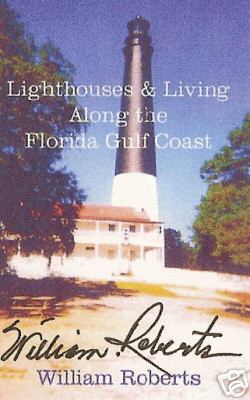
27108. Roberts, William. LIGHTHOUSES
AND LIVING ALONG THE FLORIDA GULF COAST. Bloomington. 2005. 97p. Soft
wraps. Signed by the author. Here is a true story of the Roberts family's three
generations of lighthouse keepers in the U. S. Lighthouse Service. Their
dedication and devotion began in 1894 when grandfather was assigned to the Cape
St. George Lighthouse in Apalachicola, Florida, and lasted over fifty-eight
years and three generations. This account, recorded by a family member, includes
their lighthouses, family lives, maintaining and operating the
lighthouses, as well as childhood stories of his growing up on lighthouse
stations during the depression years of the late 1920's and 1930's. (M). $21.95.
 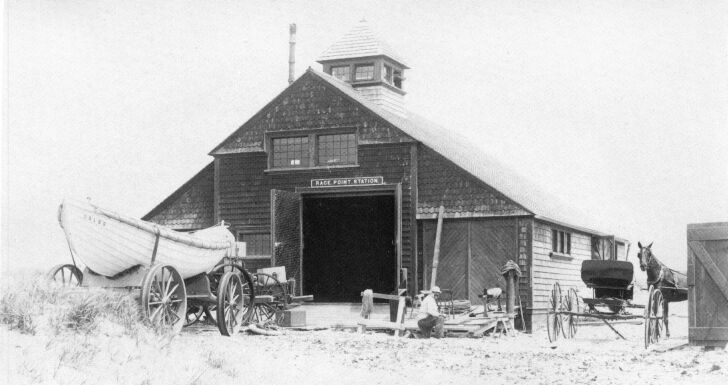
2790.
Dalton
, J. W., THE LIFE SAVERS OF
CAPE
COD
. 1902. Reprint 1991. Parnassus. 155p. Soft wraps. Profusely illustrated with over
100 fine b/w photographs, illustrations and maps, this is certainly the finest
and most complete history of the Life-Saving Service and its 13 posts on the
outer reaches of Cape Cod ever written. The Life Savers of Cape Cod brings to
life a unique age of heroism along the treacherous shores of Olde Cape Cod. In
1902, writer J. W. Dalton set out to visit each of the thirteen U. S.
Life-Saving Service stations on Cape Cod, from Wood End in the north to Monomoy
Point in the south. His book, The Life Savers of Cape Cod, published late that
year, remains the most minutely detailed account of station life at the high
point of the service's existence. Dalton's research covers not only the history
of the service and descriptions of each station, but also provides a paragraph
on each and every keeper and surfman then serving along the Cape's seashore.
Also included is information on the men, equipment, construction and
modifications of the buildings, rescues, even entries on the names and
habits of the stations' pets. Included too is the account of Keeper Seth Ellis
of the Monomoy station, lone survivor of the life-saving disaster of the
previous March 17. Excellent reading on the subject, wonderful
photographs. (M). $9.95.

26315. Wermiel, Sara E. LIGHTHOUSES:
Norton/Library of Congress Visual Sourcebooks in Architecture, Design &
Engineering. New York. 2006. 384 p. DJ. This pictorial survey of the
icon of steadfastness and strength: the American lighthouse, is the newest
addition to the Norton/Library of Congress series. This abundantly illustrated
book conveys the romance and beauty of lighthouses and beacons while explaining
the development of the forms, materials, architecture, and engineering of their
structure: wood, masonry, cast-iron plate, on- and off-shore skeletal, caisson,
and reinforced concrete. It covers lighthouses from all parts of the United
States from the late eighteenth century to the 1940s, when control of
lighthouses was transferred to the U.S. Coast Guard. Numerous images of
lighthouses from coast to coast provide examples of striking design and setting,
celebrate technological achievement and the work of important engineers, and
include associated structures such as keepers' quarters, fog signal buildings,
boathouses and boat railroads, cistern buildings, barns, and workshops, as well
as interiors and working details of the light mechanisms. With over 1200
illustrations, many of rarely seen views, this is sure to be one of the better
books this year. Includes CD-ROM containing all of the images shown in the book
for even better viewing. (M). Publisher’s price $75. Our price $69.95.
2743. Fredrickson, Arthur C. and Lucy F. FREDRICKSON'S
HISTORY OF THE ANN ARBOR AUTO AND TRAIN FERRIES - Complete With Pictures. Frankfort.
1994. 158 p. Soft wraps. The carferries came in, and during their brief stay
they did so much to develop our present system of transportations, and then were
so easily forgotten after they had gone. The facts in this history of Ann Arbor
carferries have come from notations in the many log books of these little known
vessels. The stories built around these facts were furnished by the knowing
seafaring men who were present at these times. As many of these men have long
since passed on, these stories are all the more valuable. (M). $9.95.
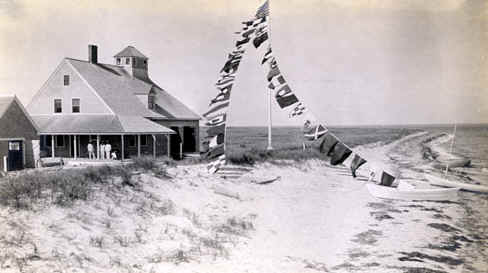
726b. Coffin, Edward Wayman.
NANTUCKET
’S FORGOTTEN
ISLAND
- MUSKEGET. [self published] 1996. 114p. Soft wraps. Autographed by
author. Lying northeast of
Nantucket
, just eight miles from
Martha’s Vineyard
, Muskeget is a low bleak island, ringed with sandy shoals and often entrapped
by foul weather. Often ice bound in winter with high tides, Muskeget was the
scene of many shipwrecks through the years. Its population consisted of the men
of the Life-Saving Station with only seasonal increases by the local Island Club
gunners taking advantage of the prolific fowl population. This unusual book is
written from the point of view of an islander and a surfman (the author’s
father served on the island as a surfman). The book relates many interesting
tales formerly untold - fully 60% of the book tells of the surfmen and their
daily lives, with interesting comments on the life and recreation of the
seasonal population. Also included are many rare photographs from private
collections. Privately published in a very limited quantity (only 490 printed,
quite difficult to find now. (VG+). $36.
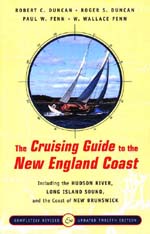
26348. Duncan, Robert C., Roger S.
Duncan, W. Wallace Fenn, and Paul W. Fenn THE CRUISING
GUIDE TO THE NEW ENGLAND COAST- Including the Hudson River, Long Island
Sound, and the Coast of New Brunswick. New York. 2002. Twelfth
Edition 827p. DJ. Here, entirely updated, is the latest edition of the
most complete, authoritative cruising guide to the northeastern coast. The
bible for Eastern sailors and power boaters for more than half a century has
been thoroughly overhauled and expertly refitted. For the preparation of the
twelfth edition, the authors visited nearly all the harbors, talked with
harbormasters and marina owners, and reevaluated earlier judgments. The Guide
tells you how to dodge bad currents and edge around shoal water, and where to
anchor and find essential services, including pump-out stations, fuel docks, and
a hot shower. It notes channels and harbors that have been dredged or shoaled
up; recently replaced buoys; and changes in marinas, boatyards, and other
facilities. This guide is far more than a traditional cruising guide,
providing valuable information on weather, tides, coastal geography and geology,
fog, marine birds, animals, sea conditions, and even places of historical
interest ashore. The authors—who know these great cruising grounds as old
friends—relate the histories of the towns, ports, vessels, lighthouses, and
even rocks you'll encounter. Black-and-white photographs and maps throughout.
(M). Published at $49.95. Our price $45.
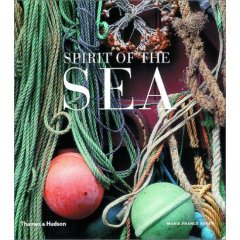
26349. Boyer, Marie-France. SPIRIT
OF THE SEA. New York. 2003. 120p. DJ. The cry of a seagull, a plume
of spray, the bright pink of a plastic float, boxes of glittering fish on the
quay, fishermen's wooden sheds—all these stir in us deep memories of the sea.
Marie-France Boyer takes us on a voyage to fishing communities along the coasts
of the North Atlantic and the shores of the Channel and the North Sea. She takes
us to the heart of our collective memory, gathering traces of this separate
seagoing world, which is both familiar and romantic. Lines, nets, lobster pots,
marker flags, buoys, and anchors—from Boulogne to Birarritz, from Fécamp to
the Ile d'Ouessant, from Maine to Norfolk, there remains an ancient repertoire,
a visual imagery of richness and power. This book celebrates the harsh and
singular world of fishermen, and reveals the poetry of the everyday. 147
illustrations, 131 in color. (M). $24.95.

26299. Hoyt, Susan Roark. LIGHTHOUSES
OF NORTHWEST MICHIGAN. Chicago. 2004. 128 p. Soft wraps. Lighthouses of Northwest Michigan is a companion to
the author’s first work Lighthouses Of Southwest Michigan. This work completes
the history, covering the lighthouses on Lake Michigan’s eastern shore. When
settlers first reached this area, rudimentary harbors in this area made docking
and loading hazardous while shoals and reefs, hidden beneath the water's
surface, threatened to ravage the unsuspecting vessels. The need for lighthouses
to mark these dangerous waters and harbor entrances was crucial to prevent the
loss of lives and valuable cargo. Through a rare collection of archival
photographs, this book explores these fascinating structures and the people who
maintained them. (M). $19.99.

26300. Muller, Robert G. NEW
YORK STATE LIGHTHOUSES. Chicago. 2004. 128 p. Soft wraps. New York State Lighthouses explores the great
lighthouse heritage of New York State. Second only to Michigan in the number of
lighthouses it contains, New York boasts a lighthouse legacy that stretches from
the Great Lakes to the tip of Long Island. Many of these lighthouses, even some
no longer in existence, were photographed for use on early postcards and these
images are assembled for the first time in the pages of this book. The
culmination of over five years of research and study, this work provides a most
interesting view of New York’s many light stations. (M). $19.99.

26281. (DVD) War
Zone - World War II Off North Carolina’s Outer Banks. A film by
Kevin Duffus. In 1942, the United States suffered one of its worst defeats of
WWII, not in Europe or the Pacific, but along the nation’s eastern seaboard.
Three hundred ninety-seven ships were sunk or damaged and nearly 5,000 people
were killed. For six months, 65 German U-boats hunted merchant ships practically
unopposed within view of coastal communities. The greatest concentration of
these attacks occurred off North Carolina’s Outer Banks. “War Zone”
features eyewitness accounts of lifesavers, merchant sailors and residents, and
describes how life was altered when war was waged on Outer Banker’s doorsteps.
Learn the truth behind decades-old urban legends of German spies, saboteurs and
sympathizers. Viewers will marvel at the courage of a young mother who delivered
her newborn son in a storm-tossed lifeboat off Cape Hatteras and how the event
marked a turning point in the battle of “Torpedo Junction.” Most amazing is
the first-hand account of the nearly calamitous first engagement between a
U-boat and a U.S. Navy destroyer, and the sinking of the U-701, just 22 miles
from Hatteras. “War Zone” is a story of infamy, irony, and innocence lost.
180 minute 2-DVD Set $19.95.

Just Out. 26143. Porter, Jane Molloy. FRIENDLY
EDIFICES: PISCATAQUA LIGHTHOUSES AND OTHER AIDS TO NAVIGATION 1771-1939.
Portsmouth. 2006. 568 pp. Cloth covered. 168 illustrations. The five lighthouses
of the Piscataqua region of New Hampshire and Maine are among the most admired
structures of their type in America - Nubble Light, York, Maine; Boon Island
Light, Maine; Whale’s Back Light, Kittery, Maine; White Island Light, Rye, New
Hampshire; Fort Constitution Light, New Castle, New Hampshire. The construction
of a lighthouse is not a simple matter. In addition to being able to project a
warning light, the structure also must be able to withstand the foul coastal
weather, especially here where the North Atlantic brings crashing waves and
strong winds. Before a lighthouse could be built, funds had to be authorized
usually from public sources, and politicians, whether local or state or
national, had to be convinced that the expenditure is warranted. After
lighthouse specifications were written, contractors had to carry out those
plans. Bricks, wood, iron, and steel have supported the local lights for
centuries, although four of the five lighthouses have been replaced at least
once. Finally, the lights had to be maintained, a task originally charged to a
keeper and often his family lived with him. In addition to the extensive details
about lighthouse construction, maintenance, and operation, the author also
discusses the design and placement of various aids to navigation, such as the
river and ocean buoys that protect mariners from hidden rocks and ledges, fog
signals, and breakwaters that created safe harbors. Chock full of superb
information, vintage as well as color images and much more will keep you
engrossed for many hours. If you get only one book this year, this should be the
one. (M). Published at $34.95. Our price $32.95.

26264. Snyder, James D. A
LIGHT IN THE WILDERNESS The Story of the Jupiter Inlet Lighthouse & the
Southeast Florida
Frontier. North Pa
lm Beach
. 2006. 287p. DJ. Filled with vintage photographs. In his fourth book about
South Florida’s rich history, James D. Snyder explores the role of the Jupiter
Lighthouse and how it transformed the southeastern coast of
Florida
. $35,000 was provided by Congress in 1853 for establishing a lighthouse “near
Jupiter inlet, to mark the dangerous shoals lying of that point, and to guide
vessels along that coast.” With the completion of the lighthouse plans, five
hundred tons of building materials were assembled and shipped to the Indian River
inlet using shallow draft scows. However, in 1855, just as construction on the
tower had started, a group of careless surveyors in the Everglades
destroyed the prized banana plants of Chief Billy Bowlegs, touching off the
Third Seminole War. Despite these difficulties, and a combination of malaria and
yellow fever, brick by brick, the tower slowly rose to its preordained height of
108 feet. A two-story dwelling for a head keeper and two assistants was built
near the base of the hill in 1859. After $60, 859.98, almost twice the original
appropriation, was spent on the construction work, the lighthouse finally
commenced operation on July 10, 1860. With more than seventy rare photos, maps
and letters, Mr. Snyder will describe how the lighthouse construction
progressed, and how the region survived the aftermath of the Civil War and built
the steamboat-railroad link that brought the first influx of pioneers to this
“Garden of Eden.” (M). $27.95.
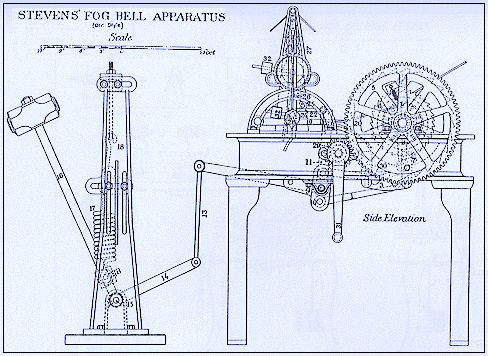
26212. Tag, Thomas A. CHURCH
STEEPLES AND FOG SIGNALS. Dayton. 2006. 20p. Spiral bound. Thomas Tag
has long been probably the only authority on lamps, lens apparatus and
illumination for lighthouses, with his articles on the subject appearing in our
catalogue, as well as the U. S. Lighthouse Society’s Keeper’s Log,
Lighthouse Digest and other publications. Now Tom has added still another volume
to his list of publications – Church Steeples and Fog Signals. This detailed
account covers a long neglected area of lighthouse equipment – the mechanical
weight-driven fog bell strikers. The author covers a history of fog bells, bell
construction, wave actuated bells and clockwork-striking machinery. Included are
Lowell Fog Bell Strikers, Custer Strikers, Daboll Strikers, Stevens, Gamewell,
and more. Thoroughly illustrated with early photographs and drawings, this
booklet makes most interesting reading. (M). #26212 $26.

26239. Butts, Ed. GUIDING
LIGHTS TRAGIC SHADOWS. Toronto. 2006. 272p. A peaceful lighthouse at
Prescott, Ontario, was once the flashpoint of American invasion in an undeclared
war. Robbers called "Blackbirds" preyed on Lake Erie shipping, using
false beacons to confuse their victims. The lighthouse at Oswego, New York, was
the site of one of the worst disasters in the history of the United States Coast
Guard. A Lake Huron lightkeeper wiped snow off the window of his lamp room, and
inadvertently caused a shipwreck. A 14-year-old Detroit River lightkeeper¹s
daughter was the heroine in a courageous rescue. Lighthouses, from the Upper St.
Lawrence River to the head of Lake Superior, have played an integral role in the
history, romance, lore and legends of the Lakes. The towers and their keepers
bore witness to, and participated in, the dramas of war, shipwrecks, and daring
rescues. All while enduring the privations of one of the loneliest occupations
on earth. $24.95
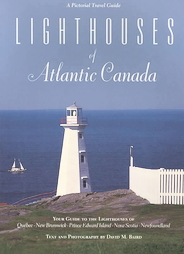
26236. Baird, David. LIGHTHOUSES OF ATLANTIC
CANADA. 240p. Calgary. 2003. Soft wraps. This colorful book traces
the origins of more than 250 lighthouses from the beginning to the present day.
This expansive volume is packed with more than 350 photographs and illustrations
depicting light stations from the famed Peggy's Point to more remote outposts.
Includes some great vintage photos, as well as views of lanterns, lenses and
more. Also included are access maps and driving instructions for visiting the
lighthouses. Highly recommend. (M). $24.95.

26208. Wardius, Barb and Ken. CANA
ISLAND LIGHTHOUSE. Arcadia Publishing. 2006. 128 p. Soft wraps. The
beautiful peninsula of Door County has a long and bountiful tradition of
maritime history, including its many lighthouses, and the Cana Island has
illuminated the coastline on the Lake Michigan side of Door County for over 100
years. The Cana Island Lighthouse is one of the most picturesque of any
lighthouses still operating on the Great Lakes today. The Wardiuses’ interest
in lighthouses began at Cana Island nearly 30 years ago. Today, their prints and
photos carry the island’s history for future generations. Now they have put
the island’s rich lighthouse history into a book, filled with more than 200
archival photographs of the light, keepers and their families, equipment,
everyday routines and more. Rare station and crew images are especially
noteworthy. (M). $19.99.

26211. LaGuardia-Kotite, Martha J. So
Others May Live – Coast Guard Rescue Swimmers: Saving Lives, Defying Death.
Guilford. 2006. 208p. DJ. So Others May Live is the untold story of the U.S.
Coast Guard’s quiet but resolute rescue swimmers. From deep ocean caves on the
Oregon coast to the panicked and chaotic streets of post-Katrina New Orleans,
here are their stunningly heroic stories and the greatest maritime rescues
attempted since the program began in 1985. These feats, told through the eyes of
the heroes, reveal an understanding of how and why the rescuer, with flight crew
assistance, risks his or her own life to reach out to save a stranger. The book
covers diverse environments: oceans, hurricanes, oil rigs, caves, sinking
vessels, floods, and even Niagara Falls. It is truly a can’t-put-it-down
collection of accounts. (M). ). Published at $22.95. Our Price $21.95.

26193. DeRaps, Ernest G. (US Coast Guard, Retired)
and Pauline E Fitzgerald DeRaps. LIGHTHOUSE KEEPING /
LIGHT HOUSEKEEPING. Wells. 2006. 128 p. Soft wraps. Two lighthouse
books in one - FogHorn Publishing has just released a very unique book, which is
actually two books in one, of the memories and stories of lighthouse life from
the first hand accounts of a family that actually lived the lighthouse life.
This unique book is written with two titles - Lighthouse Keeping, by Coast Guard
Keeper Ernest G. DeRaps and Light Housekeeping, by his wife Pauline DeRaps. This
wonderful book, depicting the DeRaps’s family life on three Penobscot Bay
Maine lighthouses and Ernest’s life at a stag station south of Vinalhaven,
Maine. It is packed with amazing and heartwarming stories that are more than
just a “good read”. In fact, we’ll bet that you won’t be able to stop
reading once you start. First you can read Ernest DeRaps stories as he recalls
the life of a lighthouse keeper. His stories are intertwined with his own
original pen & ink sketches of life at the lighthouses. After reading
Ernest’s side of the story and viewing the full color photos, you will then
need to flip the book 180 degrees and read Pauline’s side of the story for an
entirely different perspective of the same events and stories. This book is a
must have for a lighthouse aficionado. (M). $19.95.

26148. Mills, Chris. LIGHTHOUSE
LEGACIES. Halifax. 2006. Imagine living your life perched on a tiny
island, without electricity, exposed to the fury of the sea, and always at the
service of the mariner. This is how lightkeepers and their families spent their
lives, even up until the 1960s. We are very close to losing the last of the
people who lived this isolated life and experienced the heyday of lightkeeping
in Canada. Lighthouse Legacies lets us share in the memories of those who kept
the lights. These stories are presented largely in the words of the people, with
context and history by author Chris Mills. Each chapter deals with an element of
lighthouse life and is complemented by photos from lighthouse family
collections, the Coast Guard and Mills’ own collection. Great reading. (M).
$24.95
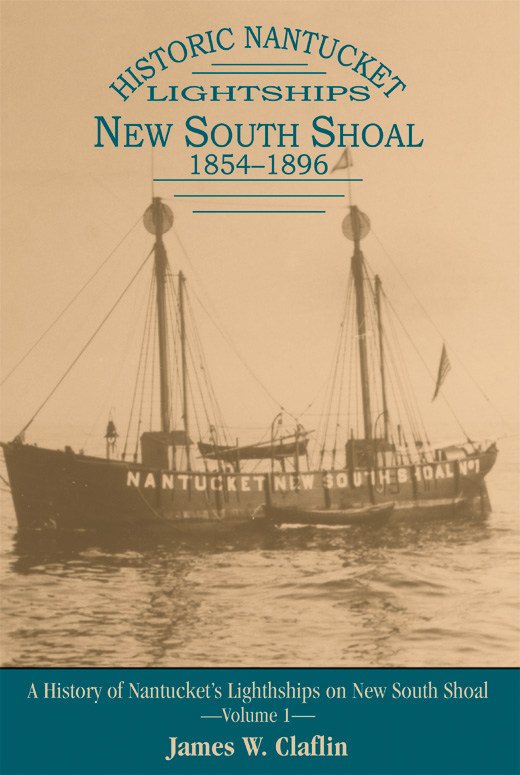
Claflin, James W. HISTORIC NANTUCKET
LIGHTSHIPS: NEW SOUTH SHOAL 1854-1896. 72 pages. 20 vintage photos. Worcester. 2005. $8.95
Other
titles in this series include: Brant Point Lighthouse, Sankaty Head Lighthouse,
Great Point Lighthouse, Race Point Lighthouse.
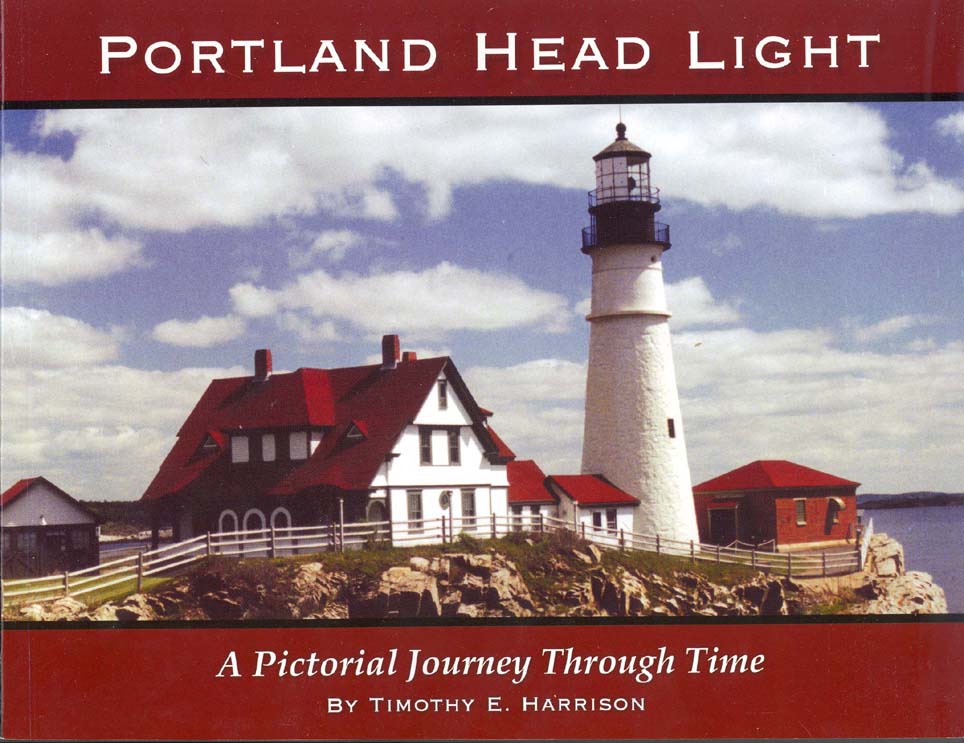
Just
Out. 26135. Harrison, Timothy E. PORTLAND HEAD
LIGHT - A Pictorial Journey Through Time. Wells. 2006. 154 p.
Soft wraps. 8 ½” x 11”. An unusual format, this detailed work by noted
lighthouse historian and writer Tim Harrison utilizes over 100 early
photographs, postcard views and other images to detail the lives of the keepers
of Portland Head Light, from the days of the U.S. Lighthouse Service to the days
of U.S Coast Guard and then the present. Superb accounts by keeper and author
Robert Sterling, as well as members of the Strout family, who kept the light at
Portland Head for over 100 years, make this a most interesting read. Includes
many early, rare photos, memories and storied about the keepers and their
families, their pets, work and improvements to the station over the years, and
much more. (M). $24.95
26164. Kellogg, James [ed]. Burke, Harry Rosencrans.
FROM
THE DAY’S JOURNEY. St. Louis. 2006. 129p. Soft wraps. Harry
Rosecrans Burke worked as a newspaper reporter and later editor in rural Iowa,
Oregon, Idaho and California from 1915 until his retirement in the 1950’s. In
1924 he completed his book of essays on local St. Louis history in his book From
the Day's Journey. Here local author and historian James Kellogg has republished
this rare work giving us the opportunity to look through this window into the
past. Burke's original essays about St. Louis locales from the 1920s and '30s
have been expanded by the author’s notes and recollections as he revisits many
of the same places and subjects to add his own updates to the material.
(M). $39.95.

1259. na. Lighthouses of
the World. International Association of Marine Aids to Navigation.
1998. Globe Pequot. 172p. Soft wraps. Absolutely stunning, full-color guide
showcases more than 125 unique lighthouses from around the world. Includes full
color photos throughout, country-by-country listing, with detailed maps, general
and historical descriptions, information on architects ands builders,
construction, locations, and more. (M). $24.95.

2699. D’Entremont, Jeremy. THE
LIGHTHOUSES OF RHODE ISLAND. Beverly. 2006. Soft wraps. 240 p. With
The Lighthouses of Rhode Island, author Jeremy D’Entremonthe continues his new
series, "Lighthouse Treasury," which describes the fascinating history
of our American lighthouses, state by state. Read about: A feud between two
keepers at Whale Rock Light led to a harrowing life-and-death chase; The
hurricane of 1938 devastated the state's lighthouses. The keepers at Plum Beach
Light off North Kingstown miraculously escaped with their lives; others weren't
so lucky; Ida Lewis lived at Newport's Lime Rock Light for more than 60 years
and became one of the world's most celebrated lightkeepers; The keeper and his
family at Block Island North Light aided the survivors of one of New England's
worst shipwrecks, the Larchmont disaster of 1907; Pomham Rocks Light on the
Providence River was home to a famous fish-catching cat; and much more. The
Lighthouses of Rhode Island is meticulously researched and copiously
illustrated, with photographs from the author's enormous collection. (M).
$14.95
Once
Again Available:
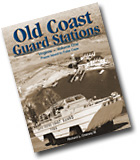
8207.
Chenery, Richard L. III., OLD COAST GUARD STATIONS
VOLUME I – VIRGINIA:
POPES
ISLAND
TO FALSE
CAPE
. 2004. 2nd. 94p. Soft wraps. 70 photographs and illustrations.
Just Released by well known author Richard L. Chenery, III. In this first of a
series, Mr. Chenery provides wonderful details about the little known early
years of the Coast Guard. Included are recollections of veteran surfmen,
surfmen’s uniform and insignia, beach apparatus drills, covers the Early Coast
Period from 1915 to early 1960’s, details surfboats, motor lifeboats and DUKWs,
pulling boat drills and races, WW II beach patrols, Life-Saving Branch, and much
more…Mr Chenery has been researching the early Coast Guard for a number of
years and has a particularly fine knowledge of early uniforms and insignia, as
well as stations and equipment. In Volume I he covers the lifeboat stations in
Virginia
in wonderful detail, with excellent photos and illustrations, many never before
published. 8 ½” x 11”. A MUST for your library !
Retail priced at only $17.95.

26134.
Trapani
, Robert Jr. LIGHTHOUSES OF MARYLAND AND VIRGINIA –
History, Mystery, Legends and Lore. Elkton. 2006. 170 P. Soft wraps.
Lighthouses Of Maryland and Virginia presents stories and photographs of 20
lighthouses with the focus being the Chesapeake Bay and Atlantic Coast.
Trapani
's stories feature unusual incidents associated with each silent sentinel. Tales
of murder and intrigue, along with storms, explosions, shipwrecks, ghost stories
and romance are spotlighted in this easy-to-read collection of short stories.
Using historical photographs, U.S. Coast Guard documents, newspaper articles and
personal interviews,
Trapani
has created an informative and interesting book that shares an import part of
the region's history and lore. Maryland Lights include: Bloody Point Bar,
Concord Point, Great Shoals, Holland Island Bar, Point Lookout, Seven Foot
Knoll, Sharkfin Shoal, Sharps Island, Thomas Point Shoal, and Turkey
Point.Virginia Lights include: Assateague, Back River, Killock Shoal, Lambert's
Point, Smith Point, Thimble Shoal, Wolf Trap and York Spit. There also is
information on preservation efforts at Thomas Point Shoal, Hooper Strait, Drum
Point and Piney Point lights. Particularly interesting are the accounts if the
keepers’ lives, their difficulties and efforts to make do. (M). $11.95.
26133.
Fischer, Katrina Sigsbee and Alex A. Hurst. ANTON OTTO
FISCHER: Marine Artist. Nantucket. 1984. 235 p. DJ. Signed by the
author. Published in 1984 and long out-of-print, this is a fascinating,
generously illustrated biography of an impoverished man who became a much loved
marine artist. A seaman first, Anton Otto Fischer (1882-1962) got his start in
the art world as a model and general helper for A.B. Frost, later becoming a
very popular illustrator for such publications as The Saturday Evening Post. He
also illustrated Moby Dick, 20,000 Leagues under the Sea and the rare tale
"Tugboat Annie." The marine paintings collected here often depict the
dramatic moments of battle and their aftermath, and the trials of travel and
immigration by ocean. Beautifully detailed with strong emotional content. 235
illustrations include photographs, sketches, drawings, pen & ink, and
paintings (many in color). $45
26122.
Tag, Thomas A. THE FRESNEL LENS MAKERS PART V – THE
BARBIER, BENARD AND TURENNS (BBT) LENS WORKS.
Dayton
. 2006. 11 P. Soft wraps. Thomas Tag has long been probably the only authority
on lamps, lens apparatus and illumination for lighthouses, with his articles on
the subject appearing in our catalogue, as well as the U. S. Lighthouse
Society’s Keeper’s Log, Lighthouse Digest and other publications. Now Tom
has added still another volume to his list of publications – The Fresnel Lens
Makers Part V – The Barbier, Benard And Turenns (BBT) Lens Works. Part V of
six parts, describes the development of the early Fresnel lenses and defines the
companies and individuals who took part in this effort. Augustin Fresnel had
assistance from many sources as he developed and perfected his lens. This part
details the work of the Barbier, Benard And Turenns (BBT) in France. From its
beginnings in the 1860’s the company was one of the leading makers of
Fresnel lenses for the world market, and to its current status as today’s
Samtec-Gisman Company, still producing navigation buoys. (M). $26.

2679.
Shanks, Ralph and Lisa Woo Shanks, Editor. INDIAN
BASKETS OF CENTRAL CALIFORNIA - ART, CULTURE, AND HISTORY. Native American
Basketry From San Francisco Bay And Monterey Bay North To Mendocino And East To
The Sierras. Novato. 2006. 176 p. 200 photographs. DJ. This unique
book provides a complete study of the exquisite Native American basketry from
the San Francisco Bay Area and the Monterey Bay region north to Sonoma, Napa,
and Mendocino and eastward across the Sacramento Valley to the crest of the
Sierras. Baskets of the Pomo, Ohlone (Costanoan), Coast Miwok, Esselen, Huchnom,
Lake Miwok, Maidu, Wappo, and Yuki people are lavishly illustrated and
knowledgably and sensitively described. Color photographs and drawings
illustrate the rare, fine California Indian baskets from museum and private
collections in the United States and Europe. The vast majority of these baskets
are illustrated for the first time. Ralph Shanks is vice president of the Miwok
Archaeological Preserve of Marin. Lisa Woo Shanks is editor of the Basketry of
California and Oregon Series. They are the authors of The North American Indian
Travel Guide, The U.S. Life Saving Service, Lighthouses of San Francisco Bay,
and more, with other works on the horizon. (M). $44.95.
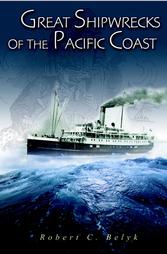
2644.
Belyk, Robert C. GREAT SHIPWRECKS OF THE PACIFIC COAST.
New York. 2001. 276 p. DJ. Fascinating, never-before-documented stories of the
worst shipwrecks on the Pacific Coast during the golden age of coastal
transportation, 1854 to 1929. The eighty years spanning the California gold rush
to the start of the Great Depression saw thousands of passengers and crews
perish in Pacific steamship wrecks. In Great Shipwrecks of the Pacific Coast,
author Robert Belyk looks beyond commonly provided-and frequently
superficial-public explanations of weather conditions or human error, and
closely examines ten significant maritime disasters that occurred along the
Pacific coastline from California to Alaska. Filled with the drama of life and
death aboard doomed ships, Belyk brings to life the struggles of real people
caught in desperate situations when disaster strikes at sea. Illustrated with
rare photographs and drawings. The shipwrecks accounted for here include: Yankee
Blade: Wreck of a Gold Ship, Brother Jonathan: In the Teeth of the Dragon,
Pacific: The Final Whistle, Rio de Janeiro: Death of a City, Clallam: The
"Hoodoo" Ship, Valencia: Appointment with Death, Columbia: Disaster
off Shelter Cove, Francis H. Leggett: Battle Lost, Princess Sophia: A Grave
Error, San Juan: End of an Era. (F). $19.95.
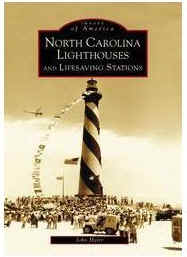
2645.
Hairr, John. NORTH CAROLINA LIGHTHOUSES AND LIFESAVING
STATIONS. 2004. Arcadia Publishing. 128p. Soft wraps. With bold capes
jutting into the ocean, sandy shoals extending miles offshore, fickle weather,
and treacherous currents, it is no wonder that the coastline North Carolina came
to be known as the “The Graveyard of the Atlantic.” For more than two
centuries, these bright beacons of safety have guided ships into busy harbors,
signaled dangerous navigational obstacles, and warmed the hearts of homesick
travelers. North Carolina Lighthouses and Lifesaving Stations presents to
readers the tales behind the lighthouses and life-saving stations, illuminating
their past in both word and image. Through more than 200 archival photographs,
stories of shipwrecks, rescues, service, and pride spring to life. Rare station
and crew are especially noteworthy. (M). $19.99.

2629.
Clifford, J. Candace and Mary Louise. MIND THE LIGHT
KATIE: THE HISTORY OF THIRTY-THREE FEMALE LIGHTHOUSE KEEPERS.
Alexandria. 2006. 144 p. 56 illustrations. Mary Louise and J. Candace
Clifford’s book Women Who Kept the Lights: An Illustrated History of Female
Lighthouse Keepers has been so popular the authors have prepared a condensed
version for younger readers age 12 and up. The 144 women who served as principal
keeper for more than a year are listed in the longer book. The 33 women
presented here are those whose lives were recorded in logs, journals, official
correspondence, newspaper articles and obituaries, and recollections by their
children and grandchildren. Kateie was 44 years old when her son Jacob rowed his
stepfather, John Walker, ill with pneumonia, to Staten Island for medical
treatment. John’s last words to his wife were, "Mind the light,
Katie." John, official keeper of the Robbins Reef Lighthouse, never
returned. Although she was paid only a laborer’s wage, Kate faithfully minded
the light until she finally received the keeper’s appointment in 1894. Her
only communication with the mainland was by rowboat or through the periodic
calls of the lighthouse tender bringing supplies. Assisted by her son Jacob,
Kate kept the Robbins Reef Light until 1919. (M). $12.95.

25381. Muller, Bob. LONG
ISLAND’S LIGHTHOUSES – PAST AND PRESENT. Patchogue. 2004. 383p.
Soft wraps. Long Island’s Lighthouses – Past And Present is the culmination
of over five years of research and study from local and national sources. While
several books have chronicled Long Island’s lighthouses, none have included
all of the structures including those that have been lost over the years. Filled
with stories and photos never before presented, as well as architectural plans
and more. I particularly enjoy the images and information about the many LHS and
Coast Guard keepers. Well done, an invaluable reference for the area. (M).
Published at $25. Our price $23.95.

23379. Hahn-Pedersen, Morten. DANISH
NORTH SEA LIGHTSHIPS.
Esbjerg
.
Denmark
1991 64 p. Soft wraps. Lightships are not uniquely Danish--floating lights have
been placed at sea where fixed lights cannot penetrate for over a hundred years.
Since the Second World War, technological developments have rendered them
obsolete, but they have a fascinating history. This book is the most
comprehensive on the subject yet written, with information about the ships'
construction, life on board, the seamen who sailed them, and the potential
tragedies the lightships have prevented. Filled with excellent vintage
photographs. In English. (M). $44.
2217.
Department of Commerce. Lighthouse Service. INSTRUCTIONS
TO LIGHT KEEPERS.
Wash.
GPO. 1911. 26 p. Nicely done reprint. Includes general instructions for all
employees, instructions for Light-Keepers, instructions to all stations and
vessels equipped with fog signals, instructions relating to light vessels, and
much more. Includes all aspects of station and apparatus maintenance. A complete
and important document. $8.55.

25230.
MacAlindin, Bob. PRISONERS OF THE SEA. Milford
Haven. 1999. 176 p. Soft wraps. The crews and the lightships that they manned
were the prisoners of an alien environment. For the men it was, in the main, a
voluntary exile, that was marginally better for a seaman than voyaging the seven
seas and being away from their families for years. For the ships, anchored in
one place at the mercy of the buffeting sea, it was a trail between their
builder and nature. In spite of this the prisoners enjoyed sunny afternoons
fishing and yarning, but were always ready, whatever the weather, to risk their
lives to rescue less fortunate seamen whose ships had tried to impale themselves
on the very mark that the light vessel was guarding them against. The author
traces the development of these "prisons" from the early almost
unseaworthy wooden hulks to the modern well founded, all steel, high-tech light
vessel, and includes many stories from the crews´ point of view. (M). $29.95.

2232.
Trapani, Robert Jr., INDIAN RIVER LIFE-SAVING
STATION… JOURNEY ALONG THE SANDS… THE U.S. LIFE-SAVING YEARS, 1876-1915.
Virginia Beach. 2002. 64p. Soft wraps. Signed by the author. This lovely addition to our library
weaves the history of the Life-Saving Service into this account of life at the
Delaware’s Indian River Inlet Life-Saving Station. Laid out chronologically,
this booklet provides an intimate look at this station’s important history and
its impact on the region. Includes over 55 wonderful photographs and color
reproductions, keeper and crew accounts, shipwrecks, equipment and more. Nicely
done. (M). $14.95.

25238.
D’Entremont, Jeremy. THE LIGHTHOUSES OF CONNECTICUT.
Beverly. 2005. Soft wraps. 192 p. With The Lighthouses of Connecticut, author
Jeremy D’Entremont inaugurates a new series, "Lighthouse
Treasury," which describes the fascinating history of our American
lighthouses, state by state. There are 20 Connecticut lighthouses today, from
Great Captain Island off Greenwich to Stonington Harbor at the Rhode Island
border, and D'Entremont has unearthed everything from unassailable fact to
improbable ghost story. He doesn't stop with the lighthouses we see today. The
Lighthouses of Connecticut also has chapters on major lights that have
disappeared, Sperry Lighthouse in New Haven Harbor and the Bridgeport Harbor
Lighthouse, as well as a chapter on lightships and some smaller lights that once
protected traffic on the Connecticut River. Read about: The keeper at
Green's Ledge Light off Norwalk, who went on a binge ashore, leaving his
assistant nearly to starve to death. Two years later, the assistant's brother
replaced him and, in an apparent act of revenge, abandoned the new head keeper,
who nearly starved to death himself, or how isolation has driven keepers and
their assistants insane. One keeper had to stay awake two days and nights,
fending off his assistant, who threatened him with a razor lashed to the end of
a spar, and much more. The Lighthouses of Connecticut is meticulously researched
and copiously illustrated, with photographs from the author's enormous
collection. (M). $14.95
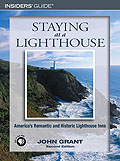
2338b.
Grant, John. STAYING AT A LIGHTHOUSE - America's Most Romantic Lighthouse Inns.
Guilford. 2005. 104 p. Soft wraps. New Updated edition. Whether they were
abandoned long ago or still stand as beacons in the fog, hundreds of lighthouses
decorate the beautiful shores of North America. But only a few invite people to stay the night. Staying at a Lighthouse visits
these unique overnight havens, offering a personal tour of the most sought-after
landmarks in the country. A few of them operate as grand bed-and-breakfast inns.
Others provide a more rustic experience, offering guests a retreat from the
hustle and bustle of their daily lives. Still others allow visitors to assume
the role of lighthouse keeper for a short time. But they all provide an
experience that is romantic, renewing, and above all, memorable. Readers can
step back in time at these and many other coastal towers: • Heceta Head
Lighthouse, Oregon • East Brother Light Station, California • Sand Hills
Lighthouse Inn, Michigan • Rose Island Lighthouse, Rhode Island • Saugerties
Lighthouse, New York • Race Point Lighthouse, Massachusetts • Monomoy Point
Lighthouse, Massachusetts • The Keeper's House Inn, Maine Information provided
in each profile includes history of the lighthouse and the area, background of
the present-day keepers, and a description of the accommodations and the guest
experience, plus all pertinent practical contact details. (M). $11.95.
26122.
Tag, Thomas A. THE FRESNEL LENS MAKERS PART V – THE
BARBIER, BENARD AND TURENNS (BBT) LENS WORKS. Dayton . 2006. 11 P. Soft wraps. Thomas Tag has long been probably the only authority
on lamps, lens apparatus and illumination for lighthouses, with his articles on
the subject appearing in our catalogue, as well as the U. S. Lighthouse
Society’s Keeper’s Log, Lighthouse Digest and other publications. Now Tom
has added still another volume to his list of publications – The Fresnel Lens
Makers Part V – The Barbier, Benard And Turenns (BBT) Lens Works. Part V of
six parts, describes the development of the early Fresnel lenses and defines the
companies and individuals who took part in this effort. Augustin Fresnel had
assistance from many sources as he developed and perfected his lens. This part
details the work of the Barbier, Benard And Turenns (BBT) in France. From its
beginnings in the 1860’s the company was one of the leading makers of
Fresnel lenses for the world market, and to its current status as today’s
Samtec-Gisman Company, still producing navigation buoys. (M). $26.
2659.
Tag, Thomas A. THE FRESNEL LENS MAKERS PART IV - CHANCE
BROTHERS GLASS WORKS. Dayton. 2006. Soft wraps. Thomas Tag has long been probably the only authority on
lamps, lens apparatus and illumination for lighthouses, with his articles on the
subject appearing in our catalogue, as well as the U. S. Lighthouse Society’s
Keeper’s Log, Lighthouse Digest and other publications. Now Tom has added
still another volume to his list of publications – The Fresnel Lens Makers
Part IV Chance Brothers Glass Works. Part IV of six parts, describes the
development of the early Fresnel lenses and defines the companies and
individuals who took part in this effort. Augustin Fresnel had assistance from
many sources as he developed and perfected his lens. This part details the work
of the Chance Brothers Company in England, from its beginning as a glass window maker to its production of Fresnel lenses
for the world market, and to its final demise in 1977 after being divided into
several companies. (M). $26.
25335.
Tag, Thomas A. THE FRESNEL LENS MAKERS PART III THE
HENRY-LEPAUTE LENS WORKS. Dayton. 2005. 8 p. Spiral bound. Thomas Tag has long been probably the only authority
on lamps, lens apparatus and illumination for lighthouses, with his articles on
the subject appearing in our catalogue, as well as the U. S. Lighthouse
Society’s Keeper’s Log, Lighthouse Digest and other publications. Now Tom
has added still another volume to his list of publications – The Fresnel Lens
Makers Part III The Henry-Lepaute Lens Works. Part III of five parts, describes
the development of the early Fresnel lenses and defines the companies and
individuals who took part in this effort. Augustin Fresnel had assistance from
many sources as he developed and perfected his lens. This part details the work
of the Henry-Lepaute Lens Works, in France, from its beginnings as a clock
maker, to its production of Fresnel Lenses for the world market, to its current
status. (M). $26.
25216. Tag, Thomas A.
THE FRESNEL LENS MAKERS PART II
SAUTTER. Dayton. 2005. 10 p. Spiral bound. Thomas Tag has long been
probably the only authority on lamps, lens apparatus and illumination for
lighthouses, with his articles on the subject appearing in our catalogue, as
well as the U. S. Lighthouse Society’s Keeper’s Log, Lighthouse Digest and
other publications. Now Tom has added still another volume to his list of
publications – The Fresnel Lens Makers Part II Sautter. Part II of five parts,
describes the development of the early Fresnel lenses and defines the companies
and individuals who took part in this effort. Augustin Fresnel had assistance
from many sources as he developed and perfected his lens. This part details the
work of the Louis Sautter Company, in France from its beginnings producing
Fresnel lenses and other lighthouse equipment from 1852 to the company’s final
demise in 1970. (M). $26.

25213. Taylor, Thomas W. KEY
WEST LIGHTHOUSE: A LIGHT IN PARADISE. 2005. 141 p. Soft wraps. Key West
in the Florida Keys is the southernmost city in the continental United States.
It history is replete with stories of pirates, hurricanes, and shipwrecks. Soon
after Florida became a territory of the United States, lighthouse was built on
Key West in 1826 to serve as a primary aid to navigation to help reduce the
number of shipwrecks. This lighthouse was destroyed by the hurricane of 1846 but
was replaced by a tower which survives today. Thomas Taylor’s new book Key
West Lighthouse: A Light in Paradise brings to life the history of this unique
lighthouse and the tropical setting in which it is located. The book includes a
number of historic photographs of the lighthouse and details the lives of its
keepers. Well done by this noted historian and writer. (M). $19.95.

25195.
(4 DVD set) Victory at Sea series. Winner of both
an Emmy and a Peabody, this legendary 1952 WWII documentary series drew from
more than 13,000 hours of footage shot by the US, British, German, and Japanese
navies. Narrated by Leonard Graves, with an original music score by Richard
Rodgers, it spans American and Allied naval operations from Pearl Harbor to the
Mediterranean, Murmansk to Mandalay. This award-winning documentary series is
presented in its entirety and has been digitally remastered and restored for
your viewing pleasure. Set includes all 26 full length episodes shown on TV,
B&W and color; approximately 12 hours on 4 DVDs of original uncut action.
Superb, stirring documentary and music that you will long remember. $39.95.

25158. Evans-Hylton, Patrick. LIGHTHOUSES
AND LIFESAVING STATIONS OF VIRGINIA. Arcadia Publishing. 2005. 128 p.
Soft wraps. Created as navigational tools, lighthouses are of interest to more
than mariners; the ruggedly romantic nature of the beacons delights and
enthralls thousand of admirers. Lights along the Virginia coast are no
exception. From the richly historic Old Cape Henry Light, authorized by
President George Washington in 1789, to the candy-striped Assateague Light on
the state’s Eastern Shore, lights along the Virginia shore enthrall thousand
of admirers. Of equal interest are the tales of the men of the United States
Life-Saving Service, the forerunner of today’s Coast Guard. Spaced along the
shore, they aided navigation by responding selflessly to ships in distress,
often at their own peril. Author Patrick Evans-Hylton has collected more than
200 archival images that capture the illuminating history of the silent
sentinels of the sea and the valiant stories of heroic keepers and surfmen. (M).
$19.99.

25151. Dougherty, Barbara Quillen. DEWEY
BEACH HISTORY & TALES. Dewey Beach. 2005. 2nd. 144 p. Soft wraps.
Signed by the author. The much anticipated second edition of Dewey Beach History
& Tales is now available. Featuring 144 pages with approximately 300
photographs, maps, postcards & other images, this second edition of Dewey
Beach History & Tales was compiled and edited by local historian Barbara
Quillen Dougherty. The book includes numerous updates and historical
information, as well as many new “tales”. The first edition, published in
1996, sold out in less than two years. In addition to a great deal on the Dewey
Beach Life Saving station and crews, included are very informative articles
about Dewey Beach in the 1920’s, 1930’s and 1940’s. Included with the
book is a lovely Dewey Beach Life Saving Station note card with envelope. The author’s
proceeds from the sale of Dewey Beach History & Tales was given to the
Dewey Beach Life Saving Station. (M). $38.

6264. Stackpole, Edouard A., LIFE SAVING
NANTUCKET. Nantucket. 1972. 295pp. Hard cover, as new. DJ. A complete,
definitive history of the life-saving services in this area, surrounded by
shoals and known for its toll on shipping. Well illustrated with photos.
Certainly one of the best and most interesting and complete sources on the
subject. (M) $26.


2541. Tongue, Stephen D. LANTERNS
& LIFEBOATS – A History of Thunder Bay Island. Alpena. 2004. 126 p.
Soft wraps. “Magnificent desolation”, that is how early settlers described
Thunder Bay Island. Just offshore from Alpena, Michigan, Thunder Bay Island
boasts a life saving station which assisted in the rescue of over 1,000 lives
and the second oldest lighthouse still standing on Lake Huron. The Thunder Bay
life saving station opened in 1876, making it one of the earliest on the Great
Lakes. Lanterns & Lifeboats the lighthouse and life saving station, their
crews and the transition to the Coast Guard in 1915. (M). $14.95.
2558. Trapani, Robert Jr. LIGHTHOUSES
OF NEW JERSEY & DELAWARE – History, Mystery, Legends and Lore.
Elkton. 2005. Lighthouses Of New Jersey & Delaware presents stories and
photographs of 20 lighthouses along the New Jersey and Delaware coasts. From
Sandy Hook, N.J., to Fenwick Island, Del., Trapani's stories feature unusual
incidents associated with each silent sentinel. Shipwrecks and suicides, storms
and fires, invasions of beetles and cats, and even a few ghost stories and
legends are spotlighted in this easy-to-read collection of short stories. Using
historical photographs, U.S. Coast Guard documents, newspaper articles and
personal interviews, Trapani has created an informative and interesting book
that shares an import part of the region's history and lore. Particularly
interesting are the accounts if the keepers’ lives, their difficulties and
efforts to make do. (M). $11.95.
25137.
Batchelor, John. NORTH AMERICAN LIGHTHOUSES COLORING
BOOK.
New York . 1995. 47 p. Soft wraps. Enjoyable children’s coloring book includes 36 b/w
drawings to color of lighthouses including Cape Hatteras
, Montauk Point, Cape Canaveral, Quoddy Head, Point Reyes
, and many others. Includes location map and history of each. (M). $4.95.

707h. Shanks, Ralph and Lisa Woo. GUARDIANS OF THE
GOLDEN GATE. 1990. 318p. Hardcover. [new] "...Climb the iron
stairways of San Francisco Bay’s lighthouses to re-light the ancient
lamps...on the beach below, the rescue boats are being readied...more
watches...more beaches to patrol...." Guardians of the Golden Gate is
nearly three times larger than the author’s earlier work ‘Lighthouses of San
Francisco Bay. All of the original stories are here, along with a rich treasure
of countless new adventures. Illustrated with hundreds of vintage photographs,
the Shanks’ wonderful work chronicles the work of San Francisco Bay’s
Life-Savers and Light Keepers as never before. Wonderful reading. (M) Only a few
left. Our price: Softcover $14.95.
2588.
Karch, Mary. UNDER THE LIGHTHOUSE – Memories of Barnegat
City. Harvey Cedars. 2004. 80 p. Illustrated with 97 vintage photographs.
This pictorial history of Barnegat Light is based on the memories of long-time
residents who experienced the early days and changes in this small fishing
village on the northern tip of Long Beach Island. Photographs and stories
document the fishing industry, historic buildings, and of course its most famous
landmark, Barnegat Lighthouse. This book combines images of a past almost
forgotten with memories of the residents who will never forget the small town
that was once called Barnegat City. (M). $18.95
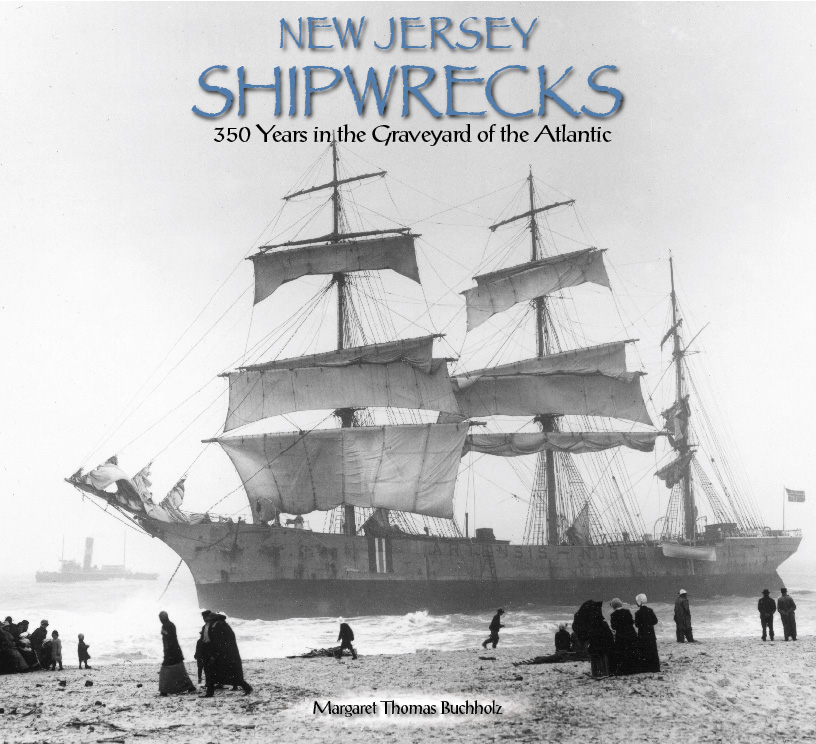
2589.
Buchholz, Margaret Thomas. NEW JERSEY SHIPWRECKS – 350
Years in the Graveyard of the Atlantic. Harvey Cedars. 2004. 200 p. New
Jersey Shipwrecks takes us on a gripping voyage through the “Graveyard of the
Atlantic,” a name bestowed upon the state’s treacherous shoals and inlets.
From the days of sail to steam and oil, ships (and even submarines) have been
drawn to this coast and, for thousands of vessels, it became their final
resting-place. Early rescuers braved the seas, rowing small boats, using simple
buoys and rope to help the wreck victims. Quoting from original documents,
letters and reports, Shipwrecks reveals the sense of duty and service which
prevailed in these brave rescuers; many devoted their lives — literally — to
help save the men and women whose own lives were turned upside down in stormy
Atlantic waters. From the early wrecks of the 18th century to the present day,
the life-and-death drama of maritime disasters is captured in Shipwrecks, along
with the history of the U. S. Lifesaving Service (later to become the Coast
Guard), lighthouses, legends, and true accounts of heroism. One hundred and
forty-two historic photographs and illustrations are included in this
large-format hardcover. The book includes a listing of hundreds of other wrecks
along the Jersey Shore. (M). Published at $44. Our Price $40.95.

2512. Noble, Dennis. RESCUED BY
THE UNITED STATES COAST GUARD - Great Acts of Heroism since 1878. Annapolis.
2005. 328 p. Although the U.S. Coast Guard enjoys a reputation as the best
maritime rescue service in the world, details of its heroic history are not well
known. Dennis Noble has corrected this oversight with a book that highlights
dramatic rescues over the past century carried out from shore-based Coast Guard
stations and aircraft and patrol boats. He writes about a day shortly before
Christmas in 1885 when Keeper Benjamin Dailey and his U.S. Life-Saving Service
crew rowed five miles in seas almost higher than the length of their boat to
pick up shipwrecked sailors and then bring them safely to shore. He also
describes a 1918 rescue when a USCG boat crew pulled through burning gas and oil
to extricate sailors from a sinking tanker. Among the most memorable is Paul A.
Langlois, who during the darkness of a gale swept night, maneuvered his
helicopter around rocky pinnacles thrusting higher into the air then the
helicopter, to rescue two people from a sailboat. But as Noble makes clear, not
every rescue is successful and attempts that ended in deaths are included as
well. Maritime rescue specialists and historians will be drawn to the author’s
overview of the change in equipment and the array of aircraft used by Coast
Guard lifesavers. (M). Published at $32.95. Our price $29.95.
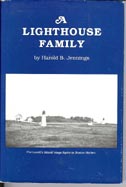
6721. Jennings, Harold B., A LIGHTHOUSE
FAMILY.
Orleans. 1989. 1st. 118p. DJ. Signed by Author. A wonderful narration of boyhood
memories while growing up at Lovell’s Island Lighthouse in Boston Harbor. A
story of adventures, shipwrecks, storms, living without electricity and learning
how to run a lighthouse combine to provide entertainment and a learning
adventure. (F). $12.95. REDUCED to $9.71.

24353. Planisek, Sandy. RELIVING
LIGHTHOUSE MEMORIES 1930’S – 1970’S. GLLKA. 2004. 253 p. Soft
wraps. Seventeen years after the
publication of their first book "Living at a lighthouse," in 1987, the
Great Lakes Lighthouse Keepers Association has published a second book of oral
histories of USLHE and USCG keepers and their children titled "Reliving
Lighthouse Memories." Profusely illustrated and edited by GLLKA Straits
Coordinator Sandy Planisek, the 253-page book features fascinating and
insightful stories in the words of those who lived the experiences. Includes
memories of a Coast Guard electrician, lighthouse keepers, lighthouse children
and more during the difficult period of automation and changing job
descriptions. Highly recommended. (M).
$13.95
LONG OUT OF PRINT!
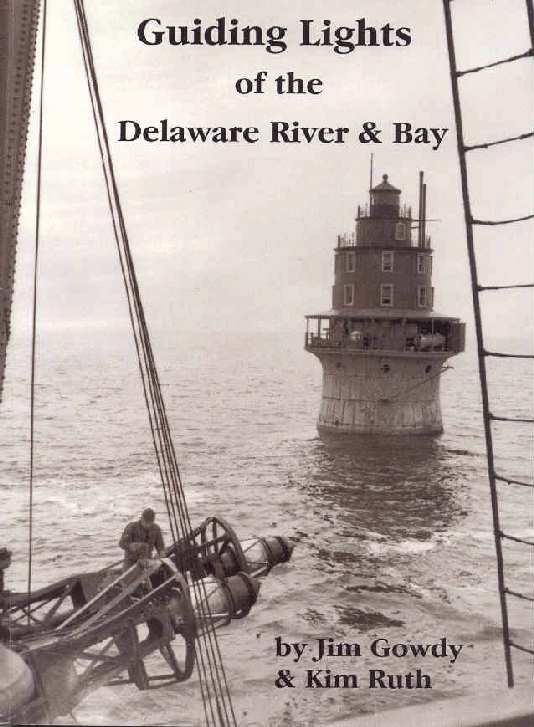
The following book is
no longer available in stores and I have long been searching for a few copies
for stock. Finally I was able to pick up two at another out of print book store
though they were quite pricey, and I don’t expect to find any more in
the future. This will certainly be your last opportunity to pick this title up
for your library.
9421. Gowdy, Jim & Kim Ruth. GUIDING LIGHTS
OF THE
DELAWARE RIVER
AND BAY. Sweetwater, NJ., 1999. 296p. Soft wraps. Just released,
this is the most comprehensive history ever written on the lighthouses,
lightships, tenders and depots of the Delaware River and Bay – from Cape May
to
Gloucester
City
and
Philadelphia
to
Fenwick
Island
. This detailed history was painstakingly research by the authors and is
enhanced by more than 180 photographs and 25 illustrations. Using records from
the National Archives, Coast Guard, and private collections this monumental work
provides wonderful reading. The vintage photographs alone are a feast to the eye
and offer previously unseen views of many of these interesting stations.
Includes are views of a number these lights under construction, and some in the
process of destruction. Also includes rare views of tenders, keepers, light
vessels and much more. (M). $74.
To Recent Releases Page 2
Many recent books
available at 10% or more off publishers' list prices - please ask.
Procedure
to order items:
1. I suggest that you call us or
email to check on availability of any item that you would like other than
recent books. As items go quite quickly, please call and leave a message to
reserve items that you would like. I will return your call, hold the items and
await your letter or credit card information. We will also weigh the items and
advise postage.
2. You may then call or email credit
card information, or forward a check in the mail.
Most items are mailed US Priority Mail
or UPS. Additional information on our "Ordering Page".
Massachusetts residents must add 6.25% sales tax.
This Page Last Updated November 21, 2022
.
Can't find what you are looking for?
We can help you find that needed book or item.
Contact us at [email protected]
How to reach us:
Kenrick A. Claflin & Son Nautical Antiques
1227 Pleasant Street, Worcester, MA 01602
Phone (508) 792-6627
All
text and illustrations on web site Ó
James W. Claflin . 11/21/2022
All rights
reserved. Use prohibited without written permission.

|
























 (image not included)
(image not included)




















































 Image
Copyright Walt Disney Studio Pictures
Image
Copyright Walt Disney Studio Pictures














 (Photo
not included)
(Photo
not included)









































































































 The
entire Coast Guard Crew visited Tammy in the hospital the day after the rescue.
The
entire Coast Guard Crew visited Tammy in the hospital the day after the rescue.






























































































































































































































